Baron Services XDD-1000C C-BAND DOPPLER WEATHER RADAR User Manual
Baron Services Inc C-BAND DOPPLER WEATHER RADAR
Contents
- 1. Modulator Manual
- 2. Users Manual Part 1
- 3. Users Manual Part 2
- 4. Users Manual Part 3
- 5. S10 OPERATION AND MAINTENANCE MANUAL
- 6. S10 FAST TRAC MILLENIUM USERS GUIDE
- 7. S10 TECHNICAL MANUAL
- 8. S10 RECEIVER AND PROCESSOR USERS MANUAL PART 1
- 9. S10 RECEIVER AND PROCESSOR USERS MANUAL PART 2
- 10. S10 RECEIVER AND PROCESSOR USERS MANUAL PART 3
S10 RECEIVER AND PROCESSOR USERS MANUAL PART 2

RVP8 User’s Manual
April 2003 TTY Nonvolatile Setups (draft)
3–1
3. TTY Nonvolatile Setups (draft)
The RVP8 provides an interactive setup menu that can be accessed either from a serial TTY, or
from the host computer interface. Most of the RVP8’s operating parameters can be viewed and
modified with this menu, and the settings can be saved in non-volatile RAM so that they take
effect immediately on power-up. This permits custom trigger patterns, pulsewidth control,
matched FIR filter specs, PRF, etc., to be configured by the user in the field.
The TTY menu also gives access to a collection of graphical setup and monitoring procedures
that use an ordinary oscilloscope as a synthesized visual display. The burst pulse and receiver
waveforms can be examined in detail (both in the time and frequency domain) and the digital
FIR filter can be designed interactively to match the characteristics of the transmitted pulse.
3.1 Overview of Setup Procedures
This section describes basic operations within the setup menus such as making TTY connections,
entering and exiting the menus, and saving and restoring the configurations.
The setup TTY should be plugged into the modular 6-pin phone jack located at the top edge of
the RVP8 board. The electrical interface may be either RS232 or RS423. If the phone jack
connection is inconvenient, the terminal may be wired directly to the TIOXMT and TIORCV
signals on the P2 96-pin connector. The TTY should be configured for 7-bit or 8-bit data (the
MSB is always zeroed), no parity, and either one or two stop bits.
With jumper JP4 in the ”AB” position, the interface runs at 9600 baud; in the ”BC” position the
rate is 1200 baud (factory default), or some other rate set via the menu. Thus, the ”AB” setting
always makes a reliable 9600 baud connection, even if the the alternate rate is accidently set to a
bad or forgotten value. Note: the reliable 9600 baud rate requires that the crystal located at X1
have a frequency of 4.9152MHz.
3.1.1 Initial Entry and Help List
The interactive setup menu is invoked by pressing the Escape key on the TTY. If that key can
not be found on the keyboard, you can sometimes use Control “[” to generate the ESC code.
The RVP8 then responds with the following banner and command prompt.
SIGMET Incorporated, USA
RVP8 Digital IF Signal Processor Rev.A/01
–––––––––––––––––––––––––––––––––––––––––
RVP8>
The banner identifies the RVP8 product, and gives the hardware version of the board (e.g.,
Rev.A) and software version (e.g., 01). This information is important whenever RVP8 support is
required, and it is also repeated in the printout of the “V” command (See below).
The “Q” command is used to exit from the menus and to restart the RVP8 with the (possibly
changed) set of current values. It is important to quit from the menus before attempting to
resume normal RVP8 operation. Portions of the RVP8 command interpreter remain running
while the menus are active (so that the TTYOP command works properly), but the processor as a
whole will not function until the menus are exited.

RVP8 User’s Manual
April 2003 TTY Nonvolatile Setups (draft)
3–2
From the command prompt, typing “help” or “?” gives the following list of available
commands.
Command List:
F: Use Factory Defaults
S: Save Current Settings
R: Restore Saved Settings
M: Modify/View Current Settings
Mb – Burst Pulse and AFC
Mc – Board Configuration
Mf – Clutter Filters
Mp – Processing Options
Mt<n> – Trigger/Timing <for PW n>
Mz – Transmitter Phase Control
M+ – Debug Options
P: Plot with Oscilloscope
Pb – Burst Pulse Timing
Ps – Burst Spectra and AFC
Pr – Receiver Waveforms
P+ – Visual Test Pattern
V: View Jumpers and Status
?: Cmd list (?? Settings list)
*: Reboot <Max Slaves> <+>
~: Swap Burst/IF Inputs on IFD
Q: Quit
3.1.2 Factory, Saved, and Current Settings
The current settings are the collection of setup values with which the RVP8 is presently
operating; the saved settings are the collection of values stored in non-volatile RAM. The saved
settings are restored (made current) each time the RVP8 is powered up. The “S” command saves
the current settings into the non-volatile RAM, and the “R” command restores those non-volatile
values so that they become the current settings. The “F” command initializes the current settings
with factory default values. Thus, “F” followed by “S” saves factory defaults in non-volatile
RAM, so that the RVP8 powers up in its original configuration as shipped.
The RVP8 retains all of its saved settings when new ROM upgrades are installed; the new
version of code will automatically use all of the previous saved values. However, if the RVP8
detects that the new release requires a setup parameter that did not exist in the previous release,
then a factory default value will automatically be filled in for that parameter. A warning is
printed whenever this occurs (See also, Section 3.1.4).
There is also support for intermediate minor releases of RVP8 code. Each ROM has a major
version number (the one that it always had), plus a minor version number for intermediate
”unofficial” releases. The minor number starts from zero at the time of each ”official” release,
and then increments until the next ”official” release. The RVP8 includes the minor release

RVP8 User’s Manual
April 2003 TTY Nonvolatile Setups (draft)
3–3
number (if it is not zero) in the printout of the ”V” command. Likewise, the minor release
number of the code that last saved the nonvolatile RAM is also shown. This is an improvement
over having to check the date of the code to determine which minor release was running.
Note that the RVP8 does not actually begin using the current settings until after the “Q”
command is entered, so that the processor exits the TTY setup mode and returns to normal
operation.
3.1.3 Processor Reset Command
The “*” command may be used to reset the signal processor from the TTY. This can be handy
when the other methods of reset (power-up, parallel interface reset signal, or SCSI bus reset) can
not easily be done. The command is robust in that pressing the Escape key followed by “*”,
followed by two Returns, always resets the RVP8. There are certain wait conditions from which
a TTY ESC does not immediately enter the setup monitor. However, the above four-key
sequence always forces a full reset.
The RVP8 diagnostics can run in a continuous loop that is useful during production burn–in
testing. In this mode the complete set of powerup tests is repeated approximately once per
second. The green LEDs on the RVP8/Main and RVP8/AUX boards will blink on each run as a
progress indicator. All red LEDs will initially be on, but each will begin to blink if any
diagnostic ever fails on that board. A line of text is also printed to the setup TTY to show the
progress of the tests and a summary of any errors.
The RVP8’s Perpetual Diagnostic Loop maintains a histogram of receiver IF-Input noise levels
in 1dB steps from –85dBm to –72dBm. You can view the accumulated noise distribution by
typing “N” while the diagnostic loop is running. This feature is intended for use during factory
burn-in and testing of RVP8/IFD units.
This special test mode can be started in two ways. One is to powerup the processor with the
RVP8/Main I/O jumpers JP17–JP22 in the (somewhat illegal) pattern: JP17:BC, JP18:BC,
JP19:AB, JP20:AB, JP21:AB, JP22:AB. This method has the advantage of not requiring a TTY
connection. The second method is to reset the processor from the local TTY monitor using the
”*+” command. This is the normal reset command, but with a plus sign (debugging) suffix.
3.1.4 V — View Internal Status
The “V” command allows you to view some internal status within the RVP8. This information
is available for inspection only, and can not be changed from the TTY. The view listing begins
with the banner:
Jumpers and Internal Status
–––––––––––––––––––––––––––
and then prints the following lines:
Rev.B board, ROM V14.12 from Mon Jul 12 19:29:07 1999
This line shows the revision level of the RVP8 board, the ROM code version, and the
date and time that this release was compiled. This lets you know the age of the
release, even if the release notes have been misplaced. The date can also be helpful
in keeping track of “unofficial” interim releases.

RVP8 User’s Manual
April 2003 TTY Nonvolatile Setups (draft)
3–4
Values were last saved using ROM version V14
This line tells which version of RVP8 code was the last to write into the non-volatile
RAM. It is printed only if that last version was different from the ROM version that
is currently running. The information is included so that a “smart upgrade” can often
be done, i.e., values that did not exist in the prior release can be filled in with a guess
that is better than merely taking the factory default.
Warning: 3 automatic defaults were inserted.
This warning will appear (accompanied by a beep) if one or more automatic factory
defaults were required when the non-volatile RAM was last restored. It is likely that
these automatic defaults will be acceptable operating values; but it would be wise to
check the release notes to see what new parameters were added, and to decide on
their proper settings. The warning will disappear once the S command is issued.
This is because the missing saved slots are then filled in with valid values.
Diagnostics: PASS Slave DSP Count: 3
If errors were detected by the powerup diagnostics then an error bitmask will be
shown on the first line. The word “PASS” indicates that no errors were detected.
The slave DSP count is also shown, which is the number of processors that were
detected during the powerup sequence (and which will be used during subsequent
processing). The RVP8 main board has three slave DSPs, and the each RVP8/AUX
board supplies ten more. Up to two RVP8/AUX boards may be attached at the same
time (23 slave DSPs total) for extremely intensive processing applications.
An itemized list (consisting of bit pattern and text) is printed whenever any of the
powerup diagnostics fail. The possible messages that might appear are:
0x00000001 : No fiber downlink signal detected
0x00000002 : 16–Bit AFC level read/write
0x00000004 : IF Receiver reset request not sent
0x00000008 : I/O FIFO full before 4096 writes
0x00000010 : I/O FIFO not full after 4096 writes
0x00000020 : Transmit phase latch bits
0x00000040 : Downlink local counter test
0x00000080 : Receiver status bits & switches
0x00000100 : Test byte pattern from receiver
0x00000200 : Test word pattern from receiver
0x00000400 : Non–Volatile RAM 0x00 and 0xFF flags
0x00000800 : UART read/write check
0x00001000 : External RAM check
0x00002000 : SCSI controller chip error
0x00004000 : Range mask RAM and addressing
0x00008000 : I&Q FIFO interrupt & trigger flags
0x00010000 : I&Q FIFO data bits
0x00020000 : FIR processing of ramp pattern
0x00040000 : Boot words not accepted by first slave
0x00080000 : No reply slave DSP count
0x00100000 : Invalid count of slave DSPs
0x00200000 : Global communication port tests

RVP8 User’s Manual
April 2003 TTY Nonvolatile Setups (draft)
3–5
0x00400000 : Internal tests failed on some slave
0x00800000 : Trigger Generator RAM and addressing
0x01000000 : Excessive coax/fiber round trip jitter
0x02000000 : No sync found in round trip test
0x04000000 : Internal error in compile/link
Coax/Fiber/Pipeline Delay: 0.624 usec (Stdev: 0.014 usec)
During bootup the RVP8 measures the round trip delay along 1) the coax uplink to
the receiver module, 2) the pipeline delays within the receiver module, 3) the optical
fiber downlink to the main board, and 4) pipeline delays in the data decoding
hardware. The time shown is accurate to within 14ns, and is used internally to insure
that the absolute calibration of trigger and burst pulse timing remains unaffected by
the distance between the main board and the receiver module. You may freely splice
any lengths of coax and fiber without affecting the calibrations; the delay time will
change, but the trigger and burst calibrations will remain constant.
The standard deviation of the measured delay is also shown. If the coax uplink and
fiber downlink cables are run properly this variation should be less than the period of
the acquisition clock, e.g., 0.028 msec for the standard 35.975MHz rate. Larger
errors may indicate a problem in the cabling. A diagnostic error bit is set if the error
is greater than two acquisition clock periods.
IFD:Okay, Burst Pwr:–48.6 dBm, Freq:35.975 MHz
This line summarizes the receiver status and Burst input signal parameters. The
status may show:
Okay RVP8/IFD and connecting cables are all working properly
NoFiber Problem in DownLink fiber cable from RVP8/IFD ––> RVP8/Main
UpErr Problem in UpLink COAX cable from RVP8/Main ––> RVP8/IFD
NoPLL RVP8/IFD PLL is not locked to external user-supplied clock reference
DiagSW RVP8/IFD test switches are not in their normal operating position
Reset by: Software Up–time: 0–days 00:49:22
This line lists the origin of the last processor reset, as well as the total time that has
elapsed since that reset occurred. The running time is given in days, followed by
hours : minutes : seconds. The timer wraps around after approximately 180-days of
continuous operation. The cause of the last reset will be one of the following:
1) Power-Up 2) External RESET line
3) SCSI Bus Reset 4) RESET OpCode with “Pwr” bit
5) RESET OpCode with “Rst” bit 6) RESET OpCode with “Dig” bit
7) BOOT OpCode 8) Internal Watchdog
9) TTY “*” command 10) IFD Power Sequencing
11) Burn-In Self Tests
3.1.5 Burst-In / IF-In Swap Command
The “~” command swaps the Burst and IF inputs at the IFD. Requests to toggle the state are
made from the top level as follows:

RVP8 User’s Manual
April 2003 TTY Nonvolatile Setups (draft)
3–6
RVP8> ~
IFD Burst/IF Inputs are: SWAPPED
RVP8> ~
IFD Burst/IF Inputs are: NORMAL
The selection remains in effect for the duration of the setup session, but then returns to
NORMAL upon exiting the TTY monitor. The “~” command is very handy because it allows
the Pb,Pr, and Ps plotting commands to easily run with one input or the other. Here are two
examples of how this might be useful.
SWhen checking the range alignment on a Klystron system, the Pb plot can not be
used in the usual way to center the Tx burst because a continuous-wave COHO
(rather than a burst pulse) is typically used as the phase reference in these
systems. However, if you swap the Burst and IF inputs, you can then use the Pb
command to view and center the received leakage of the Tx pulse, and thus locate
range zero.
SWhen setting up the AFC loop, you can use your RF signal generator to simulate
the transmitter’s frequency, and then run the loop with swapped RVP8/IFD
inputs. The AFC servo will then hunt and follow the siggen frequency supplied
via the receiver. You can then make step changes in that frequency to verify that
the loop responds properly.
Note that the same input swapping function is also available via the RVP8/IFD toggle switches.
However, those switches may be located far away from the operator’s terminal; hence, the
command interface is still a valuable addition. The “~” command can only be used with the new
Rev.D RVP8/IFD; the command is unimplemented, and will not even show up in the “Help” list,
when earlier receivers are connected.
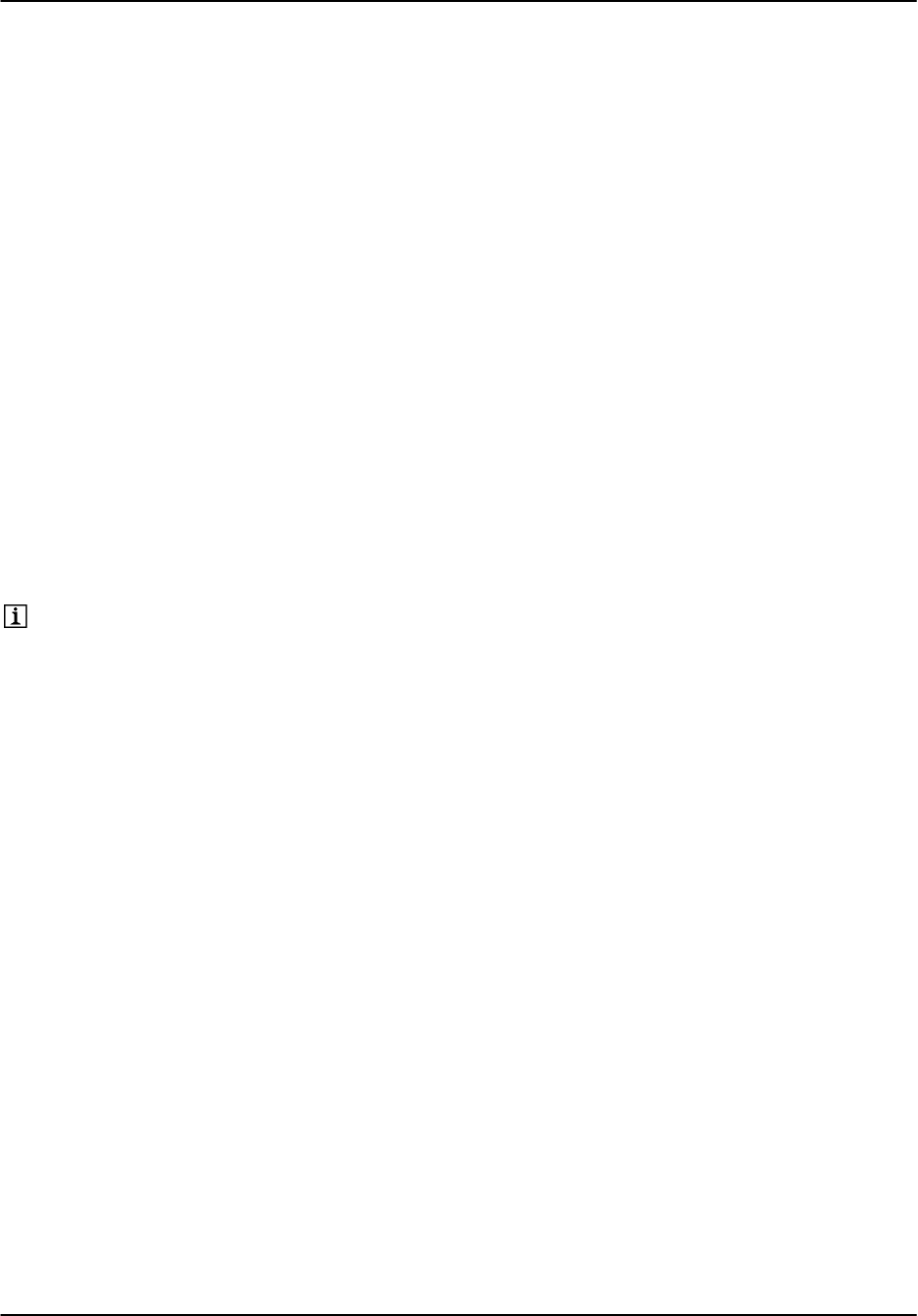
RVP8 User’s Manual
April 2003 TTY Nonvolatile Setups (draft)
3–7
3.2 Host Computer I/O Debugging
The RVP8 supports two very powerful monitoring functions that are helpful in debugging the
I/O interface to the host computer. One examines the physical layer of the interface, i.e., the
electrical handshake and data lines themselves. The other examines the application layer, i.e.,
the 16-bit opcodes and data that define the RVP8’s application programming interface.
3.2.1 Physical-Level I/O Examiner
The RVP8 has TTY support for debugging the physical level of the host computer’s SCSI or
Parallel interface. The “X” (eXamine) command allows you to watch all incoming 16-bit words
as they arrive from the host computer. In addition, you may also send 16-bit words back the
other way. The “X” command is only available from the RS232 hardware TTY interface; it can
not (obviously) be used via chat mode over the same I/O interface that it trying to examine. As
such, the “X” command will not even be listed in the RVP8’s top level help menu during a chat
mode session.
While the “X” command is running, any words that arrive from the computer will immediately
be printed in hex format, along with an “address” (word counter, starting from zero) at the start
of each line. Meanwhile, the “W” subcommand can be used to write individual words back to
the computer, and the “Q” subcommand will exit the I/O examiner entirely.
Note: When the “X” command is running, the RVP8 does not interpret the
incoming 16-bit words as commands and arguments. Data sent to the RVP8 are
discarded after being printed; and output from the RVP8 will occur only if the
“W” subcommand is manually used. The “X” command is intended to debug
the physical layer of the computer interface in a very controlled manner.
The following dialog was captured in response to the host computer writing 100, 200, 300
(decimal) to the RVP8. The “W” subcommand was then used twice to output a 0x4000 and
0x8000 from the RVP8, and the computer then sent the values 1, 2, 3, 4, 5.
RVP8> X
Host Computer I/O Debug Monitor
–––––––––––––––––––––––––––––––
Q: Exit the monitor
W: Output a word to the computer
0x0000: 0x0064 0x00C8 0x012C
Output Word : 0x4000
Output Word : 0x8000
0x0003: 0x0001 0x0002 0x0003 0x0004 0x0005
3.2.2 Application-Level I/O Examiner
The RVP8 has TTY support for debugging the application level of the host computer’s SCSI or
Parallel interface. The Real Time TTY Monitor (RTM, see Section 3.3.7) can be configured to
expose the computer’s complete I/O stream while the RVP8 is running and processing
commands in its normal manner. Because of the enormous amount of TTY output that can be
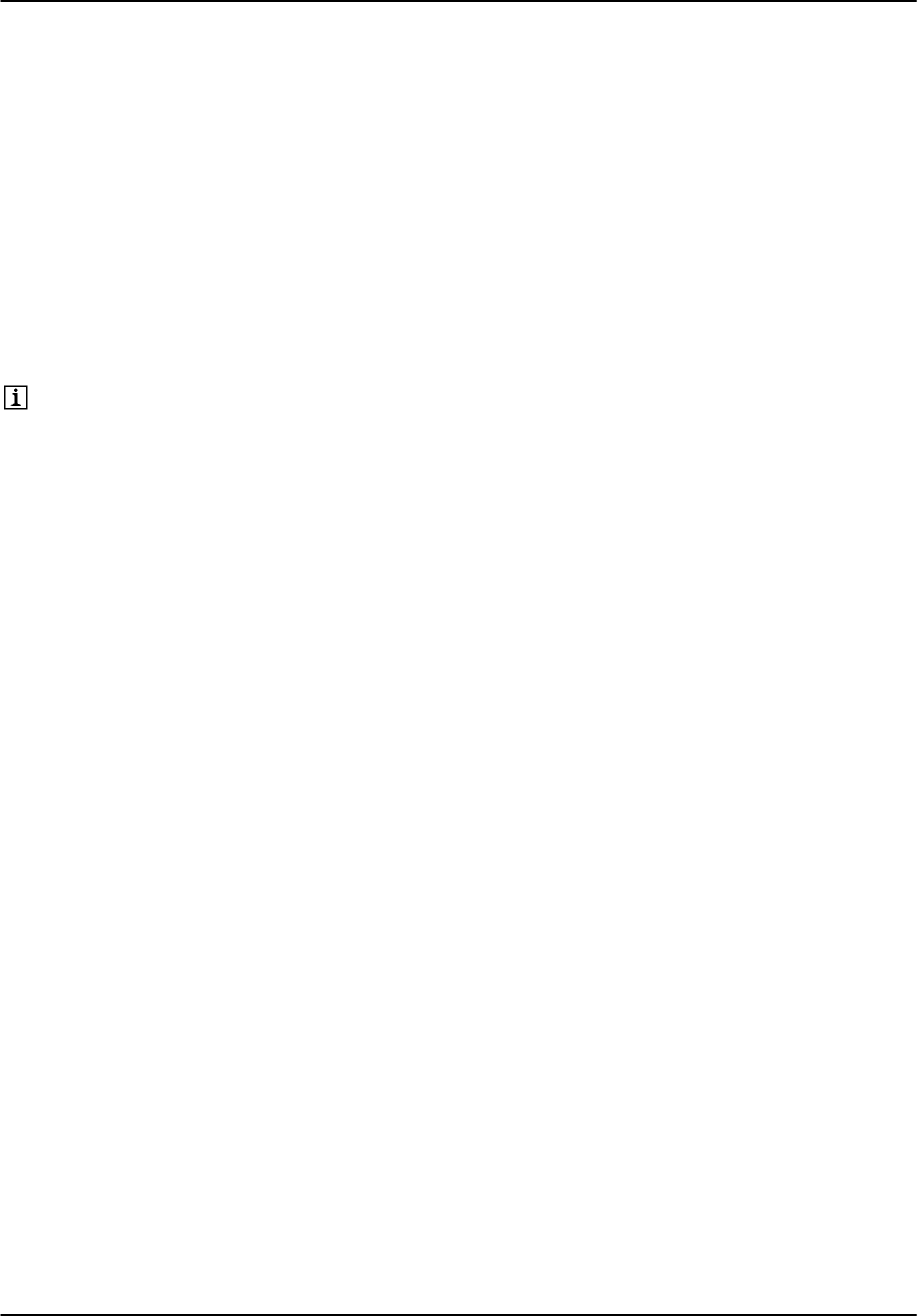
RVP8 User’s Manual
April 2003 TTY Nonvolatile Setups (draft)
3–8
generated by this option, all other RTM selections are disabled whenever host computer I/O is
being monitored. Also, those other RTM selections would interfere with the multi-line
formatting of the I/O text.
The TTY printout shows incoming opcodes called out by name, and subsequent input and output
words formatted into a table. The data are printed in Hex, twelve words per line, and include a
word offset (origin zero) at the start of each line. The offset is reset to zero at the start of each
new input or output sequence.
Lines of data that are repeats of identical values will be skipped with a “...” indication. This
shortens and simplifies the printout; but more importantly, it reduces TTY overhead so that the
processor is less I/O bound. Also for this reason, the “0x” Hex prefix is omitted during the
possibly lengthy printing of the data word tables.
Note: As with all other Real Time TTY Monitor (RTM) functions, the RVP8
remains completely functional while host computer I/O is being monitored.
However, unlike all other RTM functions, the I/O monitor will stall the main
processor whenever the TTY becomes I/O bound; and the performance of the
RVP8 will be degraded, perhaps severely. It is recommended that you configure
the TTY for 38.4-KBaud to minimize the serial I/O delays.
The following sample transactions were captured in response to starting the IRIS/Open ZAUTO
utility. An I/O RESET and diagnostic OTEST are first performed. The pulse width selection
bits and maximum trigger rates are then set with PWINFO, and angle sync is disabled with
LSYNC. The header words for processed data are decided using CFGHDR, operational
parameters are loaded with SOPRM, and final RVP8 parameters are read back with GPARM.
Finally, the trigger rate is set using SETPWF, and a dummy range mask consisting of a single
bin is setup with LRMSK.
Opcode 0x008C (RESET)
Opcode 0x0004 (OTEST)
Output Words
0: 0001 0002 0004 0008 0010 0020 0040 0080 0100 0200 0400 0800
12: 1000 2000 4000 8000
Opcode 0x000F (PWINFO)
Input Words
0: 8421 012C 0BB8 0FA0 1F40
Opcode 0x0011 (LSYNC)
Opcode 0x005F (CFGHDR)
Input Words
0: 0001 0000
Opcode 0x0002 (SOPRM)
Input Words
0: 0019 000F 07AE 0008 FE70 0080 00A0 0000 0003 000A AAAA 8888
12: C0C0 C000 0000 0000 0000 AAAA 0000 2710
Opcode 0x0009 (GPARM)
Output Words
0: 1200 0001 0960 FFFF FFFF 0D5B 0000 0000 0000 4284 0000 0000
12: 0019 743D 0007 0000 0000 230B 0032 5DC0 0BB8 1770 1D4C 2EE0
24: 8421 0000 2EE0 2EE0 0960 0960 000F 07AE 0008 FE70 0080 00A0
36: 0000 0000 0000 0000 0000 0000 0001 000E 0000 000E 0000 0D5B
48: 8000 0000 0000 0000 0000 0000 0000 0000 0000 0000 0000 0000
60: 0000 0000 0000 0000

RVP8 User’s Manual
April 2003 TTY Nonvolatile Setups (draft)
3–9
Opcode 0x0010 (SETPWF)
Input Words
0: 2EE0
Opcode 0x0001 (LRMSK)
Input Words
0: 0001 0000 0000 0000 0000 0000 0000 0000 0000 0000 0000 0000
12: ...
504: 0000 0000 0000 0000 0000 0000 0000 0000
This RTM option to monitor computer I/O is automatically disabled at powerup, and therefore
can not be saved permanently. This is to avoid confusing situations in which the monitor is
accidently left running –– the RVP8 would appear to be working, but at a puzzling level of
degraded performance.

RVP8 User’s Manual
April 2003 TTY Nonvolatile Setups (draft)
3–10
3.3 View/Modify Dialogs
The M command may be used to view, and optionally to modify, all of the current settings. The
current value of each parameter is printed on the screen, and the TTY pauses for input at the end
of the line. Pressing Return advances to the next parameter, leaving the present one unchanged.
You may also type U to move back up in the list, and Q to exit from the list at any time.
Typing a numeric or YES/NO response (as appropriate to the parameter) changes the
parameter’s value, and displays the line again with the new value. All numbers are entered in
base ten, and may include a decimal point and minus sign. In some cases, several parameters are
displayed on one line, in which case, as many parameters are changed as there are new values
entered. In all cases, the numbers are checked to be within reasonable bounds, and an error
message (listing those bounds) is printed if the limits are exceeded. Note that changes to the
settings (generally) do not take effect until after the Q command is typed, at which point the
RVP8 exits the local TTY menu and resumes its normal processing operations.
Since the number of setup questions is large, follow the M command with a second letter to
select the subcategory, i.e., Mb (Burst Pulse and AFC), Mc (Board Configuration), Mf (Clutter
Filters), Mp (Processing Options), Mt (Triggers and Timing), Mz (Transmitter Phase Control),
M* (Stand-alone Settings) or M+ (Debug Options). The M command by itself prints the entire
set of questions so that you can make a hard copy.
The M command always works from the current parameter values, not from the saved values in
non-volatile RAM. If the host computer has modified some of the current values, then you will
see these changes as you skip through the setup list. However, typing S at that point would save
all of the current settings and would, perhaps, make many changes to the original non-volatile
settings. In general, to make an incremental change to the saved settings, first type R to restore
all of the saved values, then use M to make the changes starting from that point, and S to save
the new values.
A listing of the parameters that can be viewed and modified with the M command is detailed in
the following subsections. In each case, the line of text is shown exactly as it appears on the
TTY with the factory default settings. A definition of each parameter is given and, if applicable,
the lower and upper numeric bounds are shown.
3.3.1 Mc — Board Configuration
This set of commands configure general properties of the RVP8/IFD and RVP8/Main boards.
Acquisition clock: 35.9751 MHz
This is the frequency of the oscillator at U5 in the IF receiver module. Except for
custom receivers, this will always be 35.9751 MHz; which gives a fundamental
sample spacing of 1/240 km (approximately 4.17 meters).
Limits: 33.33 to 41.67 MHz
Dual simultaneous receivers are being used: NO
Answer this question “Yes” if the RVP8 will be processing simultaneous signals from
two separate receivers. Answering “No” will revert to normal operation with just a
single receiver.

RVP8 User’s Manual
April 2003 TTY Nonvolatile Setups (draft)
3–11
Dual–LNA/Rcvr single–channel switched mode: NO
For dual-polarization single-receiver systems, this question decides whether you have
a single LNA and IF-Amplifier that switches between H&V (the typical case); or two
separate receivers, each hard wired to H and V, with switching performed after the IF
amplifiers. The question affects how noise levels are measured and applied to the
data.
Synthesize LOG video output waveform: YES
Upper 100.0 dB will occupy 85.0% of voltage span
Force freerunning video mode: NO
Plot data from secondary receiver: NO
The RVP8 supports the option of sourcing a LOG Video analog output signal from
the backpanel of the main chassis. There are two ways that this signal can be
configured:
SSelf-Triggering, Free-Running Mode
This is the default mode that is available on all RVP8 boards. The output signal
is periodic at approximately the PRF of the radar, but is free-running, i.e., not
actually synchronized with the radar trigger. A synthetic 1.0 msec wide, full
scale, “trigger” pulse is embedded at the zero-range start of each LOG Video
waveform. This marker can easily trigger an oscilloscope if the scope’s trigger
level is set just below the maximum LOG Video voltage level.
SWaveform Locked to Radar Trigger
This mode requires a (one-wire) hardware modification to the Rev.B RVP8/Main
board. The LOG Video waveform then becomes locked to the radar trigger, so
that the LOG signal can be displayed on any device that already receives the radar
trigger.
In either case, the LOG Video output signal is unipolar, ranging from approximately
0.0V to 3.0V. It is active during all data processing modes that the host computer
might request, as well as during the idle time between scans. The signal is absent
(zero), however, during the short intervals of time that the RVP8 is being
reconfigured by the host computer, or when the RVP8’s local TTY setups are being
used.
The time resolution of the synthesized LOG Video signal is fixed at 1.0 msec per bin.
This is independent of the actual range resolution of the FIR matched filter.
Whatever (I,Q) data are actually being computed by the FIR front end are selected for
a nearest fit to each 1.0 msec synthetic output cell. The maximum number of
incoming FIR range bins that can be selected among is 5460. Thus, for example, the
maximum range of the LOG Video signal would be 682km when the FIR range
resolution is 125–meters.
Answer the first question “Yes” if you would like the RVP8/Main board to
synthesize and drive the LOG Video output signal. The cost of doing this is that one
of the “slave” DSP chips will be removed from the normal Doppler processing chain,
and dedicated to the task of LOG Video generation. On a single-board system, the

RVP8 User’s Manual
April 2003 TTY Nonvolatile Setups (draft)
3–12
three available slave DSPs would be reduced to two; whereas on a dual-board system,
the 13 available DSPs would be reduced to 12. Obviously, the percentage penalty is
less in a larger system.
The second question decides how the overall dynamic range of the receiver will fit
into the 12-bit unipolar output voltage span of the DAC that produces the LOG Video
waveform. The default setting calls for the upper 100dB of dynamic range to occupy
85% of the output voltage span. This means that the strongest IF input signal would
produce 85% of the maximum DAC voltage (approximately 2.55 Volts); 50dB down
would be 42.5%, and 100dB down would be 0%, i.e., zero volts.
If you are using a self-triggering LOG Video waveform, then the 15% of headroom
provided by the default settings leaves room for the embedded trigger pulse.
However, if your RVP8 has the hardware modification required to synchronize the
LOG Video to the system trigger, then the full 100% of the DAC voltage span can
freely be used. The third setup question can be used to force freerunning mode on an
RVP8 that has the hardware modification. This question is included mostly for
testing purposes.
The last question only appears in dual-receiver mode. Answer “Yes” if you would
like the LOG video analog output signal to be based on the data from the secondary
receiver rather than from the primary receiver.
Scope plots– Holdoff ratio: 0.50, Stroke: 1000.0 usec
The oscilloscope plotting commands are described in Chapter 4. This question
allows you to vary the amount of holdoff time that is inserted between each drawing
stroke, as well as the stroke length itself. Try increasing the holdoff if your scope is
not triggering reliably. Longer holdoffs make it easier for the scope to find the initial
trigger point, but may introduce visible flicker. To reduce flicker, try decreasing the
stroke duration from its default value of 1000 microseconds.
Limits: Holdoff 0.05 to 5.00, Stroke 100 to 10000 msec.
PWINFO command enabled: No
The “Pulsewidth Information” user interface command can be disabled, thus further
protecting the radar against inappropriate combinations of pulsewidth and PRF. This
is a more safe setting in general, and is even more important when DPRT triggers are
being generated. It can also be useful when running user code that is not yet fully
debugged.
TRIGWF command enabled: NO
The “Trigger Waveform” user interface command can be disabled if you want to
prevent the host computer from overwriting the RVP8’s stored trigger specifications.
This is the default setting, based on the assumption that the built-in plotting
commands would be used to configure the triggers. Answering “YES” will allow
new waveforms to be loaded from the host computer.
RVP7 Emulation: No
The RVP8 implements a reasonably precise emulation of the RVP7 command set.
This mode is useful because it allows an RVP8 to be plugged directly into a software
system that used to run with an RVP7. All of the configuration steps that are new and

RVP8 User’s Manual
April 2003 TTY Nonvolatile Setups (draft)
3–13
unique to the RVP8 can be handled by the local TTY and Scope setups, thus making
no demands on the user’s system code for support. Answer this question “YES” for
maximum compatibility with old driver software. However, if you are running IRIS
version 6.11 or higher, then answer “NO” to enable using new RVP8 features as they
are developed.
The RVP8 returns a version number of 35 when the processor is running in RVP7
compatibility mode. This fudged value will appear in the SCSI Inquiry Command
reply, and in the GPARM parameter packet. Elsewhere, the correct RVP8 ROM
version number will always appear. The reason for doing this is so that the RVP8
appears (to the host computer) to be a modern RVP7 with all of the latest opcodes
and features.
3.3.2 Mp — Processing Options
Major Mode- 0:User, 1:PPP, 2:FFT : 0
The top level RVP8 operating modes are described in the documentation of SOPRM
command word #9. This question allows you to use the mode that has been selected
by that command, or to force the use of a particular mode.
Window- 0:User, 1:Rect, 2:Hamming, 3:Blackman : 0
Whenever power spectra are computed by the RVP8, the time series data are
multiplied by a (real) window prior to computation of the Fourier Transform. You
may use whichever window has been selected via SOPRM word #10, or force a
particular window to be used.
R2 Processing- 0:Never, 1:User, 2:Always : 1
Controls R0/R1 versus R0/R1/R2 processing. Selecting ”0” unconditionally disables
the R2 algorithms, regardless of what the host computer requests in the SOPRM
command. Likewise, selecting ”2” unconditionally enables R2 processing. These
choices allow the RVP8 to run one way or the other without having to rewrite the
user code. This is useful for compatibility with existing applications.
Clutter Microsuppression- 0:Never, 1:User, 2:Always : 1
Controls whether individual “cluttery” bins are rejected prior to being averaged in
range. Same interpretation of cases as for ”R2 Processing” above.
2D Final Speckle/Unfold – 0:Never, 1:User, 2:Always : 1
The Doppler parameter modes (PPP, FFT, etc) include an optional 3x3 interpolation
and speckle removal filter that is applied to the final output rays. This 2-dimensional
filter examines three adjacent range bins from three successive rays in order to assign
a value to the center point. Thus, for each output point, its eight neighboring bins in
range and time are available to the filter. Only the dBZ,dBT,Vel, and Width data are
candidates for this filtering step; all other parameters are processed using the normal
1-dimensional (three bins in range) speckle remover. See Section 5.3.3 for more
details.

RVP8 User’s Manual
April 2003 TTY Nonvolatile Setups (draft)
3–14
Unfold Velocity (Vh–Vl) – 0:Never, 1:User, 2:Always : 0
This question allows you to choose whether the RVP8 will unfold velocities using a
simple (Vhigh – Vlow) algorithm, rather than the standard algorithm described in
Section 5.6. Bit-11 of SOPPRM word #10 is the host computer’s interface to this
function when the “1:User” case is selected (See Section 6.3).
Note: This setup question is included for research customers only. The standard
unfolding algorithm should still be used in all operational systems because of its
lower variance. For this reason, the factory default value of this parameter is
“0:Never”.
Process w/ custom trigs – 0:Never, 1:User, 2:Always : 0
This question allows you to choose whether the RVP8 will attempt to run its standard
processing algorithms even when a custom trigger pattern has been selected via the
SETPWF command. Generally it does not make sense to do this, so the default
setting is “0:Never”. Bit-12 of OPPRM word #10 is the host computer’s interface to
this function when the “1:User” case is selected (See Section 6.3).
Minimum freerunning ray holdoff: 100% of dwell
This parameter controls the rate at which the RVP8 processes free-running rays in the
FFT, DPRT, and Random Phase modes. This prevents rays from being produced at
the full CPU limit or I/O limit of the processor (whichever was slower); which could
result in highly overlapping data being output at an unusably fast rate. Note that this
behavior will only occur when one of these non-PPP modes is chosen, and is then
allowed to run without angle syncing. Such is likely the case for IRIS manual scans
or during Passive IRIS mode.
To make these free-running modes more useful, you may establish a minimum
holdoff between successive rays, expressed as a percentage of the number of pulses
contributing to each ray. Choosing 100% (the default) will produce rays whose input
data do not overlap at all, i.e., whose rate will be exactly the PRF divided by the
sample size. Choosing 0% will give the unregulated behavior in which no minimum
overlap is enforced and rays may be produced very quickly.
Limits: 0 to 100%
Linearized saturation headroom: 4.0 dB
The RVP8 uses a statistical saturation algorithm that estimates the real signal power
correctly even when the IF receiver is overdriven (i.e., for input power levels above
+4dBm). The algorithm works quite well in extending the headroom above the top
end of the A/D converter, although the accuracy decreases as the overdrive becomes
more severe. This parameter allows you to place an upper bound on the maximum
extrapolation that will ever be applied. Choosing 0dB will disable the algorithm
entirely.
Limits: 0 to 6dB
Apply amplitude correction based on Burst/COHO: YES
Time constant of mean amplitude estimator: 70 pulses
The RVP8 can perform pulse-to-pulse amplitude correction of the digital (I,Q) data
stream based on the amplitude of the Burst/COHO input. Please see Section 5.1.6 for
a complete discussion of this feature.

RVP8 User’s Manual
April 2003 TTY Nonvolatile Setups (draft)
3–15
Limits: 10 to 500 pulses
IFD built–in noise dither source: –57.0dBm
This question will only appear if the processor is attached to a Rev.D RVP8/IFD that
includes an out-of-band noise generator to supply dither power for the A/D
converters. The available power levels are { Off, –57dBm, –37dBm, –32dBm,
–27dBm, –22dBm, –19dBm }. The closest available level to your typed-in value will
be used. You can observe the band-limited noise easily in the Pr plot to confirm its
amplitude and spectral properties.
For standard operation, we recommend running at –57dBm. The problem higher
levels of dither level is that, for certain choices of (I,Q) FIR filter, the stopband of the
filter may not give enough attenuation to preserve the RVP8/IFD’s inherent noise
level. For example, the factory default 1MHz bandwidth Hamming filter has a
stopband attenuation near DC of approximately 43dB. You can see this graphically at
the right edge of the Ps menu. The in-band contribution of dither power is therefore
approximately (–37dBm) – 43dB = –80dBm, which exceeds the A/D converter’s
1MHz bandwidth noise of –81.5dBm.
TAG bits to invert AZ:0000 EL:0000
TAG scale factors AZ:1.0000 EL:1.0000
TAG offsets (degrees) AZ:0.00 EL:0.00
The incoming TAG input bits may be selectively inverted via each of the 16-bit
words. The values are displayed in Hex. Setting a bit will cause the corresponding
AZ (bits 0–15) or EL (bits 16–31) lines to be inverted. Note that the SOPRM
command also specifies TAG bits to invert. Both specifications are XOR’ed together
to yield the net inversion for each TAG line.
The overall operations are performed in the order listed. Incoming bits are first
inverted according to the two 16-bit XOR masks. This yields an unsigned 16-bit
integer value which is then multiplied by the signed scale factor. The result is
interpreted as a 16-bit binary angle (in the low sixteen bits), to which the offset angle
is finally added.
As an example, suppose that the elevation angle input to the RVP8 was in an
awkward form such as unsigned integer tenths of degrees, i.e., 0x0000 for zero
degrees, 0x000a for one degree, 0x0e06 for minus one degree, etc. If we apply a
scale factor of 65536/3600 = 18.2044 to these units, we will get 16-bit binary angles
in the standard format. If we further suppose that the input angle rotated
“backwards”, we could take care of this too using a multiplier of –18.2044.
Interference Filter– 0:None, Alg.1, Alg.2, Alg.3: 1
Threshold parameter C1: 10.00 dB
Threshold parameter C2: 12.00 dB
The RVP8 can optionally apply an interference filter to remove impulsive-type noise
from the demodulated (I,Q) data stream. See Section 5.1.4 for a complete description
of this family of algorithms.

RVP8 User’s Manual
April 2003 TTY Nonvolatile Setups (draft)
3–16
Polarization Params – Filtered:YES NoiseCorrected:YES
PhiDP – Negate: NO , Offset:0.0 deg
KDP – Length: 5.00 km
T/Z/V/W computed from: H–Xmt:YES V–Xmt:YES
T/Z/V/W computed from: Co–Rcv:YES Cx–Rcv:NO
The first question decides whether all polarization parameters will be computed from
filtered or unfiltered data, and whether noise correction will be applied to the power
measurements.
The second and third questions define the sign and offset corrections for F and the
length scale for KDP.
The fourth and fifth questions control how the standard parameters (Total
Reflectivity, Corrected Reflectivity, Velocity, and Width) are computed in a multiple
polarization system. Answering YES to H-Xmt and/or V-Xmt means that data from
those transmit polarizations should be used whenever there is more than one choice
available. Thus, these selections only apply to the Alternating and Simultaneous
transmit modes. Likewise, answering YES to Co-Rcv and/or Cx-Rcv means to use the
received data from the co-channel or cross-channel. The receiver question will only
appear when dual simultaneous receivers have been configured.
A typical installation might use H-Xmt:YES,V-Xmt:YES,Co-Rcv:YES,Cx-Rcv:NO.
This will compute (T/Z/V/W) from the co-polarized receiver using both H&V
transmissions. Including both transmissions will decrease the variance of (T/Z/V/W);
although some researchers prefer excluding V-Xmt because that is more standard in
the literature. Also, if your polarizations are such that the main power is returned on
the cross channel, then you will probably want Co-Rcv:NO and Cx-Rcv:YES.
DualRx – Sum H+V Time Series: NO
In dual-receiver systems, you may choose whether the (H+V) time series data consist
of the sum of the “H” and “V” samples or the concatenation of half the “H” samples
followed by half the “V” samples. The later is more useful when custom software is
being used to analyze the data from the two separate receive channels.
3.3.3 Mf — Clutter Filters
Doppler Filter Set- 0:40dB, 1:50dB, 2:Saved : 0
The RVP8 has two built-in IIR Doppler clutter filter sets; one set having 40dB of
stopband attenuation, and the other having 50dB. This question chooses which set is
loaded on powerup.

RVP8 User’s Manual
April 2003 TTY Nonvolatile Setups (draft)
3–17
Spectral Clutter Filters
––––––––––––––––––––––––
Filter #1 – Type:0(Fixed) Width:1 EdgePts:2
Filter #2 – Type:0(Fixed) Width:2 EdgePts:2
Filter #3 – Type:0(Fixed) Width:3 EdgePts:3
Filter #4 – Type:0(Fixed) Width:4 EdgePts:3
Filter #5 – Type:1(Variable) Width:1 EdgePts:2 Hunt:2
Filter #6 – Type:1(Variable) Width:2 EdgePts:2 Hunt:2
Filter #7 – Type:1(Variable) Width:3 EdgePts:3 Hunt:3
These questions define the heuristic clutter filters that operate on power spectra
during the FFT-type major modes. Filter #0 is reserved as “all pass”, and is not
redefinable here. For filters #1 through #7, enter a digit to choose the filter type,
followed by however many parameters that type requires.
Fixed Width Filters (Type 0)
These are defined by two parameters. The “Width” sets the number of spectral points
that are removed around the zero velocity term. A width of one will remove just the
DC term; a width of two will remove the DC term plus one point on either side; three
will remove DC plus two points on either side, etc. Spectral points are removed by
replacing them with a linear interpolating line. The endpoints of this line are
determined by taking the minimum of “EdgeMinPts” past the removed interval on
each side.
Variable Width, Single Slope (Type 1)
The RVP8 supports variable-width frequency-domain clutter filters. These filters
perform the same spectral interpolation as the fixed-width filters, except that their
notch width automatically adapts to the clutter. The new filters are characterized by
the same Width and EdgePts parameters in the Mf menu, except that the Width is now
interpreted as a minimum width. An additional parameter Hunt allows you to choose
how far to extend the notch beyond Width in order to capture all of the clutter power.
Setting Hunt=0 effectively converts a variable-width filter back into a fixed-width
filter.
The algorithm for extending the notch width is based on the slope of adjacent spectral
points. Beginning (Width–1) points away from zero, the filter is extended in each
direction as long as the power continues to decrease in that direction, up to adding a
maximum of Hunt additional points. If you have been running with a fixed Width=3
filter, you might try experimenting with a variable Width=2 and Hunt=1 filter.
Perhaps the original fixed width was actually failing at times, but you were reluctant
to increase it just to cover those rare cases. In that case, try selecting a variable
Width=2 and Hunt=2 filter as an alternative. In general, make your variable filters
“wider” by increasing Hunt rather than increasing Width. This will preserve more
flexibility in how they can adapt to whatever clutter is present.
Residual clutter LOG noise margin: 0.15 dB/dB
Whenever a clutter correction is applied to the reflectivity data, the LOG noise
threshold needs to be increased slightly in order to continue to provide reliable
qualification of the corrected values. The reason for this is that the uncertainty in the
corrected reflectivity becomes greater after the clutter is subtracted away.

RVP8 User’s Manual
April 2003 TTY Nonvolatile Setups (draft)
3–18
For example, if we observe 20dB of total power above receiver noise, and then apply
a clutter correction of 19dB, we are left with an apparent weather signal power of
+1dB above noise. However, the uncertainty of this +1dB residual signal is much
greater than that of a pure weather target at the same +1dB signal level.
The “Residual Clutter LOG Noise Margin” allows you to increase the LOG noise
threshold in response to increasing clutter power. In the previous example, and with
the default setting of 0.15dB/dB, the LOG threshold would be increased by 19x0.15
= 2.85dB. This helps eliminate noisy speckles from the corrected reflectivity data.
Whitening Parameters
––––––––––––––––––––
Noise threshold for replacing a point: 1.20
Replacement value multiplier: 0.5000
SNR in tails, for determining width: 0.25
These questions control the adaptive whitening filter that is used by the Random
Phase processing algorithms. A spectral point will be whitened if the ratio of its
power to the noise power exceeds the “Noise threshold for replacing a point.” The
whitened point will consist of a complex value whose ARG is identical to that of the
original point, and whose MAG is the product of the noise level with the
“Replacement value multiplier” term. The nominal spectral width of the whitened
region is a function of the power and width of the coherent signal, and the noise
level. Assuming a Gaussian model, the “SNR in tails...” value is the ratio of the
coherent power in the tails of the distribution to the noise level.
RPhase SQI Threshold Slope:0.50 Offset:–0.05
The two values in this question define a secondary SQI threshold that is used to
qualify the LOG data during Random Phase processing. The secondary SQI level is
computed by multiplying the primary user-supplied SQI threshold by the SLOPE,
and adding the OFFSET. See also Section 5.9.3.
Limits: SLOPE: 0.0 to 2.0, OFFSET –2.0 to 1.0
3.3.4 Mt — General Trigger Setups
These questions are accessed by typing “Mt” with no additional arguments. They configure
general properties of the RVP8 trigger generator
Pulse Repetition Frequency: 500.00 Hz
This is the Pulse Repetition Frequency of the internal trigger generator.
Limits: 50 to 6000Hz.
Transmit pulse width: 0
Limits: 0 to 3
Use external pretrigger: NO
PreTrigger active on rising edge: YES
PreTrigger fires the transmitter directly: NO
When an external pretrigger is applied to the TRIGIN input of the RVP8, either the
rising or falling edge of that signal initiates operation. This decision also affects
which signal edge becomes the reference point for the pretrigger delay times given in
the “Mt<n>” section.

RVP8 User’s Manual
April 2003 TTY Nonvolatile Setups (draft)
3–19
Answer the second sub-question according to whether the radar transmitter is directly
fired by the the external pretrigger, rather than by one of the RVP8’s trigger outputs.
In other words, answer “YES” if the transmitter would continue running fine even if
the RVP8 TRIGIN signal were removed. This information is used by the ”L” and
”R” subcommands of the ”Pb” plotting command, i.e., when slewing left and right to
find the burst pulse, the pretrigger delay will be affected rather than the start times of
the six output triggers.
2–way (Tx+Rx) total waveguide length: 0 meters
Use this question to compensate for the offset in range that is due to the length of
waveguide connecting the transmitter, antenna, and receiver. You should specify the
total 2-way length of waveguide, i.e., the span from transmitter to antenna, plus the
span from antenna to receiver. The RVP8 range selection will compensate for the
additional waveguide length to within plus-or-minus half a bin, and works properly at
all range resolutions.
POLAR0 is high for vertical polarization : NO
POLAR1 is high for vertical polarization : NO
These questions define the logical sense of the two polarization control signals
POLAR0 and POLAR1. In a dual-polarization radar POLAR0 should be used to
select one of two possible states (nominally horizontal and vertical, but any other
polarization pair may also be used). The control signal will either remain at a fixed
level, or will alternate from pulse to pulse with a selectable transition point (See
Section 3.3.5). POLAR1 is identical to POLAR0, but may be configured with a
different polarity and switch point. This second signal could be used if the radar’s
polarization switch required more than one control line transition when changing
states.
Quantize trigger PRT to ((1 x AQ) + 0) clocks
It is possible to control the exact quantization of the PRT of the internal trigger
generator. Normally the trigger PRT is chosen as the closest multiple of AQ (the
acquisition clock period) that approximates the requested period. This question
allows the possible PRT’s to be constrained to ((N x AQ) + M) clock cycles. This
feature can be useful for synchronous receiver systems in which the trigger period
must be some exact multiple of the COHO period.
Blank output triggers according to TAG#0 : NO
Blank when TAG input is high : NO
Blank triggers 1:YES 2:YES 3:YES 4:YES 5:YES 6:YES
These questions control trigger blanking based on the TAG0 input line. You first
select whether the trigger blanking feature is enabled; and then optionally choose the
polarity of TAG0 that will result in blanking, and which subset of the six user
definable triggers are to be blanked.
Blank output triggers during noise measurement : NO
The RVP8 can inhibit the subset of blankable trigger lines whenever a noise
measurement is taken. This will be forced whenever trigger blanking (based on
TAG0) is enabled, but it can also be selected in general via this question. Since noise
triggers must be blanked whenever trigger blanking is enabled, this question only
appears if trigger blanking is disabled.

RVP8 User’s Manual
April 2003 TTY Nonvolatile Setups (draft)
3–20
This question permits the state of the triggers during noise measurements to be
consistent and known, regardless of whether the antenna happens to be within a
blanked sector; and you have the additional flexibility of choosing blanked noise
triggers all the time.
Rx–Fixed Triggers: #1:N #2:N #3:N #4:N #5:N #6:N P0:N P1:N Z:N
You have explicit control over which RVP8 trigger outputs are timed relative to the
transmitter pre-fire sequence, versus those which are relative to the actual received
target ranges. Triggers in the first category will be moved left/right by the “L/R”
keys in the Pb plot, and will also be slewed in response to Burst Pulse Tracking.
Triggers in the second category remain fixed relative to “receiver range zero”, and
are not affected by the “L/R” keys or by tracking.
This question specifies which triggers are Tx-relative and which are Rx-relative.
Answer with a sequence of “Y” or “N” responses for each of the six trigger lines, for
the two polarization control lines, and for the timing of the phase control lines. You
should answer No for any trigger that is involved with the pre-fire timing of the
transmitter. If you enable the Burst Pulse Tracker (Section 5.1.3) you will probably
want to assign a Yes to some of your triggers so that they remain fixed relative to the
burst itself.
It is very helpful to have these two categories of trigger start times. Triggers that fire
the transmitter, either directly or indirectly, should all be moved as a group when
hunting for the burst pulse and moving it to the center of the FIR window. However,
triggers that function as range strobes should be fixed relative to range zero, i.e., the
center of that window, and the center of the burst. This distinction becomes
important when the transmitter’s pre-fire delay drifts with time and temperature.
Replace triggers with alternate waveforms: YES
Trigger #1 – 0:Normal, 1–2:Pol0–1, 3–6:PW0–3 : 0
Trigger #2 – 0:Normal, 1–2:Pol0–1, 3–6:PW0–3 : 0
Trigger #3 – 0:Normal, 1–2:Pol0–1, 3–6:PW0–3 : 0
Trigger #4 – 0:Normal, 1–2:Pol0–1, 3–6:PW0–3 : 1
Trigger #5 – 0:Normal, 1–2:Pol0–1, 3–6:PW0–3 : 0
Trigger #6 – 0:Normal, 1–2:Pol0–1, 3–6:PW0–3 : 4
These questions make it possible to reassign the waveforms that are driven onto the
six user trigger (TRIG1–6) BNC outputs on the backpanel of the RVP8. This makes
it easier to adapt the external cabling of the RVP8 so as to make better use of the
available BNC connectors and related 15V drivers. You may substitute either of the
two polarization control lines or the four pulsewidth control lines in place of any of
the six normal triggers.
In the example above, triggers #1, #2, #3, and #5 are all driven with their normal
waveforms. However trigger #4 will have a copy of the POLAR0 polarization
control line, and trigger #6 will have a copy of the PWBW1 pulsewidth control line.
Neither POLAR0 nor PWBW1 themselves are changed by these assignments.
Whenever any of the six user trigger lines is reassigned from its normal setting, the
plot of that trigger within the Pb command will show a hashed line across the screen.
This is a graphical reminder that that trigger has been replaced by some other
waveform.

RVP8 User’s Manual
April 2003 TTY Nonvolatile Setups (draft)
3–21
Merge triggers to create composite waveforms: YES
Merge Trigger #1 into : #1: #2: #3: #4: #5: #6:
Merge Trigger #2 into : #1: #2: #3: #4: #5: #6:
Merge Trigger #3 into : #1:Y #2: #3: #4: #5: #6:
Merge Trigger #4 into : #1: #2:Y #3: #4: #5: #6:
Merge Trigger #5 into : #1: #2:Y #3: #4: #5: #6:
Merge Trigger #6 into : #1: #2: #3: #4: #5: #6:
These questions allow you to merge the six user triggers together; resulting in trigger
patterns that can be much more complex. In this example, Trigger #3 will be merged
into Trigger #1; Trigger #3 will be unaltered, and Trigger #1 will be the “OR” of
itself with Trigger #3. Likewise, Triggers #4 and #5 will be merged into Trigger #2
so that the later will contain three distinct pulses within each PRT. Answer each
question with a sequence of up to six “Y” or “N” responses in order to set the merged
destinations for each trigger line.
Note that the six triggers are still defined in the usual way in the Mt<n> menu, i.e.,
start time, width, etc. The only change is that you may now combine these individual
pulse definitions into a more complex composite output waveform.
3.3.5 Mt<n> — Triggers for Pulsewidth #n
These questions are accessed by typing “Mt”, with an additional argument giving the pulsewidth
number. They configure specific trigger and FIR bandpass filter properties for the indicated
pulsewidth only.
Trigger #1 – Start: 0.00 usec
#1 – Width: 1.00 usec High:YES
Trigger #2 – Start: 0.00 usec + ( 0.500000 * PRT )
#2 – Width: 10.00 usec High:YES
Trigger #3 – Start: –3.00 usec
#3 – Width: 1.00 usec High:YES
Trigger #4 – Start: –2.00 usec
#4 – Width: 1.00 usec High:YES
Trigger #5 – Start: –1.00 usec
#5 – Width: 1.00 usec High:YES
Trigger #6 – Start: –5.00 usec + (–0.001000 * PRT )
#6 – Width: 2.00 usec High:NO
These parameters list the starting times (in microseconds relative to range zero), the
widths (in microseconds), and the active sense of each of the six triggers generated by
the internal trigger generator. Setting a width to zero inhibits the trigger on that line.
The Start Time can include an additional term consisting of the pulse period times a
fractional multiplier between –1.0 and +1.0. This allows you to produce trigger
patterns that would not otherwise be possible, e.g., a trigger that occurs half way

RVP8 User’s Manual
April 2003 TTY Nonvolatile Setups (draft)
3–22
between every pair of transmitted pulses, and remains correctly positioned regardless
of changes in the PRF Enter this multiplier as “0” if you do not wish to use this term,
and it will be omitted entirely from the printout..
In the above example, Trigger #2 is a 10.0 msec active-high pulse whose leading edge
occurs precisely halfway between the zero-range of every pair of pulses. Likewise,
Trigger #6 is a 2.0 msec active-low pulse whose falling edge is nominally 5.0 msec
prior to range zero, but which is advanced by 1.0 msec for every millisecond of
trigger period. All other triggers behave normally, and have fixed starting times that
do not vary with trigger period.
Some subtleties of these variable start times are:
SThe PRT multipliers can only be used in conjunction with the RVP8’s internal
trigger generator. The PRT-relative start times are completely disabled whenever
an external trigger source is chosen from the Mt menu.
SWhen PRT-relative triggers are plotted by the Pb command, the active portion of
the trigger will be drawn cross-hatched and at a location computed according to
the current PRF. The cross-hatching serves as a reminder that the actual location
of that trigger may vary from it’s presently plotted position.
SThe PRT multiplier for a given pulse is applied to the interval of time between
that pulse and the next one. This distinction is important whenever the RVP8 is
generating multiple-PRT triggers, e.g., during DPRT mode, or during Dual-PRF
processing. Multipliers from 0.0 to +1.0 are generally safe to use because they
shift the trigger into the same pulse period that originally defined it. For
example, a start time of (0.0 msec + (0.98 * PRT)) would position a trigger 98%
of the way up to the next range zero. But, if –0.98 were used, and if the period of
the previous pulse was shorter than the current one, then that shorter period would
become incorrect (longer) as a result of having to fit in the very early trigger.
A small but important detail is built into the algorithm for producing the six user
trigger waveforms. It applies whenever a) the trigger period is internally determined,
i.e., the external pretrigger input is not being used, and b) the overall span of the six
trigger definitions combined does not fit into that period. What happens in this case
is that any waveforms that do not fit will be zeroed (not output) so that the desired
period is preserved. This means that you can define triggers with large positive start
times, and they will pop into existence only when the PRF is low enough to
accommodate them.
For example, if Trigger #2 is defined as a 200.0msec pulse starting at +400.0msec,
then that trigger would be suppressed if the PRF were 2000Hz, but it would be
present at a PRF of 1000Hz. Whenever a trigger does not completely fit within the
overall period it is suppressed entirely. Thus, even though the +400.0msec start time
is still valid at 2000Hz, the entire 200.0msec pulse would not fit, and so the pulse is
eliminated altogether.
Start limits: –5000 to 5000 msec. Width limits: 0 to 5000 msec.

RVP8 User’s Manual
April 2003 TTY Nonvolatile Setups (draft)
3–23
Maximum number of Pulses/Sec: 2000.0
Maximum instantaneous ’PRF’ : 2000.0 (/Sec)
These are the PRF protection limits for this pulsewidth.
The wording of the “Maximum number of Pulses/Sec” question serves as a reminder
that the number shown is not only an upper bound on the PRF, but also a duty cycle
limit when DPRT mode is enabled.
The “Maximum instantaneous ’PRF’” question allows you to configure the maximum
instantaneous rate at which triggers are allowed to occur, i.e., the reciprocal of the
minimum time between any two adjacent triggers. This parameter is included so that
you can limit the maximum DPRT trigger rate individually for each pulsewidth.
Note that the maximum instantaneous PRF can not be set lower than the maximum
number of pulses per second.
PRF limits: 50 to 20000Hz.
External pretrigger delay to range zero: 3.00 usec
Range Zero is time at which the signal from a target at zero range would appear at the
radar receiver outputs. This parameter adjusts the delay from the active edge of the
external trigger to range zero. It is important that this delay be correct when the
RVP8 is operating with an external trigger, since the zero range point is a fixed time
offset from that trigger. When the transmitter is driven from the internal trigger
signals, those signals themselves are adjusted (see Burst Pulse alignment procedures)
to accomplish the alignment of range zero.
Limits: 0.1 to 500 msec.
Range resolution: 125.00 meters
The range resolution of the RVP8 is determined by the decimation factor of the
digital matched FIR filter that computes “I” and “Q”. This decimation factor is the
ratio of the filter’s input and output data rates, and can be any integer from six to
sixteen. The Acquisition Clock (See Mc Section) sets the input data rate. At its
standard frequency of 35.9751MHz, the available range resolutions (in meters) are:
50.0, 58.3, 66.7, 75.0, 83.3, 91.7, 100.0, 108.3, 116.7, 125.0, and 133.3.
The ranges that are selected by the bit mask in the LRMSK command are spaced
according to the range resolution that is chosen here. Also, the upper limit on the
impulse response length of the matched FIR filter (see below) is constrained by the
range resolution. If you choose a range resolution that can not be computed at the
present filter length, then a message of the form: “Warning: Impulse response
shortened from 72 to 42 taps” will appear.
Limits: 50.0 to 133.3 meters.
FIR-Filter impulse response length: 1.33 usec
The RVP8 computes “I” and “Q” using a digital FIR (Finite Impulse Response)
matched filter. The length of that filter (in microseconds) is chosen here. At the
standard Acquisition Clock rate of 35.9751MHz, a 1.00 microsecond impulse
response corresponds to a filter that is 36 taps long.
The filter length should be based on several considerations:

RVP8 User’s Manual
April 2003 TTY Nonvolatile Setups (draft)
3–24
SIt should be at least as long as the transmitted pulsewidth. If it were shorter, then
some of the returned energy would be thrown away when “I” and “Q” are
computed at each bin. The SNR would be reduced as a result.
SIt should be at least as long as the range bin spacing. The goal here is to choose
the longest filter that retains statistical independence among successive bins. If
the filter length is less than the bin spacing, then no IF samples would be shared
among successive bins, and those bins would certainly not be correlated.
SIt should be “slightly longer” than either of the above bounds would imply, so
that the filter can do a better job of rejecting out-of-band noise and spurious
signals. The SNR of weak signals will be improved by doing this.
In practice, a small degree of bin-to-bin correlation is acceptable in exchange for the
filter improvements that become possible with a longer impulse response. The FIR
coefficients taper off to zero on each end; hence, the power contributed by
overlapping edge samples is minimal. SIGMET recommends beginning with an
impulse response length of 1.2–1.5 times the pulsewidth or bin spacing, whichever is
greater.
The maximum possible filter length is bounded according to the range resolution that
has been chosen; a finer bin spacing leaves less time for computing a long filter. For
the RVP8 Rev.A processor, the filter length must be less than 2.92 msec at 125-meter
resolution; for Rev.B and higher this limit increases to 6.67 msec.
NOTE: Cascade filter software is being contemplated that will extend the maximum
impulse response length to at least 50 msec. This is of interest when very long
(uncoded CW) transmitted pulses are used.
FIR-Filter prototype passband width: 0.503 MHz
This is the passband width of the ideal lowpass filter that is used to design the
matched FIR bandpass filter. The actual bandwidth of the final FIR filter will depend
on 1) the filter’s impulse response length, and 2) the design window used in the
process. The actual 3dB bandwidth will be:
SLarger than the ideal bandwidth if that bandwidth is narrow and the FIR length is
too short to realize that degree of frequency discrimination. In these cases it may
be reasonable to increase the filter length.
SSmaller than the ideal bandwidth if the FIR length easily resolves the frequency
band. This is because of the interaction within the filter’s transition band of the
ideal filter and the particular design window being used. For example, for a
Hamming window and sufficiently long filter length, the ideal bandwidth is an
approximation of the 6dB (not 3dB) attenuation point. Hence, the 3dB width is
narrower than the ideal prototype width.
This parameter should be tuned using the TTY output and interactive visual plot from
the “Ps” command. The actual 3dB bandwidth is shown there, so that it can be
compared with the ideal prototype bandwidth.
Limits: 0.05 to 10.0 MHz.

RVP8 User’s Manual
April 2003 TTY Nonvolatile Setups (draft)
3–25
Output control 4–bit pattern: 0001
These are the hardware control bits for this pulsewidth. The bits are the 4-bit binary
pattern that is output on PWBW0:3
Bit Limits: 0 to 15 (input must be typed in decimal)
Current noise level: –75.00 dBm
Powerup noise level: –75.00 dBm
–or–
Current noise levels – PriRx: –75.00 dBm, SecRx: –75.00 dBm
Powerup noise levels – PriRx: –75.00 dBm, SecRx: –75.00 dBm
These questions allow you to set the current value and the power-up value of the
receiver noise level for either a single or dual receiver system. The noise level(s) are
shown in dBm, and you may alter either one from the TTY. The power-up level(s)
are assigned by default when the RVP8 first starts up, and whenever the RESET
opcode is issued with Bit #8 set. Likewise, the current noise level is revised
whenever the SNOISE opcode is issued. These setup questions are intended for
applications in which the RVP8 must operate with a reasonable default value, up until
the time that an SNOISE command is actually received. They may also be used to
compare the receiver noise levels during normal operation, which serves as a check
that each FIR filter is behaving as expected when presented with thermal noise.
Transmitter phase switch point: –1.00 usec
This is the transition time of the RVP8’s phase control output lines during random
phase processing modes. The switch point should be selected so that there is
adequate settling time prior to the burst/COHO phase measurement on each pulse.
This question only appears if the PHOUT[0:7] lines are actually configured for phase
control (See Section 3.3.1).
Limits: –500 to 500 msec.
Polarization switch point for POLAR0: –1.00 usec
Polarization switch point for POLAR1: 1.00 usec
The RVP8’s POLAR0 and POLAR1 digital output lines control the polarization
switch in a dual-polarization radar. During data processing modes in which the
polarization alternates from pulse to pulse, the transition points of these control
signals are set by these two questions. The values are in microseconds relative to
range zero; the same units used to define the start times of the six user triggers. The
logical sense of POLAR0 and POLAR1 is set by questions described in Section 3.3.4.
Limits: –500 to 500 msec.
3.3.6 Mb — Burst Pulse and AFC
These questions are accessed by typing “Mb”. They set the parameters that influence the phase
and frequency analysis of the burst pulse, and the operation of the AFC feedback loop.
Receiver Intermediate Frequency: 30.0000 MHz
This is the center frequency of the IF receiver and burst pulse waveform. The RVP8
can operate at an intermediate frequency from any of the three alias bands
22–32MHz, 40–50MHz, and 58–68MHz. These bands are delineated by 4MHz

RVP8 User’s Manual
April 2003 TTY Nonvolatile Setups (draft)
3–26
safety zones on either side of integer multiples of half the RVP8/IFD’s 36MHz
sampling frequency. The value entered here implicitly defines the band, and hence,
the boundaries of the 18MHz window in which the IF is assumed to fall.
Limits: 22 to 68 MHz.
Primary Receiver Intermediate Frequency: 30.0000 MHz
Secondary Receiver Intermediate Frequency: 24.0000 MHz
These alternate questions will replace the previous question whenever the RVP8’s
dual-receiver mode is selected. You should enter the two intermediate frequencies
for your primary and secondary (nominally horizontal and vertical polarized)
receivers. Note that you can easily swap receiver channels merely by exchanging the
two frequency values.
IF increases for an approaching target: YES
The intermediate frequency is derived at the receiver’s front end by a microwave
mixer and sideband filter. The filter passes either the lower sideband or the upper
sideband, and rejects the other. Depending on which sideband is chosen, an increase
in microwave frequency may either increase (STALO below transmitter) or decrease
(STALO above transmitter) the receiver’s intermediate frequency. This question
influences the sign of the Doppler velocities that are computed by the RVP8.
PhaseLock to the burst pulse: YES
This question controls whether the RVP8 locks the phase of its synthesized “I” and
“Q” data to the measured phase of the burst pulse. For an operational magnetron
system this should always be “YES”, since the transmitter’s random phase must be
known in order to recover Doppler data. The “NO” option is appropriate for non
phase modulated Klystron systems in which the RVP8/IFD sampling clock is locked
to the COHO. It is also useful for bench testing in general. In these “NO” cases the
phase of “I” and “Q” is determined relative to the stable internal sampling clock in
the RVP8/IFD module.
Minimum power for valid burst pulse: –15.0 dBm
This is the minimum mean power that must be present in the burst pulse for it to be
considered valid, i.e., suitable for input into the algorithms for frequency estimation
and AFC. The reporting of burst pulse power is described in Section 4.4; the value
entered here should be, perhaps, 8 dB less. This insures that burst pulses will still be
properly detected even if the transmitter power fades slightly.
The mean power level of the burst is computed within the narrowed set of samples
that are used for AFC frequency estimation. The narrow subwindow will contain
only the active portion of the burst, and thus a mean power measurement is
meaningful. The full FIR window would include the leading and trailing pulse edges
and would not produce a meaningful average power. Since radar peak power tends to
be independent of pulse width, this single threshold value can be applied for all
pulsewidths.
Limits: –60 to +10 dBm.
Design/Analysis Window– 0:Rect, 1:Hamming, 2:Blackman : 1
You may choose the window that is used in 1) the design of the FIR matched filter,
and 2) the presentation of the power spectra for the various scope plots. Choices are
rectangular, Hamming, and Blackman; the Hamming window being the best overall

RVP8 User’s Manual
April 2003 TTY Nonvolatile Setups (draft)
3–27
choice. The Blackman window is useful if you are trying to see plotted spectral
components that are more than 40dB below the strongest signal present. It is
especially useful in the “Pr” plot when a long span of data are available. FIR filters
designed with the Blackman window will have greater stopband attenuation than
those designed with the Hamming window, but the wider main lobe may be
undesirable. The rectangular window is included mostly as a teaching tool, and
should never be used in an operational setting.
Settling time (to 1%) of burst frequency estimator: 5.0 sec
The burst frequency estimator uses a 4th order correlation model to estimate the
center frequency of the transmitted pulses. Each burst pulse will typically occupy
approximately one microsecond; yet the frequency estimate feeding the AFC loop
needs to be accurate to, perhaps, 10KHz. Obviously this accuracy can not be
achieved using just one pulse. However, several hundred of the (unbiased) individual
estimates can be averaged to produce an accurate mean. This averaging is done with
an exponential filter whose time constant is chosen here.
Limits: 0.1 to 120 seconds.
Lock IFD sampling clock to external reference: NO
This question determines the usage of the shared SMA connector that is labeled
“AFC/(CLK)” on the RVP8/IFD. It is generally not necessary to phase lock the IFD
sampling clock to the radar system clock, since very good stability is obtained from
the burst phase measurements during normal operation. However, two cases that
benefit from clock locking are 1) using the RVP8 in a klystron system where an
external trigger is provided, and 2) dual-receiver systems in which computation of
F is important.
The following two questions will appear only if you have requested that the IFD
sampling clock be locked to an external clock reference. See Section 2.2.11 for a
description of the hardware setups that must accompany this selection.
PLL ratio of (1/1) ==> Input reference at 17.9876 MHz
The VCXO phase-locked-loop (PLL) in the RVP8/IFD can work with any input
reference clock whose frequency is a rational multiple (P/Q) of half the desired
sampling frequency, i.e., center frequency of the VCXO. This question allows this
ratio to be established. In general, the best PLL performance will be attained when
the ratio is reduced to lowest terms, e.g., use a ratio of 6/5 rather than 12/10.
Limits: 1 to 128 for both numerator and denominator.
VCXO has positive frequency deviation: YES
Most VCXOs have positive frequency deviation, i.e., their output frequency increases
with increasing input control voltage. This question will generally be answered
“yes”, but is included to accommodate the other case as well. The PLL will not lock,
and will be completely unstable, if the wrong choice is made.
Enable AFC and MFC functions: YES
AFC is required in a magnetron system to maintain the fixed intermediate frequency
difference between the transmitter and the STALO. AFC is not required in a klystron
system since the transmitted pulse is inherently at the correct frequency.

RVP8 User’s Manual
April 2003 TTY Nonvolatile Setups (draft)
3–28
The following rather long list of questions will appear only if AFC and MFC
functions have been enabled.
AFC Servo– 0:DC Coupled, 1:Motor/Integrator : 0
The AFC servo loop can be configured to operate with an external Motor/Integrator
frequency controller, rather than the usual direct-coupled FM control. This type of
servo loop is required for tuned magnetron systems in which the tuning actuator is
moved back and forth by a motor, but remains fixed in place when motor drive is
removed. These systems require that the AFC output voltage (motor drive) be zero
when the loop is locked; and that the voltage be proportional to frequency error while
tracking. Please see Section 3.3.6.1 for more details.
Wait time before applying AFC: 10.0 sec
After a magnetron transmitter is first turned on, it may be several seconds or even
minutes until its output frequency becomes stable. It would not make sense for the
AFC loop to be running during this time since there is nothing gained by chasing the
startup transient. This question allows you to set a holdoff delay from the time that
valid burst pulses are detected to the time that the AFC loop actually begins running.
Limits: 0 to 300 seconds.
AFC hysteresis -- Inner: 5.0 KHz, Outer: 15.0 KHz
These are the frequency error tolerances for the AFC loop. The loop will apply
active feedback whenever the outer frequency limit is exceeded, but will hold a fixed
level once the inner limit has been achieved. The hysteresis zone minimizes the
amount of thrashing done by the feedback loop. The AFC control voltage will
remain constant most of the time; making small and brief adjustments only
occasionally as the need arises.
AFC outer tolerance during data processing: 50.0 KHz
In general, the AFC feedback loop is active only when the RVP8 is not processing
data rays. This is because the Doppler phase measurements are seriously degraded
whenever the AFC control voltage makes a change. To avoid this, the AFC loop is
only allowed to run in between intervals of sustained data processing. This is fine as
long as the host computer allows a few seconds of idle time every few minutes; but if
the RVP8 were constantly busy, the AFC loop would never have a chance to run.
This question allows you to place an upper bound on the frequency error that is
tolerated during sustained data processing. AFC is guaranteed to be applied
whenever this limit is exceeded.
Limits: 15 to 4000 KHz.
AFC feedback slope: 0.0100 D-Units/sec / KHz
AFC minimum slew rate: 0.0000 D–Units/sec
AFC maximum slew rate: 0.5000 D-Units/sec
These questions control the actual feedback computations of the AFC loop.
The overall span of the AFC output voltage is set by Gain and Offset potentiometers
on the RVP8/IFD module (See Section 2.2.10). The control level that is applied to
the AFC’s 16-bit Digital-to-Analog converter is specified here in “D-Units”, i.e.,

RVP8 User’s Manual
April 2003 TTY Nonvolatile Setups (draft)
3–29
arbitrary units ranging from –100 to +100 corresponding to the complete span of the
D/A converter. Since the D–Unit corresponds in a natural way to a percentage scale,
the shorter “%” symbol is sometimes used.
AFC feedback will be applied in proportion to the frequency error that the algorithm
is attempting to correct. The feedback slope determines the sensitivity and time
constant of the loop by establishing the AFC’s rate of change in (D-Units / sec) per
thousand Hertz of frequency error. For example, a slope of 0.01 and a frequency
error of 30KHz would result in a control voltage slew of 0.3 D-Units per second. At
that rate it would take approximately 67 seconds for the output voltage to slew one
tenth of its total span (20 D-Units / (0.3 D-Units / sec) = 67 sec). AFC is intended to
track very slow drifts in the radar system, so response times of this magnitude are
reasonable.
Keep in mind that the feedback slew is based on a frequency error which itself is
derived from a time averaging process (see Burst Frequency Estimator Settling Time
described above) . The AFC loop will become unstable if a large feedback slope is
used together with a long settling time constant, due to the phase lag introduced by
the averaging process. Keep the loop stable by choosing a small enough slope that
the loop easily comes to a stop within the inner hysteresis zone.
See Section 3.3.6.1 for more information about these slope and slew rate parameters.
AFC span– [–100%,+100%] maps into [ –32768 , 32767 ]
AFC format– 0:Bin, 1:BCD, 2:8B4D: 0, ActLow: NO
AFC uplink protocol– 0:Off, 1:Normal, 2:PinMap : 1
The RVP8’s implementation of AFC has been generalized so that there is no
difference between configuring an analog loop and a digital loop. The AFC feedback
loop parameters are setup the same way in each case; the only difference being the
model for how the AFC information is made available to the outside world. Many
types of interfaces and protocols thus become possible according to how these three
questions are answered. AFC output follows these three steps:
SThe internal feedback loop uses a conceptual [–100%,+100%] range of values.
However, this range may be mapped into an arbitrary numeric span for eventual
output. For example, choosing the span from –32768 to +32767 would result in
16-bit AFC, and 0 to 999 might be appropriate for 3-digit BCD; but any other
span could also be selected from the full 32-bit integer range.
SNext, an encoding format is chosen for the specified numeric span. The result of
the encoding step is another 32-bit pattern which represents the above numeric
value. SIGMET will make an effort to include in the list of supported formats all
custom encodings that our customers encounter from their vendors.
Available formats include straight binary, BCD, and mixed-radix formats that
might be required by a specialized piece of equipment. The “8B4D” format
encodes the low four decimal digits as four BCD digits, and the remaining upper
bits in binary. For example, 659999 base-10 would encode into 0x00419999
Hex.
SFinally, an output protocol is selected for the bit pattern that was produced by
encoding the numeric value. The bits may be written to the eight RVP8/Main

RVP8 User’s Manual
April 2003 TTY Nonvolatile Setups (draft)
3–30
backpanel RS232 outputs, or sent on the uplink as a value to be received by the
RVP8/IFD and converted to an analog voltage. Yet another option is for the bits
to be sent on the uplink and received by the RVP8/DAFC board, which supports
arbitrary remapping of its output pins.
To summarize: the internal AFC feedback level is first mapped into an arbitrary
numeric span, then encoded using a choice of formats, and finally mapped into an
arbitrary set of pins for digital output. We are hopeful that this degree of flexibility
will allow easy hookup to virtually any STALO synthesizer that one might encounter.
PinMap Table (Type ’31’ for GND, ’30’ for +5)
–––––––––––––––––––––––––––––––––––––––––––––
Pin01:00 Pin02:01 Pin03:02 Pin04:03 Pin05:04
Pin06:05 Pin07:06 Pin08:07 Pin09:08 Pin10:09
Pin11:10 Pin12:11 Pin13:12 Pin14:13 Pin15:14
Pin16:15 Pin17:16 Pin18:17 Pin19:18 Pin20:19
Pin21:20 Pin22:21 Pin23:22 Pin24:23 Pin25:24
FAULT status pin (0:None): 0, ActLow: NO
These questions only appear when the “PinMap” uplink protocol has been selected.
The table assigns a bit from the encoded numeric word to each of the 25 pins of the
RVP8/DAFC module. For example, the default table shown above simply assigns the
low 25 bits of the encoded bit pattern to pins 1-25 in that order. You may also pull a
pin high or low by assigning it to +5 or GND. Note that such assignments produce a
logic-high or logic-low signal level, not an actual power or ground connection. The
latter must be done with actual physical wires.
One of the RVP8/DAFC pins can optionally be selected as a Fault Status indicator.
You may choose which pin to use for this purpose, as well as the polarity of the
incoming signal level. Note that the standard RVP8/DAFC module only supports the
selection of pins 1, 3, 4, 13, 14, and 25 as inputs. This setup question allows you to
choose any pin, however, because it does not know what kind of hardware may be
listening on the uplink and what its constraints might be.
Burst frequency increases with increasing AFC voltage: NO
If the frequency of the transmit burst increases when the AFC control voltage
increases, then answer this question “Yes”; otherwise answer “No”. When this
question is answered correctly, a numerical increase in the AFC drive (D–Units) will
result in an increase in the estimated burst frequency. If the AFC loop is completely
unstable, try reversing this parameter.
Mirror AFC voltage on– 0:None, 1:I, 2:Q : 0
AFC/MFC can be mirrored on a backpanel output of the main chassis using this
question. When either “I” or “Q” is selected, the AFC/MFC voltage will be present
on the corresponding BNC output, and the other output will be used for scope
plotting. This configuration would be useful, for example, in a dual-receiver
magnetron system that needs a phase locked acquisition clock in the RVP8/IFD, but
also needs an AFC tuning voltage to control the transmit frequency. When “None” is
selected, scope plotting will revert to its normal “Q” output.

RVP8 User’s Manual
April 2003 TTY Nonvolatile Setups (draft)
3–31
The voltage range of the “I” and “Q” outputs is approximately 1 Volt, and is not
adjustable. When AFC/MFC is mirrored on these lines, you will probably need to
add an external Op-Amp circuit to adjust the voltage span and offset to match your
RF components. We also recommend that you add significant low-pass filtering
(cutoff at 3Hz) to remove any power line noise or crosstalk that may be originating
within the RVP8/Main chassis.
Enable Burst Pulse Tracking: YES
This question enables the Burst Pulse Tracking algorithm that is described in Section
5.1.3. Remarkably, for such an intricate new feature, there are no additional
parameters to configure. The characteristic settling times for the burst are already
defined elsewhere in this menu, and the tracking algorithm uses dynamic thresholds
to control the feedback.
Enable Time/Freq hunt for missing burst: No
Number of frequency intervals to search: 5
Settling time for each frequency hop: 0.25 sec
Automatically hunt immediately after being reset: YES
Repeat the hunt every: 60.00 sec
These questions configure the process of hunting for a missing burst pulse. The
trigger timing interval that is checked during Hunt Mode is always the maximum
+20msec; hence no further setup questions are needed to define the hunting process in
time. The hunt in frequency is a different matter. The overall frequency range will
always be the full –100% to +100% AFC span; but the number of subintervals to
check must be specified, along with the STALO settling time after making each AFC
change. With the default values shown, AFC levels of –66%, –33%, 0%, +33%, and
+66% will be tried, with a one-quarter second wait time before checking for a valid
burst at each AFC setting.
You should choose the number of AFC intervals so that the hunt procedure can
deduce an initial AFC level that is within a few megaHertz of the correct value. The
normal AFC loop will then take over from there to keep the radar in tune. For
example, if your radar drifts considerably in frequency so that the AFC range had to
be as large as 35MHz, then choosing fifteen subintervals might be a good choice.
The hunt procedure would then be able to get within 2.3MHz of the correct AFC
level. The settling time can usually be fairly short, unless you have a STALO that
wobbles for a while after making a frequency change. Note that hunting in frequency
is not allowed for Motor/Integrator AFC loops, and the two AFC questions will be
suppressed in that case.
The RVP8 can optionally begin hunting for a missing burst pulse immediately after
being reset, but before any activity has been detected from the host computer. This
might be useful in systems that both drift a lot and generally have their transmitter
On. However, this option is really included just as a work around; the correct way
for a burst pulse hunt to occur is via an explicit request from the host computer which
“knows” when the pulse really should be present. Blindly hunting in the absence of
that knowledge can not be done because there are many reasons why the burst pulse
may legitimately be missing, e.g., during a radar calibration.

RVP8 User’s Manual
April 2003 TTY Nonvolatile Setups (draft)
3–32
The automatic hunt for the burst pulse will always run at least once whenever the
feature is enabled. The automatic hunting ceases, however, as soon as any activity is
detected from the host computer. Only use this feature on radars with a serious drift
problem in their burst pulse timing.
Simulate burst pulse samples: NO
The RVP8 can simulate a one microsecond envelope of burst samples. This is useful
only as a testing and teaching aid, and should never be used in an operational system.
A two-tone simulation will be produced when the RVP8 is setup in dual-receiver
mode. The pulse will be the sum of two transmit pulses at the primary and secondary
intermediate frequencies. To make the simulation more realistic, the two signal
strengths are unequal; the primary pulse is 3dB stronger than the secondary pulse.
Frequency span of simulated burst: 27.00 MHz to 32.00 MHz
The simulated burst responds to AFC just as a real radar would. The frequency span
from minimum AFC to maximum AFC is given here.
3.3.6.1 AFC Motor/Integrator Option
The question “AFC Servo– 0:DC Coupled, 1:Motor/Integrator” selects whether the
AFC loop runs in the normal manner (direct control over frequency), or with an
external Motor/Integrator type of actuator. The question “AFC minimum slew
request:...” provides additional control when interfacing to mechanical actuators
whose starting and sustaining friction needs to be overcome.
The DC-Coupled AFC loop questions (changes shown in bold) are:
AFC Servo– 0:DC Coupled, 1:Motor/Integrator : 0
Wait time before applying AFC: 10.0 sec
AFC hysteresis– Inner: 5.0 KHz, Outer: 15.0 KHz
AFC outer tolerance during data processing: 50.0 KHz
AFC feedback slope: 0.0100 D–Units/sec / KHz
AFC minimum slew rate: 0.0000 D–Units/sec
AFC maximum slew rate: 0.5000 D–Units/sec
and the Motor/Integrator loop questions are:
AFC Servo– 0:DC Coupled, 1:Motor/Integrator : 1
Wait time before applying AFC: 10.0 sec
AFC hysteresis– Inner: 5.0 KHz, Outer: 15.0 KHz
AFC outer tolerance during data processing: 50.0 KHz
AFC feedback slope: 1.0000 D–Units / KHz
AFC minimum slew request: 15.0000 D–Units
AFC maximum slew request: 90.0000 D–Units
Notice that the physical units for the feedback slope and slew rate limits are different
in the two cases. In the DC-Coupled case the AFC output voltage controls the
frequency directly, so the units for the feedback and slew parameters use
D-Units/Second. In the Motor/Integrator case, the AFC output determines the rate of
change of frequency; hence D-Units are used directly.
The above example illustrates typical values that might be used with a
Motor/Integrator servo loop. The feedback slope of 1.0 D-Units/KHz means that a
frequency error of 100KHz would produce the full-scale (100 D-Units) AFC output.
But this is modified by the minimum and maximum slew requests as follows:

RVP8 User’s Manual
April 2003 TTY Nonvolatile Setups (draft)
3–33
SA zero D-Unit output will always be produced whenever AFC is locked.
SWhen AFC is tracking, the output drive will always be at least 15 D-Units.
This minimum non-zero drive should be set to the sustaining drive level of the
motor actuator, i.e., the minimum drive that actually keeps the motor turning.
SWhen AFC is tracking, the output drive will never exceed 90 D-Units. This
parameter can be used to limit the maximum motor speed, even when the
frequency error is very large.
The AFC Motor/Integrator feedback loop works properly even if the motor has
become stuck in a “cold start”, i.e., after the radar has been turned off for a period of
time. The mechanical starting friction can sometimes be larger than normal, and
additional motor drive is required to break out of the stuck condition. But once the
motor begins to turn at all, then the normal AFC parameters (minimum slew,
maximum slew, feedback slope) all resume working properly. The algorithm
operates as follows:
SWhenever AFC correction is being applied, the RVP8 calculates how long it
would take to reach the desired IF frequency at the present rate of change. For
example, if we are 1MHz away from the desired IF frequency, and the measured
rate of change of the IF burst frequency is 20KHz/sec, then it will be 50 seconds
until the loop reaches equilibrium.
SWhenever the AFC loop is in Track-Mode, but the time to equilibrium is greater
than two minutes, then the “Minimum Slew” parameter will be slowly increased.
The idea is to gradually increase the starting motor drive whenever it appears that
the IF frequency is not actually converging toward the correct value, i.e., the
motor is stuck.
SAs soon as the frequency is observed to begin changing, such that the desired IF
would be reached in less than two minutes, then the ”Minimum Slew” parameter
is immediately put back to its correct setup value. The loop then continues to run
properly using its normal setup values.
Manual Frequency Control (MFC) operates unchanged in both of the AFC servo
modes. Whenever MFC is enabled in the Ps command, it always has the effect of
directly controlling the output voltage of the AFC D/A converter. The MFC mode
can be useful when testing the motor response under different drive levels, and when
determining the correct value for the minimum slew request.
3.3.7 M+ — Debug Options
A collection of debugging options has been added to the RVP8 to help users with the
development and debugging of their applications code. For the most part, these options should
remain disabled during normal radar operation. These questions are included so that the RVP8
can be placed into unusual, and perhaps occasionally useful, operating states.

RVP8 User’s Manual
April 2003 TTY Nonvolatile Setups (draft)
3–34
Noise level for simulated data: –50.0 dB
This is the noise level that is assumed when simulated “I” and “Q” data are injected
into the RVP8 via the LSIMUL command. The noise level is measured relative to the
power of a full-scale complex (I,Q) sinusoid, and matches the levels shown on the
slide pots of the ASCOPE digital signal simulator.
Limits: –100dB to 0dB
Simulate output rays: NO
Answering ”YES” to this question causes the RVP8 to output bands of simulated
data. The bands can occupy a selectable range interval, and span a selectable interval
of data values.
Start bin:0, Width:10 bins, Bands:16
This question is only asked if we are simulating output rays. The Start Bin chooses
the bin number (origin zero) where the simulated bands will begin. The width of
each band (in bins), and the total number of bands are also selected. The upper limit
for all parameters is the maximum bin count for the RVP8 (which depends on board
configuration, and number of attached RVP8/AUX boards).
Limits: Start: 0-Max, Width: 1-Max, Bands: 1-Max
Start data value:0, Increment:16
This question is only asked if we are simulating output rays. The data value that will
be assigned to the first simulated band, and the data increment from one band to the
next, are selected. The permissible values are from 0 to 65535, i.e., the full unsigned
16-bit integer range. This full range is useful when simulating 16-bit output data; for
the more typical 8-bit output formats, only the low byte of the start and increment are
significant.
Limits: 0 to 65535
3.3.8 Mz — Transmitter Phase Control
These questions are used to configure the 8-Bit phase modulation codes that may be used to
control the phase of a coherent transmitter. The RVP8 will output a pseudo-random sequence of
phase codes that are chosen from a specified set of available codes, i.e., all 8-bit patterns that are
valid for the phase modulation hardware. The random sequence is output only when the RVP8
is in one of its random phase processing modes (time series or parameter). At all other times, a
fixed “idle” phase code pattern is output. See also Sections 3.3.1 and 3.3.5 where related phase
control questions are found.
8–Bit code to output when idle: 0x00
This is the bit pattern to be output whenever the RVP8 is not in a random phase
processing mode. Note that this “idle” code does not have to be one of the
“active”codes that are enabled below.
Selection of Valid 8-Bit States
–––––––––––––––––––––––––––––––
00–0F: Y – – – – – – – – – – – – – – –

RVP8 User’s Manual
April 2003 TTY Nonvolatile Setups (draft)
3–35
10–1F: – – – – – – – – – – – – – – – –
20–2F: – – – – – – – – – – – – – – – –
30–3F: – – – – – – – – – – – – – – – –
40–4F: – – – – – – – – – – – – – – – –
50–5F: – – – – – – – – – – – – – – – –
60–6F: – – – – – – – – – – – – – – – –
70–7F: – – – – – – – – – – – – – – – –
80–8F: – – – – – – – – – – – – – – – –
90–9F: – – – – – – – – – – – – – – – –
A0–AF: – – – – – – – – – – – – – – – –
B0–BF: – – – – – – – – – – – – – – – –
C0–CF: – – – – – – – – – – – – – – – –
D0–DF: – – – – – – – – – – – – – – – –
E0–EF: – – – – – – – – – – – – – – – –
F0–FF: – – – – – – – – – – – – – – – –
This set of questions defines the subset of active 8-bit codes that are valid states for
the transmit phase modulator. Answer each line with a sequence of Y’s or N’s to
indicate whether the corresponding 8-bit code is enabled. Only the codes that appear
with a “Y” will be used by the RVP8; the “–” indicates an unused code. The “–’
character was used instead of “N” so that the visual contrast of the printed table
would be improved.
As an example, if your klystron transmitter has an octant phase modulator that is
controlled by three digital lines, you might enable phase codes zero through seven,
and then cable the modulator to the low three bits of the 8-bit code. The upper five
bits would not need to be used in this case.

Plot–Assisted Setups
RVP8 User’s Manual
April 2003
4–1
4. Plot-Assisted Setups
The RVP8/IFD receiver module replaces virtually all of the IF components in a traditional
analog receiver. The alignment procedures for those analog components are usually very
tedious, and require continued maintenance even after they are first performed. Subtle drifts in
component specifications often go unnoticed until they become so severe that the radar’s data are
compromised.
The RVP8 makes a big improvement over this by providing an interactive graphical alignment
procedure for burst pulse detection, Tx/Rx phase locking, and calibration of the AFC feedback
loop. You may view the actual samples of the burst pulse and receiver waveform, examine their
frequency content, design an appropriate matched filter, and observe live operation of the AFC.
It is a simple matter to check the spectral purity of the transmitter on a regular basis, and to
discover the presence of any unwanted noise or harmonics. Moreover, the RVP8 is able to track
and modify the initial settings so that proper operation is maintained even with changes in
temperature and aging of the microwave components.
The Plot-Assisted Setups are accessed using the various “P” commands within the normal TTY
setup interface. These commands are described later in this chapter. For a standalone RVP8 the
graphical output can be viewed as a synthesized image on an ordinary oscilloscope. Section 4.1
describes how to make the oscilloscope connections. The RVP8 also supports new opcodes that
allow the host computer to monitor the data being plotted. Users with IRIS/Open software can
view the plots directly on their workstation screen, and thus, can carry out the graphical checkup
and alignment procedures remotely via a network.

Plot–Assisted Setups
RVP8 User’s Manual
April 2003
4–2
4.1 Oscilloscope Connections
All that is required to view the graphical displays is an oscilloscope with a single vertical input
channel. Setup the scope as follows:
Vertical Input BNC cable to “Q” output of RVP8, terminated in 50W or 75W
according to cable type.
Vertical Channel Variable gain, approximately 1V full–scale deflection.
High frequency rejection enabled (to “soften” the appearance)
Horizontal Time Base 100 msec/division (1ms full sweep), no holdoff.
Trigger Source From vertical channel, rising edge, DC coupled.
Trigger Level Either –0.3V or +0.3V (approximately)
Trigger Mode Use “Norm” rather than “Auto”, so that the display will be blank when
nothing is being plotted.
The RVP8 synthesizes a waveform on its “Q” channel consisting of a repeating sequence of
graphical “strokes”, each of which is 1ms in duration. A typical plot will have between five and
fifteen strokes that blend together to form the complete image. In between each stroke is a
0.5ms idle period in which the output voltage remains at its lowest level (bottom of the screen).
The idle period ends with a 2.0msec “trigger” pulse to the top of the screen, followed by the next
1.0ms drawing stroke.
Because the oscilloscope is set to trigger on the rising edge of its input, these brief trigger pulses
will initiate the horizontal sweeps that draw each stroke of the image. Thus, the waveform is
self triggering, and no external trigger signal is required. This model assumes that the 0.5ms
idle period (50% of the full sweep time) is long enough for the scope’s horizontal time base to
retrace and begin waiting for the next trigger event. Most scopes can easily do this; but if not,
try increasing the holdoff ratio (See setup question on page 3–12) until a clean and stable display
is observed.
Z-axis (intensity) modulation is not required since the oscilloscope automatically blanks its beam
between sweeps. When a plot requires certain strokes to be appear brighter than others, the
RVP8 accomplishes this merely by drawing that particular stroke more than once in the overall
sequence.
The plotting technique relies on the luminance persistence of the oscilloscope phosphor to blend
the multiple strokes into a single, flicker free, complex display. This happens automatically on
an analog scope, but can be awkward if a digital sampling scope is used. This is because a
digital scope is usually intended to capture and hold a single trace of data, rather than to sweep
out multiple traces and allow them to blend into a single image. Digital scopes are not
recommended here, but if one must be used, try experimenting with its controls that affect
persistence and overwriting.
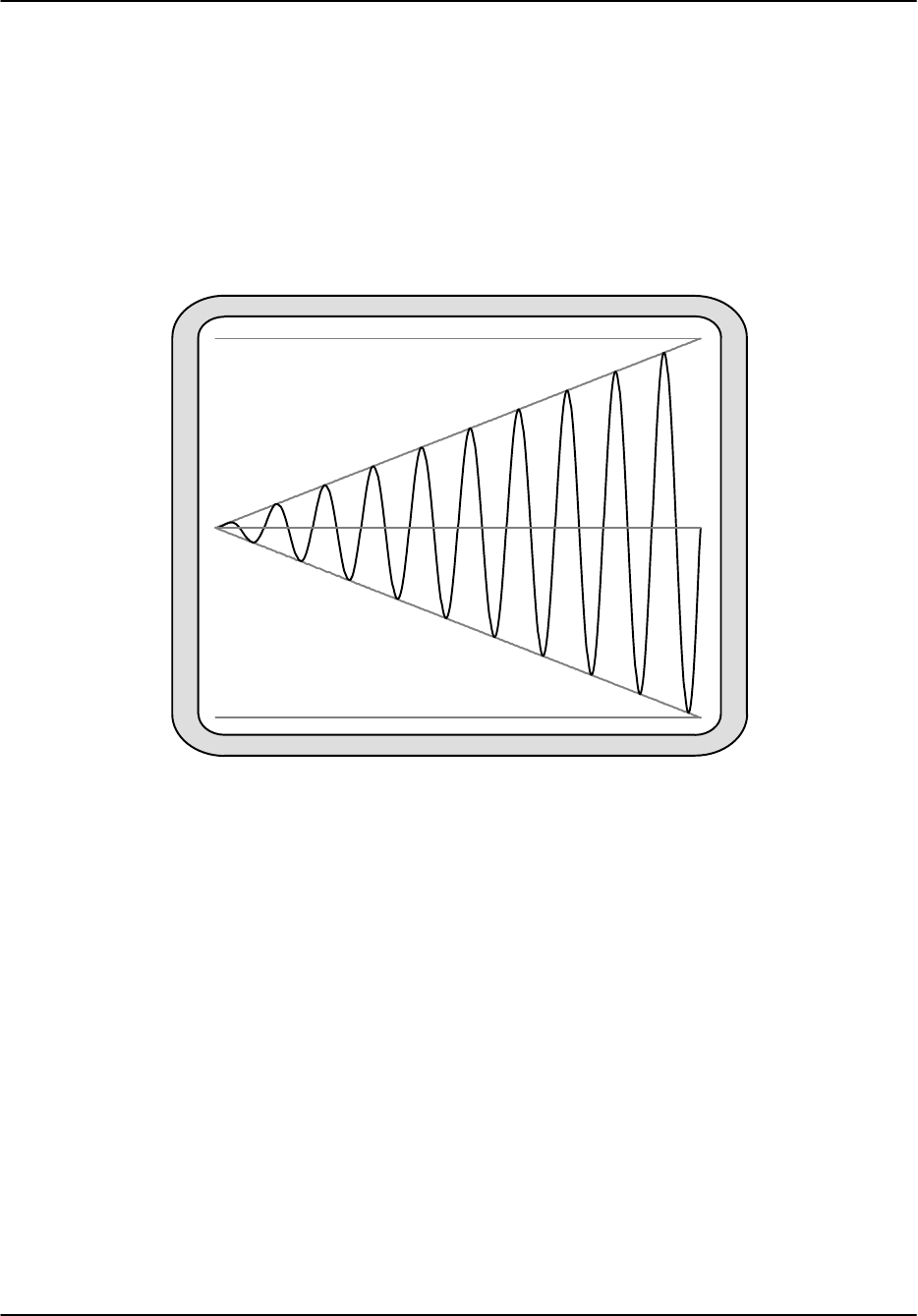
Plot–Assisted Setups
RVP8 User’s Manual
April 2003
4–3
4.2 P+ — Plot Test Pattern
The RVP8 can produce a simple test pattern that is useful when the oscilloscope is attached for
the first time. From the TTY monitor enter the “P+” command. This will print the message
“Plotting Test Pattern...” on the TTY and then produce the plot shown in Figure 4–1. This
display is actually an overlay of six different strokes: 1) bottom line, 2) middle line, 3) top line,
4) line sloping up, 5) line sloping down, and 6) the sine wave pattern. The later changes phase
with each plot so that, with a little imagination, it appears to be radiating from the left side of the
display.
Figure 4–1: Oscilloscope Display of Test Pattern
Verify that the test pattern is stable, and adjust the vertical gain so that the top and bottom lines
are exactly the full height of the oscilloscope screen. At the same time, adjust the horizontal and
vertical offsets so that the image is exactly centered. When you are satisfied that the plot is
being drawn correctly, type “Q” or ESC to return to the TTY monitor.

Plot–Assisted Setups
RVP8 User’s Manual
April 2003
4–4
4.3 General Conventions Within the Plot Commands
The “Pb”, “Ps”, and “Pr” commands all have a similar structure to their TTY user interface.
Each command begins by printing a list of subcommands that are valid in that context. These
subcommands are single keystrokes that are executed immediately by the RVP8 as they are
typed. The “ENTER” key is not required. The available subcommands are different for each
plot command; but, as much as possible, each key has a similar meaning across all commands.
The working and measured parameters for each plot command are printed on the TTY as two
lines of information following the subcommand list. The first line contains settings that only
change when a subcommand is issued; but the second line is live and reflects the current status
of the burst input, the IF input, or the AFC output. The first line is printed just once, but the
second line is continually overprinted on top of itself. This makes it appear as a live status line
whose values always remain up to date. The ”Pb”, ”Ps”, and ”Pr” commands will report ”No
Trigger” on the TTY status line whenever the external trigger is expected but missing.
The TTY screen will scroll upward each time a new subcommand is executed, so that a history
of information lines and command activity can be seen on the screen. You may also use the
Carriage-Return key to scroll the display up at any time. If the initial list of subcommands
disappears off the top, you may type “?” to force a reprint. To exit the plot command entirely
and return to the TTY main menu type “Q” or ESC. These basic “help” and “exit” keystrokes
apply everywhere within the RVP8 setup menus. To save space and minimize clutter on the
TTY screen, they are not shown in the itemized list of subcommands.
Most commands have a lowercase and an uppercase version. If a lowercase command does
something, then its uppercase version does the same thing but even more so (or in reverse). For
example, if the “w” subcommand widens something by a little bit, then “W” would widen it a
lot. This simple convention reduces the number of different subcommand keys that are needed,
and makes the interface easier to memorize.
The oscilloscope display and TTY status lines are continually updated with fresh data several
times per second. Occasionally it is useful to freeze a plot so that it can be studied in more
detail, or compared with earlier versions. To accomplish this, every plotting command supports
a “Single Step” mode that is accessed by typing the “.” (period) key. This key causes the
oscilloscope display and TTY status lines to freeze in their present state, and the message
“Paused...” will be printed. Subsequently, typing another “.” will single step to the next data
update, but the plot and printout will still remain frozen. Typing “Q” or ESC will exit the plot
command entirely (as they normally do). All other keys return the plot command to its normal
live updating, but the key is otherwise discarded (i.e., subcommand keys are not executed while
exiting from single step mode).
All of the plot commands support subcommands whose only purpose is to alter the appearance
of the display, e.g., zoom, stretch, etc. These subcommands make no changes to the actual
working RVP8 calibrations. However, the display settings are stored in nonvolatile RAM just
like all of the other setup parameters. This means that all previous display settings will be
restored whenever you restart each plot command. This is very convenient when alternating
among the various plots.

Plot–Assisted Setups
RVP8 User’s Manual
April 2003
4–5
The “Pb”, “Ps”, and “Pr” commands are intended to be used together for the combined purpose
of configuring the RVP8’s digital front end. You may, of course, run any of the commands at
any time; but the following procedure may be used as a guideline for first time setups. The full
procedure must be repeated for each individual pulsewidth that the radar supports.
1. Use Mb to set the system’s intermediate frequency (See Section 3.3.6).
2. Use Mt to choose the PRF and pulsewidth (See Section 3.3.4). Also, choose the
range resolution now, as it may constrain the design of the matched filter later.
3. Use Mt0,Mt1, etc., to set the relative timing of all RVP8 triggers that are used by
the the radar. Do not worry about the absolute values of the trigger start times.
Just setup their polarity and width, and their start times relative to each other (See
Section 3.3.5). Make an initial guess of FIR filter length as 1.5 times the
pulsewidth.
4. Use Pb to slew the start times of all triggers so that the burst pulse is properly
sampled (See Section 4.4). Refine the impulse response length if necessary so
that all samples easily fit within the display window.
5. Use Ps to design the matched FIR filter (See Section 4.5). Further refine the
impulse response length and passband width to achieve a filter that matches the
spectral width of the burst, and that has strong attenuation at DC. If the FIR
length is changed, return to Pb to verify that the burst is still being sampled
properly.
6. Continue using Ps and Mb to tune up the AFC feedback loop. The settings that
work for one pulsewidth should also work for all others.
7. Use Pr to verify that targets are being detected with good sensitivity (See Section
4.6).
Sometimes it is useful to run the Pb and Ps commands with samples from the IF-Input of the
RVP8/IFD, rather than from the Burst-Input. Likewise, it is sometimes useful to view the Pr
plots on samples of Burst data. The top-level “~” command (See Section 3.1.5) allows you to do
this easily.
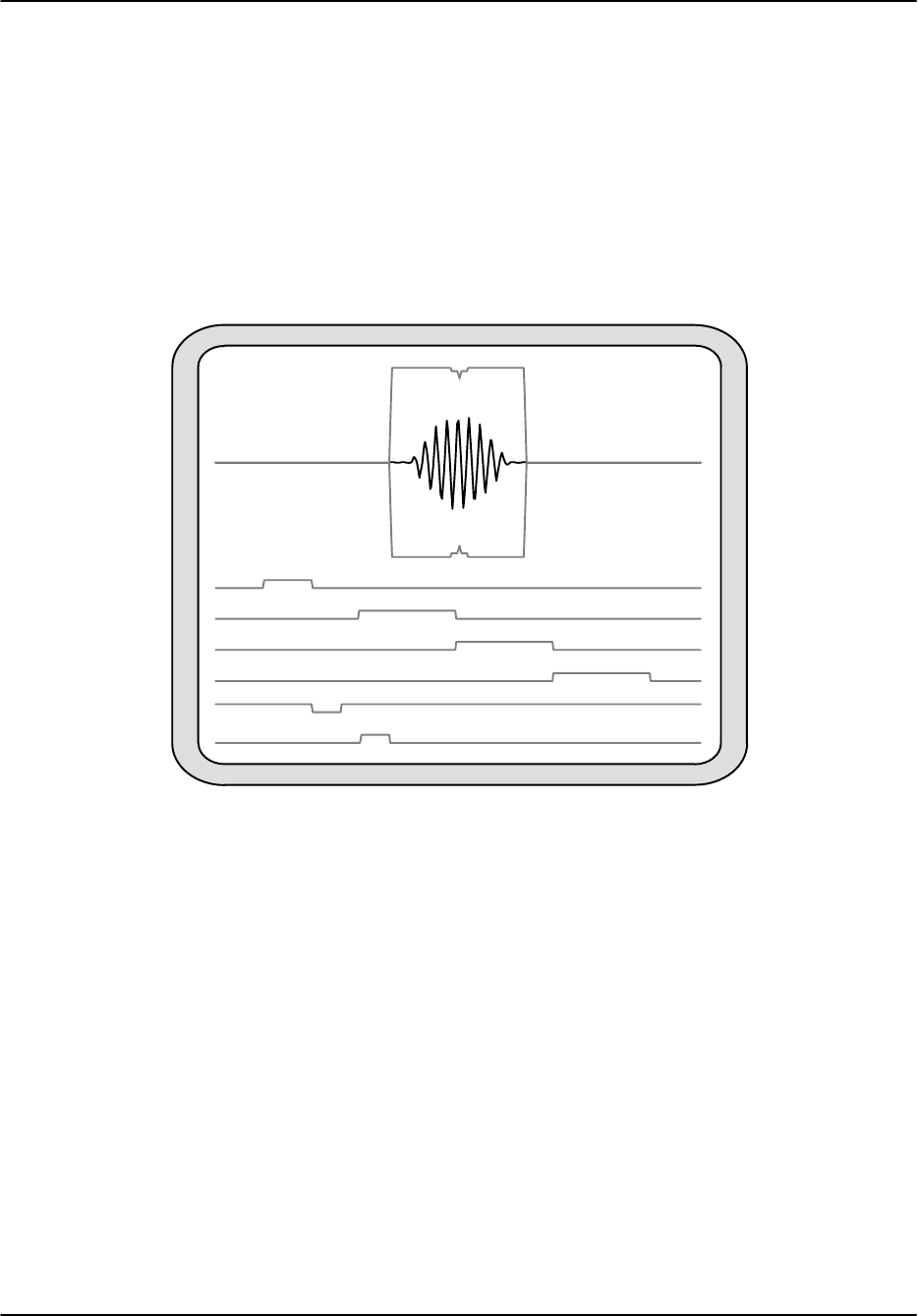
Plot–Assisted Setups
RVP8 User’s Manual
April 2003
4–6
4.4 Pb — Plot Burst Pulse Timing
For magnetron radars the RVP8 relies on samples of the transmit pulse to lock the phase of its
synthesized “I” and “Q” data, and to run the AFC feedback loop. The “Pb” command is used to
adjust the trigger timing and A/D sampling window so that the burst pulse is correctly measured.
4.4.1 Interpreting the Burst Timing Plot
The oscilloscope plot will ultimately resemble Figure 4–2, which shows a successful capture of
the transmitter’s burst pulse. The horizontal axis of the display represents time, and the overall
time span from the left edge to the right edge is listed as “PlotSpan” on the TTY.
Figure 4–2: Successful Capture of the Transmit Burst
The upper portion of the plot shows the sampling window wherein the burst pulse is measured.
The duration of this window is determined by the impulse response length of the matched FIR
filter. This is because the same FIR coefficients that compute “I” and “Q” are also used to
compute the reference phase vectors for the burst pulses. The A/D samples of the RVP8/IFD’s
burst input are plotted (somewhat brighter) within the sample window.
The RVP8 computes the power-weighted center-of-mass (COM) of the burst pulse envelope.
This allows the processor to determine the location of the “middle” of the transmitted pulse
within the burst analysis window. The Pb plot displays small tick marks on the top and bottom
of the burst sample window to indicate the location of the COM. These markers are only
displayed when valid burst power is detected. A second “error bar” is drawn surrounding the
tick mark to indicate the uncertainty of the mark itself. This error interval is used by the burst
pulse tracking algorithm to decide when a timing change can be made with confidence.
It is possible to independently choose a subinterval of burst pulse samples that are used by the
AFC frequency estimator. Thus, the AFC feedback loop is not constrained to use the same set of
samples that are chosen for the FIR filter window. The FIR window typically is longer than the

Plot–Assisted Setups
RVP8 User’s Manual
April 2003
4–7
actual transmitted pulse, and thus, the samples contributing to the frequency estimate will
include the leading and trailing edges of the pulse. These edges tend to have severe chirps and
sidebands, compared to the more pure center portion of the pulse. The AFC frequency estimate
(which is power weighted) could be mislead by these edges and might not tune to the optimum
center frequency if they were included.
The lower portion of the plot shows the six triggers that are output by the RVP8. Trigger #0 is at
the top, and Trigger #5 is on the bottom. They are drawn in their correct polarity and timing
relative to each other, and relative to the burst sample window. Note that the sample window is
always drawn in the center of the overall time span. Thus, depending on the PlotSpan and
location of the six trigger’s edges, triggers that do not vary within the plotted time span will
appear simply as flat lines.
The RVP8 defines “Range Zero” to occur at the center of the burst sample window. This also
defines the zero reference point for the starting times of the six programmable triggers. For
example, a trigger whose starting time is zero will be plotted with its leading edge in the exact
horizontal center of the display. Knowing this convention makes the absolute value of the
trigger start times more meaningful.
4.4.2 Available Subcommands Within “Pb”
The list of subcommands is printed on the TTY:
Available Subcommands within ’Pb’:
I/i Impulse response length Up/Dn
A/a & S/s Aperture & Start of AFC window
L/l & R/r Shift triggers left/right
T/t Plot time span Up/Dn
Z/z Amplitude zoom
B/b BP Tracking On/Off (temporary)
+ Hunt for missing burst
. Single Step
These subcommands change the matched filter’s impulse response length, shift the radar
triggers, and alter the format of the display.
I/i The “I” command increments or decrements the length of the matched
filter’s impulse response. Each keystroke raises or lowers the FIR
length by one tap.
A/a & S/s These commands raise/lower the aperture/start of the subwindow of
burst pulse samples for AFC. If you never use these commands, then
the full FIR window will be used; however, shortening the AFC
interval will result in two sample windows being drawn on the plot.
The smaller AFC window should be positioned into the center portion
of the transmitted pulse, where the burst amplitude and frequency are
fairly stable.
L/l & R/r These two commands shift the entire group of six RVP8 triggers left
or right (earlier or later in time). The lowercase commands shift in

Plot–Assisted Setups
RVP8 User’s Manual
April 2003
4–8
0.025 msec steps, and the uppercase commands shift in 1.000 msec
steps (approximately). The reason for shifting all six triggers at once
is that the relative timing among the triggers remains preserved.
However, the absolute timing (relative to range zero) will vary, and
this will cause the burst pulse A/D samples to move within the sample
window.
T/t The “T” command increments or decrements the overall time span of
the plot. The available spans are 2, 5, 10, 20, 50, 100, 200, 500, 1000,
2000 and 5000 microseconds. The value is reported on the TTY as
“PlotSpan”.
Z/z The “Z” command zooms the amplitude of the burst pulse samples so
that they can be seen more easily. The value is reported on the TTY as
“Zoom”.
B/b These keys temporarily disable or re-enable the Burst Pulse Tracker.
The tracker must be disabled in order for the L/R keys to be used to
shift the nominal trigger timing. The “b” key disables tracking and
sets the trigger slew to zero; the “B” key re-enables tracking starting
from that zero value.
+The “+” subcommand initiates a hunt for the burst pulse. Progress
messages are printed as successive AFC values are tried, and the
trigger slew and AFC level are set according to where the pulse was
found. If no burst pulse can be found, then the previous trigger slew
and AFC are not changed.
4.4.3 TTY Information Lines Within “Pb”
The TTY information lines will resemble:
Zoom:x2, PlotSpan:5 usec, FIR:1.36 usec (49 Taps)
Freq:27.817 MHz, Pwr:–53.9 dBm, DC:0.14%, Trig#1:–5.00, BPT:0.00
Zoom Indicates the magnification (in amplitude) of the plotted samples. A
zoom level of “x1” means that a full scale A/D waveform exactly fills
the height of the sample window. Generally, the signal strength of the
burst pulse will not be quite this high. Thus, use larger zoom levels to
see the weaker samples more clearly. You may zoom in powers of two
up to x128.
PlotSpan Indicates the overall time span in microseconds of the complete scope
display, from left edge to right edge.
FIR Indicates the length of the impulse response of the matched FIR filter,
and hence, the duration of the burst pulse sample window. The length
is reported both as a number of taps, and as a time duration in
microseconds.
Freq Indicates the mean frequency of the burst, derived from a 4th order
correlation model. The control parameters for this model are set using
the “Mb” command (Section 3.3.6).

Plot–Assisted Setups
RVP8 User’s Manual
April 2003
4–9
Pwr Indicates the mean power within the full window of burst samples.
DC offsets in the A/D converter do not affect the computation of the
power, i.e., the value shown truly represents the waveform’s
(Signal+Noise) energy.
DC Indicates the nominal DC offset of the burst pulse A/D converter. This
is of interest only as a check on the integrity of the front end analog
components. The value should be in the range 2.0%.
Trig#1 Indicates the starting time of the first (of six) RVP8 trigger outputs.
This number will vary as the “L” and “R” subcommands cause the
triggers to slew left and right. Note that if the radar transmitter is
directly fired by an external pretrigger, then the pretrigger delay (in
the form “PreDly:6.87”) will be printed instead.
BPT This shows the present value of timing slew (measured in
microseconds) being applied to track the burst. The slew will be zero
initially when the RVP8 is first powered up, meaning that the normal
trigger start times are all being used.
4.4.4 Recommended Adjustment Procedures
The burst pulse timing must be calibrated separately for each individual pulsewidth. Repeat the
following procedure for each pulsewidth that you plan to use. Each iteration is independent.
It is first necessary to setup the proper relative timing for all RVP8 triggers that are being used.
The six trigger output lines are completely interchangeable, and each may be assigned to any
function within the radar system. For example, Trigger #0 might be the transmitter pretrigger,
Triggers #2 and #3 might synchronize external displays, and Triggers #1, #4, and #5 might be
unused.
Choose an initial impulse response length of 1.5 times the transmit pulsewidth. This length will
be refined later when the matched filter is designed (See Section 4.5). Adjust the plot time span
to view a small region around the sample window, and set the initial amplitude zoom to x16.
This assures that the plotted waveform will still be noticeable even if the burst signal strength is
very weak.
Verify that the transmitter is radiating, and observe the burst pulse samples on the display. Use
the “L” and “R” commands to shift the timing of all six triggers relative to range zero. This has
the effect of moving the burst sampling window relative to the transmitted pulse. Depending on
whether the triggers are set properly, you may at first see nothing more than a flat line of
misplaced A/D samples. However, after a few moments of hunting, the burst pulse should
appear on the oscilloscope screen. Fine tune the triggers so that the burst envelope is centered in
the window, and adjust the amplitude zoom for a comfortable size display.
The clean center portion of the burst pulse should then be isolated to a narrower subwindow of
the overall FIR interval. Use the”A” and “S” commands to change the aperture and start of the
narrowed region from which the AFC frequency estimator’s data will be derived.
Check that the burst pulse signal strength is reasonably matched to the input span of the
RVP8/IFD’s A/D converter. The maximum analog signal level is +4dBm. Exceeding this level
produces distorted samples that would seriously degrade the algorithms for phase locking and

Plot–Assisted Setups
RVP8 User’s Manual
April 2003
4–10
AFC. However, if the signal is too weak, then the upper bits of the A/D converter are wasted
and noise is unnecessarily introduced. We recommend a peak signal level between –6dBm and
+1dBm, i.e., a signal that might be viewed at x2 or x4 zoom. Take note of the burst energy level
reported on the TTY; it will help decide the minimum energy threshold for a valid burst pulse,
which is needed in Section 3.3.6.
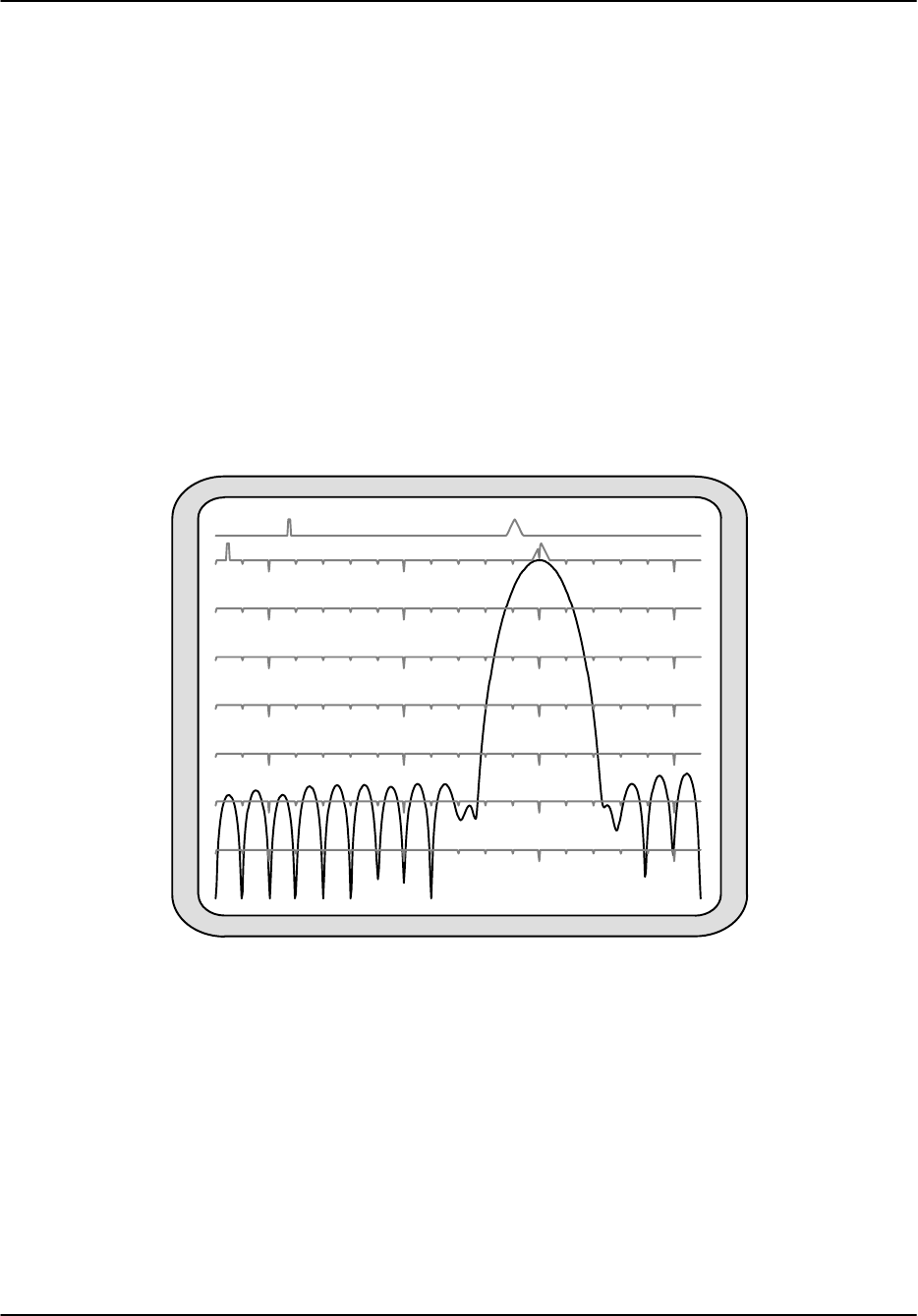
Plot–Assisted Setups
RVP8 User’s Manual
April 2003
4–11
4.5 Ps — Plot Burst Spectra and AFC
Once the transmit burst pulse has been captured the next step is to analyze its frequency content
and to design a bandpass filter that is matched to the pulse. In a traditional analog receiver the
matched filters use discrete components that can not be adjusted, and the transmit spectrum can
not be viewed unless a spectrum analyzer is on hand. The RVP8 eliminates all of these
restrictions via its “Ps” command, which plots the burst spectrum, designs the bandpass filter,
plots its frequency response, and also helps with alignment of the AFC.
4.5.1 Interpreting the Burst Spectra Plots
An example of a plot from the Ps command is shown in Figure 4–3. The oscilloscope screen is
divided into two independent areas. The major portion (the lower seven eighths) is devoted to
power spectrum plots of the burst pulse and/or the matched filter response. The top portion
(single line) serves as a visual indicator of the present AFC level.
Figure 4–3: Example of a Filter With Excellent DC Rejection
The horizontal axis of the spectrum plot represents frequency. The overall span from the left
edge to the right edge is always 18MHz, but the exact endpoints depend on which alias band the
radar’s intermediate frequency falls in. For example, a 30MHz IF would imply a horizontal axis
range of 18MHz to 36MHz, whereas a 60MHz IF would make the range 54MHz to 72MHz.
The frequency span is printed on the TTY when the command is first entered.
Since the left edge of the spectral plot always represents an integer multiple of 18MHz, either
the left side or the right side will always be a multiple of 36MHz. This is important to
remember when designing the matched filter, since fixed DC offsets in the A/D converters will
appear aliased at these 36MHz multiples.

Plot–Assisted Setups
RVP8 User’s Manual
April 2003
4–12
The vertical axis of the spectrum plot is logarithmic and is marked with faint horizontal lines in
10-dB increments. An overall dynamic range of 70 dB can be viewed at once. The horizontal
lines also contain major and minor tick marks to help calibrate the frequency axis. Major marks
are small downward triangles that represent integer multiples of 5MHz; minor marks are in
between and represent 1-MHz steps. The power spectrum example in Figure 4–3 is from a
system with an intermediate frequency of 30MHz. Thus, the left edge of the plot begins at
18MHz, and the graph is centered on the third major tick, i.e., 30MHz.
Two types of spectra can be plotted on the screen: 1) the frequency response of the FIR filter,
and 2) the frequency content of the burst pulse itself. The burst spectrum is computed by first
applying a Hamming window to the raw samples. You may choose to view either plot
individually, or both at the same time.
Figure 4–3 is an example of a single filter response plot, whereas Figure 4–4 shows a combined
display of both spectra. The combined display makes it easy to compare the filter being
designed with the live waveform that it is intended to selectively pass. Note that the filter’s
frequency response is always drawn with its passband peak touching the top of the plot. The
vertical height of the burst spectrum, however, will vary with signal strength but can be adjusted
using the “Z” subcommand.
The horizontal line at the top of the plotting area is also marked with an upward pointing major
and minor tick. These indicate the present value of the burst pulse frequency estimator. The
major tick is a triangle whose position along the horizontal axis corresponds directly to the
estimated frequency. It should always be positioned directly over the main lobe of spectral
power. The minor tick gives finer scale resolution by indicating the fractional part of each
1-MHz multiple. For example, in Figure 4–3 the burst frequency estimate was 30.027MHz.
The major tick thus appears slightly to the right of 30MHz, and the minor tick appears 2.7%
across the screen. Note that when an upward tick happens to overlap a downward tick the two
simply add together so that both can still be seen.
It is helpful to read the minor tick relative to the ten horizontal division lines that are present on
most scopes. Motion of the minor tick is apparent even with very small changes in burst pulse
frequency; a change of just 5 KHz can easily be seen. This means that you can observe the
frequency drift of the magnetron in great detail, and also watch the AFC’s behavior in real time.
The horizontal line at the very top of the display (above the spectra plot) serves to indicate the
present value of the AFC control voltage. The line contains an upward pointing major and
minor tick, similar to the ones used to represent the burst frequency estimate on the line below.
However, the horizontal axis now represents voltage rather than frequency, and the overall span
is the complete range of the AFC’s digital-to-analog converter. The major tick will move from
the left edge to the right edge as the AFC varies from its minimum to maximum value. The
minor tick will traverse the screen at ten times this rate.

Plot–Assisted Setups
RVP8 User’s Manual
April 2003
4–13
4.5.2 Available Subcommands Within “Ps”
The list of subcommands is printed on the TTY:
Frequency span of the plot is 18.0 MHz to 36.0 MHz.
Available Subcommands within ’Ps’:
I/i Impulse response length Up/Dn
N/n & W/w Filter bandwidth Narrower/Wider
U/u & D/d MFC Up/Down (On/Off ’=’ , Test ’|’)
A/a & S/s Aperture & Start of AFC window
# Print filter coefficients
$ Search for an optimal filter
V/v Number of spectra averaged
Z/z Amplitude zoom
<space> Alternate Plots
% Toggle between dual receivers
. Single Step
These subcommands change the design of the matched FIR filter, assist with calibration of the
AFC loop, and alter the format of the display.
I/i The “I” command increments or decrements the length of the matched
filter’s impulse response. Each keystroke raises or lowers the FIR
length by one tap. Often the matched filter’s characteristics can be
very much improved merely by changing the FIR length by one or two
taps. Be sure to experiment with this as you design your filter.
N/n & W/w The “N” and “W” commands change the passband width of the
matched filter, making it narrower or wider. The lower case
commands make changes in 1KHz steps, and the upper case
commands use 100KHz steps. The value is reported on the TTY as
“BW”. Often a small change in passband width will shift the exact
locations of the filter’s zeros, and possibly improve the DC rejection.
U/u & D/d The “U” and “D” commands implement the Manual Frequency
Control (MFC) override, and allow the RVP8/IFD’s AFC output
voltage to be manually set to any fixed level. The lower case
commands make changes in 0.05 D-Unit steps, and the upper case
commands use 1.0 D-Unit steps. The value is reported on the TTY as
“AFC”.
=MFC mode is toggled on and off using the “=” key. A warning will be
printed if the Ps command is exited while MFC is enabled, and you
will be given a second chance to reenable AFC.
|The AFC test submode is entered by typing the “|” key. The following
list of keybindings will be shown, and will remain in effect until the
test mode is exited by typing “Q”.
AFC Test Mode Subcommands
W Use Walking–Ones pattern
P Toggle Pin/Bit numbering
0–9,A–O Toggle AFC Bits 0–24 (Pins 1–25)

Plot–Assisted Setups
RVP8 User’s Manual
April 2003
4–14
2 2 2 2 2 1 1 1 1 1 1 1 1 1 1
4 3 2 1 0 9 8 7 6 5 4 3 2 1 0 9 8 7 6 5 4 3 2 1 0
– – – – – – – – – – – – – – – – – – – – – – – – –
O N M L K J I H G F E D C B A 9 8 7 6 5 4 3 2 1 0
The Ps command continues to run normally during the AFC test
mode. The customary AFC information will be replaced with a
hexadecimal readout of the present 25-bit value. Your live display
may look something like:
Navg:3, FIR:1.33 usec (48 Taps), BW:1.000 MHz, DC–Gain:ZERO
Freq:26.610 MHz, Pwr:–64.6 dBm, AFC–Test:0000207F (Bits)
Initially, a walking-ones bit pattern will be output in lieu of the normal
formatted AFC value. This test pattern shifts a single “1” downward
through the AFC word, making a transition approximately every 4ms.
It is intended to help ring out and test the wiring for digital AFC
installations. The walking-ones test is handy as an oscilloscope
diagnostic, and you may return to it at any time by typing “W”.
Typing any of the characters “0” through “9” or “A” through “O” will
enter a new mode in which a static 25-bit digital AFC pattern is
controlled directly. Each key toggles its corresponding bit, as
summarized in the keybindings printout. Any 25-bit pattern can be
made by toggling the appropriate bits (initially all zero) to one.
Within any particular pattern, it is also easy to toggle a particular bit
On/Off in order to verify its function.
The “P” command lets you decide whether the 25-bit word represents
a numeric AFC span that is mapped into pins via the pin-map table in
the Mb menu; or whether it represents those pins directly. The printed
hex test value will be followed either by “(Bits)” or “(Pins)”
accordingly. When in “Pins” mode, the “0” key toggles Pin-1, the “1”
key toggles Pin-2, etc. When in “Bits” mode, the “0” key toggles
whatever pin or pins have been designated to be driven from Bit-0 of
the numeric AFC. The “Pins” mode is useful when you are doing the
initial electrical tests of the wiring of each pin. After the pin wiring
has been verified and the Mb mapping table has been created, then the
“Bits” mode allows you to test the complete digital AFC interface.
#The “#” command results in a printout of the coefficients of the
current FIR filter. The values are scaled by the coefficient with the
largest absolute value, so that they all fall within the –1 to +1 range.
This detailed information may be used to model the behavior of the
filter for point targets that fall in between discrete range bins, e.g., as
will happen when performing a radar sphere calibration. See Section
5.1.1 for the exact definition of these coefficients.
$The “$” command performs an automatic search for optimal (DC gain
of zero) filters in the vicinity of the current one. As an example,
suppose that we wanted an optimal filter that was approximately 2.2
msec long and 650 KHz wide. We would first use the “I/i” and

Plot–Assisted Setups
RVP8 User’s Manual
April 2003
4–15
“W/wN/n” subcommands to manually move to that starting point.
Typing “$” would then print a dialog line in which the search span
length and width are chosen. You may keep the indicated values or
type in new ones, just as for all RVP8 setup questions. The search
begins when the spans are accepted.
The search procedure may require a few seconds to a few minutes,
depending on the length and width spans that are being scanned.
During this time, a progress message is printed showing the length and
width currently under examination. You may type “Q” to abort the
search and retain the original filter settings. When the search
completes normally, it will print “Done” and replace the old filter
settings with the best ones that could be found.
In dual-receiver mode, the ”$” command will search for a filter that
minimizes the maximum width and DC offset at both receiver’s
intermediate frequencies. The final filter will be the one that has the
best simultaneous performance at both IFs.
V/v The “V” command increments or decrements the number of burst
pulse spectra that are averaged together to create the plot. The count
ranges from one (no averaging) to 25, and is reported on the TTY as
“Navg”.
Z/z The “Z” command zooms (i.e. shifts on a logarithmic scale) in 1.0-dB
steps the amplitude of the burst pulse spectra. This is useful when the
overall 70dB plot span is not sufficient to hold the full range. Zoom
can also be used to line up the burst spectrum with the filter response
so that the two can be compared. The zoom level is not printed on the
TTY because there is nothing useful that could be done with it.
<space> The space bar alternates among three choices for the type of spectra
that are plotted: 1) FIR frequency response, 2) Burst pulse spectrum,
and 3) Both.
%In dual-receiver mode, the “%” command toggles between each
receiver. The printed status line is prefixed with ”Rx:Pri” or ”Rx:Sec”
according to which receiver is selected. Specifically, typing “%” will
toggle the plot of the FIR filter’s frequency response, and the printout
of its DC–Gain. However, the plotted spectrum and printed power
levels are always based on the sum of all input signals, and thus do not
change with “%“.
4.5.3 TTY Information Lines Within “Ps”
The TTY information lines will resemble:
Navg:3, FIR:1.33usec (48 Taps), BW:1.000, MHz, DC–Gain:ZERO
Freq:30.027 MHz, Pwr:–64.2 dBm, Loss:1.2dB, AFC:23.05% (Manual)
Navg Indicates the number of burst spectra that are averaged together prior
to plotting. Larger amounts of averaging increase the ability to see
subtle spectral components, but the display will update more slowly.

Plot–Assisted Setups
RVP8 User’s Manual
April 2003
4–16
FIR Indicates the length of the impulse response of the matched FIR filter.
See description on Page 4–8.
BW Indicates the actual 3dB bandwidth of the matched filter. This is the
complete width of the passband from the lower frequency edge to
upper frequency edge. Note that the filter’s center frequency is fixed
at the radar’s intermediate frequency, as chosen in the “Mb” setup
command.
DC-Gain Indicates the filter’s response to DC (zero frequency) input. The value
is a negative number in decibels, or the word “ZERO” if the filter has
a true zero at DC. The filter’s DC gain should be kept at a minimum
so that fixed offsets in the A/D converters will not propagate into the
synthesized “I” and “Q” values.
Freq Indicates the mean frequency of the burst. See description on Page
4–8.
Pwr Indicates the average power in the full burst sample window. See
description on Page 4–9.
Loss The filter loss is a positive number in deciBels, and is only displayed
if the overall burst power exceeds the minimum valid burst threshold
set in the Mb command (clearly, it would not be possible to compute
the filter loss when the burst waveform is missing). The filter loss is
discussed further in Section 4.5.4.
AFC Indicates the level and status of the AFC voltage at the RVP8/IFD
module. The number is the present output level in D-Units ranging
from –100 to +100. The shorter “%” symbol is used since percentage
units correspond in a natural way to the D-Units.
An additional number in square brackets will be printed to the right of
the AFC level to show the encoded bit pattern which corresponds to
that level. This will only appear when the RVP8 deduces that a special
digital format is being used, i.e., when the backpanel phase-out lines
have been configured for AFC, or when any of the following are not
true: a) the low and high numeric AFC span is –32768 to +32767, b)
the uplink is enabled, c) the uplink format is binary, and d) pinmap
protocol is OFF. Binary format is printed in base-10, BCD format is
printed in Hex, and 8B4D format is printed with the low 16-bits (four
BCD digits) in Hex and the upper bits in base-10.
The AFC mode is shown to the right of the numerical value(s), and
can take on the following states.
(Disabled) Indicates that neither AFC nor MFC are enabled. The
output voltage remains fixed at 0% (center of its range).
(Manual) Manual Frequency Control (MFC) is overriding AFC.
The “U” and “D” commands can be used to slew the
voltage up and down.
Whenever any of the following four states appears, it implies that AFC
is enabled and that MFC is disabled.

Plot–Assisted Setups
RVP8 User’s Manual
April 2003
4–17
(NoBurst) The energy in the burst is below the minimum energy
threshold for a valid pulse (See Page 3–26). The AFC
loop remains idle.
(Wait) The burst pulse has become valid just recently, but the
AFC loop is idle until the transmitter stabilizes (See
Page 3–27)
(Track) The burst pulse is valid, and the AFC loop is tracking
in order to bring the burst frequency within the inner
hysteresis limits.
(Locked) The burst pulse is valid and the AFC loop is locked.
The burst frequency is now within the outer hysteresis
limits and has previously been within the inner limits
while tracking. This is the stable operational mode in
which data acquisition should take place.
4.5.4 Computation of Filter Loss
The Ps printout displays the power loss (calibration error) that results when the given filter is
applied to the given transmit burst waveform. This allows you to correct for the difference
between what a broad-band power meter measures as the overall transmit power, and what the
RVP8 narrow-band receiver will detect within its passband. The filter loss is a subtle quantity
that depends on the combined characteristics of both the transmit waveform and the receiver
matched filter.
The filter loss is zero if the burst waveform consists of a pure sinusoid at the designated
intermediate frequency. It is also very near zero as long as most of the burst energy is confined
within the passband of the RVP8’s filter. The filter loss will increase as the bandwidth of the
burst waveform increases and begins to spill out of that passband. Typical losses for a
well-matched filter are in the 0.5–1.8dB range, depending on the FIR length and other design
criteria.
As an example, consider how the RVP8 filters would respond to a simple rectangular pulse of
energy lasting To seconds. For this discussion we can ignore the sinusoidal IF carrier that must
also be present within the pulse, and just focus on the rectangular envelope. This is valid
because the signal bandwidth, and hence the filter loss, is determined entirely by the shape of the
modulation envelope. For a pulse of length To to have unit-energy it must have an amplitude of
1ńTo
Ǹ . By centering this pulse at time zero the power spectrum is easily computed using a
real-valued integral:
S(f)+ȧ
ȧ
ȡ
Ȣŕ
Toń2
–Toń2
1
To
Ǹcos( 2pft)dt ȧ
ȧ
ȣ
Ȥ
2
+sin2(pfT
o)
p2f2To
where f is the frequency in Hertz. This is the familiar “synch” function, whose main frequency
lobe extends from –1ńTo to 1ńTo Hertz, and whose total power integrated over all frequencies
is 1.0.

Plot–Assisted Setups
RVP8 User’s Manual
April 2003
4–18
We can now examine what the filter loss (dBloss ) would be if this pulse were applied to a
bandpass filter. The filter loss is simply the ratio of the power that is passed by the filter, divided
by the total input power (1.0 in this case). Assume for the moment that the filter is an ideal
bandpass filter centered at zero Hertz (corresponding to how S(f) was defined) and having a
bandwidth Bw, then:
dBloss +–10 log10
ȧ
ȧ
ȡ
Ȣŕ
Bwń2
–Bwń2
S(f)df ȧ
ȧ
ȣ
Ȥ
This integral can be computed for a few “interesting” filter bandwidths, yielding filter losses of
0.44dB, 1.11dB, and 3.31dB when Bw is 2ńTo, 1ńTo, and 1ń2To respectively. These three
example bandwidths correspond to filters that pass the entire main frequency lobe, half of that
lobe, and one quarter of it.
You can experimentally verify these results using the RVP8 as follows:
SUsing the Mt0 command, setup a To+0.5 msec trigger pulse from the RVP8 in
the vicinity of range zero, and use that trigger to gate a signal generator whose
output is applied to the RVP8/IFD Burst Input. Also setup 125-meter range
resolution, and a rather long 6.0 msec impulse response length. The long length
will make the transition edges of the matched filter as steep as possible, so that it
becomes a reasonably good approximation to the ideal bandpass filter used in the
above analysis.
SUse the Pb command to verify that the burst pulse is present, and position the
triggers left and right until the pulse is centered exactly at zero.
SUse the Ps command to examine the frequency spectrum of the pulse. You
should see a main energy lobe that is 4MHz wide and centered at the radar’s IF.
There should also be weaker lobes spaced 2MHz apart on both sides of the main
lobe. If the lobe spacing does not look quite right, it may be because the signal
generator has slightly shortened or lengthened the trigger gate.
SContinue using Ps to examine filters that are 4MHz, 2MHz, and 1MHz wide at
their 3dB points. You should see filter losses reported that are very close to the
theoretical values for the ideal bandpass filter.
In the above analysis we have assumed that S(f) is the idealized power spectrum of a continuous
time signal. Of course, the RVP8 filter loss algorithm can only work from an estimate of S(f)
that is obtained from a finite number of samples. The filter loss calculation thus becomes more
complicated than the above example in which we integrated an idealized filter response over an
idealized power spectrum.
Let B
^(f) denote the estimated power spectrum of the continuous-time Tx burst waveform, for
which we have only a finite number of discrete samples {bn}. For purposes of this discussion
we can assume that the frequency variable f is continuous. Furthermore, let C
^(f) denote a

Plot–Assisted Setups
RVP8 User’s Manual
April 2003
4–19
power spectrum estimate that is derived in an identical manner using the same number of
samples, but of a pure sine wave at the radar’s IF. The RVP8 determines B
^(f) according to its
sampled measurement of the transmitted waveform; however it can calculate C
^(f) internally
based on an idealized sinusoid. The reported filter loss is then:
dBloss +–10 log10
ȧ
ȧ
ȧ
ȧ
ȡ
Ȣ
ŕ|H(f)|2B
^(f)df
ŕB
^(f)df
Bŕ|H(f)|2C
^(f)df
ŕC
^(f)df
ȧ
ȧ
ȧ
ȧ
ȣ
Ȥ
Where |H(f)|2 is the spectral response of the RVP8 IF filter, and the integrals are performed over
the Nyquist frequency band that is implied by the RVP8/IFD sampling rate. Note that the two
integrals involving C
^(f) will have constant value and need only be computed once. They serve
to normalize the B
^(f) integrals in such a way that the filter loss evaluates to 0dB whenever the
transmit burst is a pure tone at IF.
This normalization is necessary for the filter loss values to be meaningful. Regardless of the
bandwidth and center frequency of H(f), the filter loss should be reported as 0dB whenever the
Tx waveform appears to have zero spectral width, i.e., is indistinguishable from a pure IF
sinusoid. Of course, the real Tx waveform has only finite duration, and thus should never look
like a pure tone as long as the RVP8 is able to “see” the entire Tx envelope. For this reason, it is
important that the filter’s impulse response length be set long enough (using the Pb plot) to
insure that all of the details of the Tx waveform are being captured. If the entire Tx envelope
does not fit within the FIR filter, then the filter loss will be underestimated because the Tx
spectrum will appear to be narrower than it really is.
The RVP8’s calculation of digital filter loss is very similar to how the loss of an analog filter
would be measured on a test bench. Suppose we are given an analog bandpass filter and are
asked to determine its spectral loss when a given waveform is presented. We could use a power
meter to measure the waveform power before and after the filter is inserted, and compute the
ratio of these two numbers. This corresponds to the first integral ratio in the above equation.
However, this is not by itself an accurate measure of filter loss because it does not take into
account the bandwidth-independent insertion loss. Put another way, a flat 3dB pad would seem
to produce a 3dB filter loss in the above measurement, but that is certainly not the result that we
desire. The remedy is to make a second pair of power measurements of the filter’s response to a
CW tone at the passband center. This serves to calibrate the gain of the filter, and allows us to
compute a filter loss that captures the effects of spectral shape independent of overall gain. This
normalization step corresponds to the second integral ratio in the above equation.
If your radar calibration was performed using CW waveforms, then the reported filter loss
should either be added to the receiver calibration losses, or subtracted from the effective transmit
power; the net result being that dBZ0 will increase slightly.
In dual-receiver systems the filter loss is computed for the primary and secondary channels using
only the portion of bandwidth that is allocated to that channel. For example, if the two IFs are
24MHz and 30MHz, then the filter losses for each channel would use the frequency intervals
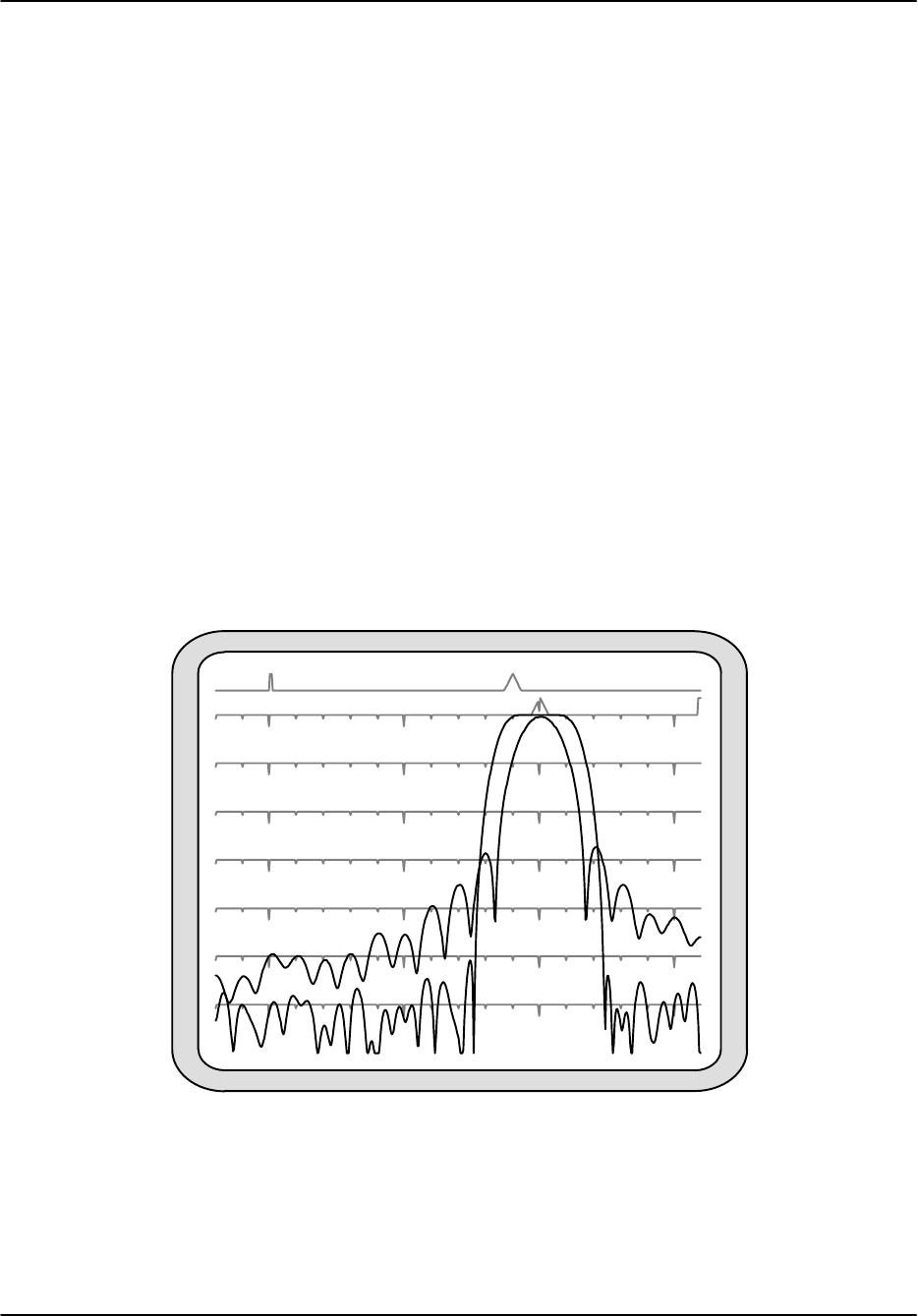
Plot–Assisted Setups
RVP8 User’s Manual
April 2003
4–20
21–27MHz and 27–33MHz respectively. This is necessary to avoid picking up energy from the
other receiver and interpreting it as out-of-band input power. A consequence, however, is that
the real out-of-band power is underestimated, i.e., the filter loss itself is underestimated. We
recommend temporarily switching dual-receiver systems back to single-receiver mode when the
filter loss is being measured. This is easily done by changing the Mc setup question back to
“single”, and disconnecting the secondary burst input to the RVP8/IFD.
4.5.5 Recommended Adjustment Procedures
The Ps command should be used only after the burst pulse has been successfully captured by
way of the Pb command. Use the <space> key to display the burst spectrum plot by itself, and
use the “Z” key to shift the entire graph into view. You are now looking at the actual frequency
content of the transmitted pulse. The plot should show a clean main power lobe centered at the
receiver’s intermediate frequency. Check the spectrum for spurious harmonics, excessive width,
and other out-of-band noise. Make any adjustments in the transmitter that might give a sharper
main lobe or reduced spurious noise.
Once we know the power spectrum of the transmitted pulse we can begin designing the matched
FIR filter. Use the <space> key to display both the filter response and the burst spectrum on the
same plot. Use the “Z” key to shift the burst’s main lobe up to the top horizontal line of the
graph. This makes it level with the filter’s peak lobe, which is always drawn tangent to the same
top line.
Figure 4–4: Example of a Poorly Matched Filter
Begin with the FIR length that was chosen previously in the Pb command, and use the “N” and
“W” keys to set an initial bandwidth equal to the reciprocal of the pulsewidth. The main lobes
of the two plots should more-or-less overlap. Experiment with changing the FIR length and
bandwidth to achieve a filter with the following properties.

Plot–Assisted Setups
RVP8 User’s Manual
April 2003
4–21
SThe filter width should be no greater than the burst spectral width. A wider
passband will reduce the SNR of the received signal because out-of-band noise
would be allowed to pass.
SThe DC gain should be as small as possible, preferably less than –64dB (See
discussion below).
SIf there are conspicuous interference spikes at particular frequencies, try to adjust
the location of the filter’s zeros so that the interference is maximally attenuated.
The filter should not pass any frequencies that do not actually contain useful information from
the original transmitted pulse. If anything, choose a filter whose width is slightly narrower than
the burst’s spectral width. Figure 4–4 shows an example of a filter that is poorly matched to the
pulse. Although the filter has fairly good DC rejection, it passes frequencies that are outside of
the transmitter’s broadcast range. These frequencies contribute nothing but noise to the
synthesized “I” and “Q” data stream.
There are two procedures for optimizing the performance of the FIR filter:
SManual Method –– The process of arriving at a nearly optimal filter will
require a few minutes of hunting with the “I”, “W”, and “N” keys. Every time
you press any of these keys the RVP8 designs a new FIR filter from scratch, and
displays the results. Fortunately, the DSP chips are fast enough that this can be
done quickly and interactively. Even though the user must still control two
degrees of freedom (length and bandwidth), the RVP8’s internal design
calculations are actually performing several hundred iterative steps each time,
which preferentially select for the best filter. Because the FIR coefficients are
quantized in the filter chips themselves, the process of finding an optimal filter
becomes quite nonlinear.
SAutomatic Method –– Simply type the “$” command and let the RVP8 do all
of the work (See description in Section 4.5.2).
The offset error of the RVP8/IFD’s A/D converter is at most 10mV, i.e., –27dBm into its 50W
input. If we wish to achieve 85-dB of dynamic range below the converter’s +4dBm saturation
level, then we expect usable “I” and “Q” values to be obtainable from a (sub-LSB) input signal
at –81dBm. This is 54dB below the interference that would result from the worst-case A/D
offset. But a weak input signal at –81dBm would still be damaged by even an equal level of DC
interference. Therefore, adding another 10dB safety margin, we get –64dB as the recommended
maximum DC gain of the matched filter. This DC gain should be reduced even further if it is
known that coherent leakage is present in the receive signal at a level greater than the –27dBm
worse-case A/D offset.
Figure 4–5 shows a 30MHz filter with particularly poor (–42dB) DC rejection. The frequency
range of the plot is 18MHz–36MHz; hence, DC appears aliased at the right edge. Not only is
there a peak in the filter’s stopband at DC, but it is the largest stopband peak anywhere in the
plot. Contrast this with the filter shown in Figure 4–3 that has a true zero at DC. In general, a
poor filter can be converted into a “nearby” good filter by making only incremental changes to
the impulse response length and/or desired bandwidth.
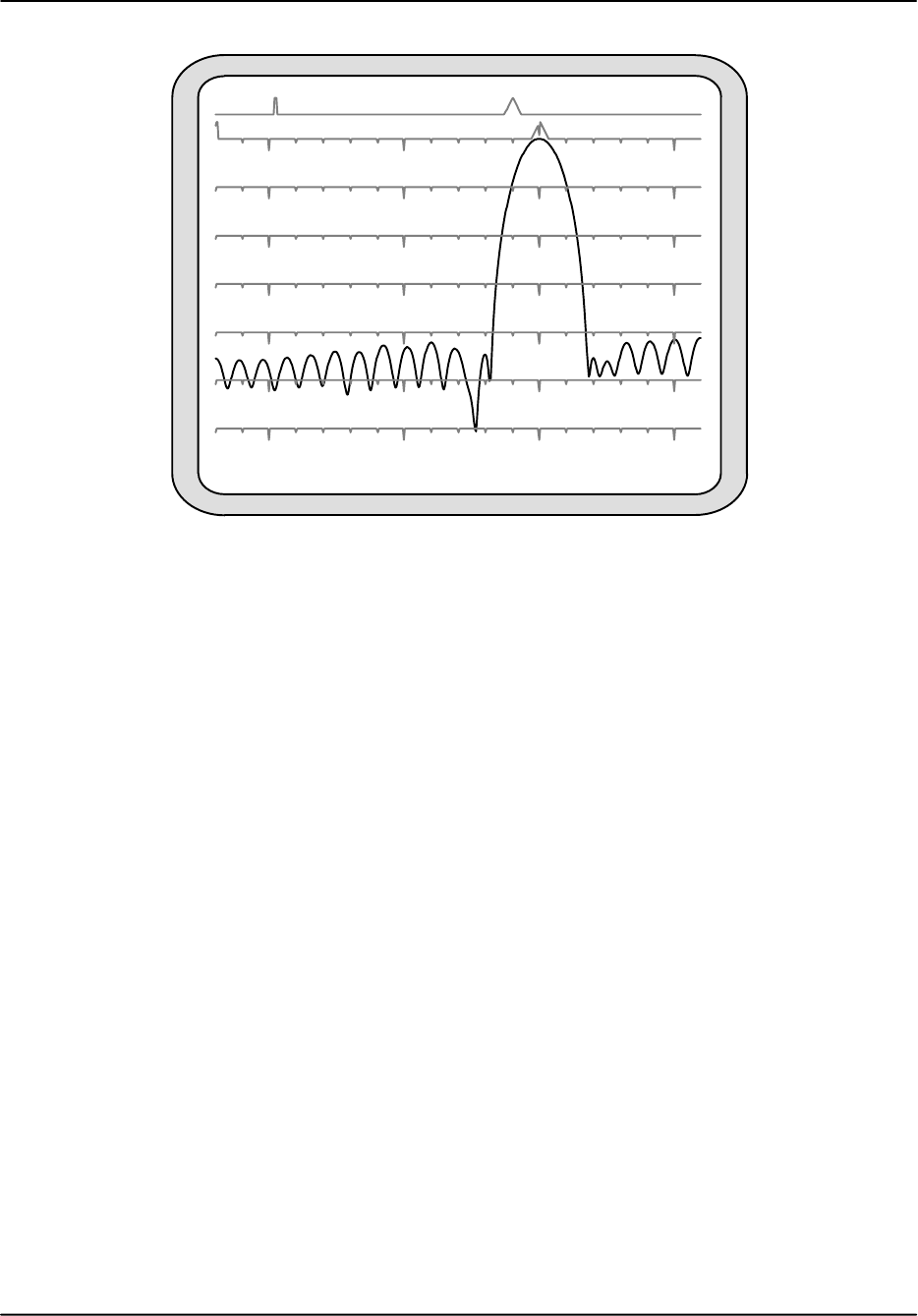
Plot–Assisted Setups
RVP8 User’s Manual
April 2003
4–22
Figure 4–5: Example of a Filter With Poor DC Rejection
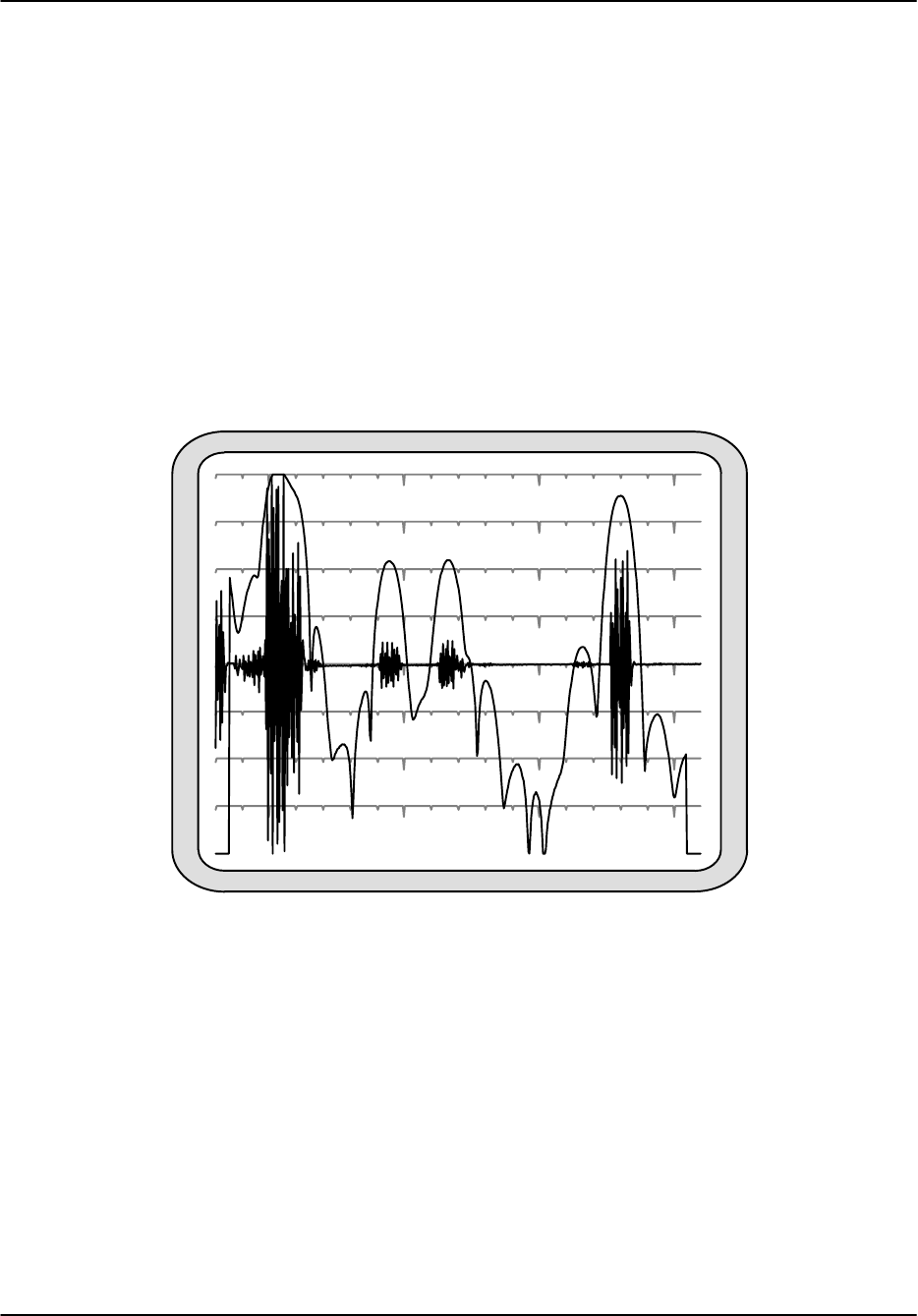
Plot–Assisted Setups
RVP8 User’s Manual
April 2003
4–23
4.6 Pr — Plot Receiver Waveforms
The “Pb” and “Ps” commands described in the previous sections have been used to analyze the
signal that is applied to the “Burst-In” connector of the RVP8/IFD receiver module. The task
that remains is to checkout the actual received signal that is connected to “IF-In”. The goal is to
verify that the received signal is clean and appropriately scaled, and that nearby targets can be
seen clearly. The “Pr” command is used to make these measurements.
4.6.1 Interpreting the Receiver Waveform Plots
An example of a plot from the Pr command is shown in Figure 4–6. The horizontal axis
represents time (range) starting from a selectable offset and spanning a selectable interval. The
data are acquired from a single transmitted pulse, are are plotted both as raw IF samples and as
the LOG of the detected power using the FIR filter for the current pulsewidth.
Figure 4–6: Example of Combined IF Sample and LOG Plot
The IF samples are plotted on a linear scale as signed quantities, with zero appearing at the
center line of the scope. Any DC offset that may be present in the A/D converter is not
removed, and will be seen as a shift in the baseline at higher zoom levels. For example, the
converter’s worst case DC offset of 10mv would appear as a 91-count offset in the 12-bit range
spanning –2048 to +2047. At the x32 or higher zoom scales, this offset would peg the sample
plot off scale. Typically the DC offset will be much less than this worst case value; but the
RVP8 preserves the DC term in the Pr sample plot so that its presence is not forgotten.
The “AC” amplitude of the IF samples will increase wherever targets are present. On top of
these samples is drawn the detected power on a logarithmic scale. Each horizontal line
represents a 10dB change in power. The graph is scaled so that the LOG power reaches the top
display line when the samples occupy the full amplitude span. Using Figure 4–6 as an example,

Plot–Assisted Setups
RVP8 User’s Manual
April 2003
4–24
the two equal-power targets just to the left of center are approximately 18dB down from the top.
The amplitude of the samples is thus 10(*18ń20) +0.13, i.e., 13% of full scale. This
correspondence between the LOG scale and the amplitude scale applies regardless of the plot’s
zoom level. As the IF samples are zoomed up and down by factors of two, the LOG plot will
shift up and down in 6dB steps.
The LOG plot is obtained by convoluting the FIR filter coefficients with the raw IF data
samples, and then plotting log(I2)Q2) at each possible offset along the sampling interval.
This convolution produces only (1 + N – I) output points, where N is the number of sample
points and I is the length of the FIR filter. For this reason the LOG plot begins approximately
I/2 samples from left side and ends approximately I/2 samples from the right.
The LOG points are computed at each possible offset within the raw IF samples. At the nominal
35.975MHz sampling rate the spacing between LOG samples will be a mere 8.33 meters. Thus,
the LOG plot gives a very detailed view of received power versus range. Of course, successive
LOG points will be highly correlated because successive input data intervals differ by only one
sample point. This is why the LOG plots appear smooth compared to the instantaneous variation
of the raw IF samples.
As the starting offset of the Pr plot is decreased to range zero you will begin to see part of the
burst pulse (the second half of it) appear at the left edge of the plot. This is because the burst
data samples are multiplexed onto the same fiber cable that carries the IF data samples. Zero
range is defined to occur at the center of the burst window; hence, the later half of the burst
pulse will be visible when the plot begins at range zero.
A second type of Pr display is shown in Figure 4–7. This plot shows a frequency spectrum of
the received data samples in a format that is nearly identical to the Ps display. The horizontal
axis represents the same band of frequencies (half the sampling rate), and the vertical axis
represents power in 10dB steps. The entire vertical axis is used so that an overall span of 80dB
is visible. This particular plot was made with the time span set to 50 msec, and with a 1-meter
antenna attached to the IF input so that a broad range of signals (radio stations, electrical noise,
etc.) would be detected.
The purpose of the Pr power spectrum is to check for spurious interference in the IF signal from
the radar receiver. The spectrum should be viewed with the transmitter turned off, and with the
starting range moved out so that the burst samples are not mixed in with the receiver data. The
power spectrum is computed using the complete interval of raw IF samples which, depending on
the chosen time span, may contain many hundreds of points. The frequency resolution of the Pr
spectrum can therefore be quite fine; making it possible to discern any interfering frequencies
with some detail.
The Pr spectrum plot will properly show a 0-Hz peak from any DC offset in the A/D converter,
and is thus consistent with how the DC offset is presented in the Pr sample plot. Both of these
plots preserve the DC component of the IF samples so that it can be monitored as part of the
routine maintenance of the receiver system. This is one of the few places in the RVP8 menus
and processing algorithms where the DC term deliberately remains intact.
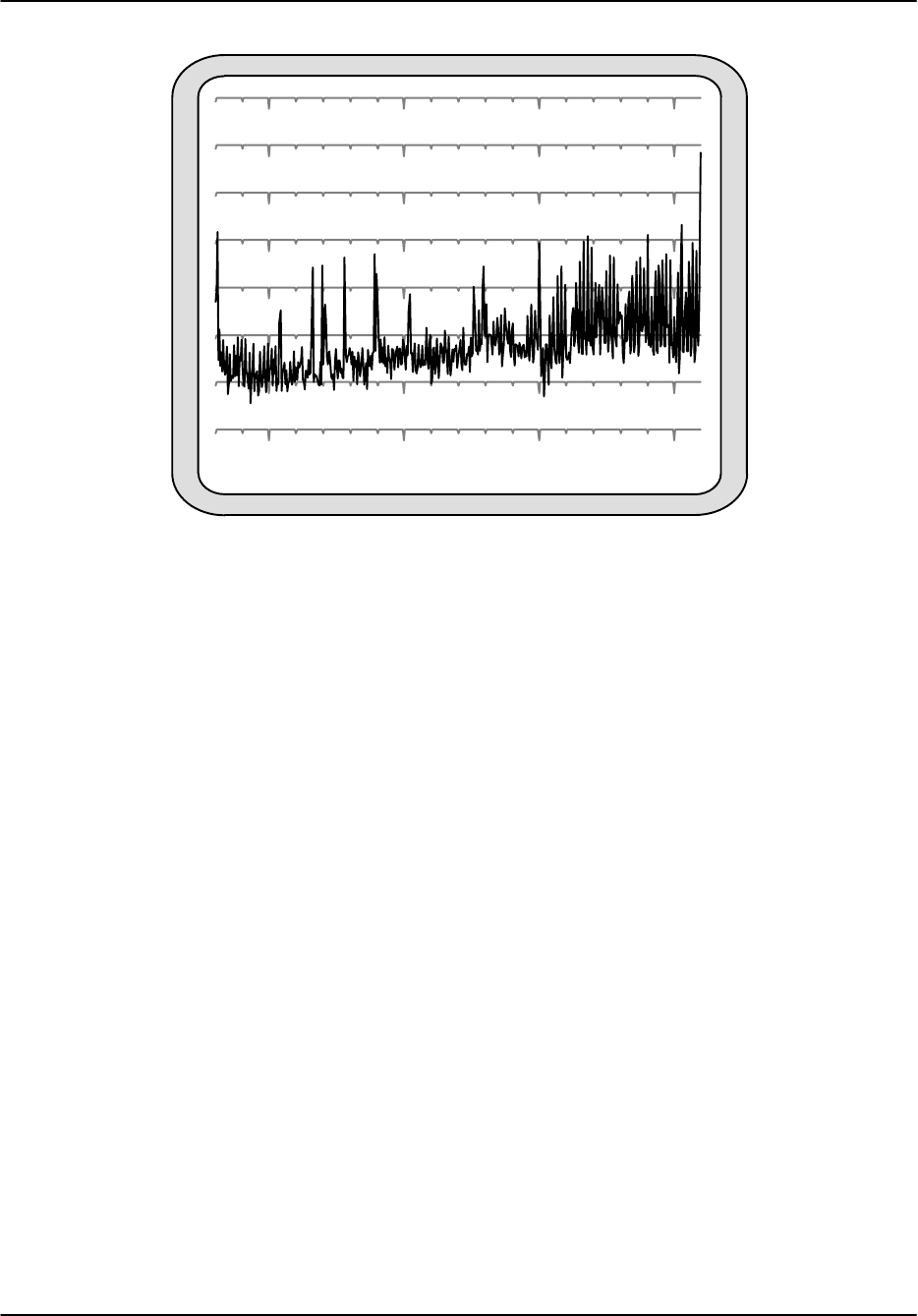
Plot–Assisted Setups
RVP8 User’s Manual
April 2003
4–25
Figure 4–7: Example of a Noisy High Resolution “Pr” Spectrum
4.6.2 Available Subcommands Within “Pr”
The list of subcommands is printed on the TTY:
Available Subcommands within ’Pr’:
L/l & R/r Start range Left/Right
T/t Plot time span Up/Dn
V/v Number of spectra averaged
Z/z Amplitude zoom
<space> Alternate Plots
% Toggle between dual receivers
. Single Step
These subcommands change the start time and span of the IF sampling window, and alter the
format of the display.
L/l & R/r The “L” and “R” commands shift left and right the starting point of
the window of IF samples. The lower case commands shift in 0.25
msec steps, and the upper case commands use 10 msec steps. The
starting point is displayed both in microseconds and kilometers on the
TTY, and is not allowed to be set earlier than range zero.
T/t The “T” command increments or decrements the time duration of the
window of IF samples. The window is not allowed to become shorter
than the impulse response length of the FIR filter, since that would
preclude calculating even a single LOG power point. The value is
reported in microseconds on the TTY, and the largest permitted span is
50 msec.

Plot–Assisted Setups
RVP8 User’s Manual
April 2003
4–26
V/v The “V” command increments or decrements the number of power
spectra that are averaged together to create the plot. The count ranges
from one (no averaging) to 25, and is reported on the TTY as “Navg”.
Z/z The “Z” command zooms the amplitude of the IF samples by factors
of two from one to 128. The LOG plots are shifted in corresponding
6dB increments as the amplitude is zoomed up and down. The zoom
level is reported on the TTY so that absolute power levels and A/D
usage can be assessed.
<space> The space bar alternates among three choices for the type of data that
are plotted: 1) Received Samples, 2) Received Samples and LOG
Power, and 3) Received Power Spectrum.
%In dual-receiver mode, the “%” command toggles between each
receiver. The printed status line is prefixed with ”Rx:Pri” or ”Rx:Sec”
according to which receiver is selected. Specifically, typing “%” will
toggle the LOG plot of the received power, and the printout of the
“Total”, “Filtered”, and “Midpoint” powers. However, the plots of
power spectra and raw IF data samples are always based on the sum of
all input signals, and thus do not change with “%”.
4.6.3 TTY Information Lines Within “Pr”
The TTY information lines will resemble:
Zoom:x1, Navg:4, Start:0.00 usec (0.00 km), Span:5 usec
Total:–63.3 dBm, Filtered:–77.6 dBm, MidSamp:–77.4 dBm
Zoom Indicates the magnification (in amplitude) of the plotted samples. A
zoom level of “x1” means that a full scale A/D waveform exactly fills
the vertical height of the plot. Generally, the IF signal strength will
not be quite this high. Thus, use larger zoom levels to see the weaker
samples more clearly. You may zoom in powers of two up to x128.
Navg Indicates the number of spectra and/or LOG powers that are averaged
together prior to plotting. Larger amounts of averaging increase the
ability to observe subtleties of the signals, but the display will update
more slowly.
Start Indicates the starting time of the IF sample window relative to range
zero. The time is shown both in microseconds and in kilometers.
Span Indicates the time span of the IF sample window in microseconds.
Total Indicates the total RMS power that is being detected by the IF-Input
A/D converters. This total is computed using all of the raw IF samples
in the chosen interval, and is the sum of power at all frequencies other
than 0 Hz (and its aliases).
Filtered Indicates the RMS power that falls only within the passband of the
FIR filter for the current pulsewidth. This is computed using all of the
raw IF samples in the chosen interval.
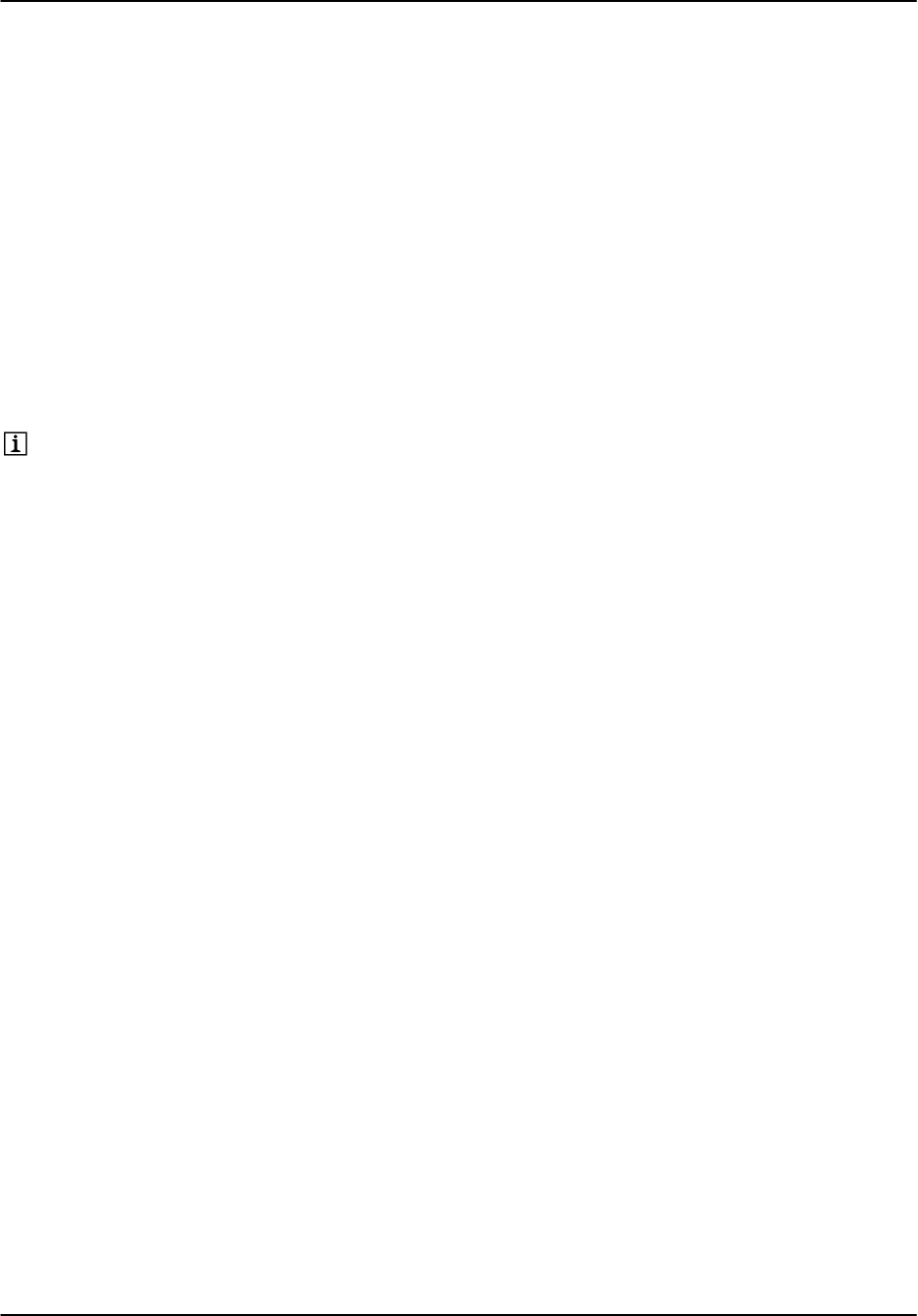
Plot–Assisted Setups
RVP8 User’s Manual
April 2003
4–27
MidSamp Also indicates the RMS power within the passband of the FIR filter,
but using only the raw IF samples in the exact center of the chosen
interval.
The computation of “Total Power” is performed using the same subset of central IF samples that
are used to compute “Filtered Power”. This smaller subset of IF samples comes about because
filtering the data requires a convolution with the current FIR filter, and this computation does
not produce results all the way to the edges of the input data. This is the same reason that the
LOG plots do not extend across the full screen.
Because of this definition, it is valid to intercompare the “Total Power” and “Filtered Power”.
The two numbers will match exactly as long as all of the incoming power falls within the
passband of the FIR filter. The difference between the two powers can be used as a measure of
the “filter loss” for a given pulse shape, i.e., the portion of signal that is lost outside of the
filter’s passband.
Note: The “Total”, “Filtered”, and “MidSamp” values represent true RMS
power (i.e., variance), and not merely a sum-of-squares. Thus, any DC offset
present in the A/D converter will not affect these power levels.

Processing Algorithms (draft)
RVP8 User’s Manual
April 2003
5–1
5. Processing Algorithms (draft)
This draft chapter is based on the legacy RVP7 algorithms. The RVP8 will have some
additional features and may not contain some of the legacy features.
This chapter describes the real-time data processing algorithms implemented within the RVP8
signal processor. The discussion is confined to the mathematical description of these algorithms.
Figure 5–1 shows the overall process by which the RVP8 converts the IF signal into corrected
reflectivity, velocity, and width. Table 5–1 summarizes the quantities that are measured and
computed by the RVP8. The type of the quantity (i.e., real or complex) is also given. Subscripts
are sometimes used to denote successive samples in time from a given range bin. For example, sn
denotes the “I” and “Q” video sample from the n’th pulse from a given range bin. In cases where
it is obvious, the subscripts denoting the pulse (time) are dropped. The descriptions of all the
data processing algorithms are phrased in terms of the operations performed on data from a
single range bin — identical processing then being applied at all of the selected ranges. Thus,
there is no need to include a range subscript in this data notation.
It is frequently convenient to combine two simultaneous samples of “I” and “Q” into a single
complex number (called a phaser) of the form:
s+I)jQ
where “j” is the square root of –1. Most of the algorithms presented in this chapter are defined in
terms of the operations performed on the “s”’s, rather than the “i”’s and “q”’s. The use of the
complex terms leads to a more concise mathematical expression of the signal processing
techniques being used. In actual operation, the complex arithmetic is simply broken down into
its real-valued component parts in order to be computed by the RVP8 hardware. For example,
the complex product:
s+W Y
is computed as
Real{s}+Real{W}Real{Y}*Imag{W}Imag{Y}
Imag{s}+Real{W}Imag{Y})Imag{W}Real{Y}
where “Real{}” and “Imag{}” represent the real and imaginary parts of their complex-valued
argument. Note that all of the expanded computations are themselves real-valued.
In addition to the usual operations of addition, subtraction, division, and multiplication of
complex numbers, we employ three additional unary operators: “||”, “Arg” and “*”. Given a
number “s” in the complex plane, the magnitude (or modulus) of s is equal to the length of the
vector joining the origin with “s”, i.e.
|s|+ǒReal{s}2)Imag{s}2Ǔ1ń2

Processing Algorithms (draft)
RVP8 User’s Manual
April 2003
5–2
The signed (CCW positive) angle made between the positive real axis and the above vector is:
ë+Arg{s}+arctanƪImag{s}
Real{s}ƫ
where this angle lies between *p and )p and the signs of Real{s} and Imag {s} determine
the proper quadrant. Note that this angle is real, and is uniquely defined as long as |s| is
non-zero. When |s| is equal to zero, Arg{s} is undefined. Finally, the “complex conjugate” of “s”
is that value obtained by negating the imaginary part of the number, i.e.,
s*+Real{s}*jImag
{s}.
Note that Arg{s*} = –Arg{s}. The reader is referred to any introductory text on complex
numbers for clarification of these points.
Table 5–1: Algebraic Quantities Within the RVP8 Processor
pInstantaneous IF-receiver data sample Real
bInstantaneous Burst-pulse data sample Real
I,QInstantaneous quadrature receiver components Real
s Instantaneous time series phaser value Complex
sȀTime series after clutter filter Complex
T0Zeroth lag autocorrelation of A values Real
R0Zeroth lag autocorrelation of AȀ values Real
R1First lag autocorrelation of AȀ values Complex
R2Second lag autocorrelation of AȀ values Complex
SQI Signal Quality Index Real
V Mean velocity Real
W Spectrum Width Real
CCOR Clutter correction Real
LOG Signal to noise ratio for thresholding Real
SIG Signal power of weather Real
C Clutter power Real
N Noise power Real
ZCorrected Reflectivity factor Real
TUnCorrected Reflectivity factor Real
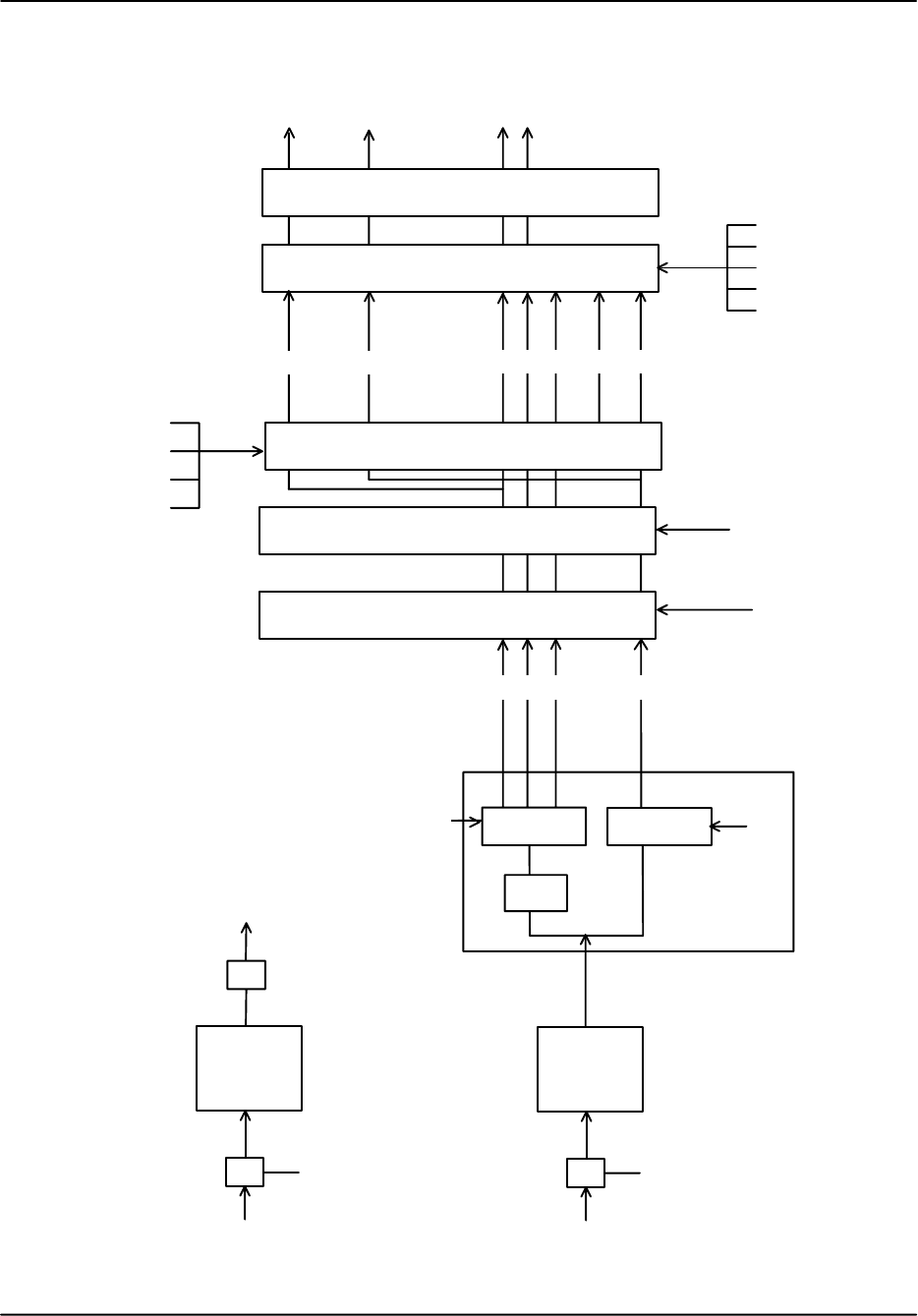
Processing Algorithms (draft)
RVP8 User’s Manual
April 2003
5–3
Speckle Remover
Thresholding
Calibrate Moments
Range Averaging
Micro Clutter Suppression
dBZ dBT V W
V W SQI SIG CCOR
SIGTH
LOGTH
SQITH
CCORTH
FLAGS
dBZ dBT
K–bins
N
l
dBZ0
a
CCORTH
Correlate Correlate
Filter
R0 R1 (R2) T0
si
MM
36 MHz
Figure 5–1: Flow Diagram of RVP8 Processing
This step difĆ
fers for FFT
and Pulse Pair
Modes
Calculate Output Data
IF
FIR
Decimate
in Time
A/D
36 MHz
Burst
FFT
Compute
Frequency
A/D
D/A
AFC

Processing Algorithms (draft)
RVP8 User’s Manual
April 2003
5–4
5.1 IF Signal Processing
The starting point for all computations within the RVP8 are the instantaneous IF-receiver
samples pn and, the instantaneous burst-pulse or COHO reference samples bn. These data are
available at a very high sampling rate (typically 36MHz), which makes possible the digital
implementation of functions that are traditionally performed by discrete components in an
analog receiver. The RVP8’s all-digital approach replaces a great deal of analog hardware,
avoids problems of aging and maintenance, and makes it easy to tune-up the receiver and alter
its parameters.
This section describes these IF signal processing steps.
5.1.1 FIR (Matched) Filter
The RVP8 implements a digital version of the “matched” filter that is found in the traditional
analog radar receiver. The equivalent Finite-Impulse-Response (FIR) filter is designed using an
interactive graphical procedure described in Section 4.5. The filter length (number of taps),
center frequency, and bandwidth are all adjustable. The design procedure computes two sets of
filter coefficients fin and fqn such that the instantaneous quadrature samples at a given bin are:
I+ȍ
N*1
n+0
fin pn,Q+ȍ
N*1
n+0
fqn pn
where N is the length of the filter. The input samples pn are centered on the range bin to which
the (I,Q) pair is assigned. Note that some of the pn are likely to overlap among adjacent bins,
i.e., the filter length may be chosen to be greater than the bin spacing. Such an overlap
introduces a slight correlation between successive bins, but the longer length allows a better
filter to be designed.
The convolution sums for I and Q are computed on the RVP8/Main board using dedicated FIR
chips that can perform up to 576 million sums of products per second. The pn are represented
as 16-bit signed integers, and the fin and fqn are represented as 10-bit signed integers. A
numerical optimization procedure is used to quantize the ideal filter coefficients into their 10-bit
hardware values. The overall spectral purity of the FIR filter will typically be greater than
66dBc.
The reference phase for each transmitted pulse is computed using the same two FIR sums,
except with bn substituted for the pn. For a magnetron system the Nb
n samples are centered
on the transmitted burst; for a klystron system they are obtained from the CW COHO. If the
klystron is phase modulated, then the samples should be from the modulated COHO.
The fin coefficients are computed as:
fin+ln sinƪp
4)2pfIF
fSAMP ǒn*N*1
2Ǔƫ,n+0AAA N*1

Processing Algorithms (draft)
RVP8 User’s Manual
April 2003
5–5
where fIF is the radar intermediate frequency, fSAMP is the RVP8/IFD crystal sampling
frequency, and ln are the coefficients of an N-point symmetric low-pass FIR filter that is
matched to the bandwidth of the transmitted pulse. The multiplication of the ln terms by the
sin() terms effectively converts to the low-pass filter to a band-pass filter centered at the radar IF.
The formula for the fqn coefficients is identical except that sin() is replaced with cos().
The phase of the sinusoid terms, and the symmetry of the ln terms, has been carefully chosen to
have a valuable overall symmetry property when n is replaced with (N–1)–n, i.e., the sequence is
reversed:
fi(N*1)*n+l(N*1)*n sinƪp
4)2pfIF
fSAMP ǒ((N*1) *n)*N*1
2Ǔƫ
fi(N*1)*n+ln cosƪp
4)2pfIF
fSAMP ǒn*N*1
2Ǔƫ
fi(N*1)*n+fqn
Thus, the coefficients needed to compute I are merely the reversal of the coefficients needed to
compute Q; if you know fin, then you also know fqn. This is why it is sufficient to print only
one set of FIR coefficients during the filter design process described in Section 4.5.
5.1.2 Automatic Frequency Control (AFC)
AFC is used on magnetron systems to tune the STALO to compensate for magnetron frequency
drift. The STALO is typically tuned 30 MHz away from the magnetron frequency. The
maximum tuning range of the AFC feedback is approximately 7MHz on each side of the center
frequency. This assumes that the system’s IF frequency is at least 4MHz away from any
multiple of half the digital sampling frequency, i.e., 18, 36, 54, or 72MHz.
The RVP8 analyzes the burst pulse samples from each pulse, and produces a running estimate of
the power-weighted center frequency of the transmitted waveform. This frequency estimate is
the basis of the RVP8’s AFC feedback loop, whose purpose is to maintain a fixed intermediate
frequency from the radar receiver.
The instantaneous frequency estimate is computed using four autocorrelation lags from each set
of Nb
n samples. This estimate is valid over the entire Nyquist interval (e.g., 18MHz to
36MHz), but becomes noisy within 10% of each end. Since the span of the burst pulse samples
is only approximately a microsecond, several hundred estimates must be averaged together to get
an estimate that is accurate to several kiloHertz. Thus, the AFC feedback loop will typically
have a time constant of several seconds or more.
Most of the burst pulse analysis routines, including the AFC feedback loop, are inhibited from
running immediately after making a pulsewidth change. The center-of-mass calculations are
held off according to the value of Settling time (to 1%) of burst frequency estimator, and the
AFC loop is held off by the Wait time before applying AFC. This prevents introducing transients
into the burst analysis algorithms each time the pulsewidth changes.
Additional information about using AFC can be found in Sections 2.2.10, 2.4, and 3.3.6.

Processing Algorithms (draft)
RVP8 User’s Manual
April 2003
5–6
5.1.3 Burst Pulse Tracking
The RVP8 has the ability to track the power-weighted center-of-mass of the burst pulse, and to
automatically shift the trigger timing so that the pulse remains in the center of the burst analysis
window of the Pb plot. This means that external sources of drift in the timing of the transmitted
pulse (temperature, aging, etc.) will be tracked and nulled out during normal operation; so that
fixed targets will remain fixed in range, and clean Tx phase measurements will always be
available on every pulse.
The Burst Pulse Tracker feedback loop makes changes to the trigger timing in response to the
measured position of the burst. Timing changes will generally be made only when the RVP8 is
not actively acquiring data, in the same way that AFC feedback is held off for similar “quiet”
times. However, if the center-of-mass has drifted more than 1/3 the width of the burst analysis
window, then the timing adjustment will be made right away. Also, there will be an
approximately 5ms interruption in the normal trigger sequence whenever any timing changes are
made.
The Burst Pulse Tracker and AFC feedback loop are each fine-tuning servos that keep the burst
pulse “centered” in time and frequency. These servos have been expanded to include a
combined “Hunt Mode” that will track down a missing burst pulse when we are uncertain of
both its time and frequency. This coarse-tuning mode is especially valuable for initializing the
two fine-tuning servos in radar systems that drift significantly with time and temperature.
When the radar transmitter is On but the burst pulse is missing, it may be because either of the
following have happened:
SIt is misplaced in time, i.e., the Tx pulse is outside of the window displayed in the
Pb plotting command. In this case, the trigger timing needs to be changed in
order to bring the center of the pulse back to the center of the window.
SIt is mistuned in frequency, i.e., the AFC feedback is incorrect and has caused the
burst frequency to fall outside of the passband of the RVP8 anti-alias filters. In
this case the AFC (or DAFC) needs to be changed so that proper tuning is
restored.
The Hunt Mode performs a 2-dimensional search in time and frequency to locate the burst;
searching across a +20msec time window, and across the entire AFC span. If a valid Tx pulse
(i.e., meeting the minimum power requirement) can be found anywhere within those intervals
then the Burst Pulse Tracker and AFC loops will be initialized with the time and frequency
values that were discovered. The fine servos then commence running with a good burst signal
starting from those initial points.
Depending on how the hunting process has been configured in the Mb menu, the whole
procedure may take several seconds to complete. The RVP8’s host computer interface remains
completely functional during this time, but any acquired data would certainly be questionable.
GPARM status bits in word #55 indicate when the hunt procedure is running, and whether it has
completed successfully. The BPHUNT (Section 6.25) opcode allows the host computer to
initiate Hunt Mode when it knows or can sense that a burst pulse should be present

Processing Algorithms (draft)
RVP8 User’s Manual
April 2003
5–7
5.1.4 Interference Filter
The interference filter is an optional processing step that can be applied to the raw (I,Q) samples
that emerge from the FIR filter chips. The intention of the filter is to remove strong but sporadic
interfering signals that are occasionally received from nearby man-made sources. The technique
relies on the statistics of such interference being noticeably different from that of weather.
For each range bin at which (I,Q) data are available, the interference filter algorithm uses the
received power (in deciBels) from the three most recent pulses:
Pn*2,Pn*1, and Pn
where:
Pn+10 log10ǒI2
n)Q2
nǓ .
If the three pulse powers have the property that:
ŤPn*1*Pn*2ŤtC1 and ŤPn*Pn*1ŤuC2 (Alg.1)
then (In,Qn) is replaced by (In*1,Qn*1). Here C1 and C2 are constants that can be tuned by
the user to match the type of interference that is anticipated, and the error rates that can be
tolerated. For certain environments it may be the case that good results can be obtained with
C1+C2; but the RVP8 does not force that restriction.
This 3-pulse algorithm is only intended to remove interference that arrives on isolated pulses,
and for which there are at least two clear pulses in between. Interference that tends to arrive in
bursts will not be rejected.
Two variations on the fundamental algorithm are also defined. The CFGINTF command
(Section 6.22) allows you to choose which of these algorithms to use, and to tune the two
threshold constants. You may also do this directly from the Mp setup menu (Section 3.3.2).
ŤPn*1*Pn*2ŤtC1 and Pn*Pn*1uC2 (Alg.2)
ŤPn*1*Pn*2ŤtC1 and Pn*LinAvg(Pn*1,Pn*2)uC2 (Alg.3)
Where LinAvg() denotes the deciBel value of the linear average of the two deciBel powers. The
Alg.2 and Alg.3 algorithms also include the receiver noise level(s) as part of their decision
criteria. Whenever power levels are intercompared in the algorithms, any power that is less than
the noise level is first set equal to that noise level. This makes the filters much more robust and
properly tunable, so that interference is more successfully rejected on top of blank receiver
noise.
Optimum values for C1 and C2 will vary from site to site, but some guidance can be obtained
using numerical simulations. The results shown below were obtained when the algorithms were
applied to realistic weather time series having a spectrum width = 0.1 (Nyquist), SNR = +10dB,
and an intermittent additive interference signal that was 16dB stronger than the weather. The
interference arrived in isolated single pulses with a probability of 2%.
Performance of the three algorithms is summarized in the first three columns of Table 5–2, for
which C1 and C2 have the common value shown. The fourth column also uses Algorithm #3,
but with the value of C1 raised by 2dB. The “Missed” rate is defined as the percentage of

Processing Algorithms (draft)
RVP8 User’s Manual
April 2003
5–8
interference points that manage to get through the filtering process without being removed. The
“False” (false alarm) rate is the percentage of non-interference points that are incorrectly
modified when they should have been left alone.
Table 5–2: Algorithm Results for +16dB Interference
Alg.1 Alg.2 Alg.3 Alg.3, C1+=2dB
C1,C2 Missed/False Missed/False Missed/False Missed/False
––––– –––––––––––– –––––––––––– –––––––––––– ––––––––––––
6.0dB 17.8% 10.91% 17.8% 4.06% 17.8% 3.48% 10.3% 4.15%
8.0dB 10.5% 6.57% 10.5% 2.42% 10.4% 1.71% 6.1% 1.92%
9.0dB 8.5% 5.09% 8.5% 1.81% 8.3% 1.16% 5.4% 1.28%
10.0dB 7.3% 4.01% 7.3% 1.42% 7.5% 0.79% 5.4% 0.85%
11.0dB 8.9% 3.14% 8.9% 1.06% 8.3% 0.51% 6.5% 0.54%
12.0dB 11.6% 2.53% 11.6% 0.85% 11.3% 0.33% 9.9% 0.35%
13.0dB 17.0% 2.07% 17.0% 0.67% 16.3% 0.22% 15.3% 0.23%
14.0dB 23.5% 1.70% 23.5% 0.54% 22.4% 0.14% 21.6% 0.15%
16.0dB 39.2% 1.21% 39.2% 0.35% 39.6% 0.06% 38.9% 0.06%
20.0dB 67.3% 0.65% 67.3% 0.14% 72.5% 0.01% 72.4% 0.01%
It is important to minimize both types of errors. If too much interference is missed, then the
filter is not doing an adequate job of cleaning up the received signal. If the false alarm rate is
too high, then background damage is done at all times and the overall signal quality (especially
sub-clutter visibility) may be compromised. We suggest that you try to keep the false alarm rate
fairly low, perhaps below 1%; and then let the missed percentage fall where it may.
To summarize the numerical results in Table 5–2:
SThe “Missed” rates of Alg.1 and Alg.2 are identical, but the “False” rate of Alg.1
is much higher. Alg.1 clearly does not perform as well for additive interference,
but it is included in the suite for historical reasons.
SThe “Missed” error rate for Alg.3 is nearly identical to that of Alg.2, but Alg.3
has a significantly lower false alarm rate. This is because of the somewhat
improved statistics that result when the linear mean of Pn*2 and Pn*1 is used in
the second comparison, rather than just Pn*1 by itself. We recommend that
Alg.3 generally be chosen in preference to the other two.
SAlg.3 can be further tuned by allowing the two constants to differ. For example,
by raising C1 slightly above C2 (fourth column), we can trade off a decrease in
the “Missed” rate for an increase in the “False” rate. Lowering C1 would have
the opposite effect.
Keep in mind that optimum tuning will depend on the type of interference you are trying to
remove. In the previous example, where the interfering signal is only 16dB stronger than the
weather, there was a close tradeoff between the “Missed” and “False” error rates. However,
Table 5–3 shows the results that would be obtained if the interference dominates by 26db.

Processing Algorithms (draft)
RVP8 User’s Manual
April 2003
5–9
Table 5–3: Algorithm Results for +26dB Interference
Alg.1 Alg.2 Alg.3 Alg.3, C2+=5dB
C1,C2 Missed/False Missed/False Missed/False Missed/False
––––– –––––––––––– –––––––––––– –––––––––––– ––––––––––––
6.0dB 17.8% 10.75% 17.8% 3.95% 17.8% 3.44% 17.8% 0.34%
8.0dB 9.9% 6.48% 9.9% 2.31% 9.9% 1.68% 9.9% 0.15%
9.0dB 7.4% 4.99% 7.4% 1.75% 7.4% 1.14% 7.4% 0.10%
10.0dB 5.9% 3.91% 5.9% 1.36% 5.9% 0.76% 5.9% 0.06%
11.0dB 4.8% 3.06% 4.8% 1.06% 4.8% 0.50% 4.8% 0.04%
12.0dB 3.2% 2.37% 3.2% 0.83% 3.2% 0.33% 3.2% 0.03%
13.0dB 2.6% 1.83% 2.6% 0.62% 2.6% 0.20% 2.8% 0.01%
14.0dB 1.9% 1.45% 1.9% 0.50% 1.9% 0.12% 2.6% 0.01%
16.0dB 1.3% 0.90% 1.3% 0.30% 1.3% 0.05% 5.8% 0.00%
20.0dB 3.1% 0.39% 3.1% 0.12% 2.0% 0.01% 31.5% 0.00%
Notice that we can now re-tune the constants and operate with C1+13dB and C2+18dB
(fourth column); which yields a low 2.8% “Missed” rate, and an extremely low 0.01% false
alarm rate. Since the false alarm rate is (approximately) independent of the interference power,
these filter settings would leave all “clean” weather virtually untouched, i.e., we would have a
very safe filter that is intended only to remove fairly strong interference. Such a filter could be
left running at all times without too much worry about side effects.
5.1.5 Large-Signal Linearization
The RVP8 is able to recover the signal power of targets that saturate the IF-Input A/D converter
by as much as 4–6 deciBels. This is possible because an overdriven IF waveform still spends
some of its time in the valid range of the converter, and thus, it is still possible to deduce
information about the signal.
Figure 5–2 shows actual signal generator test measurements with normal A/D saturation (lower
line), and with the extrapolation algorithms turned on (upper line). The high-end linear range
begins to roll off at approximately +10dBm versus +5dBm, and thus has been extended by 5dB.
5.1.6 Correction for Tx Power Fluctuations
The RVP8 can perform pulse-to-pulse amplitude correction of the digital (I,Q) data stream based
on the amplitude of the Burst/COHO input. The technique computes a (real valued) correction
factor at each pulse by dividing the mean amplitude of the burst by the instantaneous amplitude
of the burst. The (I,Q) data for that pulse are then multiplied by this scale factor to obtain
corrected time series. The amplitude correction is applied after the Linearized Saturation
Headroom correction.
The mean burst amplitude is computed by an exponential average whose (1/e) time constant is
selected as a number of pulses (See Section 3.3.2). A short time constant will settle faster, but
will not be as thorough in removing amplitude variations (since the mean itself will be varying).
Longer time constants do a better job, but will require a second or two before valid data is
available when the transmitter is first turned on. The default value of 70 will give excellent
results in almost all cases.
Whenever the RVP8 enters a new internal processing mode (time series, FFT, PPP, etc.), the
burst power estimator is reinitialized from the level of the first pulse encountered, and an
additional pipeline delay is introduced to allow the estimator to completely settle. Thus, valid
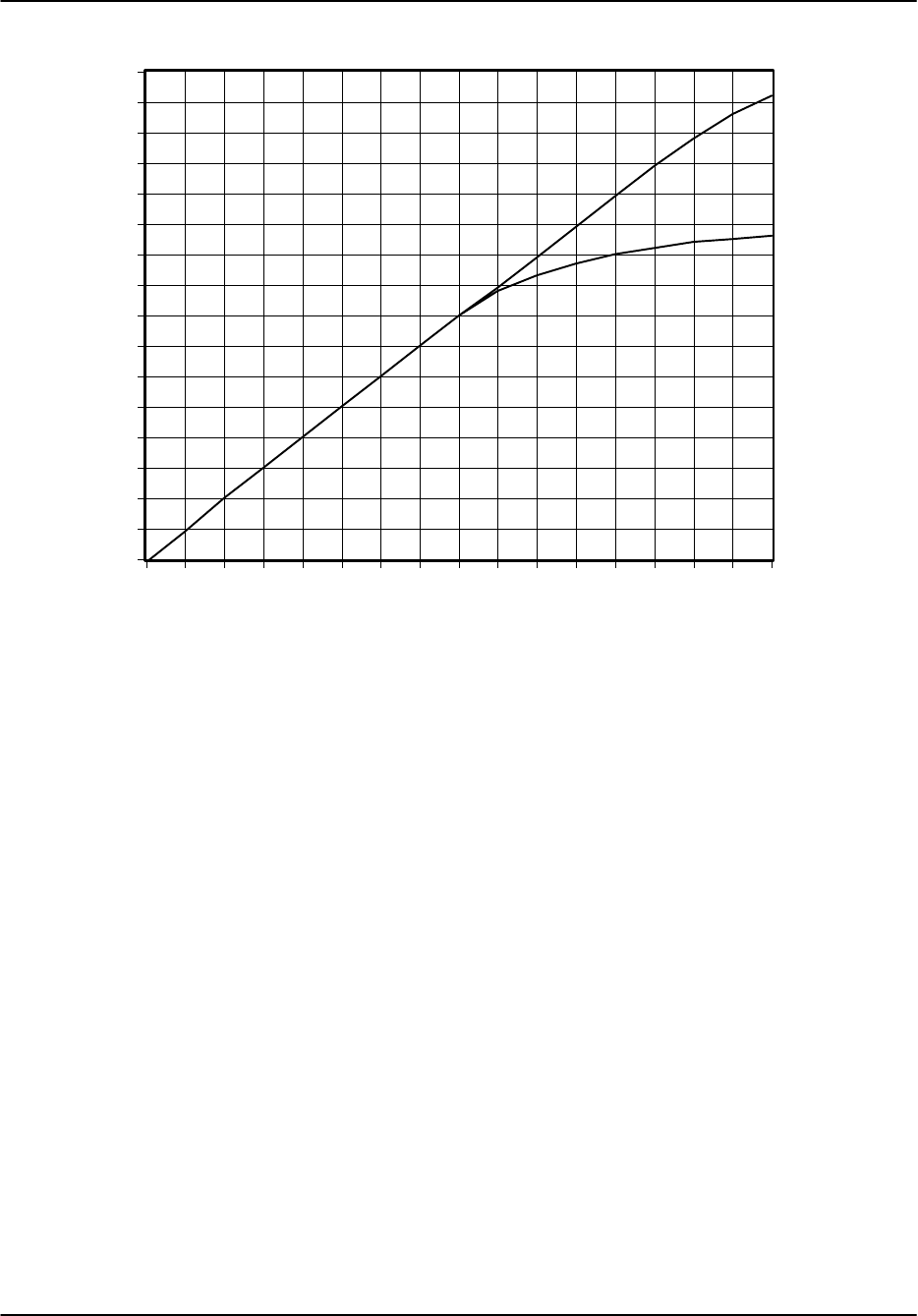
Processing Algorithms (draft)
RVP8 User’s Manual
April 2003
5–10
–4
–3
–2
–1
0
1
2
3
4
5
6
7
8
9
10
11
12
–4–3–2–10123456789101112
Figure 5–2: Linearization of Saturated Signals Above +4dBm
corrected data are produced even when the RVP8 is alternating rapidly between different data
acquisition tasks, e.g., in a multi-function ASCOPE display. The additional pipeline delay will
not affect the high-speed performance when the RVP8 runs continuously in any single mode.
For amplitude correction to be applied, the instantaneous Burst/COHO signal level must exceed
the minimum valid burst power specified in the “Mb” setup section. If that level is not met, e.g.,
if the transmitter is turned off, then no correction is performed. Thus, the amplitude correction
feature conveniently “gets out of the way” when receiver-only tests are being performed.
The maximum correction that will ever be applied is 5dB. If the burst power in a given pulse
is more than 5dB above the mean, or less than 5dB below it, then the correction is clamped at
those limits. The power variation of a typical transmitter will easily be contained within this
interval (it is typically less than 0.3dB).
Instantaneous amplitude correction is a unique feature of the RVP8 digital receiver. Bench tests
with a signal generator reveal that an amplitude modulated waveform having 2.0dB of
pulse-to-pulse variation is reduced to less than 0.02dB RMS of (I,Q) variation after applying the
amplitude correction.

Processing Algorithms (draft)
RVP8 User’s Manual
April 2003
5–11
5.2 Video (“I” and “Q”) Signal Processing
This section describes the processing of the video (“I” and “Q”) data to obtain the reduced
parameters: reflectivity, total power, velocity, width, signal quality index, clutter power
correction, and sometimes ZDR. The RVP8 employs two methods (selectable) for processing
the I and Q signals: pulse-pair and FFT. The methods are similar except in regard to the
procedures for clutter filtering. The pulse pair methods are described below; the FFT clutter
filtering algorithms are described in Section 5.8.
5.2.1 Time Series
Recall that the time series synthesized by the FIR filter consist of an array of complex numbers:
sn+[In)jQn]for n+1, 2, 3, AAA,M
where “j” is *11ń2. These data samples are analogous to the “I” and “Q” samples in a
traditional analog receiver. They are sampled at a selectable resolution in the range 50–133
meters. The time series are the starting point for all calculations performed within the RVP8.
5.2.2 IIR Clutter Filter for PPP-Mode
The RVP8’s pulse-pair-processing mode employs a 4th order Infinite Impulse Response (IIR)
digital high pass filter to remove low frequency signals due to ground clutter from the time
series. Since the width of the clutter can change with the antenna rotation rate, eight different
filters (seven high-pass, plus one all-pass) are provided. The filter stop-bandwidths vary from
approximately 2% to 14% of the Nyquist interval, and stop band attenuation is at least 40 dB. A
setup question allows selection of either 40 dB or 50 dB filters. The 50 dB filters are intended
for Klystron systems. Any of the eight filters can be selected independently at each individual
range bin. This permits range-dependent clutter removal. The filter algorithm is outlined below.
The input time series sn is processed to form a filtered output time series sȀn as follows:
sȀn+B0sn)B1sn*1)B2sn*2)B3sn*3)B4sn*4
*C1sȀn*1*C2sȀn*2*C3sȀn*3*C4sȀn*4
where the B’s and C’s are the filter coefficients. Appendix C gives the magnitude response
plots for the set of filters supplied with the RVP8.

Processing Algorithms (draft)
RVP8 User’s Manual
April 2003
5–12
5.2.3 Autocorrelations for PPP-Mode
The autocorrelations are computed during pulse-pair-processing mode according to the
following algorithms (corresponding physical models are also given):
Parameter and Definition Physical Model
To+1
Mȍ
M
n+1
sn*sngrgt(S)C))N
Ro+1
Mȍ
M
n+1
sȀ*
nsȀngrgtS)N
R1+1
M*1ȍ
M*1
n+1
sȀ*
nsȀn)1grgtSejpVȀ*p2W2ń2
R2+1
M*2ȍ
M*2
n+1
sȀ*
nsȀn)2grgtSej2pVȀ*2p2W2
where M is the number of pulses in the time average. Here, sȀ denotes the filtered time series, s
denotes the original unfiltered time series and the * denotes a complex conjugate. gr and gt
represent the transmitter and receiver gains, i.e., their product represents the total system gain.
Since the RVP8 is a linear receiver, there is a single gain number that relates the measured
autocorrelation magnitude to the absolute received power. However, since many of the
algorithms do not require absolute calibration of the power, the gain terms will be ignored in the
discussion of these. To for the unfiltered time series is proportional to the sum of the
meteorological signal S, the clutter power C and the noise power N. R0 is equal to the sum of
the meteorological signal S and noise power N which is measured directly on the RVP8 by
periodic noise sampling. To and R0 are used for calculating the dBZ values- the equivalent radar
reflectivity factor which is a calibrated measurement. The physical models for R0,R1 and R2
correspond to a Gaussian weather signal and white noise. W is the spectrum width and V’ the
mean velocity, both for the normalized Nyquist interval [–1 to 1].
The exact value of M that is used for each time average will generally be the “Sample Size” that
is selected by the SOPRM command (See Section 6.3). However, when the RVP8 is in PPP
mode and antenna angle synchronization is enabled, the actual number of pulses used may be
limited by the number that fit within each ray’s angular limits at the current antenna scan rate.
The value of M will never be greater than the SOPRM Sample Size, but it may sometimes be
less. For example, at 1KHz PRF, 20_/sec scan rate, 1_ ray synchronization, and a Sample Size
of 80, there will be 50 pulses used for each ray (not 80). Note, however, that the number of
pulses used in the “batched” (non-PPP) modes will always be exactly equal to the Sample Size,
since those modes are allowed to use overlapping pulses.

Processing Algorithms (draft)
RVP8 User’s Manual
April 2003
5–13
5.2.4 Range averaging and Clutter Microsuppression
The next step (optional) is to perform range averaging. Range averaging can be performed over
2, 3, ..., 16 bins. This is accomplished by simply averaging the T0,R0,R1 and R2 values. This
reduces the number of bins in the final output to save processing both in the RVP8 and in the
host computer.
At the user’s option, the range averaged data can be restricted to include only those bins which
have an estimated clutter-to-signal ratio that falls within the CCOR threshold interval. By
excluding isolated point clutter targets from the range average the sub-clutter visibility of the
averaged data is increased. Specifically, the Doppler test that is applied to each bin in order that
it contribute to the overall sum is:
10 log R0*10 log T0uCCORthresh .
5.2.5 Reflectivity
The corrected reflectivity Z is output using a log scale based on the following equation:
dBZ +10 logƪT0*N
Nƫ)dBZo)20 log r)ar )CCOR
This equation is simply a dB version of the familiar radar equation for distributed targets. The
relationship between the measured autocorrelation function, the received signal and the noise can
be expressed as:
To+gtgrS)N
where gt and gr represent the transmitter and receiver gains, S is the average backscattered
power from the targets and N is the measured average noise power. Neglecting attenuation and
the contribution of ground clutter (for the moment), the radar equation can be written as.
Z+CSr2+ƪCr2
0N
grgtƫƪr2
r2
oƫƪTo*N
Nƫ
where C is the radar constant and ro is a reference range which we will later set to 1 km. This is
identical to the first three terms of the dB version of the equation with the definition that:
Zo+Cr2
oN
grgt+Cr2
oIowhere Io+N
grgt
Zo is called the calibration reflectivity factor. It is the equivalent radar reflectivity factor at the
reference range when the return signal power is equal to the noise power (SNR=0 dB). It is
sometimes called the minimum detectable dBZ at 1 km. The parameter Io is the measured noise
power at IF with appropriate calibration for the system gain. Calibration of the RVP8 involves
defining the radar constant C and measuring the value of Io. This is discussed in detail in Section
5.4.
Essentially, the measurement of Io is based on the measurement of the system noise at the time
of calibration. However, if the receiver gain were to change after calibration, the use of periodic
noise sampling properly corrects for this. For example, if the receiver gain were to change by a
factor k, then we would measure a noise value of kN and an autocorrelation value of kTo, i.e.,

Processing Algorithms (draft)
RVP8 User’s Manual
April 2003
5–14
Z+CSr2+ƪCr2
0N
grgtƫƪr2
r2
oƫƪ
kT
o*kN
kN ƫ
Thus the k’s cancel to give us the same result for Z. This makes the approach robust to system
gain fluctuations. Another way of saying this is that as long as the system sensitivity (noise
figure) does not change, then the system does not require re-calibration.
The individual terms in the dB form of the equation are summarized below.
1st Term : 10 logƪT0*N
Nƫ: Signal to Noise Ratio
The effect of this term is to subtract the measured noise. It is also used for LOG thresholding.
If this number is above the user input value LOGthresh the dBZ is passed.
2rd Term: dBZo : Calibration Reflectivity (see discussion above)
dBZo is the minimum detectable dBZ at a reference range ro=1 km,
3th Term: 20 log r : Range Normalization
This term is the ƪr
roƫ2 range normalization expressed in dB form.
4th Term: ar : Gaseous Attenuation Correction
This term accounts for gaseous attenuation. The constant a is set in the RVP8 EEROM since
it is a function of wavelength. For a C-band system the default value is 0.016 dB per km (for
two-way path attenuation).
5th Term: CCOR: Clutter Correction
This term corrects for the measured ground clutter. It’s derivation is discussed in section
5.2.9.

Processing Algorithms (draft)
RVP8 User’s Manual
April 2003
5–15
5.2.6 Velocity
For a Doppler power spectrum that is symmetric about its mean velocity, the velocity is obtained
directly from the argument of the autocorrelation at the first lag, i.e.,
V+l
4ptsq1 where q1+arg NJR1Nj.
l is the radar wavelength, ts is the sampling time (1/PRF). q1 is constrained to be on the
interval [*p,p]. When q1+" p , then V+" Vu where the unambiguous velocity is ,
Vu+l
4ts .
If the absolute value of the true velocity of the scatterers is greater than Vu , then the velocity
calculated by the RVP8 is folded into the interval ƪ*Vu,Vuƫ , which is called the Nyquist
interval. Folding is usually easily recognized on a color display by a discontinuous jump in
velocities. For example, if the true velocity is Vu)DV, then the velocity calculated by the
RVP8 is *Vu)DV, which is 2Vu away from the true mean velocity.
For 8-bit outputs, rather than calculating the absolute velocity in scientific units, the RVP8
calculates the mean velocity for the normalized Nyquist interval [–1,1], i.e., the output values
are,
VȀ+q1
p.
For example, an output value of –0.5 corresponds to a mean velocity of *Vuń2. The
normalized velocity VȀ is more efficient use of the limited number of bits.
5.2.7 Spectrum Width Algorithms
The spectrum width is a measure of the combined effects of shear and turbulence. To a lesser
extent, the antenna rotation rate can also effect the spectrum width. At high elevation angles, the
fall speed dispersion of the scatterers also effects spectrum width.
There are two choices for the spectrum width algorithm used in the RVP8, depending on the
speed and accuracy that are required for the application:
R0,R1 “fast” algorithm valid when SNR >> 10 dB
R0,R1,R2 “accurate” algorithm for SNR >> 0 to 5 dB
The approach used is selected in the SOPRM command. The two approaches are described below:
R0,R1Width Algorithm
Given samples of the Doppler autocorrelation function, numerous estimates of spectral vari-
ance can be computed (Passarelli & Siggia, 1983). The particular estimator used by the
RVP8 employs the magnitudes of R0 and R1 and assumes that the Doppler spectrum is
Gaussian (usually an acceptable assumption) and that the signal-to-noise ratio is large. Spe-
cifically we have (similar to Srivastava, et al 1979):
Variance +2ln
ƪRo
|R1|ƫ+*2ln
[SQI]

Processing Algorithms (draft)
RVP8 User’s Manual
April 2003
5–16
where “ln” represents the natural logarithm. This can be compared to the expression in the
preceding section for SQI to illustrate that this expression for the variance is only valid when:
SNR
SNR )1[1
which occurs when the SNR is large.
This variance estimator is normalized to the Nyquist interval in units of [*p,p]. Thus, for
example, a variance of p2ń25 would be obtained from a Gaussian spectrum having a stan-
dard deviation equal to one fifth of the total width of the plotted spectral distribution. For
scientific purposes, the spectrum width (standard deviation) is more physically meaningful
than the variance, since it scales linearly with the severity of wind shear and turbulence. For
these reasons, the width W is output by the RVP8:
W+Variance
Ǹ
p
Again, for efficient packing in 8-bits, width is normalized to the Nyquist interval [–1, 1 ].
For the example given above, the output width W would be (1/5). To obtain the width in me-
ters per second, one multiplies the output width by Vu .
R0,R1,R2 Width Algorithm
The width algorithm in this case is similar except that the addition of R2 extends the validity
of the width estimates to weak signals. In this case the variance is:
Variance +2
3lnƪ|R1|
|R2|ƫ
The output width W is then defined as in the previous section.
5.2.8 Signal Quality Index (SQI threshold)
An important feature of the RVP8 is its ability to eliminate signals which are either too weak to
be useful, or which have widths too large to justify further analysis. This is done via the signal
quality index (SQI) which is defined as:
SQI +|R1|
R0
The SQI is the normalized magnitude of the autocorrelation at lag 1 and varies between 0 for an
uncorrelated signal (white noise) to 1 for a noise-free zero-width signal (pure tone). Mean
velocity estimates are degraded when the spectrum, width is large or when the signal-to-noise
ratio is weak. The SQI is a good measure of the uncertainty in the velocity estimates and is a
convenient screening parameter to compute. In terms of the Gaussian model, the SQI is :
SQI +SNR
SNR )1e*p2W2
2
where the SNR is the signal-to-noise ratio. For very large SNR’s the SQI is a function of the
spectrum width only. For a zero-width pure tone (W=0), the SQI is a function of the SNR only
(e.g., for W=0, an SNR of 1 corresponds to SQI=0.5). The SQI threshold is typically set to a
value of 0.4 to 0.5.

Processing Algorithms (draft)
RVP8 User’s Manual
April 2003
5–17
5.2.9 Clutter Correction (CCOR threshold)
In addition to calculating the R0,R1 and optional R2 autocorrelation terms, which are based on
filtered time series data, the RVP8 also computes T0 which is the total unfiltered power. By
comparing the total filtered and unfiltered powers at each range bin, a clutter power, and hence a
clutter correction, for that bin can be derived. The clutter correction is defined as,
CCOR +10 log S
C)S+10 log 1
CSR )1
where S is the weather signal power, C is the clutter power and CSR is the clutter-to-signal
ratio. The algorithm for calculating CCOR depends on whether the optional R2 autocorrelation
lag is computed as described below.
R0,R1 Clutter Correction
In this case CCOR is estimated from,
CCORest +10 logƪR0
T0ƫ
+10 logƪS)N
C)S)Nƫ+10 logƪ1)1
SNR
CSR )1)1
SNRƫ
Here, the expression is strictly valid only when the signal-to-noise ratio
(SNR=S/N) is large. Thus when the 2-lag approach is used, the clutter corrections are not
as accurate for weak weather signals. However, the error is typically less than 3 dB.
R0,R1,R2 Clutter Correction
In this case there is enough information to compute the clutter signal and noise power inde-
pendently. The algorithm for CCOR is:
CCORest +10 log S
C)S+10 log 1
CSR )1
The clutter power is computed from:
C+To*Ro+[C)S)N]*[S)N]
The signal power S is then computed from:
S+|R1| exp p2W2
2
W is the width that has been previously calculated. This approach yields more accurate re-
sults for the clutter correction in the case of a low SNR.

Processing Algorithms (draft)
RVP8 User’s Manual
April 2003
5–18
5.2.10 Weather Signal Power (SIG threshold)
A parameter called SIG is also calculated to provide an estimate of the weather signal-to-noise
ratio in dB for thresholding. The SIG calculation is different depending on the whether the
optional R2 autocorrelation is computed.
R0,R1 Calculation
In this case the SIG is computed as follows:
SIG +10 log ƪT0*N
Nƫ)CCOR
This term represents the SNR after the removal of clutter. The CCOR value is the one de-
scribed for R0,R1 in the previous section.
R0,R1,R2 Calculation
In this case the SIG is computed based on the SNR which is:
SIG +10 log ƪ2pS
R0*2pSƫ
where the signal power S is determined as described in the preceding section.
5.2.11 Signal to Noise Ratio (LOG threshold)
A parameter called LOG is also calculated to provide an estimate of the total signal-to-noise
ratio in dB useful for reflectivity thresholding. The formula is below:
LOG +10 logƪT0*N
Nƫ

Processing Algorithms (draft)
RVP8 User’s Manual
April 2003
5–19
5.3 Thresholding
An important feature of the RVP8 is its ability to accept or reject incoming data based on derived
properties of the signals themselves. Typically, “rejected” data are not displayed by the user’s
software, thus making for very clean weather presentations.
5.3.1 Threshold Qualifiers
For data quality control, each RVP8 output parameter can be qualified, i.e., either accepted or
rejected for output, based on four threshold criteria:
ID Criterion Name Pass Criterion
LOG Signal-to-Noise Ratio LOG > threshold
SQI Signal Quality Index SQI > threshold
CCOR Clutter Correction CCOR > threshold
SIG Weather Signal Power SIG > threshold
The calculation of the measured levels (e.g., SQI) for each of these qualifications has been
described in previous sections of this chapter. All four qualification criteria can be switched on
and off independently, and the threshold levels (e.g., SQIthresh ) can each be set independently.
Further, each qualifier test can be AND’d and OR’d with any other. This allows very complex
thresholds criteria to be constructed as required. The four threshold qualifiers are summarized
below.
LOG It is essentially a measure of the total power SNR. This is usually used for
thresholding of the reflectivity data. The default LOG threshold value is 0.5 dB.
SQI The SQI threshold is typically used for velocity and width thresholding since it is a
measure of the coherency. It is a number between 0 and 1 (dimensionless) where 0 is
perfect white noise and 1 is a pure tone (perfect Doppler signal). The default SQI
threshold value is 0.5.
CCOR The clutter correction threshold is typically used to reject measurements when the
clutter in a range bin is very strong (i.e., when the calculated CCOR is a large
negative number in dB). The appropriate value depends on the coherency of the radar
system. The default threshold is set to –25 dB. Threshold values less than this (more
negative) reject fewer clutter bins. Threshold values closer to zero reject more clutter
bins.
SIG This is typically used only for thresholding the spectrum width to assure that the
signal power is strong enough for an accurate width measurement. The default
threshold value is 10 dB. If R2 processing is used, this can usually be reduced to 5 dB
for width thresholding.
The following are the default threshold combinations for each of the parameters that can be
selected for output from the RVP8:

Processing Algorithms (draft)
RVP8 User’s Manual
April 2003
5–20
Parameter Description Threshold
dBZ Reflectivity with clutter correction LOG and CCOR
dBT Reflectivity without clutter correction LOG
V Mean velocity SQI and CCOR
W Spectrum width SQI and CCOR and SIG
ZDR Differential reflectivity LOG
5.3.2 Adjusting Threshold Qualifiers
The effect of the various threshold qualifiers for each output parameter are discussed in this
section. In optimizing thresholds for your application, it is recommended that you change only
one parameter (level or criterion) at a time so that you can verify the effect. Some hints for
optimizing the levels for the default criteria are provided below:
LOG To optimize the LOG level, display dBT or dBZ and select the lowest value of the
threshold that eliminates the display noise. If the LOG level is set too high you lose
sensitivity. Note that if you average more pulses or ranges, then the threshold level
can usually be reduced.
SQI To optimize the SQI level, display velocity and select the lowest value of the
threshold that eliminates the display noise. If the SQI level is set too high you lose
sensitivity. In general, you should see a greater area covered by velocity than
reflectivity since the velocity is more sensitive. If you do not, you should reduce your
SQI threshold. Note that if you average more pulses or ranges, then the threshold
level can usually be reduced.
CCOR This is used to eliminate clutter targets that are very strong. It should not be set to
eliminate all clutter targets on a clear day since this means that you are losing
sensitivity. To optimize the CCOR threshold it is best to know your system coherency
in terms of dB of clutter cancelation. Start at a value of 10 dB greater (closer to 0)
than this. Now display a PPI of dBZ at an antenna elevation of ~1 degree. The
display should be relatively clean of any clutter targets since most will be rejected.
Now reduce the CCOR (more negative) to increase the number of clutter targets on
the display until the number of clutter targets does not increase. The optimum value
of the CCOR is approximately 5 dB more (closer to zero) than this point. For
example, if the number of clutter targets is a maximum at –35 dB, then set the CCOR
to ~–30 dB. Note that your clutter filter selection will effect the result.
SIG This should be done last. To optimize the SIG level, display the width W and select
the lowest value of the threshold that eliminates the display noise. If the SIG level is
set too high you lose sensitivity. Note that if you average more pulses or ranges, then
the threshold level can usually be reduced.
When thresholding dBZ and dBT reflectivity data with SQI, the comparison value for accepting
those data is the secondary SQI threshold that is defined via a slope and offset from the primary
user value (see Mf command). This secondary threshold is more permissive (lower valued), and

Processing Algorithms (draft)
RVP8 User’s Manual
April 2003
5–21
is traditionally used to qualify LOG data only in the Random Phase processing mode. But the
secondary SQI threshold is applied uniformly in all processing modes whenever reflectivity data
are specified as being thresholded by SQI.
This gives you more freedom in applying an SQI threshold to your LOG data, because the cutoff
value for reflectivity can be chosen independently from the cutoff value for the other Doppler
parameters. The full SQI test would not normally be applied to LOG data because of the
so-called “black hole” problem, i.e., loss of LOG data within regions of high shear, even though
the reflectivity itself was strong. You may experiment with applying a secondary SQI threshold
to help cleanup the LOG data, but without introducing any significant black holes.
5.3.3 Speckle Filters
A speckle filter is a final pass over each output ray, wherein isolated bins are removed. There are
two speckle removers in the RVP8.
S1D single-ray speckle filter. This can be used for any output parameter.
S2D 3x3 speckle filter. If enabled, this is applied only to T, V, Z and W.
The 1D speckle filter is the default technique. The 2D 3x3 filter is enabled by selection in the
mp TTY setups:
2D Final Speckle/Unfold “User” or “Always”
Both of these speckle filters remove isolated data points that are likely to be noise, interference,
aircraft, birds or other point targets. Meteorological targets typically occupy multiple range bins
so are not effected by the speckle filter. There are two primary benefits derived from using a
speckle filter:
SDisplays look “cleaner” to observers.
SThresholds can be set slightly more sensitive without increasing the number of
noise pixels.
The 2D 3x3 filter actually performs data filling of “missing speckles” as well as eliminating
isolated speckle bins. The two algorithms are discussed below.
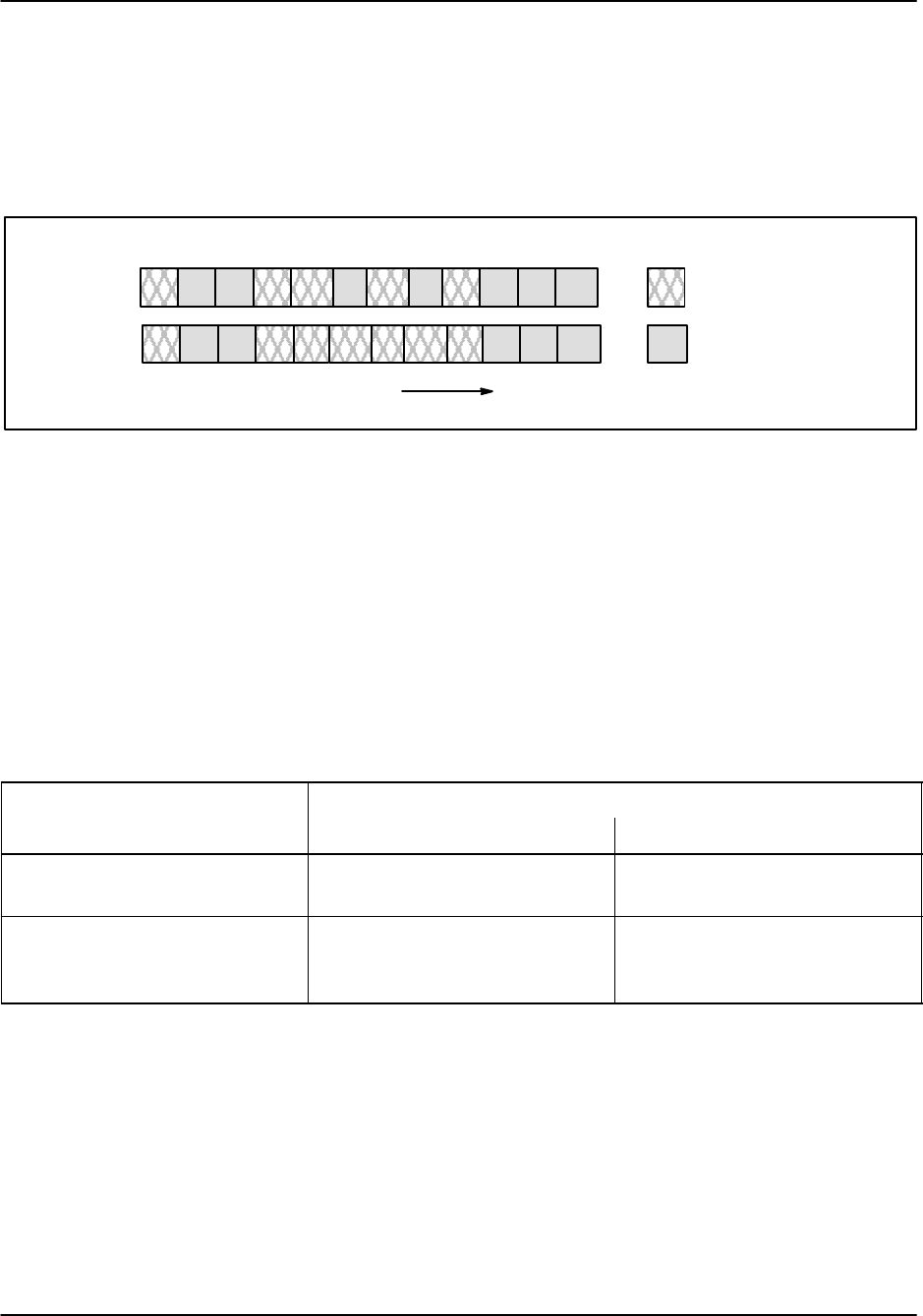
Processing Algorithms (draft)
RVP8 User’s Manual
April 2003
5–22
1D Speckle Filter
A ray is the basic azimuth unit of the RVP8 (e.g., 1 degree) over which the samples are averaged
to obtain the output base data (T, Z, V, W). For this filter, a speckle is defined as any single,
valid bin (not thresholded), having thresholded bins on either side of it in range. Any such
isolated bin in a ray is set to “threshold”. The algorithm is shown schematically below.
Input Ray Indicates Thresholded Bin
1D Speckle Filtering
Output Ray
Range
XX
X Indicates Speckle
Indicates Valid Bin
Note that there are two independent 1D speckle removers– one for the reflectivity data (dBT,
dBZ and ZDR) and one for the Doppler data (V and W). Each one should be switched on or off,
depending on the specific nature of the targets being observed. For example, when making a
clutter map of the area, one would certainly want to switch both speckle filters off.
2D 3x3 Speckle Filter
The 2D filter examines three adjacent range bins from three successive rays in order to assign a
value to the center point. Thus, for each output point, its eight neighboring bins in range and
time are available to the filter. Only the dBZ, dBT, Vel , and Width data are candidates for this
filtering step; all other parameters are processed using the default 1D speckle filter.
The rules for the filter are as follows:
Center Point Action
Assign Threshold Else
Valid Center Point If there are no or only one
other valid point in the 3x3. Do Nothing. Pass the center
point value as-is.
Thresholded Center Point If there are 5 or fewer valid
neighbors in the 3x3. If there are 6 or more valid
neighbors in the 3x3, average
to fill the center point.
Thus the 2D 3x3 filter performs 2 functions:
SFilling by interpolation.
SThresholding of isolated noise bins.
Some examples are shown graphically in the figure below.
For dBZ, dBT, and Width, the interpolated value for filling is computed as the arithmetic
average of all available neighbors. For Vel , it is not possible to define a meaningful average in a
simple way; so the nearest valid neighbor is simply filled in.
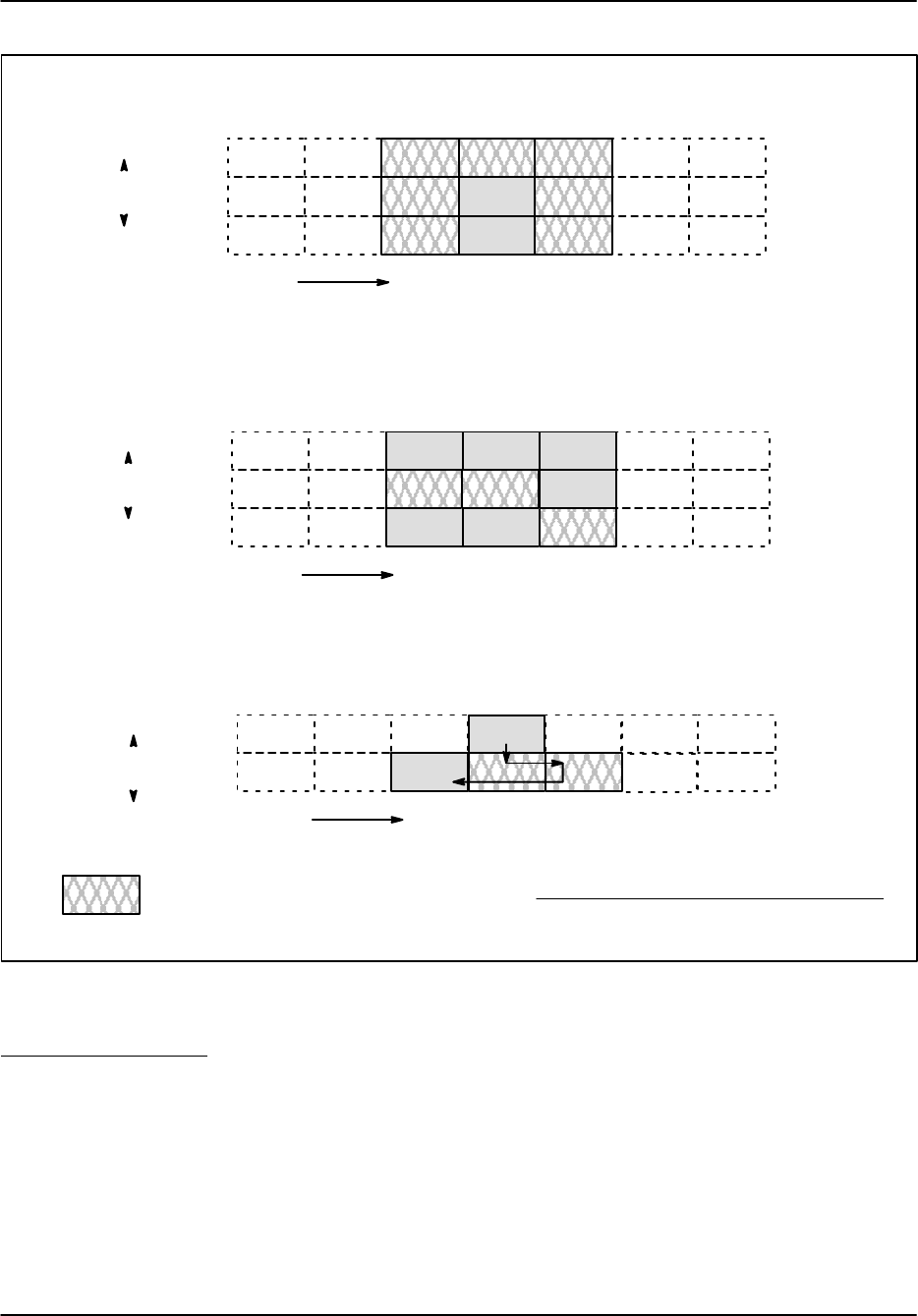
Processing Algorithms (draft)
RVP8 User’s Manual
April 2003
5–23
Range
Azimuth
0
-1
1
0
1-1
Zoutput
00 +Threshold
Threshold if center point is valid but there are no or only one valid neighbor.
Z00
Z0*1
Range
Azimuth
0
-1
1
0
1-1
Fill thresholded center point with average if there 6 or more valid neighbors.
Z0*1
Z*11 Z01
Zoutput
00 +[Z*11 )Z01 )Z11 )Z10 )Z*1*1)Z0*1]
6
Range
Azimuth
0
0
-1
1-1
2D Velocity Unfolding Step 1: Search pattern for valid second velocity
PRF2
PRF1
V200
2
3
1
V11*1
Z11
Z10
Z*1*1
Indicates Thresholded Bin
2D 3x3 Filtering Concepts
The filter has some interesting properties when combined with other algorithms.
Dual PRF Unfolding
Dual–PRF velocity unfolding is computed within the 3x3 filter whenever both are enabled.
There are two steps to the process:
SStep 1: The most recent and the previous ray are used. For every valid point in
the most recent ray, the algorithm performs a search among the three nearest
neighbors in the previous ray to find a valid velocity. The search pattern is shown
at the bottom of the previous figure. This larger selection of alternate–PRF bins

Processing Algorithms (draft)
RVP8 User’s Manual
April 2003
5–24
makes it more likely that the algorithm will find the pairs of Low/High PRF data
that are required for unfolding.
SStep 2: The unfolded velocities are then subjected to the standard 3x3 filtering.
Dual PRF, Random Phase Processing
In random phase processing, the “seam” at the start of the second trip is always problematic
since the transmitter main bang and nearby clutter will virtually always wipe–out the first
few 2nd trip range bins. At a constant PRF the 2nd trip seam is always at the same range,
but in dual PRF random phase mode, the seam is different each ray. Thus thresholded bins
at the seam of the high PRF can be surrounded on either side by valid bins taken at the low
PRF. The 3x3 filter has the effect of interpolating the reflectivity and width data over the bins
at the 2nd trip seam. Velocity data will also be filled–in using the nearest neighbor. Thus the
2D filter mitigates much of the damage that is caused at the 2nd trip seam to make a nearly
seamless display.
The maximum speed of the RVP8 is reduced to approximately 85000 bins/second when the 3x3
filter is ON– approximately 60% of its maximum throughput when the filter is OFF. This is still
a rather large value, and should not affect most customers. For example, there would be no
problem running a scan having 2048 bins at 1–degree resolution and a 40 deg/sec scan rate.
However, if you really need to operate at the absolute upper limit of the RVP8 s throughput, then
the 3x3 filter should be disabled in the Mp menu.
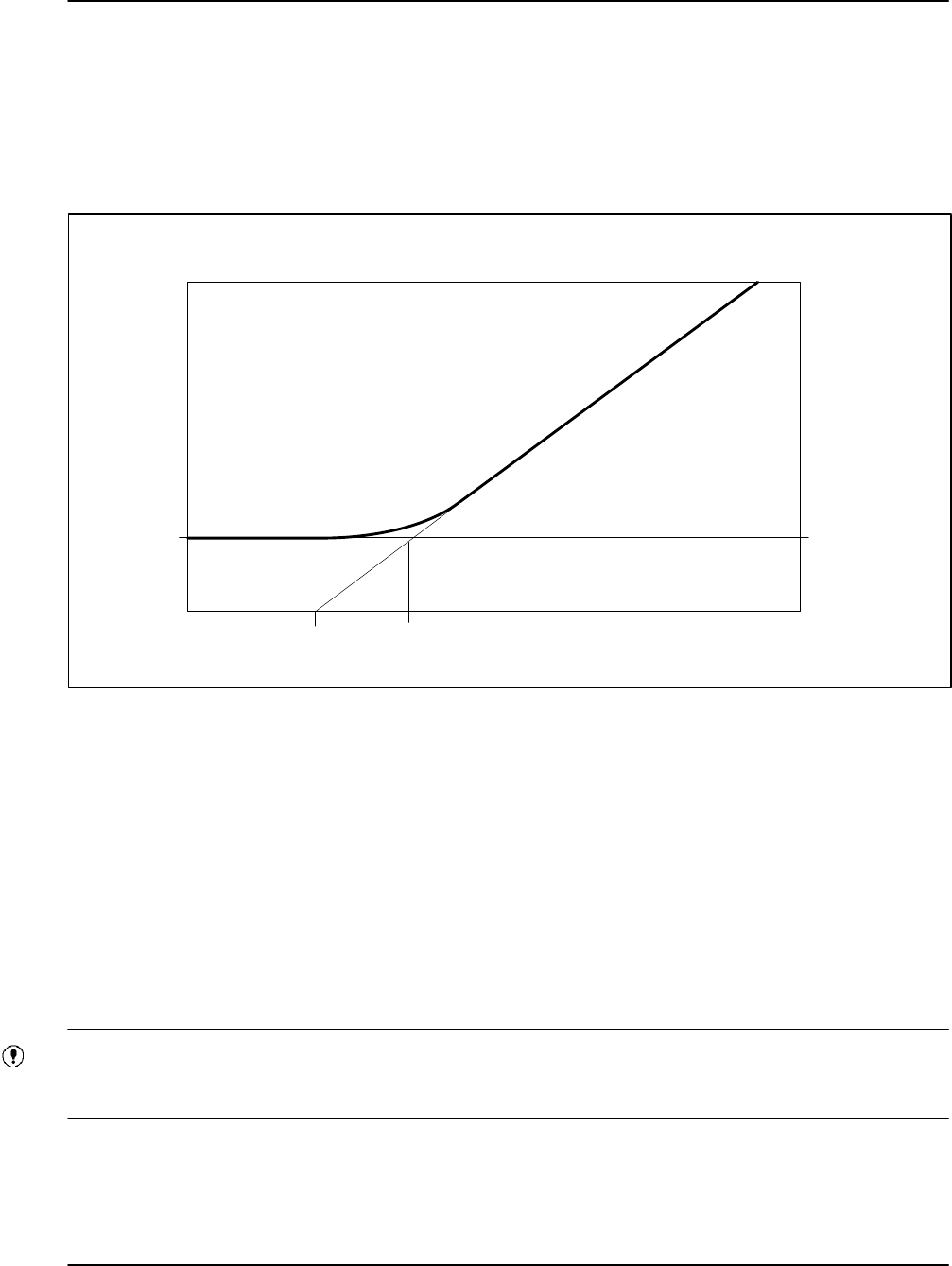
Processing Algorithms (draft)
RVP8 User’s Manual
April 2003
5–25
5.4 Reflectivity Calibration
The calculation of reflectivity described in section 5.2.5 required the calibration reflectivity
dBZo. This section describes it’s derivation. Note that customers with the SIGMET IRIS system
can use the zauto utility to perform the calibration. (See the IRIS Utilities Manual.)
Figure 5–3: Model Intensity Curve
RVP7 Measured Power
(log scale, dBm)
10 log Io
Power at Antenna Feed
N
(log scale, dBm)
Plot Method for Calibration of Io
This approach generates the curve shown above to determine the value of Io. The general
procedure is to connect a calibrated signal generator to the radar receiver and inject known dBm
power levels to generate a calibration plot of measured power vs the inserted power at the
antenna feed, similar to that in Figure 5–3. The calibration reflectivity dBZo is computed from
the radar constant and the value of Io which is the intercept of the straight line fit with the Noise
level. Io is the signal level for 0 dB SNR, i.e., signal power equals noise power.
Typically a CW test signal is used for this. Follow the instructions provided by the radar
manufacturer for injecting a test signal. During calibration, the radar should be fully operational,
so that all sources of noise are present. Ideally the transmitter should be turned on during
calibration.
Important: Verify with the radar manufacturer that no damage will occur to the signal
generator if the transmitter is running during the calibration.
To perform the calibration, insert signals at steps of 5 or 10 dB over the entire range of the
system. Draw the plot shown in figure 5–3. You can utilize fine resolution steps at the ends of
the scale to observer the details of the roll off. Be sure to raise the antenna up a few degrees to

Processing Algorithms (draft)
RVP8 User’s Manual
April 2003
5–26
avoid ground thermal noise. Also tune the frequency of the signal generator using the setup
command “pr”, and displaying the received signal spectrum. Be sure to check the tuning at the
end of the calibration to make sure the signal generator and IFD have not drifted apart.
Each time that a new signal level is injected, the measured power values are obtained by first
invoking the SNOISE command and then reading-back the results using the GPARM command.
The Log of Measured Noise Level (Word 6) from GPARM should be used. This procedure
averages many samples together. For IRIS users, this is all handled by the zauto utility.
Finally turn it all the way down and make one more sample to measure the noise level N. Io is
obtained from the intercept of the horizontal line at N and the straight line fit to the linear
portion of the curve. This value must be corrected for losses as discussed in the section below.
Single-Point Direct Method for Calibration of Io
This calibration method requires no support software. The approach uses the TTY setups
commands. Again the signal generator output must be calibrated in absolute dBm. Use a power
meter to check the calibration.
STurn the radiate off and connect the signal generator to the test signal injection
point.
SRaise the antenna to at least 20 degrees, and set the azimuth to point away from
any known RF sources including the sun.
SSelect the pulse width using the mt command.
SSelect the pr command and use the commands to set the following:
Plotting Received Power Spectrum...
Rx:Pri, Zoom:x1–x8, Navg:25, Start:100.01 usec (14.99 km), Span:50 usec
SSet the signal generator to the approximate radar RF frequency with a power level
corresponding to a strong signal (30 dB above the noise). Use a DC test signal
(not pulsed). This signal should be visible as a peak in the spectrum display.
Adjust the siggen RF signal frequency so that produces the precise IF frequency
(e.g., IF frequency of 30 MHz).
STurn the signal generator off and record the “Filtered” power level. Note that
because of the large averaging it will require several seconds for the average to
stabilize.
STurn the signal generator on, verify that the peak is still at the IF frequency and
adjust the power level to obtain precisely 3 dB more “Filtered” power than was
observed with the noise only. Again, allow several seconds for the averaging to
stabilize after you make each amplitude adjustment.
This is the value of Io, i.e., the test signal signal power equals the noise power. The next step is
to correct the value of Io for losses as discussed in the section below.

Processing Algorithms (draft)
RVP8 User’s Manual
April 2003
5–27
Treatment of Losses in the Calibration
In the calibration of the dBm level of the test signal, be sure to account for any losses that may
occur between the antenna feed and the injection point, and in the cable and coupler that is used
to connect the signal generator to the injection point. Figure 5–4 illustrates the nomenclature of
the various losses that are involved in the calibration. The relationship between the injected test
signal and the value of the received power relative to the feed is:
dBmFeed +dBmInjected )dBLFeed:Coupler
dBmFeed +dBmSiggen *dBLCoupler *dBLCable )dBLFeed:Coupler
For example, assume the following:
Loss between the feed and the coupler dBLFeed:Coupler 3 dB
Loss caused by the coupler dBLCoupler 30 dB
Loss in the cable from siggen to coupler dBLCable 2 dB
Then if the test signal generator output is –50 dBm, the injected power is
dBmInjected = –50–[30+2]= –82 dBm.
The equivalent power at the feed is then 3 dB more than this
dBmFeed = –82+3 = –79 dBm.
During the calibration, there are several ways to handle the losses using these equations. Two
examples are:
SEach signal generator value can be corrected for losses so that the calibration plot shows IFD
measured power vs received power at the feed. This is recommended for manual calibration.
SThe signal generator values can be plotted directly and the intercept power Io can be
corrected for losses so that it is properly referenced to power at the feed. This is the approach
used by the IRIS zauto utility.
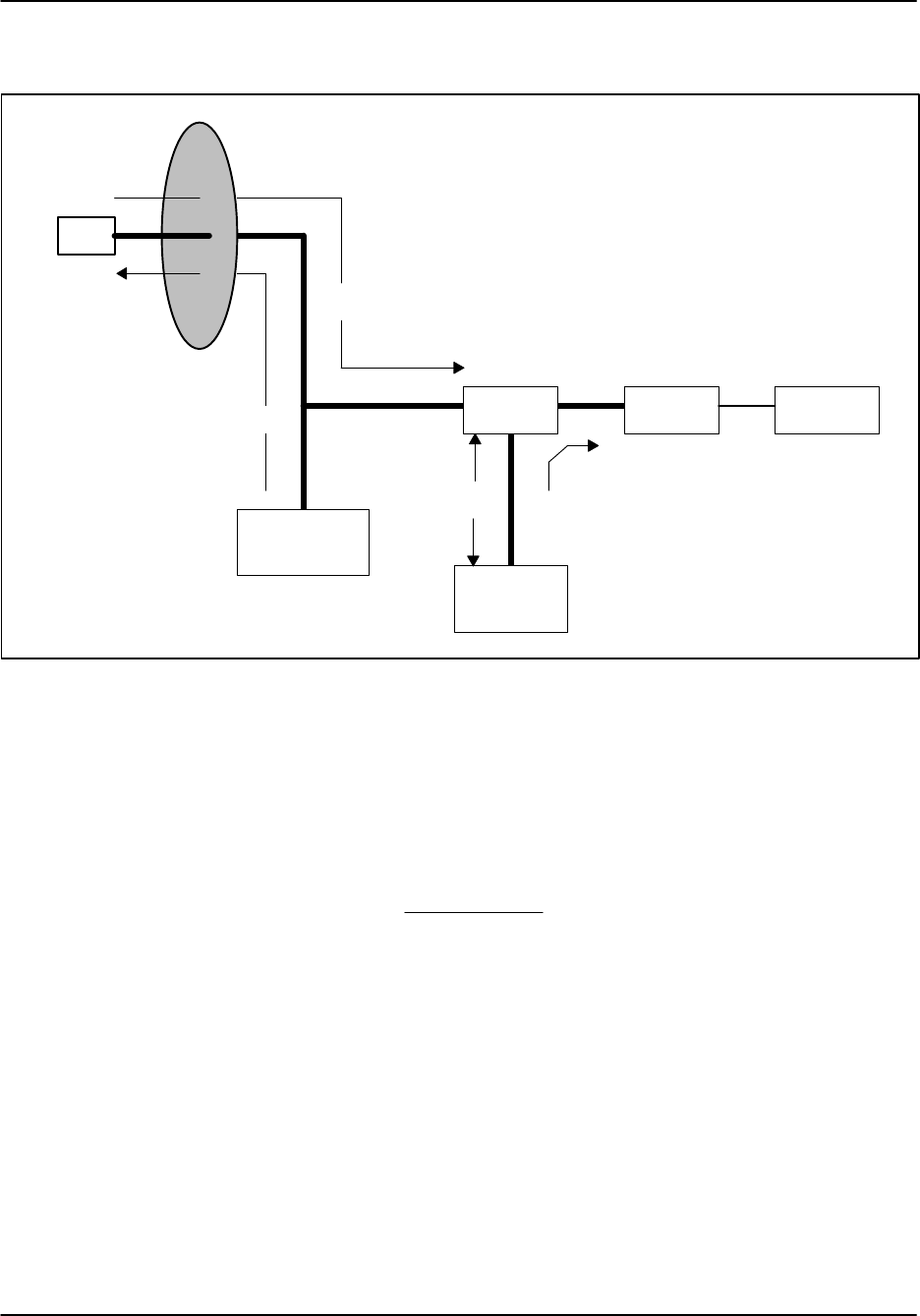
Processing Algorithms (draft)
RVP8 User’s Manual
April 2003
5–28
Figure 5–4: Illustration of Losses that Affect LOG Calibration
Transmitter
Pt
Coupler Receiver
Sig Gen
dBmsiggen
RVP7
IFD
Lt
LFeed:Coupler
Feed
Receive Path
Transmit
Path
dBmFeed
LCable
LCoupler
Pt Feed
Determination of
dBZo
The calibration reflectivity is determined from the radar equation as follows:
dBZo+10 log ƪCr2
oIoƫ
where Io is in mW (corrected for receive losses), the reference range ro is 1 km, and the radar
constant C is:
C+2.69 1016l2
PttqfG2Lt
where,
lRadar wavelength in cm.
PtTransmitted peak power in kW.
LtTransmit loss (e.g., 3 dB corresponds to Lt+2)
tPulse width in microseconds.
qHorizontal half-power full beamwidth.
fVertical half-power full beamwidth.
GAntenna gain (dimensionless) on beam axis.

Processing Algorithms (draft)
RVP8 User’s Manual
April 2003
5–29
The radar constant is determined from the characteristics of your radar (check with the
manufacturer if you are unsure of the values). Note that transmit losses are accounted for in the
radar constant, while receiver loss is usually included in the calculation of Io.
Finally, if the value of Io calculated above was not based on loss-corrected dBm values, correct
Io as follows:
dBIo corrected +dBIo*dBLCoupler *dBLCable )dBLFeed:Coupler
Example Calculation of
dBZo
:
This sample calculation is provided so that programmers can check their arithmetic. The radar
parameters:
lRadar wavelength in cm. 5 cm.
PtTransmitted power in kW. 500 kW
LtTransmit Loss 2 (3 dB)
tPulse width in microseconds 1 microsecond
qHorizontal half-power beamwidth in degrees 1 degree
fVertical half-power beamwidth in degrees 1 degree
GAntenna gain (dimensionless) on beam axis 19,953 (43.0 dB)
The radar constant for this example is,
C+2.69 1016l2
PttqfG2Lt+(2.69 1016)(5)2
(500)(1)(1)(19, 953)2(2.0)
+6.76 106ƪmm6m*3km*2mW*1ƫ
Assume that Io with loss correction is calculated to be –105 dBm (3.16 10*11 mW), then
dBZo is,
dBZo+10 logƪCr2
oIoƫ+10 logƪ(6.76 106)(1)
2(3.16 10*11)ƫ
+*36.7dB (mm6m*3)
This value would be down-loaded to the signal processor using the SOPRM command.
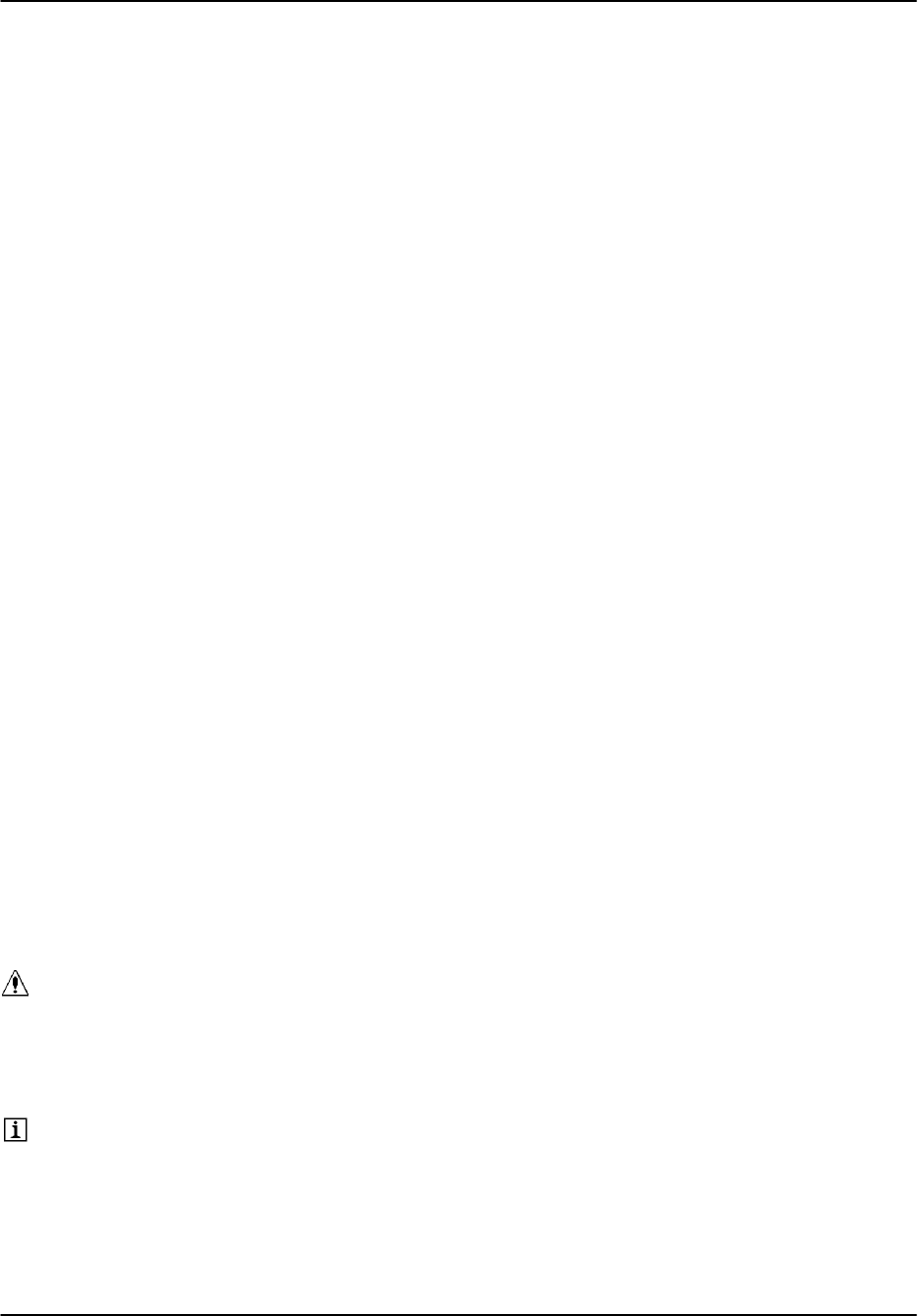
Processing Algorithms (draft)
RVP8 User’s Manual
April 2003
5–30
5.5 Dual PRT Processing Mode
The RVP8 supports two major modes for Dual PRT processing, i.e., algorithms using triggers
that consist of alternate short and long periods. Most of the Doppler parameters are available in
each of these modes. You may also request time series data in both cases; the samples will be
organized so that the first pulse of a short PRT pair always comes first.
5.5.1 DPRT-1 Mode
The DPRT-1 trigger consists of a very short PRT from which Doppler data are obtained,
followed by a much longer PRT whose purpose is to limit the average duty cycle of the
transmitter. No information is extracted from the long PRT pair, but Dual-PRF techniques can
still be used by varying the short period from ray to ray. The “-1” suffix in the name for this
mode is a reminder that Doppler parameters are computed from the short PRT only. The
DPRT-1 mode is intended for millimeter wavelength radars that must run at a very high effective
PRF (up to 20KHz) to get an acceptable unambiguous velocity, but which also have a much
lower duty cycle constraint on the average number of pulses transmitted each second.
In DPRT-1 mode the requested PRF from the host computer will generally be quite large (up to
20KHz); and the reciprocal of this “effective instantaneous PRF” will determine the trigger’s
short PRT interval. In this way, all subsequent physical calculations will be scaled correctly,
e.g., unambiguous velocity, maximum first trip range, etc., are all supposed to be based on the
short PRT interval. The host computer must therefore be configured so that it can ask for these
very high trigger rates.
The duration of the long PRT interval is not specified directly by the host computer. Rather, the
RVP8’s “Maximum number of Pulses/Second” setup parameter is used to compute how much
delay to insert in order to insure that the transmitter’s duty cycle is not exceeded. This special
treatment applies only in DPRT mode; all other modes that have uniform triggers continue to
interpret the RVP8’s trigger bound as a simple “Maximum PRF”.
Since DPRT-1 mode uses only the short pairs of pulses, it is not possible to run the “R2” moment
estimation algorithms. The RVP8 will return the GPARM “Invalid Processor Configuration” bit
if “R2” is requested in DPRT mode. The error bit will also be returned if the number of pulses
requested (sample size) is not even. All other error conditions are the same as FFT mode.
Warning: Since the RVP8’s “Maximum number of Pulses/Sec” is used to enforce
the duty cycle limit, it is essential that it not be overwritten by the host
computer’s upper PRF limit, which typically will be much higher. To insure
this, you must make sure that the PWINFO command is disabled in the RVP8
“Mc” setup menu. You will have no duty cycle protection if you do not do this.
Note: You may still choose to run Dual-PRF velocity unfolding within the
DPRT-1 mode. What will happen is that the short PRT will vary in the selected
3:2, 4:3, or 5:4 ratio, but the overall duty cycle will remain constant. The
combination of Dual–PRF and DPRT-1 is tremendously effective in extending
the radar’s unambiguous velocity interval.

Processing Algorithms (draft)
RVP8 User’s Manual
April 2003
5–31
5.5.2 DPRT-2 Mode
The trigger consists of alternating short and long period pulses, where the ratio of the periods is
determined by the velocity unfolding ratio that has been selected. Doppler data are extracted
from both the short and long pulse pairs (hence the “-2” suffix), and unfolded velocities are
made available on each ray based on the combined PRT data from that ray alone. DPRT-2 mode
is intended for rapidly scanning radars where the ray-to-ray spatial continuity assumptions of the
traditional Dual-PRF algorithms do not apply.
The DPRT-2 velocity unfolding algorithm uses a modified version of the standard Dual-PRF
algorithm. Both start by computing a simple velocity difference as a first approximation of the
unfolded result. The standard algorithm uses that difference to unfold the velocity from the most
recent ray, which yields a lower variance estimate than the difference itself. The DPRT-2
algorithm is similar, except that the folded velocity from both PRTs are unfolded independently
and then averaged together.
In addition to the above, the RVP8 also computes the DC average of the (I,Q) data within each
bin. This is used as a simple estimate of clutter power, so that corrected reflectivities are
available in DPRT-2 mode whenever a non-zero clutter filter is selected. DPRT-1 mode is the
same in this respect. However, the DPRT-2 widths use an improved algorithm based on the two
different PRTs, and which avoids the SNR sensitivity of the DPRT-1 width estimator.

Processing Algorithms (draft)
RVP8 User’s Manual
April 2003
5–32
5.6 Dual PRF Velocity Unfolding
For a radar of wavelength l operating at a fixed sampling period ts+1ńPRF , the unambiguous
velocity and range intervals are given by:
Vu+l
4ts and Ru+cts
2
where “c” is the speed of light. Often these intervals do not fully cover the span of velocity and
range that one would like to measure. The problem is generally worse for short wavelength
radars, since that unambiguous velocity span is directly proportional to l for a given ts. If the
unambiguous range interval is made sufficiently large by increasing ts , then the resulting
velocity span may be unacceptably small.
The RVP8 provides a built-in mechanism for extending the unambiguous velocity span by a
factor of two, three, or four beyond that given above. The technique, called Dual PRF velocity
unfolding, uses two pulse periods rather than one, and relies on the extra information thus
obtained to correct (i.e. unfold) the mean velocity measurement from each individual period.
The Dual PRF trigger pattern consists of alternating (N+k)-pulse intervals where the period in
each interval is either tl (for the low-PRF) or th (for the high-PRF). Here “N” is the sample
size, and “k” represents a delay that permits the clutter filter to equilibrate to the new PRF after
each change. The clutter filter impulse response lengths vary according to which filter is
selected.
The two trigger periods tl and th must be chosen in either a 3:2, 4:3, or 5:4 ratio. These ratios
give factors of two, three, and four times velocity expansion over the th period alone. The
unfolding algorithm makes use of the following results. Suppose that the radar observes a target
with mean velocity V at each of the two trigger periods. The measured phase angles for the R1
autocorrelations at the two PRFs are:
ql+4pVtl
l and qh+4pVth
l
where angles outside the basic [*p,p] interval are returned to that interval by appropriate
additions of "2p. These angles correspond to the ordinary single-PRF Doppler velocity
measurements, and the "2p uncertainties reflects the fact that each measurement is folded
into its own unambiguous interval:
Vul +l
4tl and Vuh +l
4th
If we define f to be the difference between the two measured phases then:
f+ql*qh+4p
lƪtl*thƫ
which can be interpreted as a phase angle within the unfolded interval:
Vu unfold +l
4(tl*th)
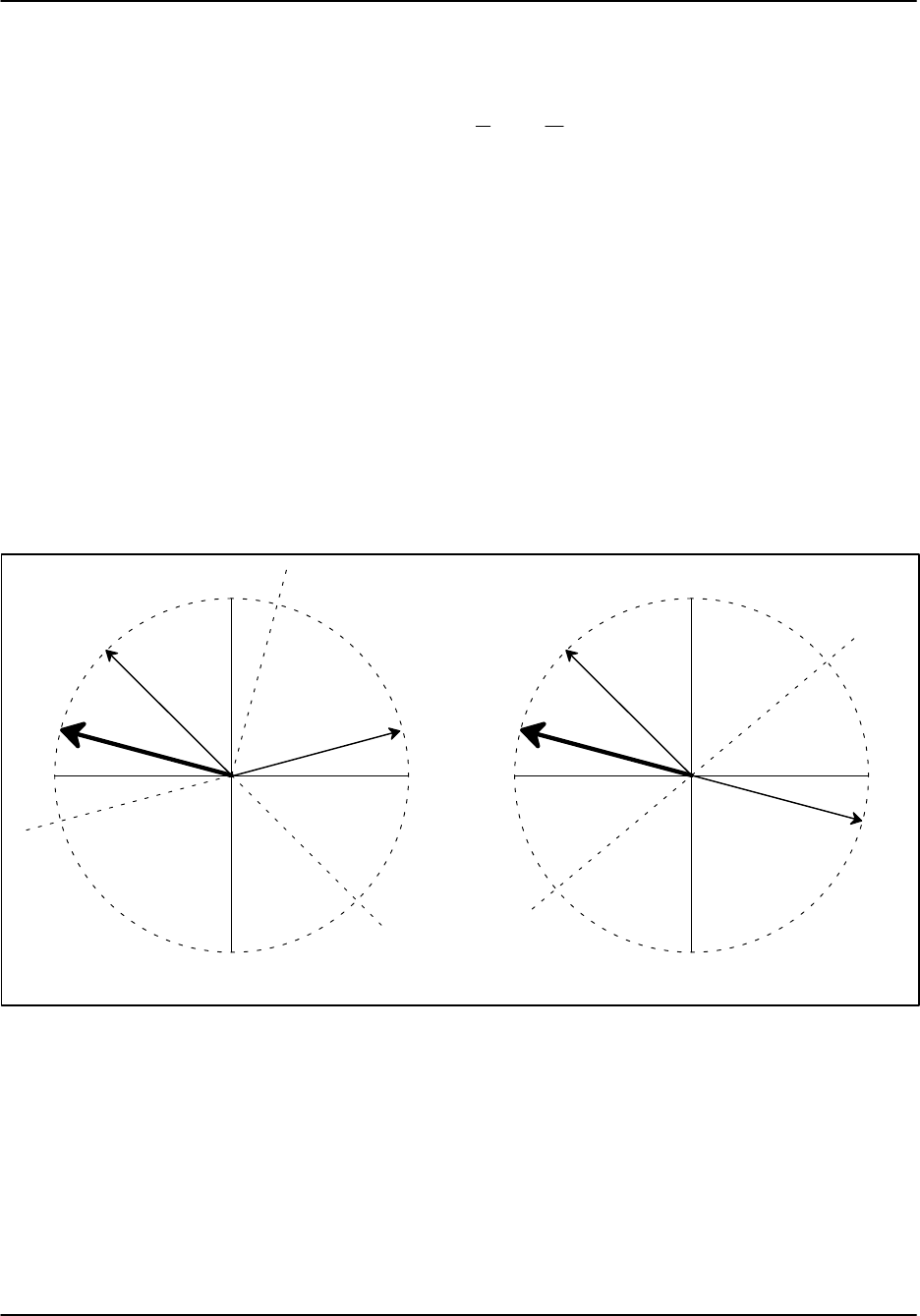
Processing Algorithms (draft)
RVP8 User’s Manual
April 2003
5–33
Now if tl and th are in a 3:2 ratio, then:
tl*th+tl
3+th
2
and thus Vu unfold +3Vul +2Vuh
The angle f represents a velocity phase angle in [*p,p] , but with respect to an enlarged
unambiguous interval. Thus, by simply differencing the folded angles from the high and low
PRFs, we obtain an angle that is unfolded to a larger velocity span. Similar reasoning shows that
the 4:3 ratio gives a factor of three improvement over Vuh .
In practice, the unfolded angle f is not in itself a suitable velocity estimator. The reason is that
the variance of f is equal to the sum of the variances of each of its components, i.e., twice that
of the individual measurements alone. If the target is at all noisy, then this increase in variance
can be severe. Rather than use f directly, the RVP8 uses it only as a rough estimate in
determining how to unfold the individual velocity measured from each PRF.
Figure 5–5: Dual PRF Concepts
ql*qh
Result
qlń3
Region III
Region II
Region I
Low PRF Case High PRF Case
Region I
Region II
ql*qh
Result
qhń2
This technique is illustrated in Figure 5–5. The figure shows how the low-PRF and high-PRF
angles are unfolded based on the difference angle. The diagrams show phase planes representing
the large unfolded velocity interval, and the locations of various vectors on those planes.
Referring first to the right figure, the difference angle is plotted, and the plane is divided into
two equal size regions, one of which is centered on the difference vector. The high-PRF angle is
then divided by two and plotted. The resultant unfolded velocity angle must either be this vector,
or this vector plus p. Since adding p places the vector into acceptance Region 1 where it is

Processing Algorithms (draft)
RVP8 User’s Manual
April 2003
5–34
nearest the difference angle, we conclude that this is the correct unfolding. Likewise, on the left
diagram we unfold the low-PRF angle by dividing the plane into thirds centered on the
difference angle. The result angle is either
ql
3,ql
3)2p
3or ql
3)4p
3
depending on which one falls into the acceptance Region 1. Note that the resultant angle is the
same in each case.
The RVP8 makes efficient use of the incoming data by unfolding velocities from both the low
and the high-PRF data, making use each time of information in the previous ray. When low-PRF
data are taken the derived velocities are unfolded by combining information from the previous
high-PRF interval. Likewise, when high-PRF data are acquired the velocities are unfolded based
on the previous low-PRF interval. Thus, when operating in the Dual PRF mode, the RVP8
outputs one data ray for each (N+k)-pulse interval. However, the velocity data in the Dual PRF
rays are unfolded, so that the [–1,+1] interval now represents either two or three times the prior
velocity range. Put another way, the data are still interpreted as described in the section on mean
velocity estimation, except that Vu is now larger.
The width data are also modified somewhat during Dual PRF unfolding. Although valid widths
are obtained independently on all rays, those measured at low-PRF are larger than those at
high-PRF. This is simply because the dimensionless width units are with respect to a larger
velocity interval in the latter case. To compensate for this, low-PRF widths are multiplied by
either 2/3 or 3/4 before being output. This puts them in the same scale as the high-PRF values,
and thus, the widths do not vary on alternate pulses. A useful consequence of this is that width
data can be sent directly to a color display generator without having to plot every other ray in a
different scale.
There are a few words of caution that should be kept in mind when using the RVP8 in the Dual
PRF processing modes. The unfolding algorithms make the assumption that targets are
more-or-less continuous from ray to ray. Otherwise, it would not make sense to use data from a
previous ray to unfold velocities in the current ray. Users must therefore assure that their antenna
scan rate and beamwidth are such that each target is illuminated, at least partially, over each full
2(N+k)-pulse interval. In practice, a certain amount of decorrelation from ray to ray is
acceptable, since the previous rays are used only to decide into which unfolded interval the
current ray should be placed. Small errors in the previous ray data, therefore, cause no error in
the output. However, large previous-ray errors would lead to incorrect unfolding.
A more subtle side effect of Dual PRF processing arises from clutter filtering because clutter
notches now appear at several locations in the unfolded velocity span, rather than just at zero
velocity. These additional rejection points come about because the original velocity intervals are
mapped some integer number of times to create the unfolded interval. Since each original
interval has a clutter notch at DC, it follows that the final expanded velocity interval will have
several such notches. For example, in the 3:2 case, in addition to removing DC the clutter filter
removes velocities at *2Vuń3,)2Vuń3, and Vu.
Unfortunately, these clutter filter “images” are a fundamental consequence of the Dual PRF
processing technique and are not easily removed. They can cause trouble not only for the
velocity unfolding itself, but because the computed clutter corrections to be wrong at the image
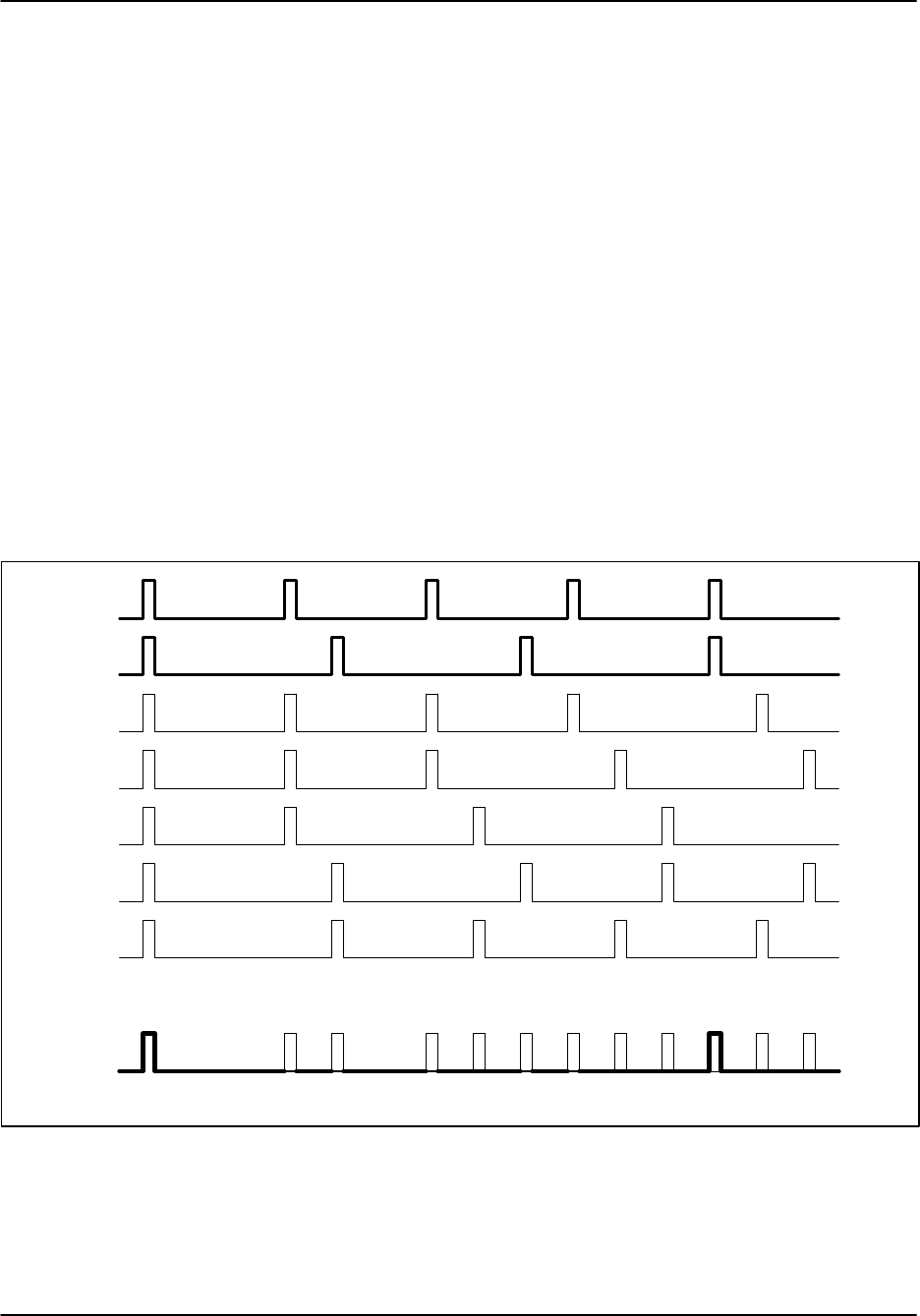
Processing Algorithms (draft)
RVP8 User’s Manual
April 2003
5–35
points. However, there is a useful work-around in the RVP8 to minimize their impact — turning
the clutter filter off at far ranges where little clutter is expected and using a narrow clutter filter
minimizes the effects of the clutter filter on weather targets.
The 4:3 PRF unfolding ratio is more susceptible to unfolding errors in cases where the spectrum
width is large and/or the SNR is low. The user should experiment with the two ratios to
determine which provides the best results for their particular application. Although the RVP8
trigger generator can produce any trigger frequency, only the 3:2 and 4:3 ratios can be used with
the built-in unfolding algorithms. The RVP8 still permits other PRT ratios to be explored, but the
unfolding technique must then be manually programmed on the user’s host computer.
Oscilloscope observations of Dual PRF triggers can sometimes be confusing. Figure 5–6 shows
seven possible scope traces (and their associated probabilities) for the RVP8 trigger during Dual
PRF operation. The PRF ratio is 4:3, and the sample size is 50 pulses at the high PRF, and 37
pulses at the low PRF. The signal labelled “SCOPE” is the composite of these traces, and is what
would actually be seen on an oscilloscope. Notice that there are a number of low probability pulses.
The exact details of the sample sizes and the trigger hold off time can make the low probability
pulses appear to come and go randomly. This is normal, and is no cause for alarm.
Figure 5–6: Example of Dual PRF Trigger Waveforms
47.0%
47.3%
1.0%
1.0%
1.0%
1.3%
1.3%
SCOPE
100% 50% 50% 49% 2.3% 48.6% 48% 2.3% 2.3% 94.3% 2.3% 2.3%

Processing Algorithms (draft)
RVP8 User’s Manual
April 2003
5–36
5.7 Optional Dual Polarization- ZDR, PHIDP, KDP,LDR, ...
5.7.1 Overview of Dual Polarization
Polarization measurements can provide additional information that can be used to determine
more accurate measurements of rainfall or, in some cases, infer particle type such as hail or
graupel. The fundamental basis for polarization is that raindrops, particularly larger ones, are not
spherical — they are oblate (flattened) such that the horizontal axis is longer than the vertical
axis. This means that raindrops will respond differently, for example, to vertical and horizontal
polarization of the electric field vector. Because of this, and for technical reasons, most
polarization radars use horizontal and vertical polarization. For a review of polarization
techniques and variables, please refer to Doviak and Zrnic (1993) section 8.5.
Fundamentally a polarization radar measures amplitude and phase in the same manner as a
conventional radar. The new information is that the amplitude and phase can be measured at
more than one polarization. The differences in amplitudes and phases measured at different
polarizations contain information on the presence or absence of non-spherical scatterers such as
large flattened drops. For convenience, some of the basic polarization variables are described
below:
ZDR: Differential Reflectivity
In the case of amplitude (power) measurements, the larger horizontal axis of drops causes
the power measured at horizontal polarization (of the electric field) to be larger than the pow-
er measured at vertical polarization. The ratio of the reflectivity factors ZH/ZV expressed in
dB is given the name ZDR or differential reflectivity. It is generally positive in rain (i.e., >1)
and is usually less than about 5 dB. When the rainfall rate is large, there are typically more
large drops so that ZDR is larger. Low ZDR and high dBZ indicates the presence of hail
which is perhaps tumbling with no preferred orientation. ZDR, because it is a ratio of powers,
is not sensitive to the radar calibration as long as the overall gain of the H and V channels
is the same (or calibrated).
PhiDP and KDP: Differential Phase and Specific Differential Phase
In the case of phase measurement, the speed of propagation is also affected by the asymmetry
of the larger drops. Because of the longer dimension of the horizontal axis of drops, the me-
dium is effectively more dense for horizontal than for vertical polarization so that the speed
of light is reduced for horizontal polarization. This causes the horizontal wavelength to be
slightly compressed (more phase cycles per unit distance) in comparison with the vertical
wavelength which leads to a phase difference between horizontal and vertical. The phase
difference ΦH−ΦV is called ΦDP differential phase shift. ΦDP increases with range since the
phase shifts faster (more frequency cycles per unit distance) for the compressed horizontal
microwaves as compared to the faster vertical microwaves. The range derivative of the dif-
ferential phase, i.e., the change of phase per unit distance, is called KDP or the specific differ-
ential phase. KDP is almost directly proportional to the rainfall rate so that it has the potential
for improving precipitation rate measurements as compared to traditional Z–R relationship
measurements which can be highly inaccurate.

Processing Algorithms (draft)
RVP8 User’s Manual
April 2003
5–37
LDR: Linear Depolarization Ratio
Some advanced polarization radars can transmit at one polarization and receive simulta-
neously in two channels, usually the co–polarized and cross–polarized components. For ex-
ample, when transmitting horizontal, both horizontal (co–polarized) and vertical (cross–po-
larized) are received by two separate channels. In the case of vertical or horizontal, the ratio
of the power Zcross / Zco is called the linear depolarization ratio or LDR. The amount of inci-
dent radiation that is depolarized by a particle depends on the particle shape and orientation
(e.g., canting angle with respect to horizontal). Perfectly spherical particles do not depolarize
either horizontal or vertical polarization so that LDR is zero. Particles that are wet, tumbling
and irregularly shaped will give larger LDR values. Therefore, LDR values in rain tend to
be small, e.g., less than –25dB. Larger values of LDR can occur in the bright band or in the
presence of hail.
A radar and antenna system must be optimized to measure LDR by assuring that the antenna,
feed and supporting struts and radome are not themselves depolarizing the transmitted and
received radiation. This is called “cross–pol isolation”. The integrated cross–pol isolation
of the antenna pattern must be better than about 30 dB for LDR measurement since –20 dB
is a large LDR.
[RHOHV, PHIDP] [RHOH, PHIH] [RHOV, PHIV]: Correlation Variables
There are several correlation functions that can be calculated depending on the capabilities
of the radar. These are generally complex having both an amplitude and phase. These are all
normalized so that a perfect correlation magnitude is 1 and perfectly decorrelated is 0.
RHOHV and PHIDP are the magnitude and phase of the correlation between the horizontal
and vertical co-polarized channels. These are available on H/V switching systems or on sys-
tems that transmit simultaneous H and V. As discussed in a preceding paragraph, PHIDP
can be used to infer precipitation rate. RHOHV in rain is typically very close to 1 (0.98).
RHOHV values can be reduced in the case of irregularly shaped, randomly oriented, wet
tumbling particles. Thus RHOHV has information on the particle type.
RHOH and PHIH are the magnitude and phase of the correlation between the co-polarized
and cross-polar channels for H transmission and simultaneous H and V reception. RHOV
and PHIV denote the cross–channel correlation magnitude and phase for vertical transmis-
sion. These are available on dual-channel receiver with transmit either fixed or alternating.
The information content of the cross-pol correlations is the topic of current research.

Processing Algorithms (draft)
RVP8 User’s Manual
April 2003
5–38
5.7.2 Radar System Considerations
A polarization radar is characterized by how it transmits and how it receives. For simplicity we
will assume that the radar uses horizontal and/or vertical polarization. However, other
polarization pairs could be used (e.g., right and left circular polarization).
Transmit Modes
SFixed (horizontal or vertical)- this can be controlled by a switch or the radar can
be simply fixed to transmit a single polarization. If a switch is used, it can be a
simple slow waveguide switch rather than a fast switch (pulse-to-pulse).
SAlternating (horizontal and vertical)- in this case the radar alternates
pulse-to-pulse between horizontal and vertical. A high-power fast switch is used
to switch the polarization between the two channels.
SSimultaneous (horizontal and vertical)- horizontal and vertical are transmitted
simultaneously.
Receive Modes
SSingle-channel receiver- used only for alternating transmission. The receiver
typically receives the co–polarized radiation (transmit H and receive H then
transmit V and receive V).
SDual-channel receiver- receives two channels (H and V) simultaneously.
The table below summarizes the various transmit and receive cases and the polarization variables
that are available for each. Note that standard parameters are available for all cases (dBT, dBZ,
V and W). The RVP8 supports all of these cases.
Transmitter Type
Receiver Type Fixed H Fixed V Alternating
H&V Simultaneous
H+V
Single-Channel Conventional
Radar Conventional
Radar ZDR
RHOHV
PHIDP and KDP
Not applicable
Dual-Channel LDRH
RHOH
PHIH
LDRV
RHOV
PHIV
LDRH LDRV
RHOH RHOV
PHIH PHIV
ZDR
RHOHV
PHIDP and KDP
ZDR
RHOHV
PHIDP and KDP
(STAR mode)
The fixed single -channel cases are conventional radars rather than polarization radars. The case
of simultaneous H+V transmission and a single radar does not make physical sense. The other
cases provide various polarization measurements. The fixed dual-channel cases allow the
cross-polarization LDR and the co-pol/cross-pol correlation amplitude and phase to be measured

Processing Algorithms (draft)
RVP8 User’s Manual
April 2003
5–39
(e.g., RHOH and PHIH). The simultaneous H+V transmission and dual-channel reception is
sometimes called the STAR mode (simultaneous transmit and receive). This allows the co–pol
measurements to be made (ZDR, RHOHV, PHIDP and KDP). The alternating transmission
dual-channel receiver allows both the co–pol and the cross-pol measurements to be made, i.e., it
is the most complete.
Summary of Radar System Characteristics
The RVP8 supports all of these modes, but most polarization radar systems do not. As mentioned
before, the measurement of cross-pol parameters such as LDR (fixed or alternating transmission
and dual-channel reception) requires a radar system that has been optimized for cross–pol
isolation, e.g., an offset feed antenna and no radome. By removing the feed, support struts and
radome from the path of the radiation, the cross–pol isolation can be improved.
The single-channel alternating method has been used in several polarization radars for ZDR
measurement. The advantage of this approach is that it is relatively easy to modify a
conventional radar by simply adding a dual port feed and a high-power fast switch above the
antenna rotary joints. The disadvantage is that the switch is costly and will eventually fail.
For these reasons, the STAR mode has come into recent use. No switch is required and the
components are fairly reliable. The disadvantage of the approach (as it is usually implemented)
is that a dual rotary joint and dual waveguides are required to duct both the H and the V through
the antenna pedestal up to the antenna feed. In spite of this, the STAR mode offers perhaps the
best approach for upgrading an existing radar or for factory installation on a new radar of
conventional design.
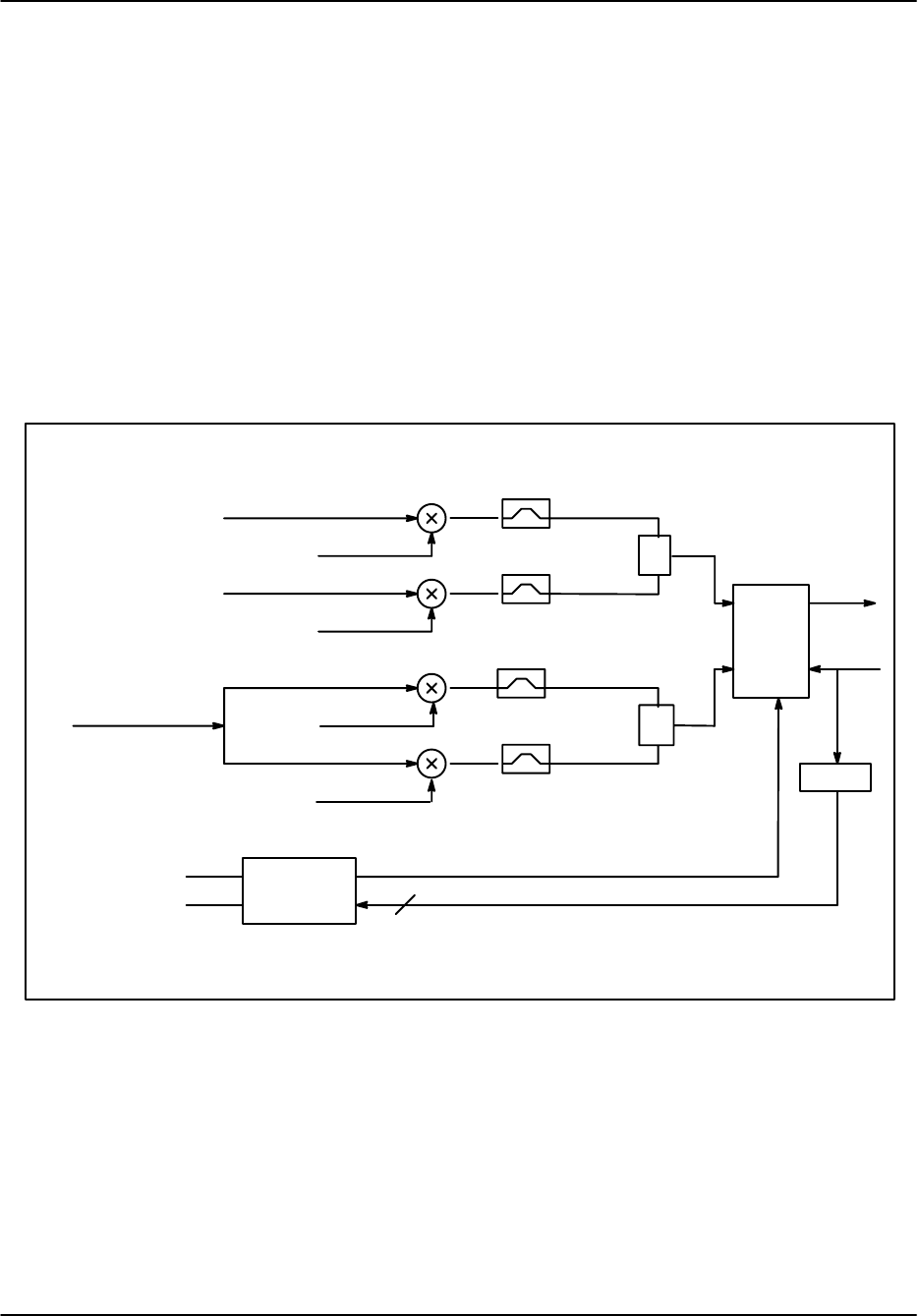
Processing Algorithms (draft)
RVP8 User’s Manual
April 2003
5–40
5.7.3 RVP8 Dual-Channel Receiver Approach
Dual-Channel Multiplexing for the IFD
The RVP8 uses an innovative technique for implementing the dual-channel receiver approach,
i.e., dual-channel multiplexing. Just as a single wire can carry multiple telephone conversations,
two polarization channels can be put on the same wire at different IF frequencies, digitized by
the IF Digitizer and then separated by digital filtering. This means that the exact same hardware
that is used for a single-channel digital receiver is used for the dual-channel application. The
typical IF separation is 6 MHz and the channel isolation is about 50 dB which is more than
adequate for even sensitive LDR measurements.
The figure below shows a block diagram of the approach for the magnetron case.
Figure 5–7: Dual Receiver Magnetron Case
IFD
Horizontal IF @ 30 MHz
Vertical IF @ 24 MHz
Horz Burst @ 30 MHz
Vert Burst @ 24 MHz
Σ
Σ
Reference clock of synthesized STALO (e.g. 10 MHz)
RF +30 MHz
Horizontal RF
Vertical RF
Transmit Burst RF
RF +24 MHz
RF +30 MHz
RF +24 MHz
RF +30 MHz
RF +24 MHz
DAFC
24 Digital AFC Control for Magnetron Systems
Dual
STALO
Uplink
IF In
Burst/COHO
Down
BPF
30
24
24
30
BPF
CLK
Magnetron Approach
The approach for the magnetron case requires a dual output STALO to obtain the two IF’s for
horizontal and vertical (H and V). The H and V RF channels are mixed to obtain the H and V IF
signals at 30 and 24 MHz in the example. In addition, the transmit sample (also know as the
“burst pulse” is split and mixed with the two IF’s so that there is a version at 30 and 24 MHz.
This is important for the determination of the transmit phase corresponding to each IF. Both the
H and V IF signals are combined and then digitized in the usual way by a standard RVP8 IFD.
The same is done with the 24 and 30 MHz versions of the transmit burst sample. The

Processing Algorithms (draft)
RVP8 User’s Manual
April 2003
5–41
anti–aliasing filters usually installed on the IFD are removed and replaced by separate filters that
are placed ahead of the point where the signals are combined. Note that these filters are centered
at the appropriate IF frequency and are typically 6 MHz wide for a 6 MHz IF separation. The
two composite signals are then digitized by the IFD identically to the case of a single-channel
receiver and later separated during the digital band pass filtering/mixing step to obtain the I and
Q of the burst sample and range bin values of I and Q values.
Klystron Approach
In the case of a Klystron system, the approach is the same, except that the COHO must generate
two frequencies which are mixed with the STALO to provide the two reference frequencies.
These are used in place of the STALO1 and STALO2 frequencies in the diagram. The same two
COHO signals (e.g., at 24 and 30 MHz) are then treated identically to the transmit burst pulse in
the magnetron case. In this case there is no burst pulse so the two burst pulse mixers are not
required.
Reference Clock to IFD
In either case, it is critical that the oscillators (both STALO’s in the case of a magnetron and the
STALO and both COHO’s in the case of a Klystron) be phase locked to a common reference
clock. This clock, or a derivative frequency of the clock such as a COHO frequency, is input into
the IFD to provide an absolute phase reference. Another alternative is two supply the difference
frequency between the two IF’s as the reference clock. To do this, the outputs of the two
STALO’s can be mixed by an additional mixer and filtered to obtain (for example) a 6 MHz
reference frequency.
The RVP8 IFD phase locks its sampling crystal to the reference clock input. Trigger generation
by the RVP8 will also be phase locked to the reference clock. The reference clock must be in the
range 2 to 60 MHz at 0 to –10 dBm and stable in phase to 10–7. The RVP8 IFD must be
specially configured with a locking crystal to enable this feature. SIGMET will either factory
install the modification or assist the customer in performing the modification and supply the
necessary components.
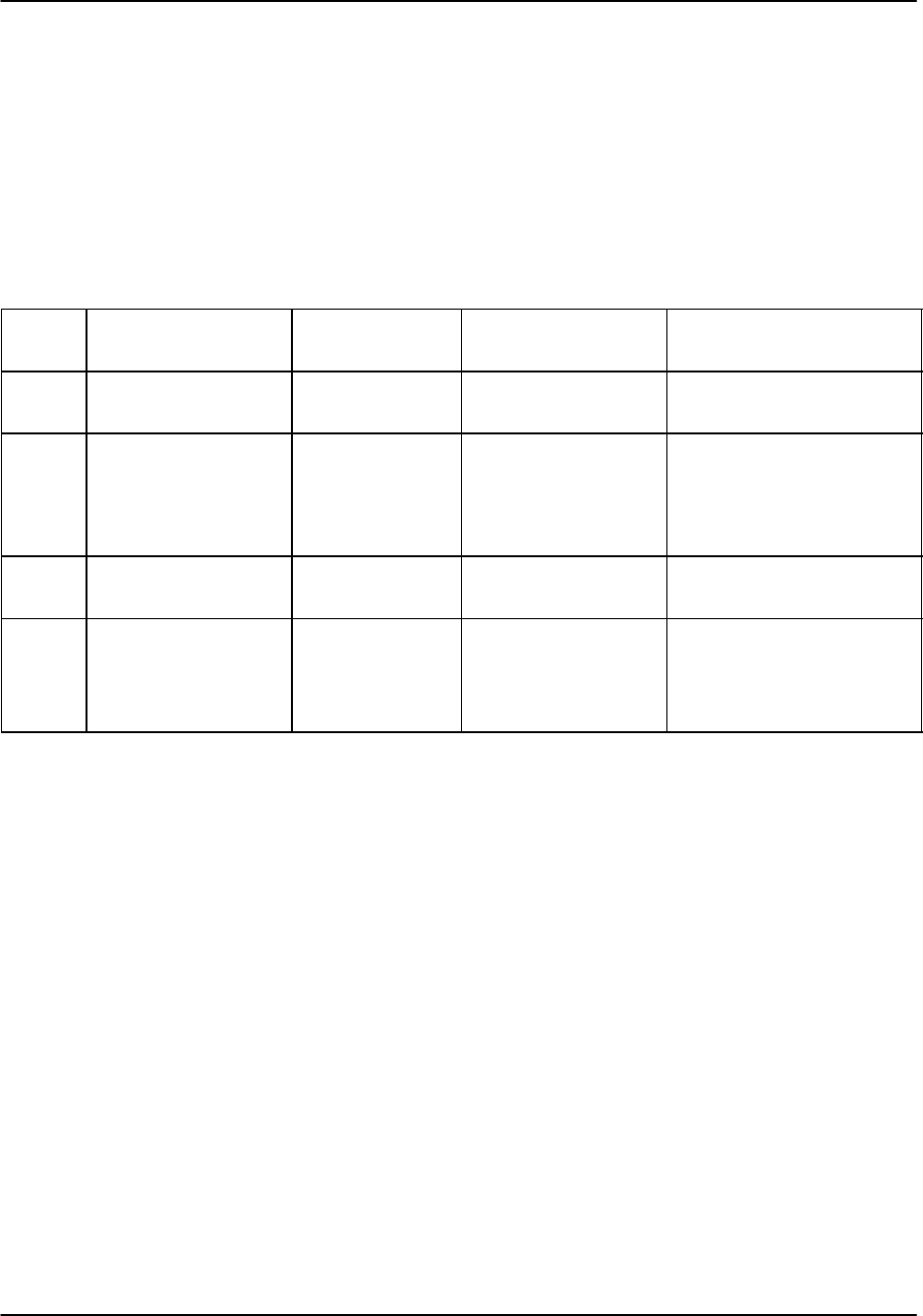
Processing Algorithms (draft)
RVP8 User’s Manual
April 2003
5–42
5.7.4 Overview of Processing Algorithms
Polarization Modes and Outputs Supported by RVP8
The RVP8 supports four polarization modes summarized in the table below. For each case, the
standard moments (T, Z, V and W) are calculated as well. The notation for the outputs used here
is similar to that in standard usage (e.g., Doviak and Zrnic). However, for LDR we use the
notation LDRH to indicate that this is the LDR for horizontal transmission. The notation RHOH
and PHIH is used to indicate the magnitude and phase of the covariance between the co- and
cross–polarized channels for H transmit.
Case Transmit Receive Processing
Mode Polarization Outputs
1Fixed Horizontal or
Fixed Vertical Dual-Channel PPP only LDRH RHOH PHIH or
LDRV RHOV PHIV
2Simultaneous H+V
(STAR Mode)
Dual-Channel PPP or
ZDR for FFT, Ran-
dom Phase and
DPRT1&2
ZDR PHIDP KDP
RHOHV
3Alternating H/V Single-Channel PPP only ZDR PHIDP KDP
RHOHV
4Alternating H/V Dual-Channel PPP only LDRH RHOH PHIH
LDRV RHOV PHIV
ZDR PHIDP KDP
RHOHV
Input Receiver Sample Notation
For the discussion of polarization, we will adopt the notation used by Doviak and Zrnic. The
received signal for pulse n from a single range bin shall be denoted as:
sn
hh Receive h: Transmit h Horizontal co-polar signal
sn
vh Receive v: Transmit h Horizontal cross–polar signal
sn
vv Receive v: Transmit v Vertical co–polar signal
sn
hv Receive h: Transmit v Vertical cross–polar signal
The pulse index is now indicated by the superscript as opposed to the subscript. The first
subscript indicates the received polarization while the second subscript indicates the transmit
polarization. If the transmit is the same as the received polarization, then this is called the
co–polarized signal. If the transmit and receive are different then this is called the
cross–polarized signal.
These variables are complex and are the same is the “sn” notation used earlier, for example we
can write:
sn
hhĄ+ĄIn
hhĄ)ĄjĄQn
hh
to show the relationship to the received I and Q values. Either filtered and unfiltered versions of
the samples can be selected for processing. However, for convenience we will drop the s’
notation for filtered samples.

Processing Algorithms (draft)
RVP8 User’s Manual
April 2003
5–43
Notation and Model for Correlations
The pulse pair processing mode is used for all of the polarization calculations, except that
ZDR-only processing for the STAR case can be done in either FFT or random phase as well as
pulse pair. As with the standard moments, the autocorrelations form the basis for the processing
of the polarization variables.
The autocorrelations are computed in a manner identical to the standard moments, e.g., in pulse
pair mode, the autocorrelations for the horizontal transmit co-polar channel are:
Tohh +1
Mȍ
M
n+1
sn
hh *sn
hh
Rohh +1
Mȍ
M
n+1
sȀn
hh *sȀn
hh
R1hh +1
M*1ȍ
M*1
n+1
sȀn
hh *sȀn)1
hh
R2hh +1
M*2ȍ
M*2
n+1
sȀn
hh *sȀn)2
hh
What is different is that for polarization systems, this processing can be applied in up to four
separate channels (shh, svh, svv and shv). The physical model for the channel powers is identical to
the model used for the standard moment cases, i.e.,
Co-Channel Power Cross-Channel Power
Rhh
o+gr
hgt
hShh )NhRvh
o+gr
vgt
hSvh )Nv
Rvv
o+gr
vgt
vSvv )NvRhv
o+gr
hgt
vShv )Nh
Here S is used to denote the actual backscatter average power to the radar which, when
multiplied by the appropriate transmitter and receiver gains, yields the actual measured power.
Sometimes in comparing powers in two channels (e.g., ZDR and LDR) we will need to know the
relative gains of the two channels. However, in many calculations, the relative gains cancel-out
and in these cases the algorithms are implemented assuming all the gains are equal to 1.
In the algorithm descriptions, we will often use the notation common in the literature that (for
example):
Rohh +1
Mȍ
M
n+1
sȀn
hh *sȀn
hh +t|sȀhh|2u

Processing Algorithms (draft)
RVP8 User’s Manual
April 2003
5–44
Noise Bias of Channel Power and Optional Correction
The average noise powers Nv and Nh are assumed to be receiver noise only. These bias the
autocorrelations at lag zero, i.e., the channel power measurements. Autocorrelations at lags 1 and
2 are not biased by noise. Cross channel correlations are also not biased by noise, assuming that
the noise in the two channels is independent (a good assumption).
The channel noise values are measured directly by the RVP8 during noise sampling. Whether to
use these measured values to correct for the noise power when computing a channel power is
optionally configured in the TTY setups. The choice is made in the mp TTY setup question
“Polarization Parameters NoiseCorrected:YES/NO”. If enabled, every time that a channel
power is calculated, the noise power is subtracted.
This has some interesting effects. With no noise correction, ZDR values in weak signal regions
will be biased by noise toward 0 dB (equal power), while if noise correction is enabled the
values will be unbiased but will show substantial deviation over the region. The choice is up to
the user.
Clutter Filtering
Clutter filtering is available for all four cases. The use of clutter filters should be carefully
considered since many polarization parameters such as ZDR and LDR require highly accurate
bin–to–bin consistency. The clutter filters will attenuate some small amount of weather near
zero velocity and the amount could be slightly different at the two polarizations. When using the
clutter filters, users should verify that the functioning is acceptable for their application.
The standard moments (T, Z, V, W) are filtered in the usual manner by selecting a clutter filter
(other than Filter #0 which is the All Pass filter). To enable clutter filtering of the polarization
variables, the mp TTY setup question “Polarization Parameters Filtered” should be set to YES.
The polarization algorithms will then be calculated with filtered time series. Note that filtering
can be effectively disabled for the polarization variables by selecting Filter #0 even if the mp
setup is set to enable filtering. This allows users to make easy comparison of the filtered vs
unfiltered results using their application software without having to change the RVP8 setup.
The s’ notation for filtered samples shall be dropped in the algorithm discussions. It is
understood that the input samples in all cases may be either filtered or unfiltered according to the
user’s choice in the TTY setups.

Processing Algorithms (draft)
RVP8 User’s Manual
April 2003
5–45
5.7.5 Case 1: Fixed Transmit: Dual-Channel Receiver
Input Receiver Samples
In fixed mode the radar is configured (either permanently or by means of a switch) to transmit
either vertical or horizontal polarization with dual-channel reception of both the co- and
cross–channel polarizations, e.g., transmit horizontal and receive both horizontal (co) and
vertical (cross) polarizations.
The received samples in the two transmit cases are:
Transmit Horizontal or Transmit Vertical
ƪs1
hh :s1
vhƫĄƪs2
hh :s2
vhƫĄƪs3
hh :s3
vhƫĄ.Ą.Ą.ĄƪsM
hh :sM
vhƫƪ
s1
vv :s1
hvƫĄƪs2
vv :s2
hvƫĄƪs3
vv :s3
hvƫĄ.Ą.Ą.ĄƪsM
vv :sM
hvƫ
Calculation of the Polarization Measurands
The processing in this mode is done by pulse pair algorithm. The user may select a clutter filter,
but in general this is not recommended for polarization studies since the clutter filter might
interfere with the accuracy of sensitive parameters such as LDR.
The polarization measurands for the two transmit cases are as follows:
Transmit Horizontal or Transmit Vertical
LDRH +10ĄLOGĄƪSvh
Shhƫ or LDRV +10ĄLOGĄƪShv
Svvƫ
+10ĄLOGĄƪt|svh|2u*Nv
t|shh|2u*NhƫĄ*XDR or +10ĄLOGĄƪt|shv|2u*Nh
t|svv|2u*NvƫĄ)XDR
RHOH +|òh|or RHOV +|òv|
PHIH +arg[òh]or PHIV +arg[òv]
Here, the H and V average channel powers are computed as follows with optional noise
correction, i.e.,
Co- gr
hgt
hĄShh +t |shh|2u*Nhor gr
vgt
vĄSvv +t |svv|2u*Nv
Cross- gr
vgt
hĄSvh +t |svh|2u*Nvor gr
hgt
vĄShv +t |shv|2u*Nh
The complex covariance ρ (used above) is:
for H transmit òh+tsvhĄs*
hh u
SvhShh
Ǹor for V transmit òv+tshvĄs*
vv u
ShvSvv
Ǹ
Fortunately, the algorithms do not require us to know all of the individual gain terms. They
cancel in the calculation of ρ so are taken as =1 in the implementation. However, the differential
receiver gain XDR must be known from calibration to calculate LDR:
dBĄValueĄisĄĄXDR +10ĄLOGĄxdrĄĄĄwhereĄtheĄlinearĄvalueĄisĄĄĄxdrĄ+Ągr
v
gr
h

Processing Algorithms (draft)
RVP8 User’s Manual
April 2003
5–46
5.7.6 Case 2: Simultaneous Dual Transmit and Receive (STAR mode)
Input Receiver Samples
In this mode there is simultaneous transmit and receive of both vertical and horizontal
polarization. For each pulse there is a measurement of the complex amplitude in each channel,
i.e.,
ƪs1
hh :s1
vvƫĄƪs2
hh :s2
vvƫĄƪs3
hh :s3
vvƫĄ.Ą.Ą.ĄƪsM
hh :sM
vvƫ
We will assume that M samples are collected for processing, i.e., Note that even though there is
cross–polarized radiation received in each channel, this cross–polar contribution can be
neglected since the co-polarized received signal is much stronger.
Calculation of the Polarization Measurands
The processing in this case is done by pulse pair mode. However both FFT and random phase
processing can be performed if only ZDR and standard moments are requested for ouput. In any
mode, the user may select a clutter filter, but in general this is not recommended for polarization
measurements since the clutter filter might interfere with the accuracy of sensitive parameters
such as ZDR.
The RVP8 calculates the following polarization parameters:
ZDR +10ĄLOGĄƪShh
Svvƫ
ZDR +10ĄLOGĄƪt|shh|2u*Nh
t|svv|2u*NvƫĄ)GDR
RHOHV +|òhv(0)|
PHIDP +arg[òhv(0)]
KDP based on least squares fit to PHIDP (see Section 5.7.10).
where the following definitions are used:
gr
hgt
hĄShh +t |shh|2u*Nhgr
vgt
vĄSvv +t |svv|2u*Nv
The noise powers the two channels are denoted as Nh and Nv . The noise corrections to Shh and
Svv are optionally configured in the TTY setups. GDR is the total (transmit and receive)
differential channel gain. It must be calibrated for the system.
dBĄValueĄisĄĄGDR +10ĄLOGĄxdrĄĄĄwhereĄtheĄlinearĄvalueĄisĄĄĄgdrĄ+Ągr
vgt
v
gr
hgt
h
The correlation function is computed from:
òhv(0) +tsvvĄs*
hh u
ShhSvv
Ǹ
The gain terms cancel in the calculation of ρ so in the implementation they are simply assumed
to be =1.

Processing Algorithms (draft)
RVP8 User’s Manual
April 2003
5–47
5.7.7 Case 3: Alternating H/V Transmit: Single-Channel Receiver
Input Receiver Samples
This is the traditional ZDR radar with a high-power fast switch that alternates between
horizontal and vertical on each pulse. The switch is made just prior to the transmit pulse so that
the transmitter radiates and then receives at a single polarization for each pulse. Thus the
samples are:
s1
hh s2
vv s3
hh . . . sM)1
vv
For the discussion below we will assume that there are M+1 total samples with M/2 horizontal
pulses indexed by (1, 2, 3...M–1) and M/2+1 vertical pulses indexed at (2, 4, 6, ...M). Note that
the processor does not assume that the first pulse in a sequence is horizontal.
Calculation of the Polarization Measurands
The processing is done in pulse pair with optional clutter filter. Again, for accurate ZDR
measurements, the clutter filter may interfere.
The RVP8 calculates the following:
ZDR +10ĄLOGĄƪShh
Svvƫ
ZDR +10ĄLOGĄƪt|shh|2u*Nh
t|svv|2u*NvƫĄ)GDR
PHIDP +1
2Ą argĄƪRaĄR*
bƫ
RHOHV +|òhv(Ts)|
Ąƪòhv(2Ts)ƫ0.25
KDP based on least squares fit to PHIDP (see Section 5.7.10).
where the following definitions are used:
|òhv(Ts)| +|Ra|)|Rb|
2ShhSvv
Ǹ
ò(2Ts)+Ťȍ
Mń2*1
n+1
(s*
hh[2n*1]Ąshh[2n)1]Ą )Ąs*
vv[2n]Ąsvv[2n)2])Ť
(Mń2*1)(Shh )Svv)
Ra+1
Mń2ȍ
Mń2
n+1
s2n*1
hh *s2n
vv and Rb+1
Mń2ȍ
Mń2
n+1
s2n
vv *s2n)1
hh
The calculation of the channel powers (t|shh|2u and t|svv|2u) is done using alternating
pulses in this case. Note that in the calculation of Rb, the RVP8 uses the extra M+1 sample. The
gain terms cancel in the calculation of ρ so in the implementation they are simply assumed to be
=1.

Processing Algorithms (draft)
RVP8 User’s Manual
April 2003
5–48
5.7.8 Case 4: Alternating H/V Transmit: Dual-Channel Receiver
Input Receiver Samples
This is the most comprehensive case of polarization operation since it permits calculation of all
of the polarization measurands. In this case the transmitter alternates pulse-to-pulse between
horizontal and vertical polarization and the dual-channel receiver provides measurement of both
the co- and the cross-polarized return, i.e.,
ƪs1
hh :s1
vhƫĄƪs2
vv :s2
hvƫĄƪs3
hh :s3
vhƫĄƪs3
vv :s3
hvƫĄ.Ą.Ą.ĄƪsM)1
vv :sM)1
hv ƫ
We will assume that M+1 samples are collected for processing (an extra sample is required for
the calculation Rb per section 5.7.7).
Calculation of the Polarization Measurands
The RVP8 calculates the following:
Co-polar channel measurements
ZDR, PHIDP, RHOHV Identical to alternating case Section 5.7.7.
Cross-polar channel measurements
LDRH, LDRV, RHOH, RHOV, PHIH, PHIV Identical to fixed case Section 5.7.9
The co-polar channel measurements are exactly as they are for the alternating single-receiver
case. The cross–polar measurements are calculated using fixed case algorithms except they are
calculated for BOTH H and V polarizations.
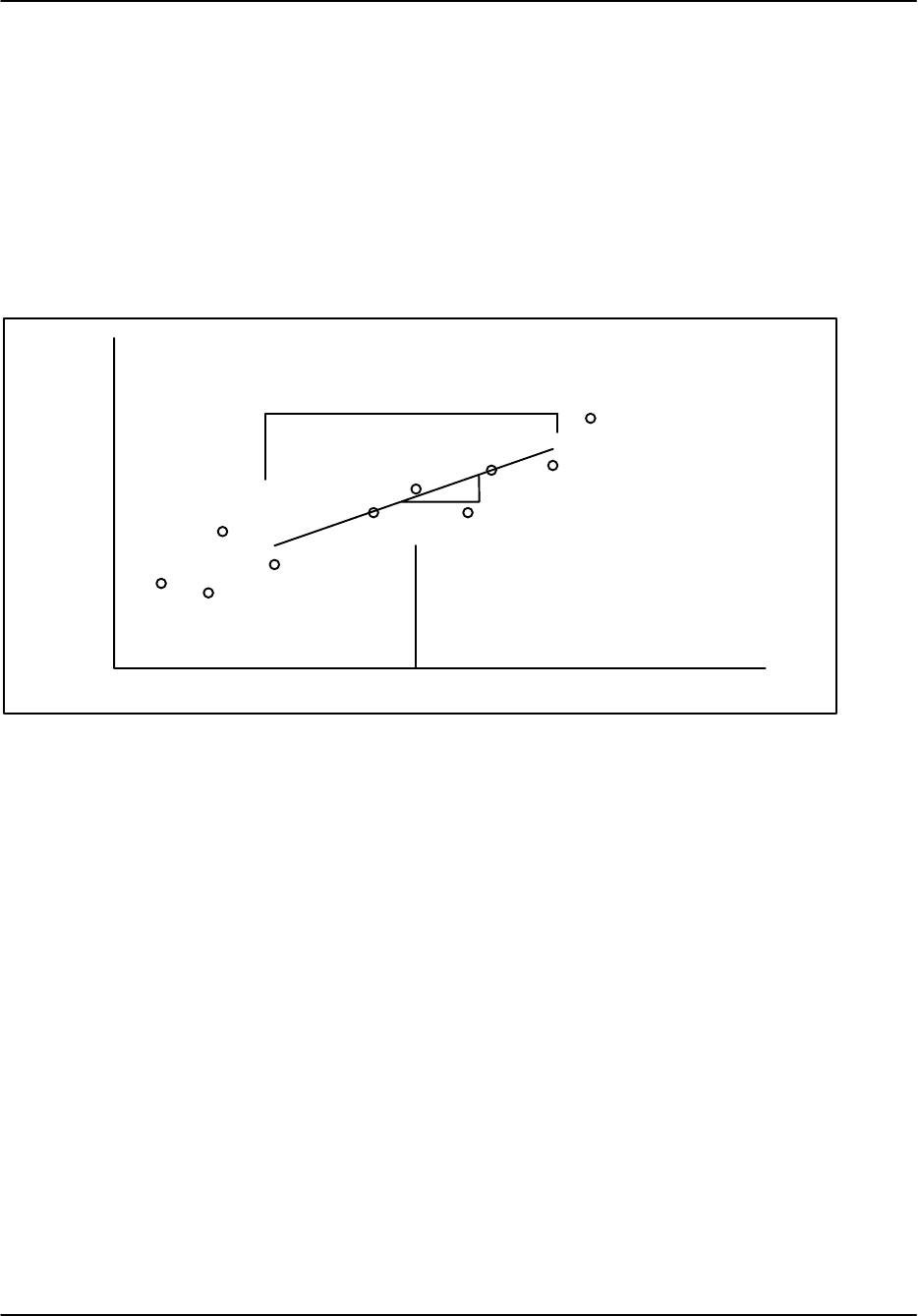
Processing Algorithms (draft)
RVP8 User’s Manual
April 2003
5–49
5.7.10 KDP Calculation
In all modes that compute PHIDP, the signal processor can also be configured to compute KDP-
the specific differential phase in units of degrees per km. This is the range derivative of PHIDP.
There are two techniques that have been used to obtain this:
SThe smoothed range derivative.
SThe slope from a least squares fit.
The RVP8 uses the least squares approach which is shown schematically in the figure below.
Range
ΦDP
Length L
R
KDP(one way)= slope/2
The graph shows the thresholded differential phase vs range. This is the starting point for the
algorithm. The length scale L is selectable by the user in the TTY setups (mp section, KDP
Length in km, default 5.00 km). The KDP value for a bin at range R is computed from a least
squares fit that includes points that are within +–L/2 as indicated in the figure. PHIDP is output
by the processor on the unambiguous interval of 0 to 180 degrees. Before fitting, the points are
first unfolded to a common interval by starting at the left-most point and then moving right
assuming that a difference of more than 1/2 the unambiguous interval is the result of folding.
Since it is the slope that is of interest, the absolute interval is not critical, as long as the points
are in a common interval.
After fitting, the slope is obtained which corresponds to the 2-way KDP since it is based on the
2-way measurement of PHIDP . To be consistent with most values in the literature, the slope
value is divided by 2 so that the final output is the one-way KDP in degrees per km (with a
wavelength scaling in the data format).
This procedure is repeated for each bin. Thus if the bin spacing is 250 m, the output bin spacing
of KDP will be 250 m. It is required that there be at least 50% of the possible number of bins
present in the interval L to calculate a valid KDP, else the KDP is set to the threshold value.
Since the input PHIDP values are already thresholded, the only additional threshold on KDP is
this 50% rule.

Processing Algorithms (draft)
RVP8 User’s Manual
April 2003
5–50
5.7.11 Standard Moment Calculations (T, Z, V, W)
Overview
Standard moments are available for all four of the polarization cases. Since there can be up to
four different channels of time series input, there are several choices for computing the standard
moments. For example, in the STAR mode (Case 2), the standard moments can be computed
from:
Sshh samples
Ssvv samples
SAverage of the results from the shh and svv samples
The third case is handled by averaging the individual channel correlations, and then using the
average correlations in the standard moment processing. The averaging must take into account
the differential gain of the channels.
The selection of which method to use is made in setup. There are four questions posed in the mp
section:
T/Z/V/W computed from: H–Xmt:YES V–Xmt:YES
T/Z/V/W computed from: Co–Rcv:YES Cx–Rcv:NO
The first two questions are used to specify that given a choice between vertical and horizontal
transmit, which transmit polarization to use. Thus for the fixed H or V case where there is only
one transmit polarization, this question does not apply. The processor will simply use samples
for the polarization is transmitted.
The second two questions are used to specify that given a choice between using the co- or
cross-polar receivers which one shall be used. This question applies only to systems that can
measure LDR, i.e., fixed or alternating transmit, dual-channel receiver systems).
The tables in the sections below summarize the standard moment calculations for each of the
four modes and how to configure the four TTY setup responses. Note that these are the only
supported modes. Some combinations of responses are unsupported. For example, it is not
supported to answer both Co-Rcv: NO and Cx-Rcv: NO.
The top of each table identifies the transmitter/receiver case and what samples are available. The
notation HH signifies that the shh samples are available. The tables use “–––” to indicate that
either a YES or NO response will cause the same result, i.e., the RVP does not care what
response is made. In cases where averaging is performed, the type of weighting used is indicated
(either GDR or XDR weighting).

Processing Algorithms (draft)
RVP8 User’s Manual
April 2003
5–51
Model for standard moment autocorrelations
The model for the moment autocorrelation calculations is as follows (using Ro as an example):
Rhh
0Ą+Ągr
hĄgt
hĄShh )NhRvh
0Ą+Ągr
vĄgt
hĄSvh )Nv
Rvv
0Ą+Ągr
vĄgt
vĄSvv )NvRhv
0Ą+Ągr
hĄgt
vĄShv )Nh
where:
Rhh
0,Ą Rvh
0,Ą Rvv
0,Ą Rhv
0Are the autocorrelations if the samples at lag zero.
Shh,Ą Svh,Ą Svv,Ą Shv The average power returned from the scatterers.
gr
h,Ą gr
vReceiver gains for horizontal and vertical receive.
gt
h,Ą gt
vTransmitter gains for horizontal and vertical transmit.
Nh,Ą NvMeasured noise power of the samples.
In other words, the power that is measured in a channel has two components:
SBackscattered power from the targets that is effected by the transmitter and
receiver channel gains.
SReceiver noise which is measured by the RVP8 during noise sampling.
In the case of R1 and R2 autocorrelations, the model is similar except that there is no noise bias.
Calibration Parameters
For dBZ calculations, a calibration constant is required, i.e., the dBZo value in Section 5.4.
Depending on the polarization case and the technique selected for standard moment calculation,
it may also be required to have GDR and XDR, i.e.,
SGDR- The ratio of the total gains (transmit/receive) of the two co–receive
channels.
SXDR- The ratio of the receiver gains in a dual receiver system. This is not
required for the Case 2: STAR or the Case 3: Alternating Single–Channel.
The RVP8 supports a single calibration reflectivity dBZo. In all cases it is assumed that the dBZo
is for the horizontal co–receive (HH) channel. The only exception is for fixed vertical
polarization, in which the algorithm assumes that the calibration is for the vertical co-receive
(VV) channel. XDR and GDR are also downloaded and used to adjust the dBZo as required
depending on the user’s selection for the standard moments. For example, in STAR mode, if the
user selects dBZ to be computed from the VV channel, the dBZo for the HH and a GDR
adjustment are used to calculate the dBZ in the VV channel.
The remainder of this section discusses the standard moment calculation options for the each
polarization case. For a discussion of how to calibrate XDR and GDR see Section 5.7.13.

Processing Algorithms (draft)
RVP8 User’s Manual
April 2003
5–52
Case 1H: Fixed Horizontal Transmit, Dual Channel ReceiveĆ (HH, VH)
dBZo from HH Channel TTY Setup Question Responses
Calculate T, Z, V, W from: H–Xmt V–Xmt Co–Rcv Cx–Rcv
HH (co) (Recommended) ––– ––– YES NO
VH (xdr–1 weighting) ––– ––– NO YES
HH+VH (xdr–1 weighting) ––– ––– YES YES
HH Channel (co–pol)
This is the recommended channel for the case of linear polarization. The reason is that for linear
polarization, the co–polar channel will have the strongest signal. Processing is identical to a
conventional radar.
VH Channel (cross–pol)
This choice would be used for circular or elliptic transmit polarization. Since the algorithm
assumes that dBZo is from the co–polar channel, xdr is used to adjust the autocorrelations as
follows:
T0Ą+Ąxdr*1ĄTvh
o
R0Ą+Ąxdr*1ĄRvh
o
R1Ą+Ąxdr*1ĄRvh
1
R2Ą+Ąxdr*1ĄRvh
2
NĄ+Ąxdr*1ĄNv
These adjusted autocorrelations are then used as per the standard moment processing for a
conventional radar. To illustrate this, consider the example of reflectivity processing. The radar
equation can be written as (see section 5.2.5):
Zvh +CS
vh r2+ƪCr2
0Nv
gr
vgt
hƫƪr2
r2
oƫƪTvh
o*Nv
Nvƫ, where Tvh
0+gr
vgt
hSvh *Nv
+ƪCr2
0Nh
gr
hgt
hƫƪr2
r2
oƫƪgr
h
gr
vƫƪTvh
o*Nv
Nhƫ
The third term is simply 1/XDR so that we can write:
Zvh +ƪCr2
0Nh
gr
hgt
hƫƪr2
r2
oƫƪxdr*1Tvh
o*xdr*1Nv
Nhƫ
In this case, the first term is the dBZo for the HH channel. Thus we can use the dBZo for the HH
channel to calibrate the cross-channel, if we first adjust the cross–channel noise and power by
1/XDR and then normalize by Nh. The reflectivity calculation assumes that the calibrated XDR
value compensates for any differences in the radar constant between the two channels, i.e., we do
not need to have separate radar constants for the two channels.

Processing Algorithms (draft)
RVP8 User’s Manual
April 2003
5–53
HH+VH Channels
This choice would be used for elliptic transmit polarizations that give comparable return signal
in both the co- and cross-channels. The approach is to obtain average autocorrelation functions
as follows:
T0Ą+ĄThh
o)xdr*1ĄTvh
o
2
R0Ą+ĄRhh
o)xdr*1ĄRvh
o
2
R1Ą+ĄRhh
1)xdr*1ĄRvh
1
2
R2Ą+ĄRhh
2)xdr*1ĄRvh
2
2
NĄ+ĄNh)xdr*1ĄNv
2
These adjusted autocorrelations are then used as per the standard moment processing for
calibration with respect to the HH channel.

Processing Algorithms (draft)
RVP8 User’s Manual
April 2003
5–54
Case 1V: Fixed Vertical Transmit and Dual Channel ReceiveĆ (VV, HV)
dBZo from VV Channel TTY Setup Question Responses
Calculate T, Z, V, W from: H–Xmt V–Xmt Co–Rcv Cx–Rcv
VV (co) ––– ––– YES NO
HV (xdr weighting) ––– ––– NO YES
VV+HV (xdr weighting) ––– ––– YES YES
This is the only case for which the calibration constant dBZo for the VV channel should be
downloaded to the signal processor.
VV Channel (co–pol)
This is the recommended channel for the case of linear polarization. The reason is that for linear
polarization, the co-polar channel will have the strongest signal. Processing is identical to a
conventional radar.
HV Channel (cross–pol)
This choice would be used for circular or elliptic transmit polarization when most of the return is
in the cross-pol channel. Since the algorithm assumes that dBZo is from the co-polar channel,
xdr is used to adjust the autocorrelations as follows:
T0Ą+ĄxdrĄThv
o
R0Ą+ĄxdrĄRhv
o
R1Ą+ĄxdrĄRhv
1
R2Ą+ĄxdrĄRhv
2
NĄ+ĄxdrĄNh
These adjusted autocorrelations are then used as per the standard moment processing with dBZo
calibrated with respect to the VV channel.

Processing Algorithms (draft)
RVP8 User’s Manual
April 2003
5–55
VV+HV Channels
This choice would be used for elliptic transmit polarizations that give comparable return signal
in both the co- and cross-channels. The approach is to obtain average autocorrelation functions
as follows:
T0Ą+ĄTvv
o)xdrĄThv
o
2
R0Ą+ĄRvv
o)xdrĄRhv
o
2
R1Ą+ĄRvv
1)xdrĄRhv
1
2
R2Ą+ĄRvv
2)xdrĄRhv
2
2
NĄ+ĄNv)xdrĄNh
2
These adjusted autocorrelations are then used as input to the standard moment processing
algorithms with dBZo calibrated with respect to the VV channel.

Processing Algorithms (draft)
RVP8 User’s Manual
April 2003
5–56
Case 2: Simultaneous Transmit and ReceiveĆ STAR (HH, VV)
Case 3: Alternating Transmit SingleĆChannel Receive (HH, VV)
dBZo from HH Channel TTY Setup Question Responses
Calculate T, Z, V, W from: H–Xmt V–Xmt Co–Rcv Cx–Rcv
HH YES NO ––– –––
VV (gdr–1 weighting) NO YES ––– –––
HH+VV (gdr–1 weighting) YES YES ––– –––
A fundamental difference between these two cases is that for all standard moment processing
choices, the STAR case has double the number of samples as compared to the single-channel
alternating case. However, the processing is otherwise identical.
HH Channel
Since the HH channel is directly calibrated this is the recommended choice. Processing is
identical to a conventional radar.
VV Channel
In this case, GDR is used to adjust the autocorrelations as follows:
T0Ą+Ągdr*1ĄTvv
o
R0Ą+Ągdr*1ĄRvv
o
R1Ą+Ągdr*1ĄRvv
1
R2Ą+Ągdr*1ĄRvv
2
NĄ+Ągdr*1ĄNv
These adjusted autocorrelations are then used as input to the standard moment processing
algorithms with dBZo calibrated with respect to the HH channel.

Processing Algorithms (draft)
RVP8 User’s Manual
April 2003
5–57
HH+VV Channels
This approach gives the benefit of doubling the number of samples used for the reflectivity
calculation.
T0Ą+ĄThh
o)gdr*1ĄTvv
o
2
R0Ą+ĄRhh
o)gdr*1ĄRvv
o
2
R1Ą+ĄRhh
1)gdr*1ĄRvv
1
2
R2Ą+ĄRhh
2)gdr*1ĄRvv
2
2
NĄ+ĄNh)gdr*1ĄNv
2
These adjusted autocorrelations are then used as input to the standard moment processing
algorithms with dBZo calibrated with respect to the HH channel.
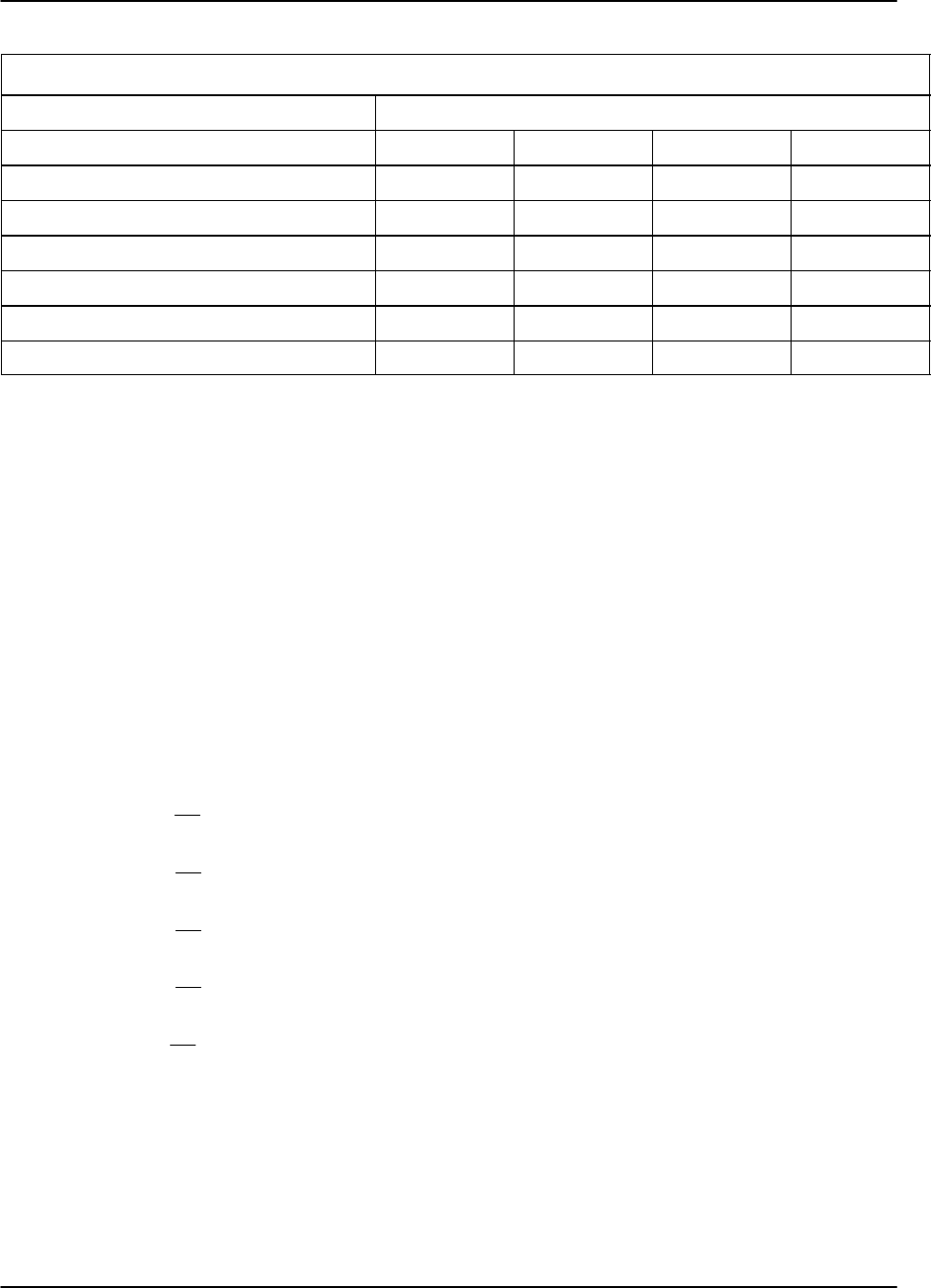
Processing Algorithms (draft)
RVP8 User’s Manual
April 2003
5–58
Case 4: Alternating DualĆChannel (HH, VH, VV, HV)
dBZo from HH Channel TTY Setup Question Responses
Calculate T, Z, V, W from: H–Xmt V–Xmt Co–Rcv Cx–Rcv
HH YES NO YES NO
VH (xdr–1 weighting) YES NO NO YES
VV (gdr–1 weighting) NO YES YES NO
HV (xdr/gdr weighting) NO YES NO YES
HH+VV (gdr–1 weighting) YES YES YES NO
HV+VH (xdr & gdr weighting) YES YES NO YES
HH Channel
Since the HH channel is directly calibrated this is the recommended choice. Processing is
identical to a conventional radar.
VH Channel
Processing is identical to Case 1H: Horizontal Transmit HV Processing.
VV Channel
Processing is identical to Cases 2&3:STAR and Single Channel Alternating VV Processing.
HV Channel
The weighting in this case uses both xdr and GDR.
T0Ą+Ąxdr
gdrĄThv
o
R0Ą+Ąxdr
gdrĄRhv
o
R1Ą+Ąxdr
gdrĄRhv
1
R2Ą+Ąxdr
gdrĄRhv
2
NĄ+Ąxdr
gdrĄNh
These adjusted autocorrelations are then used as input to the standard moment processing
algorithms with dBZo calibrated with respect to the HH channel.
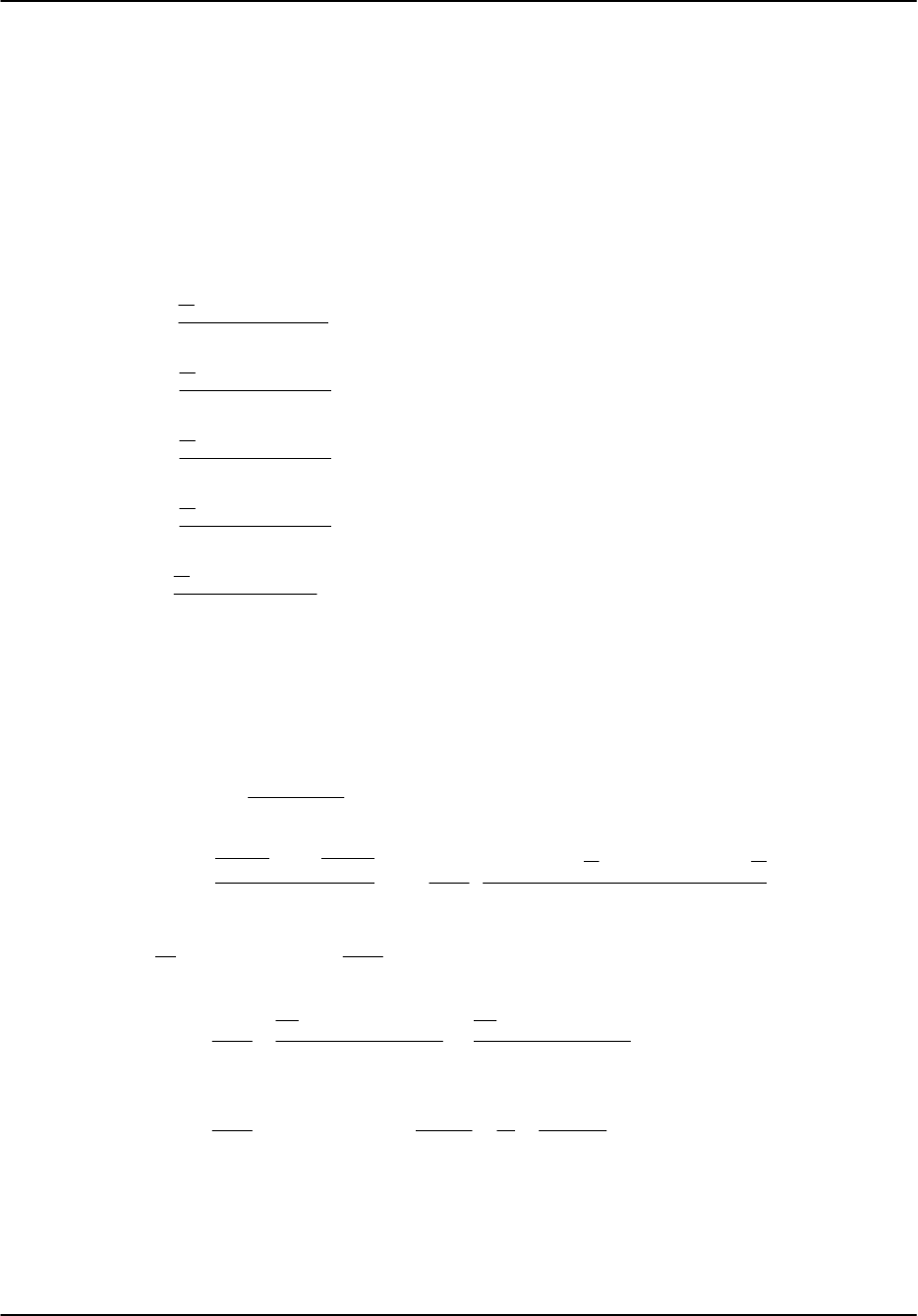
Processing Algorithms (draft)
RVP8 User’s Manual
April 2003
5–59
HH + VV Channels
Processing is identical to Cases 2&3: STAR and Single Channel Alternating HH+VV
Processing.
HV + VH Processing
The weighting here has to correct for both transmitter and receiver effects in order to use the HH
channel dBZo.
T0Ą+Ą
xdr
gdr Thv
o)xdr*1ĄTvh
o
2
R0Ą+Ą
xdr
gdr Rhv
o)xdr*1ĄRvh
o
2
R1Ą+Ą
xdr
gdr Rhv
1)xdr*1ĄRvh
1
2
R2Ą+Ą
xdr
gdr Rhv
2)xdr*1ĄRvh
2
2
NĄ+Ą
xdr
gdr Nh)xdr*1ĄNv
2
These adjusted autocorrelations are then used as input to the standard moment processing
algorithms with dBZo calibrated with respect to the HH channel.
An example of how this weighted averaging works is given here. Suppose that we want to
compute the average of the reflectivities for the VH and HV channels,
Zhv)vh +Cr2Shv )Svh
2
+Cr2
Thv
0*Nh
gr
hgt
v)Tvh
o*Nv
gr
vgt
h
2+Cr2
gr
hgt
h
(Thv
0*Nh)gt
h
gt
v)(Tvh
o*Nv)gr
h
gr
v
2
but since xdr +gr
v
gh
vand gdr +gr
vgt
v
gr
hgt
h
Zvh)hv +Cr2
gr
hgt
hȧ
ȱ
Ȳ
xdr
gdr Thv
0)xdr*1Tvh
0
2*
xdr
gdr Nh)xdr*1Nv
2ȧ
ȳ
ȴ
Zvh)hv +Cr2
gr
hgt
hƪT0*Nƫ+ƪCr2
oNh
gr
hgt
hƫƪr2
r2
oƫƪT0*N
Nhƫ
The first term in brackets is precisely dBZo for the HH channel. Thus if we average the
correlations using the appropriate GDR and xdr weighting as shown above, then the average
reflectivity is obtained by using conventional processing with the HH channel dBZo.

Processing Algorithms (draft)
RVP8 User’s Manual
April 2003
5–60
5.7.12 Thresholding of Polarization Parameters
The thresholding of polarization parameters by the processor eliminates bins with weak or
uncertain signals. Note that the thresholding can be disabled if it is desired to see all of the data
regardless of the data quality.
All of the polarization parameters are based on power ratios. The RVP8 requires that each power
term in a ratio pass a signal-to-noise test similar to the log power test. For example, there are up
to four different powers that can be calculated (alternating dual-channel case) so the tests for
each of these are:
t|shh|2u
Nh
ĄuĄNthresh
t|shv|2u
Nh
ĄuĄNthresh
t|svv|2u
Nv
ĄuĄNthresh
t|svh|2u
Nh
ĄuĄNthresh
where the linearized threshold that is input as the dB LOG threshold, i.e.,
NthreshĄ+Ą10
LOGthreshń10
For example, a valid LDRH requires both a valid Shh and a valid Svh. The parameters RHOH
and PHIH have the same requirement since they are the magnitude and phase of the
cross-correlation function which is based on Shh and Svh.
There are two exceptions:
ZDR
ZDR requires that both Shh and Svv pass the signal-to-noise tests noted above. However,
ZDR can be additionally thresholded by any of the other threshold parameters (LOG, SIG,
SQI, CSR) similar to a standard moment. See section 5.3 for a description of the standard
moment thresholding.
PHIDP for single channel alternating case
PHIDP requires that both Shh and Svv pass the signal-to-noise tests noted above. In the single
channel alternating case, PHIDP must also satisfy the additional test that the Doppler veloc-
ity at the range bin must be valid, i.e., not thresholded by its own criteria. This is because
the algorithm for PHIDP in this case essentially subtracts the phase change due to the Dop-
pler velocity. If the Doppler velocity is uncertain, the algorithm cannot produce reliable re-
sults.

Processing Algorithms (draft)
RVP8 User’s Manual
April 2003
5–61
5.7.13 Calibration Considerations
Polarization systems require additional calibration as compared to conventional systems. There
are three aspects to the calibration:
SdBZo measurement in both channels for dBZ and dBT calibration.
SGDR measurement for ZDR calibration.
Sxdr measurement for LDR calibration.
These are discussed below.
dBZoCalibration for dBZ
The RVP8 supports separate calibration of both polarization channels. Measurement of dBZofor
each channel of a dual polarization system is identical to the conventional radar case described
in Section 5.4. Note that for a single-channel switching system, the only difference between the
horizontal and vertical signal paths occurs after the high power switch, i.e., differential insertion
loss of the switch itself and any differential insertion loss of the waveguides and feed after the
switch. This means that for single-channel switching systems it may be sufficient to calibrate at
one polarization and then adjust the calibration of the other channel by the differential gain GDR
(see below).
GDR Calibration for ZDR
GDR is the relative between the co-polarized channels including both transmitter and receiver
gain, i.e.,
GDRĄ+Ą 10ĄLOGĄgr
vgt
v
gr
hgt
h
and gdrĄ+Ągr
vgt
v
gr
hgt
h
GDR is input into the processor as a dB value. However, for analyses in this chapter, the linear
gdr value is sometimes more convenient.
In principle, if dBZo could be calibrated perfectly in both channels, measurement of GDR would
not be required. In practice, this is not possible because dBZo cannot be calibrated to an absolute
accuracy sufficient for ZDR, i.e., to 1/16th of a dB. Therefore, the RVP8 uses the GDR
approach.
Since GDR includes both transmitter and receiver differential gains, accurate calibration requires
that an actual target be observed. One way to do this is as follows:
SSet the GDR to be 0 dB using your application software (e.g., for SIGMET IRIS
systems in the setup utility RVP section). Disable clutter filtering for ZDR in
either your application software (by selecting filter 0) or explicitly in the RVP8
TTY setups mp section.
SPlace the antenna at 90 degrees elevation (vertical incidence) during moderate to
heavy rain. The melting layer should be at a height that is well above the recovery
zone of the T/R and in the antenna “far zone”. A melting layer higher than 2 km
is suggested, but the specific characteristics of the radar should be considered.

Processing Algorithms (draft)
RVP8 User’s Manual
April 2003
5–62
SCollect ZDR data at vertical incidence while the antenna is rotating in azimuth.
SUse a separate application program to average the ZDR values around a full 360
degrees at each range bin (height). Generate a plot of 360-average ZDR vs height.
SYou should observe that the average ZDR values in regions of strong signal (>20
dB SNR) below the bright band are approximately constant with height. This is
the value that should be used in your application software for GDR.
SEnter the value and repeat the calibration to verify that the average ZDR is now 0
dB.
The rationale for this approach is as follows. When viewed at vertical incidence, rain should
have a ZDR of 0 dB since the drops will all appear circular. The reason for averaging over 360
degrees is to cancel-out effects from sidelobe contamination from nearby ground targets and
other artifacts of the antenna/feed/radome system. For example the radome may have an
obstruction light on the top. Some of these artifacts can be minimized by assuring the the
weather targets are strong, i.e., heavy rain is preferred for this calibration.
XDR Calibration for LDR
XDR is the relative gain in dB between the co- and cross-receiver channels for LDR
measurements. Analogous to GDR, it is defined as the dB value of the ratio of the vertical to
horizontal receiver gains, i.e.,
XDRĄ+Ą 10ĄLOGĄgr
v
gr
h
and xdrĄ+Ągr
v
gr
h
Three techniques for calibration of XDR are discussed. It is recommended for the transmitter to
be off for all of these methods.
S1. Solar method
Use the sun to measure LDR. The measured value of LDR is then the XDR offset.
LDR should be measured in fixed mode for both LDRH and LDRV. The values
should be reciprocal (e.g., +1 dB and –1 dB). Use the average of the absolute
value if they are not precisely reciprocal (e.g., for +1.4 and –1.2 use 1.3). Finally
after inputting the XDR value, retest to verify that the sun has been properly
corrected to have zero LDR.
S2. Signal generator method with connection to waveguide
Connect a signal generator with a splitter to both channels and measure XDR
directly. This does not account for any effects that are before the coupler (e.g.,
waveguide, feed, radome, antenna gain).
S3. Linear feed horn remote radiator method
Use a calibrated linear feed horn with an RF source located several hundred
meters from the radar. Maximize the H channel return and measure the response
using the RVP8 pr command “Filtered” power in the “Primary Channel”. Now
rotate the feed horn to vertical and maximize the power in the “Secondary
Channel”. The difference in dB is XDR. Note that signal multi–path effects could
bias the results from this technique.

Processing Algorithms (draft)
RVP8 User’s Manual
April 2003
5–63
In all cases it is recommended that for the calibration, XDR be set to 0 dB in the application user
software and that the RVP8 TTY setups be configured as follows:
SNoise correction enabled for LDR and noise sample taken prior to the
measurements (with care not to sample with a test signal turned–on or while
looking at the sun).
SClutter correction disabled for LDR.
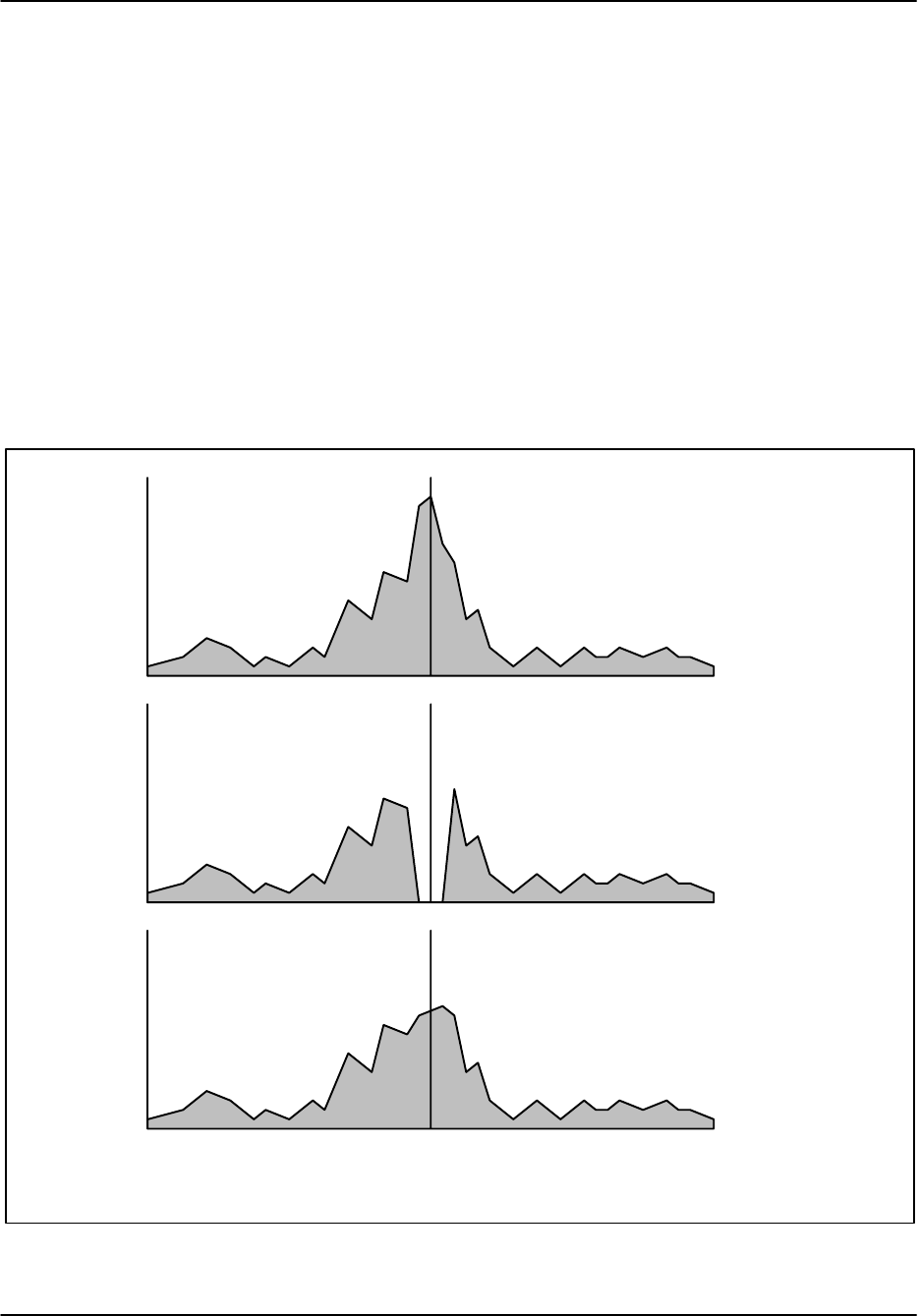
Processing Algorithms (draft)
RVP8 User’s Manual
April 2003
5–64
5.8 FFT Mode
5.8.1 Overview
The RVP8 can perform FFT processing of the I and Q time series. This is indicated by the inset
box in Figure 5–1. The major difference between FFT and pulse pair processing is the way in
which clutter filtering is performed. The pulse pair mode uses a time domain IIR filter while the
FFT mode uses a frequency domain filter. The advantage of the FFT approach is that it is less
destructive to overlapped weather (near zero velocity) than the IIR filter since the clutter filter
algorithm attempts to interpolate over the weather (see Figure 5–8). This results in more accurate
estimates of velocity, width and clutter correction. Because the clutter correction is more
accurate, the resulting reflectivity estimates are more accurate.
Figure 5–8: Comparison of Pulse Pair and FFT Clutter Filters
Unfiltered Doppler Spectrum
Pulse Pair Mode
Spectrum after IIR filter
FFT Mode
Spectrum after frequency domain filtering
with interpolation
0+Vu-Vu
Velocity
Power

Processing Algorithms (draft)
RVP8 User’s Manual
April 2003
5–65
5.8.2 FFT Implementation
Figure 5–9 shows a data flow diagram for the FFT processing. In the example, 50 pulses of I
and Q are processed. Recall that the I and Q samples refer to a single range bin with an I and Q
sample generated for each pulse.
Sampling Division
The first step of processing is to split the I and Q values into two groups. The FFT algorithm
requires the number of samples to be a power of two. This is not very convenient for radar
sampling since it effectively quantizes the scan rates to be powers of two. The processing by the
RVP8 allows an arbitrary number of pulses to be handled by splitting the samples into two
groups — the first 2N and last 2N pulses. An FFT is performed on each group and then the
results are averaged. This allows an arbitrary number of samples to be processed. The maximum
number of samples is 255 which corresponds to performing FFT’s on two groups of 128 pulses
with 1 sample of overlap.
If the requested number of pulses is exactly a power of 2, then the samples are not split and only
a single FFT is done.
Window and FFT
After splitting the samples, a weighting function, or window, is applied. The FFT algorithm is
then applied and the magnitude squared of each component is calculated to yield the Doppler
power spectrum. Figure 5–10 shows the response of the Doppler power spectrum to a ground
clutter target for each of the three available FFT windows. The schematic Doppler spectra in the
example do not show the details of the side lobe structure of the impulse response (see
Oppenheim and Schafer, 1975 p. 243–245).
SRectangular Window — This is really the no-window case since it is equivalent
to multiplying each sample by 1. This window has a sinx/x type impulse
response, i.e., the impulse response is very narrow which is good, but the side
lobes of the Doppler spectrum are rather high — ~20 dB near the peak. Thus it is
not the best choice for high performance clutter cancelation since the high
sidelobes will mask weak weather targets.
SHamming Window — This common window is well matched to magnetron
systems. The peak of the impulse response is broader than that for the rectangular
window, but it has –40 dB peak-to-noise sidelobes. Weak weather targets above
this level will not be obscured by these sidelobes. The phase noise of a magnetron
system (~1 degree) will typically be slightly larger than the sidelobes caused by
the window which means that the window is well matched to the magnetron
performance.
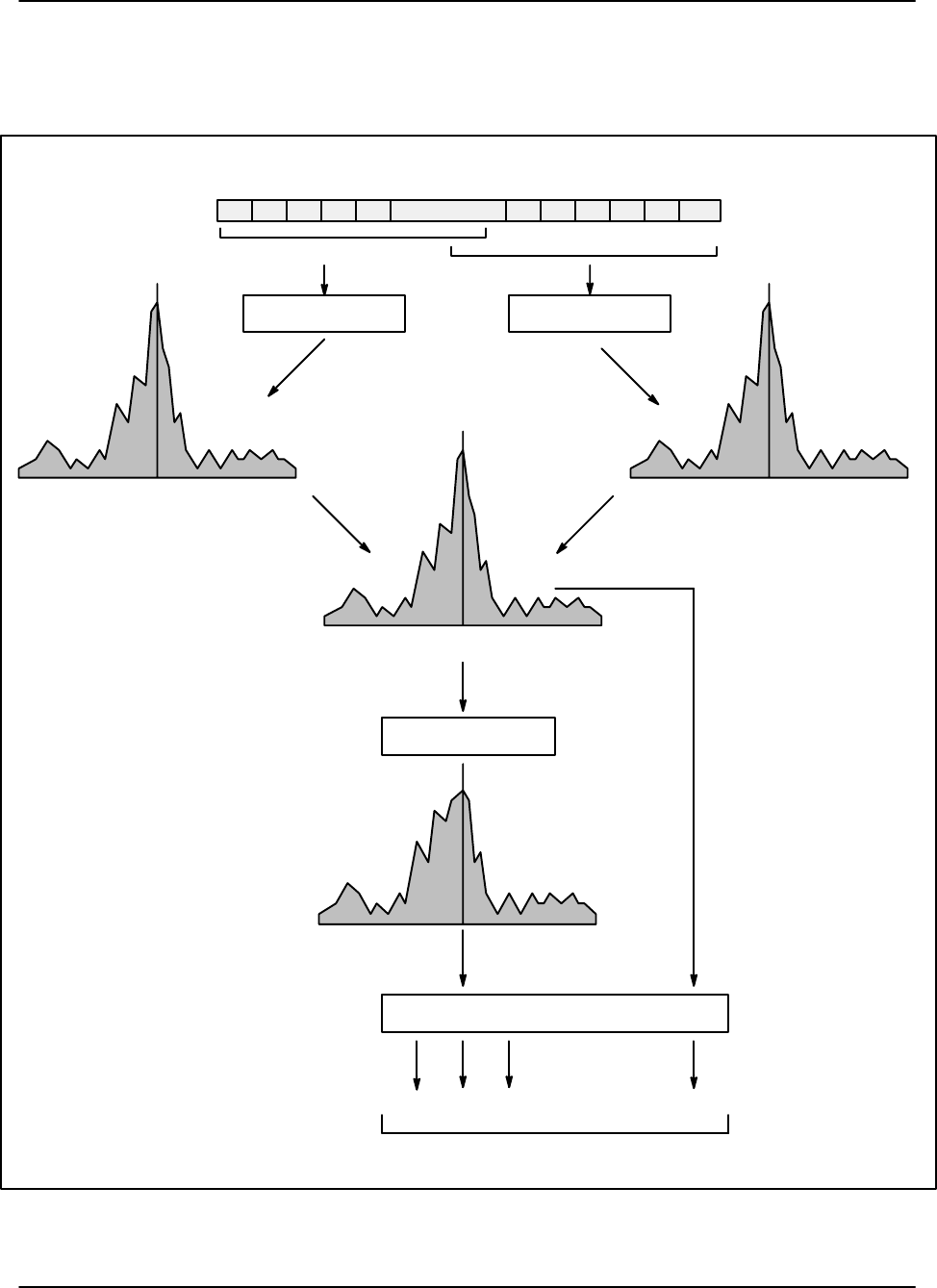
Processing Algorithms (draft)
RVP8 User’s Manual
April 2003
5–66
Figure 5–9: FFT Processing — 50 pulse example
Example of 50 pulse input time series where An = In + j Qn
A1A2A3A4A5... A45 A46 A47 A48 A49 A50
32 point
FFT
32 point
FFT
Average 32Ćpoint Spectrum
1st. 32 samples Last 32 samples
Clutter Cancelation
Inverse Transform
R0R1R2T0
Standard Processing
Window and FFT Window and FFT
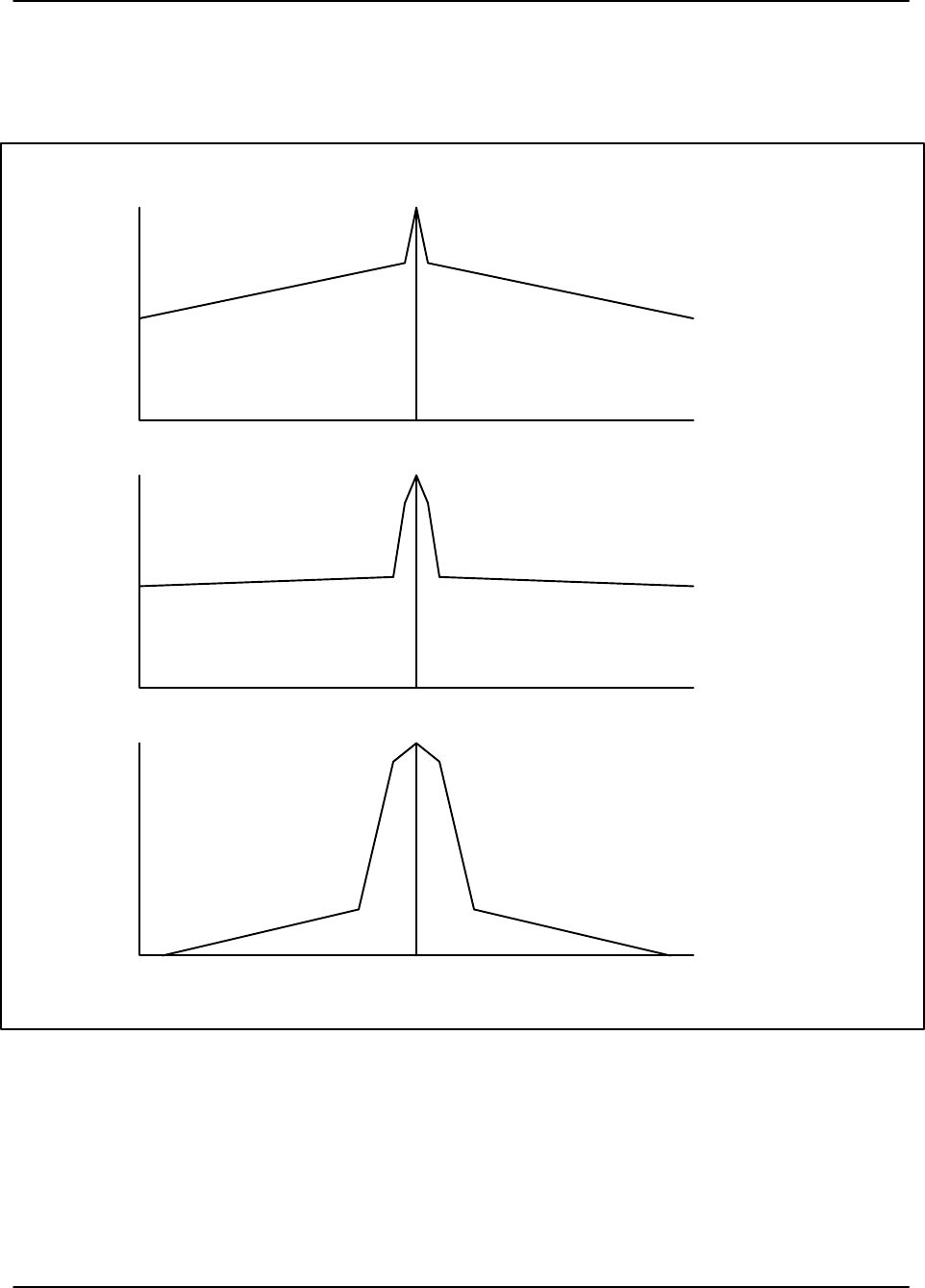
Processing Algorithms (draft)
RVP8 User’s Manual
April 2003
5–67
Figure 5–10: Effect of Windowing on FFT Response to Ground Clutter
Rectangular Window
-20
-40
-60
-80
0
dB Power
Hamming Window
-20
-40
-60
-80
0
dB Power
Blackman Window
-20
-40
-60
-80
0
dB Power
Velocity
0+Vu-Vu
SBlackman Window — This is the most aggressive window for clutter
cancelation and is appropriate only for Klystron systems that can achieve very
low phase noise (~0.1 degree). The peak is the broadest of all the windows, but
the side lobes are the lowest. It is not recommended for magnetron systems
except for performance testing.
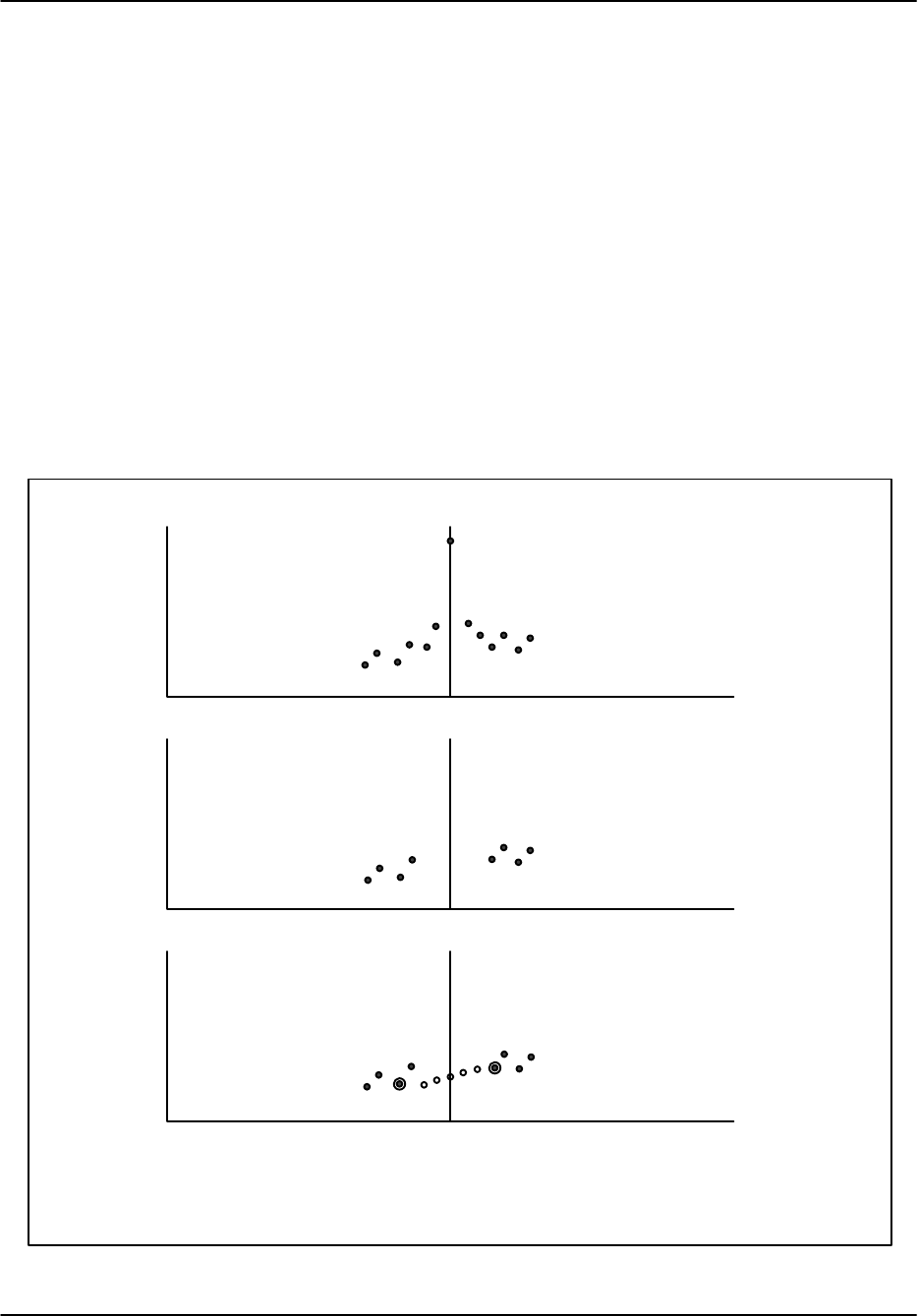
Processing Algorithms (draft)
RVP8 User’s Manual
April 2003
5–68
FFT Averaging
The power spectrum from the first group of samples is averaged with the power spectrum from
the last group of samples. Note that if the total number of samples is exactly a power of two,
then this step is skipped. Averaging the two power spectra from the overlapping sample groups
effectively captures the information from all of the samples. The result is a smoother power
spectrum than weather of the individual spectra.
Clutter Cancellation
The clutter cancelation is done by an interpolation technique shown in Figure 5–11. In general,
the technique discards a selectable number of center points. The algorithm then takes the
minimum value of a selectable number of edge points next to the discarded points. The
minimum value on each side is used to interpolate across the points that were removed.
Figure 5–11: Example of FFT Clutter Filter in Frequency Domain
Spectrum with ground clutter
-20
-40
-60
0
dB Power
Velocity
0+Vu-Vu
Remove 5 interior points
-20
-40
-60
0
dB Power
Find minimum of 2 edge points
Interpolate across 5 center points
-20
-40
-60
0
dB Power

Processing Algorithms (draft)
RVP8 User’s Manual
April 2003
5–69
This procedure preserves the noise level and/or overlapped weather targets. The result is that
more accurate estimates of dBZ are obtained. In extreme cases when the weather spectrum is
very narrow, there can still be some attenuation of weather of a broad filter is selected.
Inverse Transform
After clutter removal, an inverse DFT (Discrete Fourier Transform) is performed to obtain the
autocorrelations R0, R1 and R2 (optional). The total power T0 in the unfiltered power spectrum
is also computed by summing the spectrum components. Thus the final output of the FFT
approach is identical to the pulse pair approach except that the clutter filtering is performed in
the frequency domain.

Processing Algorithms (draft)
RVP8 User’s Manual
April 2003
5–70
5.9 Random Phase 2nd Trip Processing
5.9.1 Overview
Second trip echoes can be a serious problem for applications when the radar is operated at high
PRF (e.g., >500 Hz). Second trip echoes are caused by the range aliasing of targets. They appear
as false echoes on the display, usually elongated in the radial direction. On Klystron systems
they will have valid Doppler velocities. On magnetron systems, the Doppler velocities are not
valid, but the noise from the 2nd trip echoes can obscure valid first trip velocity information.
The RVP8 has optional random phase processing for the filtering and recovery of second trip
echoes. Details of the technique are proprietary to SIGMET, Inc. However, the general principle
is described here, along with a discussion of the various configuration options to optimize the
algorithm performance.
The information that is used to separate the first and second trip echoes is the phase. For a
magnetron radar, the phase of each pulse is different. This means that when 1st. and 2nd trip
echoes are received simultaneously, the phase of the first trip return is different from the phase
of the second trip return. For a magnetron radar, the RVP8 measures the phase of the transmitted
pulse and the phase locking is done digitally as opposed to the traditionally locking COHO. For
a Klystron radar, the phase is controlled by the RVP8 via a digital phase shifter that is precisely
calibrated. Typically the Klystron COHO is phase shifted so that each transmit pulse has a
different phase. The sequencing is controlled by the RVP8.
5.9.2 Algorithm
Figure 5–12 shows a schematic of the data processing for random phase. The figure shows the
Doppler spectra for the 1st. and 2nd trip in the various processing stages. The vertical scale is in
dB and the horizontal scale is velocity. In this example, the second trip echo is shown as being
stronger than the first trip echo (usually the reverse is true).
Ideal 1st and 2nd Trip Echoes
The ideal 1st and 2nd trip echoes represent the echoes as they would appear individually. The
ideal 1st trip echo is the echo that would be measured if there were no 2nd trip echo interference.
The ideal 2nd trip echo represents what would be measured if there were no 1st trip echo
interference. If there is no interference from the other trip, a standard Klystron system can
measure the ideal spectra, but there is no way to know whether the echoes are in the 1st or 2nd
trip.
Raw 1st and 2nd Trip Echoes
This figure shows how the echoes from the first trip and second trip interfere with each other.
For the case of a standard magnetron system, the first trip echo is coherent, while the second trip
echo is incoherent (white noise) since the phase of the second trip echo is random. This is
because the receiver is phase locked only to the first trip.

Processing Algorithms (draft)
RVP8 User’s Manual
April 2003
5–71
Another way to implement a magnetron system is to let the COHO free-run (rather than phase
locking to the transmit pulse), measure the phase of each transmit pulse and digitally correcting
for the transmit phase. Using this digital phase locking technique, the RVP8 can phase lock or
“cohere” to either the first or the second trip.
Using this technique alone, it is possible to distinguish between 1st and 2nd trip echoes for the
case when the echoes are not overlapped. In other words, the echoes will appear as the idealized
1st and 2nd trip echoes. This range de-aliasing effectively doubles the range of the radar. The
problem is that when echoes are overlapped, the noise contamination from the stronger echo will
make it impossible to measure the weaker echo. This is illustrated in the figure. Thus if the first
trip echo has a good signal-to-noise ratio of 10 dB, then the 2nd trip echo will have a signal-to
noise-ratio no better than –10 dB. This is the fundamental problem with using phase alone to
separate the 1st and 2nd trip echoes.
Filtered 1st and 2nd Trip Echoes
Since the strong echo generates noise that obscures the weaker echo, the approach used in the
RVP8 is to filter the echo from the other trip — the whitening filter. This is shown in the figure.
The adaptive whitening filter removes both the clutter and the weather. All of the phase
information for the other trip is then contained in the white noise portion of the spectrum. Note
that the phase information under the coherent echo that is removed will be dominated by the
coherent echo, i.e., the other trip phase information will be contaminated. For this reason, the
filtering should effect as small a region of the spectrum as possible.
5.9.3 Tuning for Optimal Performance
The Random Phase algorithms are controlled by the same collection of setup and operational
parameters that apply to all of the other processing modes, e.g., choice of sample size, clutter
filter, angle sync, calibration, etc. However, a few parameters are special to Random Phase
mode, and these are described below.
Secondary SQI Threshold
In standard Doppler processing, an SQI threshold is normally not applied to Reflectivity data
because it would cause those data to be rejected in regions of high spectral width. In Random
Phase mode we need to relax this convention because reflected power can only be assigned to a
particular trip when it is coherent within that trip. Incoherent echoes, regardless of their
strength, can not be placed into either trip.
Thus, an SQI threshold is required to qualify Reflectivity data in Random Phase mode. The
RVP8 defines a secondary SQI threshold SQI2 which is computed from the standard threshold
value simply as:
SQI2+Offset )(Slope SQI)
Where Slope and Offset are the Random Phase SQI threshold parameters defined in the Mf
setup section. The factory default values are (Slope +0.50) and (Offset +*0.05), i.e., the
secondary threshold is a little less than half of the standard value. The Random Phase

Processing Algorithms (draft)
RVP8 User’s Manual
April 2003
5–72
algorithms check whether the SQI of each recovered trip is less than the secondary SQI
threshold, and if so, the LOG portion of the data are rejected. This SQI test is necessary for a
clean LOG picture, but we need to use a more permissive (lower) threshold value than would
usually be applied to the Doppler data alone.
The Slope and Offset values should be adjusted so that the density of speckles in Random Phase
LOG data is approximately the same as the density of speckles in FFT velocity data for a given
primary SQI value. You may then adjust the primary SQI threshold to achieve the appropriate
tradeoff of speckles vs. sensitivity for your system in all modes of operation. Even with proper
adjustment, it is normal for Random Phase dBZ and dBT data to show “holes” in regions of
weather that have high turbulence or shear. These dropouts will usually match up with similar
gaps in the velocity and width data, both of which are traditionally thresholded by SQI.
Maximum Power Ratio Between Trips
The adaptive filtering that is performed on the data for each trip greatly extends the visibility of
a weak echo that is overlapped with a much stronger one. In practice, the filtering process is
often able to remove 25-35dB of dominant power in order to reveal a much weaker echo in the
other trip. The performance depends on many factors, primarily the spectral width of the
dominant echo, and the overall stability of the radar system.
The difficulties of removing a dominant “other trip” echo from a weather signal are analogous to
the challenge of removing a dominant clutter target from that same signal. In both cases we are
trying to extract a weak weather signature using a filtering procedure that relies on the spectral
confinement of the stronger signal. The RVP8 already has a parameter that can be adjusted to
control sub-clutter visibility, i.e., the Clutter-to-Signal Ratio (CSR). Just as the CSR applies to
the clutter filters, it can likewise be used to place similar limits on the depth of visibility of the
adaptive filters.
As an example, suppose that the RVP8 is operating in Random Phase mode at a PRF of 1500Hz,
and is observing widespread weather having uniform intensity in both the first 100Km trip and
the second 100Km trip. If the CSR were set too conservatively at only 15dB, then the algorithm
would generally be blind to second-trip weather in the range interval from 100km to 117.8km.
The explanation for this can be found in the 1ńr2 geometric correction for weather echo
intensity. At ranges less than 17.8km, the first trip weather would generally dominate the second
trip weather by more than 15dB. Thus, the initial 17.8km ring of second trip data would be
rejected by the CSR criteria. However, if the CSR were increased to 30dB, then the size of this
missing ring would be reduced to only 3.2km.
If the CSR is set too low you will notice an abrupt ring of missing data in the beginning of the
second trip. If set too high, there will be speckles and other spurious effects within this same
interval. The optimum setting should strike a balance between these two effects.
R1 vs. R2 Algorithms
The Random Phase algorithms for adaptive filtering and separation of trips relies on having the
best possible information about the weather’s SNR and spectral width. Thus, the “R2” Doppler
algorithms are always used, regardless of the setting of the R1/R2 flag in the user’s operational
parameters.

Processing Algorithms (draft)
RVP8 User’s Manual
April 2003
5–73
Random Phase and Dual PRF
The random phase processing works seamlessly with the dual PRF processing to provide
advanced range and velocity ambiguity resolution. Both the first and 2nd trip echoes can be
recovered and displayed to a maximum range of 2X the unambiguous range corresponding to the
high PRF.
For optimum performance, the 2D 3x3 speckle filter should be used to smooth the 2nd trip
seams that occur for each ray. In fact, this smoothing of the 2nd trip seam makes the dual PRF
random phase mode work even better than the single PRF random phase.
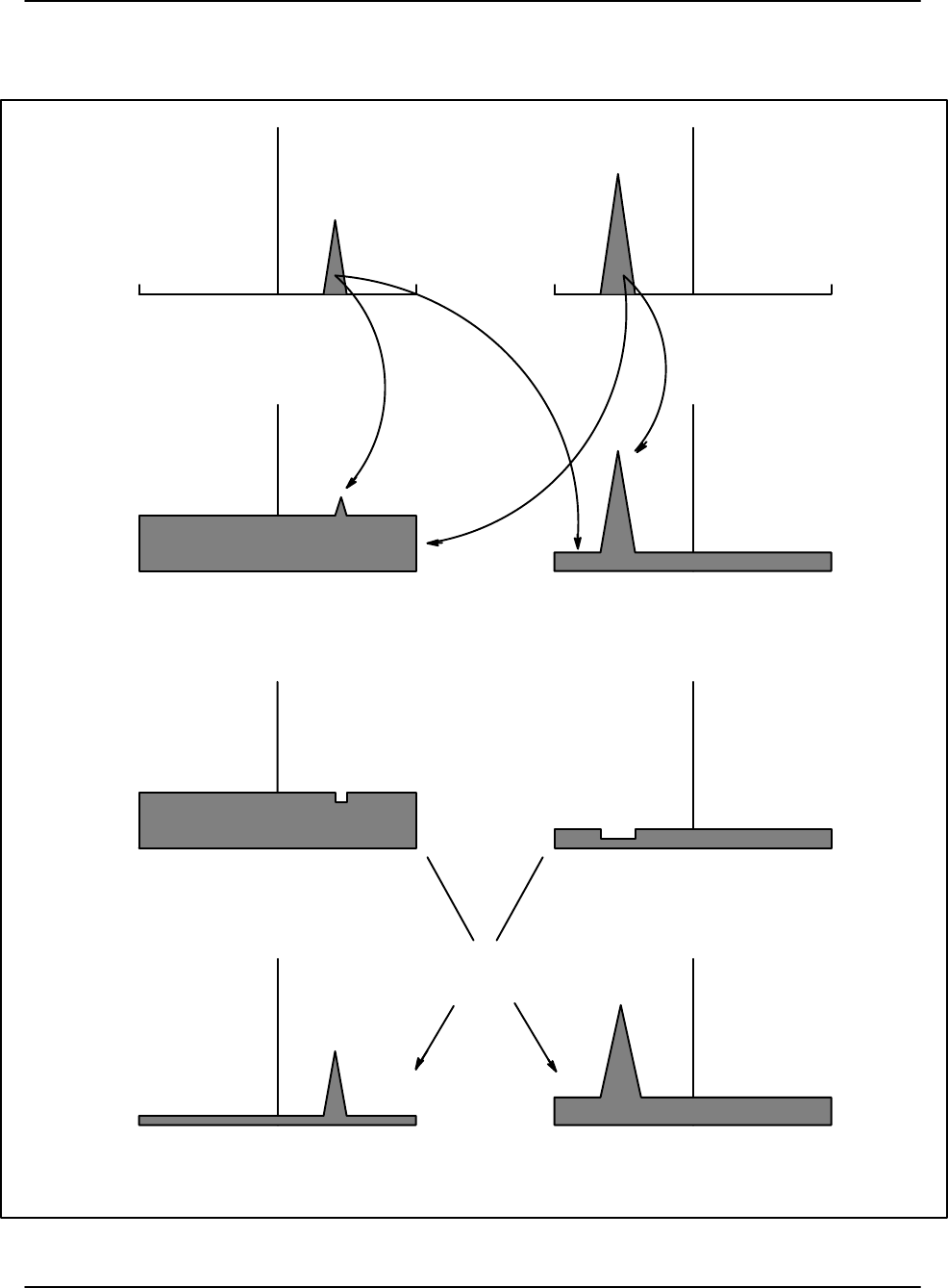
Processing Algorithms (draft)
RVP8 User’s Manual
April 2003
5–74
Figure 5–12: Random Phase Processing Algorithm
Ideal 1st Trip Ideal 2nd Trip
Raw 1st Trip with Raw 2nd Trip with
Filtered 1st Trip Filtered 2nd Trip
Inverse Transfrom
2nd Trip Noise Contamination 1st Trip Noise Contamination
and ReĆCohere
Recovered 1st Trip Recovered 2nd Trip

Processing Algorithms (draft)
RVP8 User’s Manual
April 2003
5–75
5.10 Signal Generator Testing of the Algorithms
This section describes a variety of IF signal generator tests that can be used to verify correctness
of the RVP8 processing algorithms. These tests are routinely performed at SIGMET whenever
new algorithms and/or major modes are added to the processor. We have include a few of the
test descriptions here so that they can be used by customers who need to debug their systems, or
who want to better understand how they work. Additional tests for receiver sensitivity and
dynamic range can be found in Appendix E.
5.10.1 Linear Ramp of Velocity with Range
Suppose that a continuous-wave IF waveform has an instantaneous frequency f(t) in Hertz
(cycles/sec). Consider a range bin located at time tbin within a set of pulses that are separated by
ts+1ńPRF. The phase measured at that bin on the nth pulse will be the integral of the frequency
within that pulse starting from range zero (since the RVP8 is phase locked to range zero):
Fn+ŕ
nts)tbin
nts
f(t)dt
If we assume that the input frequency is a linear Frequency Modulation (FM) at the rate of M
cycles/sec/sec on top of a base frequency To, then:
Fn)1*Fn+ŕ
(n)1)ts)tbin
(n)1)ts
(To)Mt)dt *ŕ
nts)tbin
nts
(To)Mt)dt +(Mts)tbin
which, remarkably, is independent of both To and n. Thus, a linear FM input signal produces a
fixed (I,Q) phase difference from pulse-to-pulse at any given range. The magnitude of the phase
difference is proportional to the range, and the slope is (ĂMĂtsĂ) cycles for each second of delay in
range. For example, if the test signal generator is sweeping 100KHz every two seconds, then the
velocity observed at a range of 300km at 250Hz PRF will be:
Fn)1*Fn+ǒ100 KHz
2 sec Ǔ ǒ1
250 sec Ǔ (300 km ) ǒ6.6 msec
1km Ǔ+0.40 cycles
We would thus observe a velocity of (0.8 Vu) at 300km, where VuĂ is the unambiguous
Doppler velocity in meters/sec. Note that these phase difference calculations have made no
assumptions about the RVP8 processing mode, and thus are valid in all major modes (PPP, FFT,
DPRT, RPH), as well as in all Dual-PRF unfolding modes.
Interestingly, this simple FM signal generator will also produce valid second trip velocities that
can be seen during Random Phase processing. This follows from the above analysis because
we’ve never assumed that tbin was smaller than ts, i.e., it is fine for the range bin to be located
in any higher-order trip.

Processing Algorithms (draft)
RVP8 User’s Manual
April 2003
5–76
5.10.2 Verifying PHIDP and KDP
The PHIDP and KDP processing algorithms can be tested using CW signal sources at IF. In the
alternating-transmitter single-receiver case, a single FM signal generator is modulated with an
RVP8 polarization select line so that slightly different frequencies are generated for the H and V
pulses. A maximum FM depth of several kilohertz is all that is required. In the dual-receiver
case, two (unmodulated) signal generators are used for each of the H and V intermediate
frequencies, and one or the other is detuned slightly from its correct center frequency. In either
case the frequency difference that produces a KDP value of 1.0 degree/km will be:
(1.0 degree
km ) (1
360
cycles
degree ) ( 299792 km
second )+833 cycles
second
5.10.3 Verifying RHOH, RHOV, and RHOHV
These three terms measure the normalized cross-channel covariance in a polarization radar.
They all are computed in essentially the same way having the form:
RHOAB +tsn
Asn
B*u
ts2
Aut s2
Bu
Ǹ
Where the sn
A and sn
B are complex (I,Q) vectors from two receiver channels A and B, and “<>”
denotes expected value. This suggests that some form of amplitude modulation (AM) of the
input signal might be helpful.
Suppose that the sn
A and sn
B samples are coming from two signal generators installed on a
dual-receiver system, and that only the B-Channel is AM modulated so that:
|sn
A|+{S
A,SA,SA,SA,SaAAA },|sn
B|+{S
B,0,SB,0,SBAAA }
Then the above estimator reduces to:
RHOAB +(1
2)SASB
S2
A (1
2)S2
B
Ǹ++0.707
A simple way to create these data is to set the A-Channel siggen for 95% AM depth, and use a
sinusoidal modulation source of, perhaps, 400Hz. The reason for not choosing 100% depth is
that we would loose the Burst phase reference when the amplitude became smallest. The 26dB
reduction in SB is a close enough approximation to zero in the above formula.
If we now observe the two receive channels with the RVP8 at a PRF of 800Hz, we will see the
various RHOAB terms varying with range; reaching a high value of 1.00, and a low value of
0.707. The plots will be nearly stationary on the ascope screen because the PRF is almost
precisely twice the modulation rate (though they are free-running relative to each other).
Adjusting the amplitude of either signal generator will not affect the ò terms, but it will have an
interesting effect on SQI. If (T,Z,V,W) are being computed from both channels combined, then
the SQI is:
SQI +S2
A
S2
A)(1
2)S2
B

Processing Algorithms (draft)
RVP8 User’s Manual
April 2003
5–77
If we solve this equation for SQI=0.5 we find that the individual SA terms must have twice the
power of the individual SB terms. This can be checked by adjusting either signal generator until
the minimum plotted SQI is 0.5, and then verifying that the average H and V powers are
identical; or, equivalently, that ZDR, LDRH and LDRV are zero.
The linear FM ramp described in Section 5.10.1 can also be used as a test of RHOAB in a
dual-receiver system. With one siggen modulated and the other fixed, one receive channel will
appear to be rotating relative to the other. If the FM modulation is such that 1/N of a full
revolution occurs per pulse at a given range, then if the sample size is N pulses we will observe
RHOAB +0 at that range. In fact, the plot of RHOAB will show a characteristic sin(x)ńx behavior
as a function of range.

Host Computer Commands
RVP8 User’s Manual
May 2003
6–1
6. Host Computer Commands
This chapter describes the digital commands that the host computer must use to set up and
control the RVP8 processor for recording data. Each command is described in detailed in a
separate section of this chapter. Note that a command mnemonic, or shorthand reference name,
is given in each section heading. These names are frequently used to refer to particular
commands.
The write–up for each command includes a description of what the command does and a
pictorial layout of the bits in the 16-bit command word. Commands consist of an initial
command word containing an opcode in the low five bits. If additional arguments are required,
they are listed as “Input 1”, “Input 2”, etc. Finally, if the command produces output, those
words are listed as “Output 1”, “Output 2”, etc. Often each word is broken down into several
independent fields, each consisting of one or more bits. In such cases, the pictorial layouts show
the placement of the bit fields within the word, and each field is described individually. All data
transferred to or from the RVP8 are in the form of 16-bit words.
Before attempting to program the RVP8, it is a good idea to at least skim through the
descriptions of every command. The instruction set has been designed to be as concise and
orthogonal as possible. User programs should always execute the IOTEST command on
power-up to ensure that the interface connections are all intact. The diagnostic result registers
from GPARM should also be checked initially to verify that the RVP8 passed all internal checks.
Since all internal RVP8 tables and parameters are set to reasonable values on power-up, it is
conceivable that PROC commands could be issued immediately to acquire and process radar
data. More realistically, however, the default information is first modified to meet the users
needs.
To set up for data acquisition and processing the following sequence of commands might be
executed. Trigger and pulse width are first established using the SETPWF commands. Range
bin placement and processor options are then chosen using LRMSK, and SOPRM, and receiver
noise samples are taken with SNOISE. The noise levels are not automatically sampled on
power-up, so SNOISE must be issued at least once by the user. LFILT is executed if clutter
filters are needed. If data rays are to be synchronized with antenna motion, then LSYNC is used
to specify a table of antenna angles. After all setups are complete, PROC commands are issued
to actually collect, process, and output the data. Errors detected during the execution of
commands are noted by the RVP8 and can be monitored using GPARM.
The RVP8 contains a 4096-word first-in-first-out (FIFO) buffer through which all output data
flow. This buffer is included to simplify the requirements of the user’s interface hardware. The
FIFO holds each sequential word generated by the RVP8 until such time as the user is ready to
accept it. Thus, when reading from the processor, it is permissible to fall behind by as many as
4096 words before any slowdown in performance occurs. The RVP8 writes to the FIFO at full
speed as long as it is not full, and the internal processing is not affected by the exact speed at
which user I/O actually occurs. This continues as long as the average I/O rate on, perhaps 10ms
intervals, matches the average rate at which data are being produced.

Host Computer Commands
RVP8 User’s Manual
May 2003
6–2
The sequence of events described above is altered when the FIFO becomes completely full.
Then, when the processor generates the next output word, it waits in an idle loop until the user
makes room in the FIFO by reading out one or more words. Until this space becomes available,
the RVP8 simply waits and does not proceed any further with its internal processing. This, of
course, leads to a slowdown in performance, but it is not a disastrous one. The user always
obtains correct data no matter how long it takes to read it. One could take advantage of this fact
to synchronize the acquisition of data by the RVP8 with the post-processing and display of that
data by the user. In this case, RVP8 would be instructed to output data at the maximum rate, the
user would read these words at the user’s maximum rate, and the overall system would
automatically run at the slower of those two speeds.
When the output FIFO is full and the RVP8 has the next word ready for output, there is another
way that the idle wait loop can be exited, that is, if the processor detects that the user is
performing a write I/O cycle. Since the user should have been reading data by now, the presence
of a write cycle is taken to mean that some more important condition has arisen. As such, the
wait loop is terminated and the RVP8 accepts the write data soon afterward. If the new data are
commands, they are executed right away, but any output they try to produce may be lost in a
similar manner. The net effect is that the processor continues to execute all commands correctly,
but that their output is discarded.
The discarded output data are not in fact lost. Rather, the data are eventually replaced with an
equal number of zeros. Each time the RVP8 discards an output word, it also increments an
internal 24-bit count. When FIFO space becomes available in the future, the processor replaces
all of the missing data with zero-valued placeholders.
Writing when the FIFO is full can be particularly useful if the new command is a RESET which
calls for clearing of the output FIFO. When the RESET is processed, all past and present output
data are discarded, leaving the RVP8 output section completely empty. This is useful whenever
the processor has pending output data which the user wants to truly throw away.
6.1 No-Operation (NOP)
This single-word instruction is simply ignored by the the Signal Processor. The NOP is useful
when a number of words are to be flushed through the RVP8 with no side effects.
15 14 13 12 11 10 9 8 7 6 5 4 3 2 1 0
| | | | | | | | | | | | | | | | |
| | 0 0 0 0 0 | Command
|___________________________________________|___________________|
6.2 Load Range Mask (LRMSK)
This command informs the signal processor of the ranges at which data are to be collected. An
arbitrary set of range bins are selected via an 8192-bit mask. The Nth bit in the mask determines
whether data are acquired and processed at a range equal to RES x (N-1). The Range resolution
is specified by a TTY setup question (see section 3.3.5), in the range 50 through 133 meters.
Any collection of ranges may be chosen from integer multiples of that distance. The example
below is given for the default resolution of 125 meters. The range mask is passed to the RVP8

Host Computer Commands
RVP8 User’s Manual
May 2003
6–3
packed into 512 16-bit words. The least significant bit of each packed word represents the
nearest range, and the most significant bit represents the furthest range in each group of 16.
Because of memory constraints, the RVP8 uses only the first 5600 bits in the mask.
According to the range bins that are selected in the mask, the signal processor computes and
stores internally a range normalization table which is later used to convert receiver intensity
levels into reflectivity levels in dBZ. Note that the LRMSK command implicitly specifies the
number of bins to be processed and output. The maximum bin count is 2048, though depending
on the computational intensity of the configuration, the RVP8 may be able to compute fewer
bins. If the number of bins selected in the bit mask exceeds this maximum, the trailing bins are
truncated. If the new mask does not specify any active bins, then a single bin at range zero is
forced on. The default power-up mask selects 256 bins equally spaced by 1.0km starting from
zero range.
Range averaging is also determined by LRMSK. The upper byte of the command controls how
many consecutive bins are grouped together. A value of zero means no averaging; one means
that pairs of samples are averaged; 255 means that 256 terms are summed, etc. The individual
samples that go into each average are still taken according to the bits that are set in the mask,
except that they are now grouped together so that only one net bin results from the several data
samples. Note that the limitation of 2048 sampled ranges applies to the bin count prior to
averaging.
For example, suppose 100 bits are selected in the range mask and no averaging is elected. Then
parameters are computed at those 100 ranges, and 100 bins of data are output. If the averaging
were set to one, rather than zero, samples would still be taken at the same ranges, but pairs of
bins would be averaged together and only 50 ranges would result. Note that the parameters are
averaged by summing the autocorrelations for each bin. The range normalization value
associated with the averaged bin is computed according to the midpoint of the first and last
sample.
Incompletely averaged bins are discarded by the LRMSK command. In the above example, if
the averaging were set to two so that triples of samples were summed, then only 33 bins would
be output. This is because the 100-bit mask left a dangling 100th sample. In the extreme case
where there are not enough mask bits to result in even one complete bin, the RVP8 forces the
averaging to zero and turns on a single bin at zero range.
When the RVP8 is operating in fast-switching dual-polarization mode (See SOPPRM Command,
word #2), the maximum number of bins that can be processed is half the usual maximum. This
is because duplicate internal memory is needed to hold the states of the clutter filters separately
for each polarization. If polarization switching is on and a range mask is loaded having more
than 1024 bins, then an error bit is set (GPARM Command, word 9) and only the first 1024 bins
are used. Conversely, if a range mask has already been loaded having more than 1024 bins and
the user attempts to enter the switching polarization mode, then that request is denied and the
RVP8 continues to operate in its prior fixed polarization manner. Whenever the number of range
bins is less than 1024, then none of the above interactions ever arises.

Host Computer Commands
RVP8 User’s Manual
May 2003
6–4
15 14 13 12 11 10 9 8 7 6 5 4 3 2 1 0
| | | | | | | | | | | | | | | | |
| Range Avg. (See Text) | | 0 0 0 0 1 | Command
|_______________________________|_______|___|___________________|
15 14 13 12 11 10 9 8 7 6 5 4 3 2 1 0
| | | | | | | | | | | | | | | | |
| Bits for ranges 0.000km to 1.875km | Input 1
|_______________________________________________________________|
\_1.875 . \_0.000
.
.
15 14 13 12 11 10 9 8 7 6 5 4 3 2 1 0
| | | | | | | | | | | | | | | | |
| Bits for ranges 1022.000 km to 1023.875 km | Input 512
|_______________________________________________________________|
\_1023.875 \_1022.000
6.3 Setup Operating Parameters (SOPRM)
This command is used to configure the Signal Processor. The command should be issued
whenever any of the parameters in the list change. The default parameter list consists of twenty
16-bit input words. These can be followed by optional XARG parameters as needed.
15 14 13 12 11 10 9 8 7 6 5 4 3 2 1 0
| | | | | | | | | | | | | | | | |
| | 0 0 0 1 0 | Command
|___________________________________________|___________________|
15 14 13 12 11 10 9 8 7 6 5 4 3 2 1 0
| | | | | | | | | | | | | | | | |
| Sample Size | Input 1
|_______________________________________________________________|
The sample size is continually adjustable from 1 to 256 pulses. However, during the alternating
polarization mode, the sample size must be even. If an odd value is entered it is rounded up by
one in that case.
15 14 13 12 11 10 9 8 7 6 5 4 3 2 1 0
| | | | | | | | | | | | | | | | |
| | Polar |NHD| |16B|CMS| R2| |3x3| |End|Lsr|Dsr|Rnv| Input 2
|_______|_______|___|___|___|___|___|___|___|___|___|___|___|___|
Each of the single-bit fields selects whether the given processing or threshold option is enabled
(1) or disabled (0).
Polar Configures transmit polarization and Zdr processing:
00 – Fixed polarization, Horizontal
01 – Fixed polarization, Vertical
10 – Alternating polarization pulse-to-pulse
11 – Dual simultaneous transmission
NHD Disables inclusion of header words in the processed data that are output by the
PROC command (See also, CFGHDR command).

Host Computer Commands
RVP8 User’s Manual
May 2003
6–5
16B Configures for 16-bit (rather than 8-bit) data output from the PROC command.
This bit affects the single-parameter versions of Reflectivity, Velocity, Width, and
Zdr data. However, the PROC command’s archive format always holds 8-bit data,
regardless of the setting of 16B. This gives the option of extracting both 8-bit and
16-bit data simultaneously from each ray.
CMS Enables Clutter Microsuppression, in which individual range bins are rejected
(based on excessive clutter) prior to being averaged together in range.
R2 Use three lag (R0/R1/R2) algorithms for width, signal power, and clutter correc-
tion.
3x3 Switches on the 3x3 output filter (See Section 5.3.3). The RVP8 automatically
handles all of the pipelining overhead associated with running the 3x3 filter, i.e.,
valid output data are always obtained in response to every PROC command.
End Causes ENDRAY_ to pulse at the end of each ray.
Lsr Reflectivity speckle remover. When set, range speckles in the corrected and un-
corrected reflectivity data are removed.
Dsr Doppler speckle remover. When set, range speckles in the velocity and width data
are removed.
Rnv Range normalization of reflectivity data. This bit also enables intervening gas at-
tenuation correction.
15 14 13 12 11 10 9 8 7 6 5 4 3 2 1 0
| | | | | | | | | | | | | | | | |
| Log Slope 65536 * dB / (LSB) | Input 3
|_______________________________________________________________|
This number defines the multiplicative constant that converts the signal power in dB to the units
of the 12–bit “Log of power in sample” time series outputs. One fourth of this slope is used to
generate the “Log of Measured Noise Level” output from GPARM (word 6). The recommended
value to use here is 0.03 (1966). This gives a dynamic range of 122 dB in 12 bits.
15 14 13 12 11 10 9 8 7 6 5 4 3 2 1 0
| | | | | | | | | | | | | | | | |
| LOG Threshold in 1/16 of dB | Input 4
|_______________________________________________________________|
Reflectivity values below this level can result in thresholding of data, if the threshold control
flags (see below) include LOG Noise bits. The threshold value is always non-negative, and the
comparison test is described in Section 5.3.
15 14 13 12 11 10 9 8 7 6 5 4 3 2 1 0
| | | | | | | | | | | | | | | | |
| Clutter Correction (CCOR) Threshold in 1/16 of dB | Input 5
|_______________________________________________________________|
The clutter correction threshold is a bound on the computed log receiver adjustment for clutter.
These corrections (in dB) are always negative. Any clutter correction which is more negative
than the above value can result in thresholding of data.
15 14 13 12 11 10 9 8 7 6 5 4 3 2 1 0
| | | | | | | | | | | | | | | | |
| | SQI Threshold | Input 6
|_______________________________|_______________________________|

Host Computer Commands
RVP8 User’s Manual
May 2003
6–6
The Signal Quality Index (SQI) threshold is an unsigned binary fraction in the range 0 to
255/256. When the SQI for a range bin falls below the stated value it may result in thresholding
of data.
15 14 13 12 11 10 9 8 7 6 5 4 3 2 1 0
| | | | | | | | | | | | | | | | |
| Weather Signal Power Threshold in 1/16 of dB | Input 7
|_______________________________________________________________|
Weather Signal Power (SIG) is an estimate of the SNR of the weather component of the received
signal. When the SIG (see Section 5.2.10) falls below this comparison value it may result in
thresholding of data.
15 14 13 12 11 10 9 8 7 6 5 4 3 2 1 0
| | | | | | | | | | | | | | | | |
| Calibration Reflectivity in 1/16 of dB | Input 8
|_______________________________________________________________|
The calibration reflectivity is referenced to 1.0 kilometers.
15 14 13 12 11 10 9 8 7 6 5 4 3 2 1 0
| | | | | | | | | | | | | | | | |
| | TopMode | | Input 9
|_______________|_______________|_______________________________|
The TopMode bits select the overall data acquisition and processing mode for the RVP8.
Although the processing algorithms that are used in each top level mode are quite different, the
RVP8 command set works in a uniform way in all modes.
0000 Pulse Pair Processing Mode. Doppler clutter filters are 4th-order IIR high pass;
data are processed one pulse at a time as each pulse arrives (see Section 5.2.3).
0001 FFT Processing Mode. Doppler clutter filters use nonlinear frequency-domain
approach; data are processed in batches of pulses (see Section 5.8).
0010 Random Phase Processing Mode. Data from first and second trips are dealiased in
range based on knowledge of the radar transmitter phase (see Section 5.9).
0100 DPRT-1 Processing Mode. The trigger generator produces alternate short and long
pulses, and Doppler autocorrelations are computed using only the short pairs (see
Section 5.5).
0101 DPRT-2 Processing Mode. The trigger generator produces alternate short and long
pulses, and Doppler autocorrelations are computed using both pairs (see Section
5.5).
15 14 13 12 11 10 9 8 7 6 5 4 3 2 1 0
| | | | | | | | | | | | | | | | |
| |PCT|UVD|Window |ZER| Filter Stabilization Delay | Input 10
|___________|___|___|_______|___|_______________________________|
The RVP8 clutter filters are controlled by this word.
Delay This delay is introduced prior to processing the next ray of data whenever Dual-
PRF velocity unfolding is enabled or the RVP8 has been reconfigured by user
commands. The delay permits the clutter filter transients to settle down following
PRF and gain switches. The value is specified as the number of pulses, and hence,
the number of filter iterations, to wait.

Host Computer Commands
RVP8 User’s Manual
May 2003
6–7
ZER If set, then the clutter filter’s internal state variables are zeroed prior to waiting the
delay time. For some signal conditions, this may give better results than allowing
the filter to naturally flow into the new data.
Window Selects the type of window that is applied to time series data prior to computing
power spectra via a DFT. Choices are: 0:Rectangular, 1:Hamming, 2:Blackman.
UVD Unfold velocities using a simple (Vhigh – Vlow) algorithm, rather than the standard
algorithm described in Section 5.6.
PCT If set, the RVP8 will attempt to run its standard processing algorithms even when a
custom trigger pattern has been selected via the SETPWF command.
15 14 13 12 11 10 9 8 7 6 5 4 3 2 1 0
| | | | | | | | | | | | | | | | |
| Threshold Control Flags for UnCorrected Reflectivity | Input 11
|_______________________________________________________________|
These flags select which threshold comparisons result in unCorrected reflectivity being accepted
or rejected at each bin. There are four test comparisons that are made at each range, as described
above for input words 4, 5, 6, and 7. Each test either passes and produces a code of 1, 2, 4, and
8 respectively, or fails and produces a code of zero. The sum of the codes for each of the four
tests is a number between 0 and 15, which can also be interpreted as the following four-bit
binary number:
3 2 1 0
| | | | |
| 8 | 4 | 2 | 1 |
|___|___|___|___|
\ \ \ \___ LOG Threshold Passes
\ \ \______ CCOR Threshold Passes
\ \_________ SQI Threshold Passes
\____________ SIG Threshold Passes
The individual bits of the Threshold Control Flag word each specify whether data are to be
accepted (1) or rejected (0) in each of the sixteen possible combinations of threshold outcomes.
Thus, the pattern of bits in the flag word actually represents a truth table for a given logical
function of the four threshold outcomes.
The following examples show actual values of the Flag word for the stated combinations of
acceptance criteria:
Value Criteria
FFFF All Pass (Thresholds disabled)
0000 All Fail (No data are passed)
AAAA LOG
8888 LOG and CSR
A0A0 LOG and SQI
8080 LOG and CSR and SQI
F0F0 SQI
FAFA SQI or LOG
C0C0 SQI and CSR
F000 SQI and SIG
C000 SQI and SIG and CSR
FFF0 SQI or SIG
CCC0 (SQI or SIG) and CSR

Host Computer Commands
RVP8 User’s Manual
May 2003
6–8
A simple way to generate these values is to imagine four 16-bit quantities having the following
names and values: LOG=AAAA, CSR=CCCC, SQI=F0F0, SIG=FF00. The flag value needed
to represent a given logical combination of threshold outcomes is obtained as the result when
that same logical combination is applied to these special numbers.
For example:
(SQI or SIG) and CSR = (F0F0 or FF00 ) and CCCC
= (FFF0) and CCCC
= CCC0
which corresponds with one of the examples given above.
15 14 13 12 11 10 9 8 7 6 5 4 3 2 1 0
| | | | | | | | | | | | | | | | |
| Threshold Control Flags for Corrected Reflectivity | Input 12
|_______________________________________________________________|
See Description for Input #11.
15 14 13 12 11 10 9 8 7 6 5 4 3 2 1 0
| | | | | | | | | | | | | | | | |
| Threshold Control Flags for Velocity | Input 13
|_______________________________________________________________|
See Description for Input #11.
15 14 13 12 11 10 9 8 7 6 5 4 3 2 1 0
| | | | | | | | | | | | | | | | |
| Threshold Control Flags for Width | Input 14
|_______________________________________________________________|
See Description for Input #11.
15 14 13 12 11 10 9 8 7 6 5 4 3 2 1 0
| | | | | | | | | | | | | | | | |
| Bits to Invert in TAG Inputs 0 through 15 | Input 15
|_______________________________________________________________|
15 14 13 12 11 10 9 8 7 6 5 4 3 2 1 0
| | | | | | | | | | | | | | | | |
| Bits to Invert in TAG Inputs 16 through 31 | Input 16
|_______________________________________________________________|
15 14 13 12 11 10 9 8 7 6 5 4 3 2 1 0
| | | | | | | | | | | | | | | | |
| Intervening Gas Attenuation Correction (dB/km) | Input 17
|_______________________________________________________________|
Gas attenuation correction attempts to compensate for overall (two-way) beam losses due to
absorption by atmospheric gasses. The correction is linear with range, and is added to the data
along with range normalization. Therefore, clearing the RNV bit in Word #2 above disables the
correction. Of course, gas attenuation compensation can still be turned off even when RNV is
on, simply by setting a slope of 0.0 dB/km.
An attenuation of G db/km is encoded into the unsigned 16-bit word N as follows:
0 N 10000 G = N / 100000
else G = 0.1 + (N – 10000)/10000

Host Computer Commands
RVP8 User’s Manual
May 2003
6–9
This format is backward compatible with the previous linear format for all values between 0.0
and 0.1dB/km; but it extends the upper range of values from 0.65535 up to 5.6535. These larger
attenuation corrections are needed for very short wavelength radars.
15 14 13 12 11 10 9 8 7 6 5 4 3 2 1 0
| | | | | | | | | | | | | | | | |
| Threshold Control Flags for Differential Reflectivity (Zdr) | Input 18
|_______________________________________________________________|
See Description for Input #11.
15 14 13 12 11 10 9 8 7 6 5 4 3 2 1 0
| | | | | | | | | | | | | | | | |
| Signed Zdr Calibration Offset in 1/16 dB (GDR) | Input 19
|_______________________________________________________________|
When differential reflectivity is computed there is a possibility that radar asymmetries will
introduce a bias in the Zdr values, i.e., that Zdr will be non-zero even when observing purely
spherical targets. This calibration offset permits nulling out this effect. The GDR offset
accounts for the overall Tx/Rx gain imbalance between the two channels of the radar.
15 14 13 12 11 10 9 8 7 6 5 4 3 2 1 0
| | | | | | | | | | | | | | | | |
| Radar Wavelength in Thousandths of Centimeters | Input 20
|_______________________________________________________________|
The radar wavelength is used in the calculation of 16-bit velocity and width data, to convert
from Nyquist units to absolute physical units.
15 14 13 12 11 10 9 8 7 6 5 4 3 2 1 0
| | | | | | | | | | | | | | | | |
| Signed LDR Calibration Offset in 1/100 dB (XDR) | XARG 1
|_______________________________________________________________|
The XDR offset is used in the Linear Depolarization Ratio equations, and is the differential
receiver gain between the two channels. Note that unlike the GDR offset (used for ZDR), the
gain difference does not depend on differential transmit power.
The default (power-up) values for the above parameters are listed below. Both the scientific
units and the integer-input required by the command to set up that value are given. Most of
these defaults will likely be reasonable for a wide variety of radars.
Table 6–1: Default Values For Operating Parameters
Parameter Scientific Units Input
Sample Size 25 pulses 25
Flag Word 0017 Hex
Log Slope 0.03 dB/LSB 1966
LOG Threshold 0.5 dB 8
CCOR Threshold –25.0 dB –400
Signal Quality Index Threshold 0.5 (dimensionless) 128
SIG Threshold 10.0 dB 160

Host Computer Commands
RVP8 User’s Manual
May 2003
6–10
Table 6–1: Default Values For Operating Parameters (cont.)
Parameter InputScientific Units
Calibration Reflectivity –22.0 dBZ –352
Gas Attenuation 0.016 dB/km 1600
Zdr Offset (GDR) 0.0 dB 0
LDR Offset (XDR) 0.0 dB 0
AGC Integration Period 8 pulses 8
Radar Wavelength 5.3 cm. 5300
Dual PRF Filter Stabilization 10 pulses 10
UnCor Refl. Thresh. Control Flag LOG AAAA Hex
Cor Refl. Thresh. Control Flag LOG & CSR 8888 Hex
Velocity Thresh. Control Flag SQI & CSR C0C0 Hex
Width Thresh. Control Flag SQI & CSR & SIG C000 Hex
Zdr Refl. Thresh. Control Flag LOG AAAA Hex
TAG Bits to Invert No Inversions 0000 Hex
6.4 Interface Input/Output Test (IOTEST)
This command is used to test both the input and output data busses of the signal processor
interface. When issued, the command causes sixteen words to be read from the host controller,
after which those same sixteen words are written back out. Typically, the controller supplies a
“barber pole” input sequence consisting, for example, of successive powers of two. If all of the
output words are correct, one may conclude that there are no malfunctioning bits in the interface
hardware.
15 14 13 12 11 10 9 8 7 6 5 4 3 2 1 0
| | | | | | | | | | | | | | | | |
| | 0 0 0 1 1 | Command
|___________________________________________|___________________|

Host Computer Commands
RVP8 User’s Manual
May 2003
6–11
15 14 13 12 11 10 9 8 7 6 5 4 3 2 1 0
| | | | | | | | | | | | | | | | |
| Arbitrary Data Word #1 Supplied by Host Controller | Input 1
|_______________________________________________________________|
.
.
15 14 13 12 11 10 9 8 7 6 5 4 3 2 1 0
| | | | | | | | | | | | | | | | |
| Arbitrary Data Word #16 Supplied by Host Controller | Input 16
|_______________________________________________________________|
Note: The IOTEST command can also process and echo up to 128 additional
XARGS data words (See Section 6.20).
15 14 13 12 11 10 9 8 7 6 5 4 3 2 1 0
| | | | | | | | | | | | | | | | |
| Copy of Data Word #1 as supplied by Host Controller | Output 1
|_______________________________________________________________|
.
.
15 14 13 12 11 10 9 8 7 6 5 4 3 2 1 0
| | | | | | | | | | | | | | | | |
| Copy of Data Word #16 as supplied by Host Controller | Output 16
|_______________________________________________________________|
6.5 Interface Output Test (OTEST)
This command is used to test the integrity of the data being output by the signal processor. The
command causes sixteen words to be output consisting of successive powers of two starting from
one. By verifying whether each output word is correct, malfunctioning bits in the interface data
bus can easily be isolated. This test is less stringent than the input/output test IOTEST, since the
input data paths to the processor are not being checked. Typically, the OTEST is performed only
when the IOTEST fails, and then to determine whether the fault was on input or output.
15 14 13 12 11 10 9 8 7 6 5 4 3 2 1 0
| | | | | | | | | | | | | | | | |
| | 0 0 1 0 0 | Command
|___________________________________________|___________________|
15 14 13 12 11 10 9 8 7 6 5 4 3 2 1 0
| | | | | | | | | | | | | | | | |
| 0 0 0 0 0 0 0 0 0 0 0 0 0 0 0 1 | Output 1
|_______________________________________________________________|
.
.
15 14 13 12 11 10 9 8 7 6 5 4 3 2 1 0
| | | | | | | | | | | | | | | | |
| 1 0 0 0 0 0 0 0 0 0 0 0 0 0 0 0 | Output 16
|_______________________________________________________________|
6.6 Sample Noise Level (SNOISE)
This command is used to estimate the current noise level from the receiver, so that the noise can
be subtracted from subsequent measurements. Data are sampled for 256 pulses at 256 bins,
beginning at a selectable range and spaced by 0.125 meters. The internal trigger generator is

Host Computer Commands
RVP8 User’s Manual
May 2003
6–12
temporarily set to a special noise rate (usually much lower than the operating rate) during the
process. It is ultimately the user’s responsibility to insure that no returned power is present
within the 32km sampling interval. In some cases it may be necessary to raise the antenna
during the noise measurement to avoid thermal noise pickup from the ground, or from weather
targets.
SNOISE has the option of setting up a new sampling range and trigger generator rate each time
it is called. Two bits in the command word determine which (if any) of the new values overrides
the current values stored in the RVP8. The power-up sampling range is 250km (input value of
250), and the power-up trigger rate is 200Hz (input value of 30000). These initial values persist
until such time as they are altered here. Note that both input words must always be supplied
after the command, even if the command calls for ignoring one or both of them. The range is
supplied directly in kilometers up to a maximum of 992km. The trigger rate resulting from a
given input is 6MHz divided by the input value, i.e. the input value is the trigger period in
0.1667 microsecond increments. Keep in mind that the given rate is bounded against the
minimum PRT allowed for the current radar pulse width.
The SNOISE command bounds the requested starting range of the noise sampling interval. This
is to insure that the noise samples will fit within the specified PRT, and within the range mask
hardware RAM. The RVP8 sets an error bit when an improper range is requested. The noise
sampling procedure also bounds the PRF to 1250Hz before making its measurements. This
allows sufficient time for the algorithm to run properly on the 256 bins taken from 256 pulses.
Note that the PRF bound is equally well imposed for external triggers too, i.e., external triggers
will be ignored for 800sec following each one that is actually used.
The SNOISE command should be re-issued now and then to compensate for drift in the RF and
A/D systems. However, because DC offsets do not propagate into the “I” and “Q” values,
reissuing the command is much less critical than with the RVP6. SNOISE must be executed at
least once after power-up, before beginning to acquire and process data. The RVP8 does not
automatically take a noise sample as part of its initialization procedure.
The measured offsets are stored internally for all subsequent uses inside the RVP8. The offset
values may be inspected via the GPARM command, as may the current range and rate values
themselves. Of course, whenever the range or rate are changed the user must ensure that the
new trigger rate allows at least 32km following the new noise range. If this requirement is not
met, or if other failures are detected during the noise measurement, appropriate bits are set in the
GPARM latched status word. This word should generally be checked after SNOISE to make
sure that everything worked properly.
15 14 13 12 11 10 9 8 7 6 5 4 3 2 1 0
| | | | | | | | | | | | | | | | |
| |Rat|Rng| | 0 0 1 0 1 | Command
|_______________________|___|___|___________|___________________|
Rng If 1, then the range in input word 1 is taken as the starting noise range for this and
all subsequent SNOISE calls.
Rat If 1, then the trigger rate in input word 2 is taken as the noise rate for this and all
subsequent SNOISE calls.

Host Computer Commands
RVP8 User’s Manual
May 2003
6–13
15 14 13 12 11 10 9 8 7 6 5 4 3 2 1 0
| | | | | | | | | | | | | | | | |
| Starting Range in km (Max 992km) of 32km Sampling Interval | Input 1
|_______________________________________________________________|
15 14 13 12 11 10 9 8 7 6 5 4 3 2 1 0
| | | | | | | | | | | | | | | | |
| Internal Trigger Rate (6Mhz/N) to use During Noise Sampling | Input 2
|_______________________________________________________________|
6.7 Initiate Processing (PROC)
The PROC command controls the actual processing and output of radar data. The operating
modes and types of data available from the RVP8 are described in detail in Chapter 1. That
section also describes the proper use and application of the RVP8 to different radar
environments.
PROC is a single-word command that specifies the type of processing to be performed, and the
type of output to be generated. The two mode bits in the command word select either
Synchronous mode — The processor acquires, processes, and outputs one ray in response to
each PROC command. Processing is begun only after each command is actually received.
Free running mode — A single PROC command is issued and rays are continually output as
fast as they can be produced and consumed. This continues until any other command is
written, e.g., a NOP could be used to terminate the free running mode with no other
consequences.
Time Series mode — Always produced in a synchronous manner, this mode require a new
PROC command to initiate each new set of samples. Data are output as 8-bit time series,
16-bit time series, or 16-bit power spectra.
Optional Dual-PRF velocity unfolding is chosen by command bits eight and nine. For Doppler
data either a 2:3, 3:4, or 4:5 PRF unfolding ratio may be selected. The RVP8 carries out all of
the unfolding steps internally, so that mean velocity is now output with respect to the larger
unambiguous interval. There is no additional velocity processing needed by the user, except of
course, to change the velocity scale on any displays being generated. Furthermore, spectral
widths are scaled consistently with respect to the higher PRF, and require no user modification
before being plotted.
When unfolding is selected, the internal trigger generator automatically switches rates on
alternate rays. The switch over occurs immediately after the last pulse of the current ray has
been acquired; thus overlapping the internal post-processing and output time, with transmitter
stabilization and data acquisition at the new rate.
Output data are selected by the upper six bits of the PROC command. Packed archive output is
selected by setting the ARC bit. Individual byte or word display output is selected by setting any
or all of the Z, T, V, W, Zdr, and KDP command word bits. When more than one of these bits is
set, the output array consists of all of the bins for the leftmost selected parameter, followed by all
of the bins for the next selected parameter, etc. Bits selected in XARG #1 behave the same way,
except that the output order is right-to-left. Both archive and display formats can be selected

Host Computer Commands
RVP8 User’s Manual
May 2003
6–14
simultaneously, in which case the archive format is output first, followed by whichever
individual display format values were also selected. The archive format is not recommended for
use with new drivers because it can only handle four of the many possible output parameter
types.
When time series mode is selected there are three output data formats available. For backwards
compatibility, there is an 8-bit integer format in which the eight most significant bits from the I,
Q, and LOG signals are represented in a byte. This format is not recommended because it will
generally miss weak signals. We recommend the floating-point format that uses 16-bits per A/D
sample. There is also a 16-bit power spectrum output that is accurate to 0.01dB. (See also
GPARM output word #10).
In addition to the above output data, the first words of each ray optionally contain additional
information about the ray itself. These header words are configured by the CFGHDR opcode,
and are included only if the NHD (No-Headers) bit in SOPRM Input #2 is clear. For example, if
TAG angle headers are requested, if the ARC, Z and V bits are all set, and if there are 100 bins
selected in the current range mask, then each RVP8 output ray consists of the following:
1] TAG15 – TAG0 \ From Start of Acquisition
2] TAG31 – TAG16 / Interval
3] TAG15 – TAG0 \ From End of Acquisition
4] TAG31 – TAG16 / Interval
* 200 words of packed archive data,
* 100 words of Corrected Reflectivity data in low byte only.
* 100 words of Velocity data in low byte only,
The Command word format for Synchronous Doppler Mode is:
15 14 13 12 11 10 9 8 7 6 5 4 3 2 1 0
| | | | | | | | | | | | | | | | |
|ARC| Z | T | V | W |ZDR|Unfold |KDP| 0 1 | 0 0 1 1 0 | Command
|___|___|___|___|___|___|_______|___|_______|___________________|
The Command word format for Free Running Doppler Mode is:
15 14 13 12 11 10 9 8 7 6 5 4 3 2 1 0
| | | | | | | | | | | | | | | | |
|ARC| Z | T | V | W |ZDR|Unfold |KDP| 1 0 | 0 0 1 1 0 | Command
|___|___|___|___|___|___|_______|___|_______|___________________|
Either of these may be augmented by an optional XARG word (See Section 6.20)
15 14 13 12 11 10 9 8 7 6 5 4 3 2 1 0
| | | | | | | | (Tx Vert) | (Tx Horz) | | | |
| |Flg|Phi Rho Ldr|Phi Rho Ldr|SQI|RHV|PDP| XARG 1
|_______________________|___|___|___|___|___|___|___|___|___|___|
Unfold Selects Dual–PRF unfolding scheme:
00 : No Unfolding 01 : Ratio of 2:3
10 : Ratio of 3:4 11 : Ratio of 4:5
ARC Selects archive output format in which four data bytes (see 8-Bit descriptions be-
low) are packed into two output words per bin as follows:

Host Computer Commands
RVP8 User’s Manual
May 2003
6–15
High Byte Low Byte
| | |
| V | Z | First Word
|___________|___________|
_______________________
| | |
| W | T | Second Word
|___________|___________|
The remaining data parameters are available in both 8-Bit and 16-bit formats, according to
SOPRM Command input word #2 (See Section 6.3). The same SOPRM word configures the
RVP8 for Single or Dual polarization. The later is required for KDP, PDP, and RHV to be
computed properly.
V Selects radial velocity data.
8-Bit Velocity Format — Mean velocity, expressed as a fraction of the unambig-
uous velocity interval, is computed from the unsigned byte N as:
Vm/sec = VNyquist x (N–128) / 127.5
0 : Indicates velocity data is not available at this range
1 : Maximum velocity towards the radar
128 : Zero velocity
255 : Maximum velocity away from the radar
When velocity unfolding is selected, the output is still interpreted as above, ex-
cept that the unambiguous interval is increased by factors of 2, 3, and 4 for for
2:3, 3:4, and 4:5 unfolding.
16-Bit Velocity Format — Mean velocity in meters/second is computed from the
unsigned word N as:
Vm/sec = (N–32768) / 100
The overall range is from –327.67m/sec to +327.66m/sec in one centimeter/sec-
ond steps as follows:
0 : Indicates velocity data is not available at this range
1 : –327.67 m/sec (towards the radar)
32768 : 0.00 m/sec
65534 : +327.66 m/sec (away from the radar)
65535 : Reserved Code
W Selects spectral width data.
8-Bit Width Format —Spectral width is computed from the unsigned byte N as:
WNyquist = N / 256
The overall range is a fraction between 1/256 to 255/256 of the unambiguous in-
terval. The code of zero indicates that width data was not available at this range.
16-Bit Width Format — Spectral width in meters/second is computed from the
unsigned word N as:
Wm/sec = N / 100

Host Computer Commands
RVP8 User’s Manual
May 2003
6–16
The overall range is from 0.01m/sec to 655.34m/sec in one centimeter/second
steps as follows:
0 : Indicates width data is not available at this range
1 : 0.01 m/sec
65534 : 655.34 m/sec
65535 : Reserved Code
Z Selects clutter corrected reflectivity data.
8-Bit deciBel Format — The level in decibels is computed from the unsigned
byte N as:
dBZ = (N–64)/2.
The overall range is therefore from –31.5 dBZ to +95.5 dBZ in half-dB steps as
follows:
0 : Indicates no reflectivity data available at this range
1 : –31.5 dBZ
64 : 0.0 dBZ
128 : 32.0 dBZ
255 : +95.5 dBZ
16-Bit deciBel Format — The level in decibels is computed from the unsigned
word N as:
dBZ = (N–32768) / 100
The overall range is from –327.67dB to +327.66dB in 1/100dB steps as follows:
0 : Indicates no reflectivity data available at this range
1 : –327.67 dBZ
32768 : 0.00 dBZ
65534 : +327.66 dBZ
65535 : Reserved Code
T Selects total reflectivity. Same 8-bit and 16-bit coding formats as for clutter cor-
rected reflectivity above.
ZDR Selects differential reflectivity data.
8-Bit ZDR Format — The level in decibels is computed from the unsigned byte
N as:
dB = (N–128) / 16
The overall range is from –7.935dB to +7.935dB in one-sixteenth dB steps as fol-
lows:
0 : Indicates no reflectivity data available at this range
1 : –7.9375 dB
128 : 0.0000 dB
255 : +7.9375 dB

Host Computer Commands
RVP8 User’s Manual
May 2003
6–17
16-Bit ZDR Format — Same as 16-bit deciBel format.
KDP Selects dual polarization specific differential phase data.
8-Bit KDP Format — Values are coded into an unsigned byte using a logarith-
mic scale. The KDP angles are multiplied by the wavelength in cm. (to reduce
dynamic range) and then converted to a log scale separately for both signs. The
minimum value is 0.25 deg*cm/km, and the maximum value is 150.0 deg*cm/
km. A code of zero represents no data, and a code of 128 represents 0 deg*cm/
km. The conversion equation for positive values (codes from 129 to 255) is:
KDP 0.25 600N129
126
The conversion equation for negative values (codes from 1 to 127) is:
KDP –0.25 600127N
126
16-Bit KDP Format — Same as 16-bit deciBel format, except that the units are
hundredths of degrees per kilometer. No weighting by wavelength is introduced.
PDP Selects dual polarization differential phase DP data.
8-Bit DP Format — The phase angle in degrees is computed on a 180-degree
interval from the unsigned byte N as:
DP(mod180) = 180 (N – 1) / 254
0 : Indicates no DP data available at this range
1 : 0.00 deg
254 : 179.29 deg
255 : Reserved Code
16-Bit DP Format — The phase angle in degrees is computed on a 360-degree
interval from the unsigned word N as:
DP(mod360) = 360 (N – 1) / 65534
0 : Indicates no DP data available at this range
1 : 0.000 deg
65534 : 359.995 deg
65535 : Reserved Code
RHV Selects dual polarization correlation coefficient HV data.
8-Bit HV Format — The correlation coefficient is computed on the interval 0.0
to 1.0 using a square root weighting of the unsigned byte N as:
HV(N1)
253
0 : Indicates no HV data available at this range
1 : 0.0000 (dimensionless)
2 : 0.0629
253 : 0.9980

Host Computer Commands
RVP8 User’s Manual
May 2003
6–18
254 : 1.0000
255 : Reserved Code
16-Bit HV Format — The correlation coefficient is computed on the interval 0.0
to 1.0 linearly from the unsigned word N as:
HV = (N – 1) / 65533
0 : Indicates no HV data available at this range
1 : 0.0 (dimensionless)
65534 : 1.0
65535 : Reserved Code
SQI Selects Signal Quality Index data. This dimensionless parameter uses the same
8-bit and 16-bit data formats as RHV ( HV).
LDR Selects Linear Depolarization Ratio, measured either on the horizontal receive
channel while transmitting vertically, or on the vertical receive channel while
transmitting horizontally.
8-Bit LDR Format — The level in decibels is computed from the unsigned byte
N as:
dB = –45.0 + (N–1) / 5
This spans an asymmetric interval around zero decibels, and allows for cross
channel isolation as large as 45dB. The overall range is from –45.0dB to +5.6dB
in 0.2dB steps as follows:
0 : Indicates no LDR data available at this range
1 : –45.0 dB
226 : 0.0 dB
254 : +5.6 dB
255 : Reserved Code
16-Bit LDR Format — Same as 16-bit deciBel format.
RHO Selects the cross channel correlation coefficient. This dimensionless parameter
uses the same 8-bit and 16-bit data formats as RHV ( HV).
PHI Selects the cross channel differential phase. This parameter uses the same 8-bit
and 16-bit angular data formats as PDP (DP).
Flg Selects flag word output, bits defined as follows:
0 Range unfolding error
1 LOG threshold passed
2 CCOR threshold passed
3 SQI threshold passed
4 SIG threshold passed
5 Bin was speckle filtered

Host Computer Commands
RVP8 User’s Manual
May 2003
6–19
The Command word format for Time Series Mode is:
15 14 13 12 11 10 9 8 7 6 5 4 3 2 1 0
| | | | | | | | | | | | | | | | |
| TSOUT | Spec Type |Unfold | | 1 1 | 0 0 1 1 0 | Command
|_______|_______________|_______|___|_______|___________________|
TSOUT Selects type of data to be output.
00 : 8-bit Time Series 01 : Power Spectrum
10 : 16-bit Time Series 11 : Unused
When the TSOUT bits select “Power Spectrum” then, depending on the current major mode, a
further choice may be needed to select one of several spectral view points. For the Random
Phase major mode the possible values of “Spec Type” are:
0: Raw First Trip 4: Raw Second Trip
1: Whitened First Trip 5: Whitened Second Trip
2: Cleaned First Trip 6: Cleaned Second Trip
3: Final First Trip 7: Final Second Trip
When time series output is selected the output data consist either of (3xBxN) or (2xBxN) words,
depending on the output format, where B is the number of bins in the current range mask, and N
is the number of pulses per ray. Data samples for each bin of pulse #1 are output first, followed
by those for each bin of pulse #2, etc. up to pulse #N. In other words, the data are output in the
same time-order that they were acquired.
In the floating point format, three words are used for each bin:
15 14 13 12 11 10 9 8 7 6 5 4 3 2 1 0
| | | | | | | | | | | | | | | | |
| Exponent | S | Mantissa | (I)
|___________________|___|_______________________________________|
15 14 13 12 11 10 9 8 7 6 5 4 3 2 1 0
| | | | | | | | | | | | | | | | |
| Exponent | S | Mantissa | (Q)
|___________________|___|_______________________________________|
15 14 13 12 11 10 9 8 7 6 5 4 3 2 1 0
| | | | | | | | | | | | | | | | |
| 0 0 0 0 | Log of Power in Sample | (LOG)
|_______________|_______________________________________________|
To convert the floating I and Q samples to voltages: First create a 12-bit signed integer in which
bits zero through 9 are copied from the Mantissa field, and bits ten and eleven are either 01 or 10
depending on whether S is 0 or 1. Then, multiply this number by 2**(exponent–40), where the
exponent field is interpreted as an unsigned 5-bit integer. Finally multiply by the maximum
voltage. The resulting value has 12-bits of precision and a dynamic range of approximately
190dB. The large dynamic range is necessary to cover the full range of data. In summary:
Voltage VMAX (Sign,Mantissa)2Exponent40
Note that the resulting voltage span is actually 4VMAX. The extra factor of four is built into
the format so that transient excursions above the full scale input voltage can still be encoded
properly. These may arise for time series data that have been processed by an IIR clutter filter.

Host Computer Commands
RVP8 User’s Manual
May 2003
6–20
The “Log of Power in Sample” is provided mainly for backwards compatibility. It can be
calculated from the I and Q numbers. To convert to dBm it requires a slope and offset as
follows:
dBm PMAX Slope [Value 3584]
Where:
PMAX = +4.5dBm for 12-bit IFD, +6.0dBm for 14-bit IFD
VMAX = 0.5309 Volts for 12-bit IFD, 0.6310 Volts for 14-bit IFD
Slope = “Log Power Slope” word 3 of SOPRM command. 0.03 recommended.
For backwards compatibility the RVP8 produces a 8-bit fixed point time series format. Because
of the limited dynamic range available, this will only show strong signals, and is not
recommended for use. The I, Q, and Log power triplets are packed into two 16-bit output words
as follows:
High Byte Low Byte
| | |
| Q Sample | I Sample | First Word
|___________|___________|
| | |
| Zero | Log Power | Second Word
|___________|___________|
The “Log Power” value is the upper 8 bits of the long format. The other numbers are produced
by the equation:
Voltage VMAX Sample
128
When Power Spectrum output is selected, the spectrum size is chosen as the largest power of two
(N2) that is less than or equal to the current sample size (N). When the sample size is not a
power of two, a smaller spectrum is computed that by averaging the spectra from the first N2
and the last N2 points. The data format is one word/bin/pulse, in the same order as for time
series output. Each word gives the spectral power in hundredths of dB, with zero representing
the level that would result from the strongest possible input signal. Thus, the spectral output
terms are almost always negative.
The time series that are output by the RVP8 are the filtered versions of the raw data, when
available. If a non-zero time-domain clutter filter is selected at a bin, then the I and Q data for
that bin show the effects of the filter. Whenever you need to observe the raw samples, make sure
that no clutter filters are being applied.
In pulse pair time series mode with dual receivers, selecting (H+V) will produce data in one of
two formats according to the “Sum H+V Time Series” question in the Mp setup section:
Answering “Yes” will result in summed time series from both channels, but
spectra from the DSP will be the averaged spectra from each channel
individually. This allows the IRIS ascope utility to display either the

Host Computer Commands
RVP8 User’s Manual
May 2003
6–21
spectrum-of-sum or sum-of-spectra according to whether the “Spectra from DSP”
button is pressed in the Processing/Gen-Setup window.
Answering “No” will still produce the usual (BxN) time series output samples,
except that the first half of these samples will be the first half of the “H” data in
their normal order. This will be followed by a zero sample if (BxN) is odd;
followed by the first half of the “V” data, also in their normal order.
In other words, only the first halves of the individual “H” and “V” sample arrays
are output by the RVP8. As an example, if you select 25 bins and 100 pulses,
then the output data will consist of 1250 “H” samples (from all bins in the first 50
pulses), followed by 1250 “V” samples from the exact same set of bins and
pulses. This is the more useful option when custom algorithms are being run on
the data from the two separate receivers.
When the number of output words is large there is a possibility that the internal buffering within
the RVP8 may overflow and data may be lost. Due to internal memory limitations, the product
(BxN) must be less than 12000. A bit in the latched status word (See GPARM) indicates when
time series overflows occur. In such cases, the correct number of words are still output, but they
are all zero after the point at which overflow was detected.
6.8 Load Clutter Filter Flags (LFILT)
A special feature of the RVP8 processor is that any of the eight available clutter filters may be
chosen independently at each selected range. This range-dependent clutter removal is useful
when the clutter characteristics vary with increasing range. Typically, clutter interference is
most severe in the immediate vicinity of the radar. Thus, a highly rejective filter might be
chosen for near ranges, and a less rejective or perhaps no filter could be used at far ranges.
The input words following the LFILT command specify the choice of filter to be applied at each
of the (up to 2048) selected range bins. A fixed size filter table is always loaded, regardless of
whether the range mask (See LRMSK) is using the full number of bins. In such cases, the later
filter codes are simply be ignored for the current range mask. However, if a longer range mask
is loaded in the future, then those later codes would apply to the appropriately numbered bins.
Put another way, each filter code is associated with a particular bin number, not with a particular
range. The correspondence between bin numbers and actual ranges is made only through the
range mask.
Only the low three bits are used in each word to specify the filter number. The correspondence
between filter codes and filter characteristics is given in Appendix C. If the ALL bit is set in the
Command, then 2048 words are loaded, corresponding to the maximum number of range bins
that are allowed. Otherwise only 512 words are loaded, and the 512th filter choice is replicated
for all bins further in range.
15 14 13 12 11 10 9 8 7 6 5 4 3 2 1 0
| | | | | | | | | | | | | | | | |
| |ALL| 0 1 0 0 0 | Command
|_______________________________________|___|___________________|

Host Computer Commands
RVP8 User’s Manual
May 2003
6–22
15 14 13 12 11 10 9 8 7 6 5 4 3 2 1 0
| | | | | | | | | | | | | | | | |
| | IQ #1 | Input 1
|___________________________________________________|___________|
.
.
15 14 13 12 11 10 9 8 7 6 5 4 3 2 1 0
| | | | | | | | | | | | | | | | |
| | IQ #512 | Input 512
|___________________________________________________|___________|
6.9 Get Processor Parameters (GPARM)
This command is used to access status information from the RVP8 processor. Sixty-four words
are always transferred, some later words are reserved for future compatibility and are read as
zeros. For convenience, a shorthand table of the output words is given in Table 6–2.
Table 6–2: RVP8 Status Output Words
Word Description Word Description
1Revision / Serial number 33 LOG Threshold
2 Number of Range Bins 34 CCOR Threshold
3 Current trigger period 35 SQI threshold
4 Current TAG00 – TAG15 36 SIG Threshold for Width
5 Current TAG16 – TAG31 37 Calibration Reflectivity
6 Log of Measured Noise Level 38 — Reserved —
7 “I” Channel DC Offset 39 — Reserved —
8 “Q” Channel DC Offset 40 Range Averaging Choice
9 Latched Processor Status 41 — Reserved —
10 Immediate Status Word #1 42 — Reserved —
11 Diagnostic Register A 43 Header configuration of PROC data
12 Diagnostic Register B 44 I-Squared Noise (Low 16-bits)
13 Number of Pulses / Ray 45 I-Squared Noise (High 16-bits)
14 Trigger count (Low 16-bits) 46 Q-Squared Noise (Low 16-bits)
15 Trigger Count (High 8-bits) 47 Q-Squared Noise (High 16-bits)
16 No. of Properly Acquired Bins 48 Log of Measured Noise Level
17 No. of Properly Processed Bins 49 LOG-Exponential Noise Std. Dev.
18 Immediate Status Word #2 50 Horizontal/Vertical Noise Ratio
19 Noise Range in Km 51 AFC/MFC Control Value
20 Noise Trigger Period 52 Interference Filter Select
21 Pulse Width 0 min. Trig. Period 53 Interference Filter C1 Constant
22 Pulse Width 1 min. Trig. Period 54 Interference Filter C2 Constant

Host Computer Commands
RVP8 User’s Manual
May 2003
6–23
Table 6–2: RVP8 Status Output Words (cont.)
Word DescriptionWordDescription
23 Pulse Width 2 min. Trig. Period 55 Immediate Status Word #3
24 Pulse Width 3 min. Trig. Period 56 Burst Tracking Slew
25 Pulse Width Bit Patterns 57 Polarization Algorithm Choices
26 Current /Pulse Width 58 — Reserved —
27 Current Trigger Gen. Period 59 — Reserved —
28 Desired Trigger Gen. Period 60 — Reserved —
29 PRT at Start of Last Ray 61 — Reserved —
30 PRT at End of Last Ray 62 — Reserved —
31 Processing/Threshold Flags 63 — Reserved —
32 Log Slope 64 — Reserved —
15 14 13 12 11 10 9 8 7 6 5 4 3 2 1 0
| | | | | | | | | | | | | | | | |
| | 0 1 0 0 1 | Command
|___________________________________________|___________________|
15 14 13 12 11 10 9 8 7 6 5 4 3 2 1 0
| | | | | | | | | | | | | | | | |
| Rev Bits 3–0 | Rev 6–4 | Serial Number | Output 1
|_______________|___________|___________________________________|
The revision and serial numbers of the particular RVP8 board are accessible here. This
information is useful when computer software is being designed to handle a variety of signal
processor revisions. The revision number is seven bits total; four of which are still in the high
four bits of the word for compatibility with an older format.
15 14 13 12 11 10 9 8 7 6 5 4 3 2 1 0
| | | | | | | | | | | | | | | | |
| Number of Bins Currently Selected in Range Mask | Output 2
|_______________________________________________________________|
15 14 13 12 11 10 9 8 7 6 5 4 3 2 1 0
| | | | | | | | | | | | | | | | |
| TRIGIN Current Trigger Period in 1/8km (0.83333 usec) Steps | Output 3
|_______________________________________________________________|
15 14 13 12 11 10 9 8 7 6 5 4 3 2 1 0
| | | | | | | | | | | | | | | | |
| Current Sample of TAG bits 15–0 | Output 4
|_______________________________________________________________|
15 14 13 12 11 10 9 8 7 6 5 4 3 2 1 0
| | | | | | | | | | | | | | | | |
| Current Sample of TAG bits 31–16 | Output 5
|_______________________________________________________________|
15 14 13 12 11 10 9 8 7 6 5 4 3 2 1 0
| | | | | | | | | | | | | | | | |
| 0 0 | (MSB) Log of Measured Noise Level (LSB) | Output 6
|_______|_______________________________________________________|

Host Computer Commands
RVP8 User’s Manual
May 2003
6–24
This value is scaled 4 times higher than the time series format. See the discussion in Section 6.7.
To convert to dBm, use the equation:
dBm PMAX Slope (Value4) 3584
15 14 13 12 11 10 9 8 7 6 5 4 3 2 1 0
| | | | | | | | | | | | | | | | |
| (MSB (Sign)) ”I” Channel Measured DC Offset (LSB) | Output 7
|_______________________________________________________________|
15 14 13 12 11 10 9 8 7 6 5 4 3 2 1 0
| | | | | | | | | | | | | | | | |
| (MSB (Sign)) ”Q” Channel Measured DC Offset (LSB) | Output 8
|_______________________________________________________________|
The “I” and “Q” values are stored in a linear format, similar to the short form time series. See
the discussion in Section 6.7. These numbers should always be very close to zero, because the
FIR filter that creates them is designed to reject DC. To convert to voltage, use the equation:
Voltage VMAX Value
32767
15 14 13 12 11 10 9 8 7 6 5 4 3 2 1 0
| | | | | | | | | | | | | | | | |
| Latched Status Word (Bits Cleared After Each Access) | Output 9
|_______________________________________________________________|
Bit 0 No Trigger during noise measurement.
Bit 1 Trigger too fast during noise measurement, i.e., some of the noise sample bins
were positioned past the trigger range.
Bit 2 No trigger during PROC command.
Bit 3 PRF varied by more than 10 microseconds from the beginning to the end of a
processing interval.
Bit 5 FIFO overflow during last PROC command.
Bit 6 Command received while waiting for output FIFO space. The command was pro-
cessed but some output data has been lost (zeroed).
Bit 7 Error detected during last SNOISE command.
Bit 9 Error in last Load Range Mask (LRMSK) Command. This generally means that
too many range bins were selected.
Bit 10 Error in LSIMUL command protocol.
Bit 11 Measured phase sequence is incorrect.
Bit 15 Invalid processor configuration. This bit is set if the last PROC command called
for an illegal combination of parameters. The possible causes are:
Spectrum size greater than 128 or less than 4
More than 342 bins/slave in FFT modes
(bins/slave) x (4 + sample size) exceeds 26200 in FFT modes
(bins/slave) x (sample size) exceeds 3000 for Time Series or Spectra output
Odd number of bins selected during fast polarization switching
Bad combination of polarization parameters

Host Computer Commands
RVP8 User’s Manual
May 2003
6–25
15 14 13 12 11 10 9 8 7 6 5 4 3 2 1 0
| | | | | | | | | | | | | | | | |
| Immediate Status Word #1 (Current State of Affairs) | Output 10
|_______________________________________________________________|
Bit 0 No trigger, or, more than 50ms. since last trigger.
Bit 1 Error in loading trigger angle table (See LSYNC Command).
Bit 2 PWINFO command is disabled.
Bit 3 Angle sync input is BCD (Else binary angle).
Bit 4 Angle sync is on elevation axis (Else azimuth axis).
Bit 5 Angle sync is enabled.
Bit 6 Angle sync is not interruptible.
Bit 7 Angle sync is dynamic (else rays begin on sync angles).
Bit 8 DSP has full IAGC hardware and firmware configuration.
Bit 9 DSP supports 16-bit floating time series.
Bits 11,10 Current unfolding mode.
Bits 13,12 Number of AUX boards attached.
Bit 14 DSP supports Power Spectrum output
15 14 13 12 11 10 9 8 7 6 5 4 3 2 1 0
| | | | | | | | | | | | | | | | |
| Diagnostic Result Register A | Output 11
|_______________________________________________________________|
Bit 0 RVP8/Rx card #1 failure
Bit 1 RVP8/Rx card #2 failure
Bit 2 RVP8/Tx card #1 failure
Bit 3 RVP8/Tx card #2 failure
Bit 4 IO62 card #1 failure
Bit 5 IO62 card #2 failure
Bit 6 Error loading config/setup files
Bit 7 Error attaching to antenna library
Bit 8 Problem when forking compute processes
15 14 13 12 11 10 9 8 7 6 5 4 3 2 1 0
| | | | | | | | | | | | | | | | |
| Diagnostic Result Register B | Output 12
|_______________________________________________________________|
15 14 13 12 11 10 9 8 7 6 5 4 3 2 1 0
| | | | | | | | | | | | | | | | |
| Number of Pulses Being Integrated | Output 13
|_______________________________________________________________|
15 14 13 12 11 10 9 8 7 6 5 4 3 2 1 0
| | | | | | | | | | | | | | | | |
| Trigger Count (Low 16-bits) | Output 14
|_______________________________________________________________|
15 14 13 12 11 10 9 8 7 6 5 4 3 2 1 0
| | | | | | | | | | | | | | | | |
| | Trigger Count (high 8-bits) | Output 15
|_______________________________|_______________________________|

Host Computer Commands
RVP8 User’s Manual
May 2003
6–26
The trigger count is a running tally of the number of triggers received by the RVP8 on the
TRIGIN line. It is a full 24-bit counter.
15 14 13 12 11 10 9 8 7 6 5 4 3 2 1 0
| | | | | | | | | | | | | | | | |
| Number of Properly Acquired Bins for Current Range Mask & PRT | Output 16
|_______________________________________________________________|
15 14 13 12 11 10 9 8 7 6 5 4 3 2 1 0
| | | | | | | | | | | | | | | | |
| No. of Valid Bins in Initial Part of Ray From Last PROC Cmd | Output 17
|_______________________________________________________________|
15 14 13 12 11 10 9 8 7 6 5 4 3 2 1 0
| | | | | | | | | | | | | | | | |
| Immediate Status Word #2 (Current State of Affairs) | Output 18
|_______________________________________________________________|
Bit 0 Processor supports FFT algorithms
Bit 1 Processor supports Random Phase algorithms
Bit 3 Processor supports DPRT (Dual-PRT) algorithms
Bit 4 Problem in UpLink COAX cable from RVP8/Main ––> RVP8/IFD
Bit 5 Problem in DownLink fiber cable from RVP8/IFD ––> RVP8/Main
Bit 7 IFD PLL is not locked to external user-supplied clock reference
Bits 8–10 Status of burst pulse and AFC feedback
1: AFC Disabled 2: Manual Frequency Control
3: No burst pulse detected 4: AFC is waiting for warm-up
5: AFC is locked 6: AFC is tracking
Bit 11 IFD test switches are not in their normal operating position
Bit 12 Set according to whether the RVP8 is performing trigger blanking. This allows
the host computer to decide whether to interpret the End-TAG-0 bit in the output
ray header as a blanking flag, or as a normal TAG line.
Bit 13 Missing signal at IFD Burst Input
Bit 14 Slave DSP count may be less than the number of available chips
Bit 15 Set when valid burst power is detected but the center-of-mass lies outside of the
aperture sub-window that defines the portion of the pulse used for AFC analysis.
This error bit effectively flags when the burst pulse has drifted out of its optimal
placement within the sampling window.
15 14 13 12 11 10 9 8 7 6 5 4 3 2 1 0
| | | | | | | | | | | | | | | | |
| Starting Range in Km at Which Noise Sample Data are Taken | Output 19
|_______________________________________________________________|
15 14 13 12 11 10 9 8 7 6 5 4 3 2 1 0
| | | | | | | | | | | | | | | | |
| Trigger Period (0.16667usec Increments) During Noise Sampling | Output 20
|_______________________________________________________________|

Host Computer Commands
RVP8 User’s Manual
May 2003
6–27
15 14 13 12 11 10 9 8 7 6 5 4 3 2 1 0
| | | | | | | | | | | | | | | | |
| Min Trig Period (0.16667usec Increments) for Pulse Width 0 | Output 21
|_______________________________________________________________|
15 14 13 12 11 10 9 8 7 6 5 4 3 2 1 0
| | | | | | | | | | | | | | | | |
| Min Trig Period (0.16667usec Increments) for Pulse Width 1 | Output 22
|_______________________________________________________________|
15 14 13 12 11 10 9 8 7 6 5 4 3 2 1 0
| | | | | | | | | | | | | | | | |
| Min Trig Period (0.16667usec Increments) for Pulse Width 2 | Output 23
|_______________________________________________________________|
15 14 13 12 11 10 9 8 7 6 5 4 3 2 1 0
| | | | | | | | | | | | | | | | |
| Min Trig Period (0.16667usec Increments) for Pulse Width 3 | Output 24
|_______________________________________________________________|
15 14 13 12 11 10 9 8 7 6 5 4 3 2 1 0
| | | | | | | | | | | | | | | | |
| Four 4-bit Control Bit Patterns for Each Pulse Width | Output 25
|_______________________________________________________________|
See PWINFO command, input word #1, for definition of these bits.
15 14 13 12 11 10 9 8 7 6 5 4 3 2 1 0
| | | | | | | | | | | | | | | | |
| |Window | TopMode | | P.W. | Output 26
|_______________________|_______|_______________|_______|_______|
P.W. Currently selected radar pulse width
TopMode Major Mode (See SOPRM Input #9)
Window Spectral Window Choice (See SOPRM Input #10)
15 14 13 12 11 10 9 8 7 6 5 4 3 2 1 0
| | | | | | | | | | | | | | | | |
| Current Trigger Generator Period (0.16667usec Increments) | Output 27
|_______________________________________________________________|
15 14 13 12 11 10 9 8 7 6 5 4 3 2 1 0
| | | | | | | | | | | | | | | | |
| Desired Trigger Generator Period (0.16667usec Increments) | Output 28
|_______________________________________________________________|
The desired trigger generator rate is that which was selected in the most recently issued
SETPWF command (or power-up rate if SETPWF was never issued). The current rate may be
different from the desired rate due to bounding against limits for the current pulse width, or
being in an odd ray cycle during dual-PRT processing. The measured PRT’s are forced to
0xFFFF (the maximum unsigned value) whenever the external trigger is expected but missing.
15 14 13 12 11 10 9 8 7 6 5 4 3 2 1 0
| | | | | | | | | | | | | | | | |
| TRIGIN Period at Start of Last PROC Acquisition Time | Output 29
|_______________________________________________________________|
15 14 13 12 11 10 9 8 7 6 5 4 3 2 1 0
| | | | | | | | | | | | | | | | |
| TRIGIN Period at End of Last PROC Acquisition Time | Output 30
|_______________________________________________________________|

Host Computer Commands
RVP8 User’s Manual
May 2003
6–28
The PRTs from the start and end of the last ray are the actual measured values whenever
possible, i.e., when non-simulated data are being processed, and we either have an external
trigger, or an internal trigger that is not in any of the Dual-PRT modes. The units are the same
as for the measured current trigger period in Output #3.
Outputs 31 through 37 are the current processing and threshold parameters set by SOPRM. See
Section 6.3 for additional notes on each of these parameters.
15 14 13 12 11 10 9 8 7 6 5 4 3 2 1 0
| | | | | | | | | | | | | | | | |
| | Polar |NHD| |16B|CMS| R2| |End|Lsr|Dsr|Rnv| Output 31
|_______|_______|___|___|___|___|___|___________|___|___|___|___|
15 14 13 12 11 10 9 8 7 6 5 4 3 2 1 0
| | | | | | | | | | | | | | | | |
| Log Slope 65536 * dB / LSB | Output 32
|_______________________________________________________________|
15 14 13 12 11 10 9 8 7 6 5 4 3 2 1 0
| | | | | | | | | | | | | | | | |
| LOG Noise Threshold in 1/16 of dB | Output 33
|_______________________________________________________________|
15 14 13 12 11 10 9 8 7 6 5 4 3 2 1 0
| | | | | | | | | | | | | | | | |
| Clutter Correction (CCOR) Threshold in 1/16 of dB | Output 34
|_______________________________________________________________|
15 14 13 12 11 10 9 8 7 6 5 4 3 2 1 0
| | | | | | | | | | | | | | | | |
| | SQI Threshold | Output 35
|_______________________________|_______________________________|
15 14 13 12 11 10 9 8 7 6 5 4 3 2 1 0
| | | | | | | | | | | | | | | | |
| SIG Threshold in 1/16 of dB | Output 36
|_______________________________________________________________|
15 14 13 12 11 10 9 8 7 6 5 4 3 2 1 0
| | | | | | | | | | | | | | | | |
| Calibration Reflectivity in 1/16 of dB | Output 37
|_______________________________________________________________|
15 14 13 12 11 10 9 8 7 6 5 4 3 2 1 0
| | | | | | | | | | | | | | | | |
| Reserved (Zero) | Output 38
|_______________________________|_______________________________|
15 14 13 12 11 10 9 8 7 6 5 4 3 2 1 0
| | | | | | | | | | | | | | | | |
| Reserved (Zero) | Output 39
|_______________________________|_______________________________|
15 14 13 12 11 10 9 8 7 6 5 4 3 2 1 0
| | | | | | | | | | | | | | | | |
| | Range Avg (From LRMSK Command)| Output 40
|_______________________________|_______________________________|
15 14 13 12 11 10 9 8 7 6 5 4 3 2 1 0
| | | | | | | | | | | | | | | | |
| Reserved (Zero) | Output 41
|_______________________________________________________________|

Host Computer Commands
RVP8 User’s Manual
May 2003
6–29
15 14 13 12 11 10 9 8 7 6 5 4 3 2 1 0
| | | | | | | | | | | | | | | | |
| Reserved (Zero) | Output 42
|_______________________________________________________________|
15 14 13 12 11 10 9 8 7 6 5 4 3 2 1 0
| | | | | | | | | | | | | | | | |
| Header Configuration of PROC data (Copy of CFGHDR Input #1) | Output 43
|_______________________________________________________________|
15 14 13 12 11 10 9 8 7 6 5 4 3 2 1 0
| | | | | | | | | | | | | | | | |
| Noise Sum of I Squared MSB=2**–16 LSB=2**–31 | Output 44
|_______________________________________________________________|
15 14 13 12 11 10 9 8 7 6 5 4 3 2 1 0
| | | | | | | | | | | | | | | | |
| Noise Sum of I Squared MSB=1 LSB=2**–15 | Output 45
|_______________________________________________________________|
15 14 13 12 11 10 9 8 7 6 5 4 3 2 1 0
| | | | | | | | | | | | | | | | |
| Noise Sum of Q Squared MSB=2**–16 LSB=2**–31 | Output 46
|_______________________________________________________________|
15 14 13 12 11 10 9 8 7 6 5 4 3 2 1 0
| | | | | | | | | | | | | | | | |
| Noise Sum of Q Squared MSB=1 LSB=2**–15 | Output 47
|_______________________________________________________________|
To compute the noise power in dBm from Words 44-47, first calculate:
NI(Word 45) 215 (Word 44) 231
NQ(Word 47) 215 (Word 46) 231
From which we obtain:
dBm PMAX 10 log10 NINQ3dB
Note that the four integer values become rather small and severely quantized when the noise
power drops to low values. Historically, these four words were used to balance the individual
gain of the “I” and “Q” channels in the RVP6 in the presence of a strong test signal. Since “I”
and “Q” are inherently balanced in the RVP8, these output words are no longer of much value.
15 14 13 12 11 10 9 8 7 6 5 4 3 2 1 0
| | | | | | | | | | | | | | | | |
| Log of Measured Noise Level (same as word 6) | Output 48
|_______________________________________________________________|
15 14 13 12 11 10 9 8 7 6 5 4 3 2 1 0
| | | | | | | | | | | | | | | | |
| Exponential-LOG Noise Standard Deviation (8000hex) | Output 49
|_______________________________________________________________|
15 14 13 12 11 10 9 8 7 6 5 4 3 2 1 0
| | | | | | | | | | | | | | | | |
| Ratio of Horizontal/Vertical Noise Power in Hundredths of dB | Output 50
|_______________________________________________________________|
15 14 13 12 11 10 9 8 7 6 5 4 3 2 1 0
| | | | | | | | | | | | | | | | |
| 16–Bit AFC/MFC Value (–32768 through +32767) | Output 51
|_______________________________________________________________|

Host Computer Commands
RVP8 User’s Manual
May 2003
6–30
15 14 13 12 11 10 9 8 7 6 5 4 3 2 1 0
| | | | | | | | | | | | | | | | |
| | IFD Sat.Power | MinRev | Inter.F | Output 52
|_______________|_______________|_______________|_______________|
Inter.F Specifies which interference filter is running. Zero means “none”; see Section
5.1.4 for a description of the interference filter algorithms.
MinRev Minor revision level of the RVP8 code that is currently running.
IFD Sat.Power (PMAX )
Input power required to saturate the IF-Input A/D converter for the RVP8/IFD re-
ceiver that is currently attached.
0: +4.5dBm 1: +6.0dBm
15 14 13 12 11 10 9 8 7 6 5 4 3 2 1 0
| | | | | | | | | | | | | | | | |
| Interference Filter Parameter “C1” in Hundredths of deciBels | Output 53
|_______________________________________________________________|
15 14 13 12 11 10 9 8 7 6 5 4 3 2 1 0
| | | | | | | | | | | | | | | | |
| Interference Filter Parameter “C2” in Hundredths of deciBels | Output 54
|_______________________________________________________________|
15 14 13 12 11 10 9 8 7 6 5 4 3 2 1 0
| | | | | | | | | | | | | | | | |
| Immediate Status Word #3 (Current State of Affairs) | Output 55
|_______________________________________________________________|
Bit 0 Burst pulse timing adjustments can be made
Bit 1 Burst pulse frequency adjustments can be made
Bit 2 Burst pulse hunting is enabled
Bit 3 Burst pulse hunt is running right now
Bit 4 Last burst pulse hunt was unsuccessful
Bit 5 Dual PRT Type 2 is supported
Bit 6 Could not generate the requested phase sequence
Bit 7 Problem with digital transmitter clock
Bits 8-11 User-defined Major Modes 1-4 are supported
15 14 13 12 11 10 9 8 7 6 5 4 3 2 1 0
| | | | | | | | | | | | | | | | |
| Signed trigger slew in hundredths of microseconds | Output 56
|_______________________________________________________________|
This is the same format that is used by the SETSLEW command to set the current trigger slew
(See Section 6.24)
15 14 13 12 11 10 9 8 7 6 5 4 3 2 1 0
| | | | | | | | | | | | | | | | |
| Polarization Algorithm Choices | Output 57
|_______________________________________________________________|
Bit 0 Use H transmissions for (T,Z,V,W)
Bit 1 Use V transmissions for (T,Z,V,W)
Bit 2 Use Co–Pol reception for (T,Z,V,W)

Host Computer Commands
RVP8 User’s Manual
May 2003
6–31
Bit 3 Use Cross–Pol reception for (T,Z,V,W)
Bit 4 Correct all polar params for noise
Bit 5 Use filtered data for all polar params
Bit 6 Sign convention for PHIdp
15 14 13 12 11 10 9 8 7 6 5 4 3 2 1 0
| | | | | | | | | | | | | | | | |
| Reserved (Zero) | Output 58
|_______________________________________________________________|
.
.
15 14 13 12 11 10 9 8 7 6 5 4 3 2 1 0
| | | | | | | | | | | | | | | | |
| Reserved (Zero) | Output 64
|_______________________________________________________________|
6.10 Load Simulated Time Series Data (LSIMUL)
This command is provided as a diagnostic for proper functioning of the RVP8 algorithms. It
permits arbitrary simulated data samples to be input to the processing routines, rather than
sampled data from the A/D converters as is ordinarily the case. Since the properties of the
simulated data are known exactly, it is possible to verify that the calculations within the RVP8
are proceeding correctly.
The LSIMUL command (with operation=1) should be issued prior to the PROC command which
is being tested. This enables the simulated data mode. The next PROC command will then wait
for N (N = sample size) LSIMUL commands (with operation=2) prior to outputting each ray.
The arrival of any other command during that time will cause the simulated data mode to be
exited, and error bit #10 will be set in the GPARM latched status word. The error bit is also set
if an LSIMUL command with operation=2 is received while simulated data mode is disabled.
You may specify a single simulated data sample for every range bin, or a pattern or simulated
samples to be replicated over the range of bins. Most RVP8 algorithms are independent of
range, and can be tested with identical data at every bin. Notable exceptions, however, are the
“pop” clutter filter, and range bin averaging procedures. In its full generality, the LSIMUL
command permits independent I and Q samples to be simulated at every bin of every pulse. If
this results in more host computer I/O than is practical, then specify fewer simulated bins and
allow the RVP8 to replicate them internally.
15 14 13 12 11 10 9 8 7 6 5 4 3 2 1 0
| | | | | | | | | | | | | | | | |
| | Operation | | 0 1 0 1 0 | Command
|___________________|___________|___________|___________________|
The available operations are:
0 Disable the use of simulated data. RVP8 returns to acquisition and processing of
live data from the A/D converters.
1 Enable processing of simulated data. Subsequent PROC commands will use the
data supplied in the next N (N = sample size) LSIMUL commands with Opera-
tion=2.

Host Computer Commands
RVP8 User’s Manual
May 2003
6–32
The receiver noise and offset levels which are internally maintained by the RVP8
are zeroed by this command. This is because the measured offsets are not relevant
to the simulated data, and must not be used in the subsequent computations. Thus,
it is important to issue the SNOISE command before resuming the acquisition and
processing of live radar data.
2 Load one pulse of data samples. Each bin within the pulse is represented by four
16-bit words which represent a single instantaneous sample. You may specify one
or more bins to be loaded; the RVP8 will replicate these data as necessary in order
to fill out the entire count of acquired bins. Thus, the total number of words
loaded is (4+4B), where B is the bin count specified in Word #1. This takes ac-
count of the four “header” words, plus four words for every bin being defined. If
B is zero, then a zero-valued sample is applied for all channels.
15 14 13 12 11 10 9 8 7 6 5 4 3 2 1 0
| | | | | | | | | | | | | | | | |
| Number of Bins of Simulated Data Which Follow | Input 1
|_______________________________________________________________|
15 14 13 12 11 10 9 8 7 6 5 4 3 2 1 0
| | | | | | | | | | | | | | | | |
| Transmit Phase of This Pulse (16-bit Binary Angle) | Input 2
|_______________________________________________________________|
15 14 13 12 11 10 9 8 7 6 5 4 3 2 1 0
| | | | | | | | | | | | | | | | |
| Transmit Power in Hundredths of dB (Zero dB Nominal) | Input 3
|_______________________________________________________________|
15 14 13 12 11 10 9 8 7 6 5 4 3 2 1 0
| | | | | | | | | | | | | | | | |
| Reserved | Input 4
|_______________________________________________________________|
15 14 13 12 11 10 9 8 7 6 5 4 3 2 1 0
| | | | | | | | | | | | | | | | |
| Reserved | Input 5
|_______________________________________________________________|
15 14 13 12 11 10 9 8 7 6 5 4 3 2 1 0
| | | | | | | | | | | | | | | | |
| Signed “I” A/D Sample (F16.12 Format) | Input 6
|_______________________________________________________________|
15 14 13 12 11 10 9 8 7 6 5 4 3 2 1 0
| | | | | | | | | | | | | | | | |
| Signed “Q” A/D Sample (F16.12 Format) | Input 7
|_______________________________________________________________|
15 14 13 12 11 10 9 8 7 6 5 4 3 2 1 0
| | | | | | | | | | | | | | | | |
| Reserved | Input 8
|_______________________________________________________________|
.
.
.
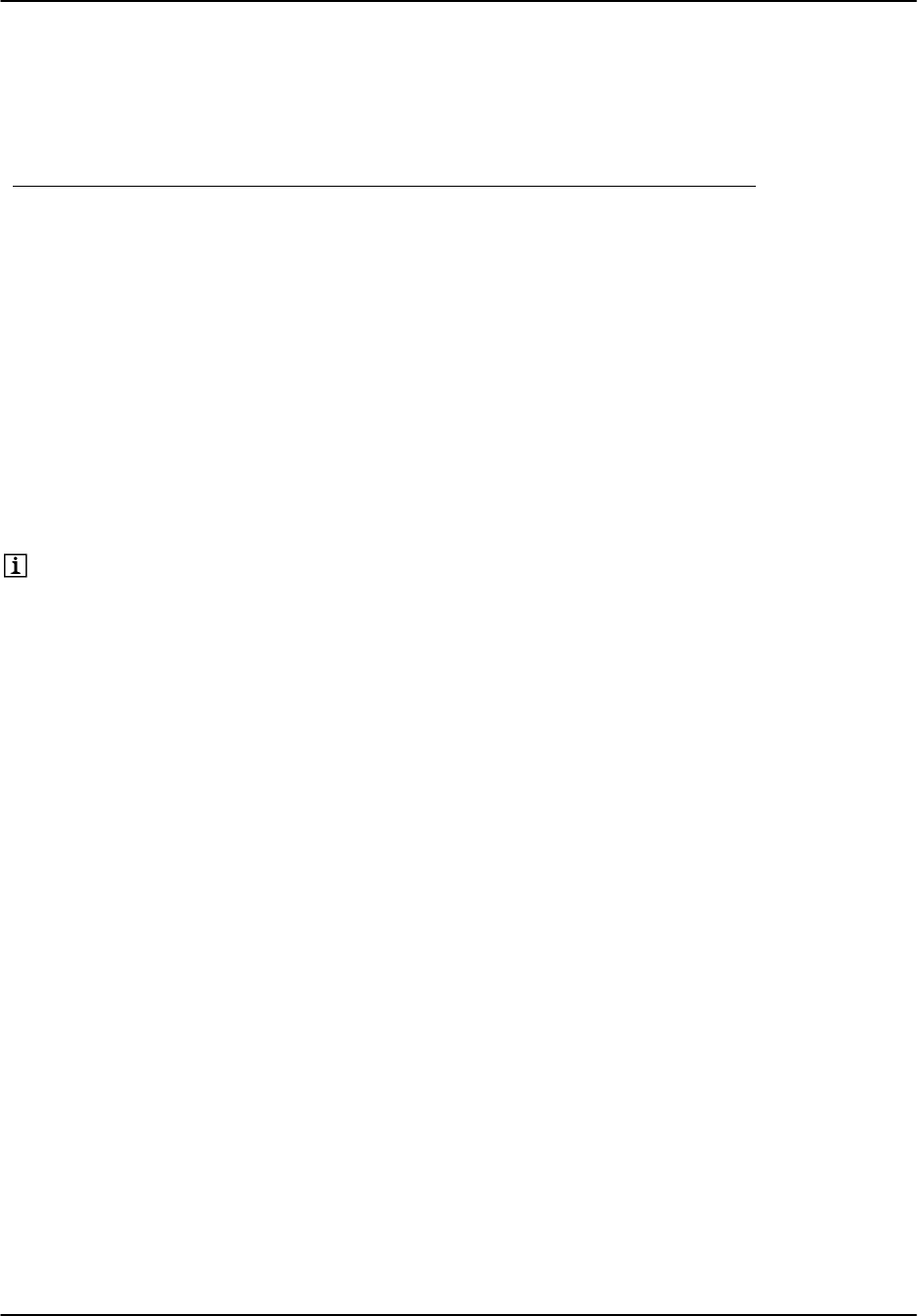
Host Computer Commands
RVP8 User’s Manual
May 2003
6–33
6.11 Reset (RESET)
The RESET command permits resetting either the entire RVP8 processor, or selected portions
thereof. Flags within the command word determine the action to be taken.
15 14 13 12 11 10 9 8 7 6 5 4 3 2 1 0
| | | | | | | | | | | | | | | | |
| |Nv |Nse|Fif|Nv |Nv | 0 1 1 0 0 | Command
|_______________________|___|___|___|___|___|___________________|
Nv Reloads configuration from the saved nonvolatile settings. For compatibility with
RPV6 and RVP7, any of 3 bits will trigger this response.
Nse Reset the receiver noise levels to the power-up default value for all pulsewidths as
defined in the Mt setup questions (See Section 3.3.5).
Fif Remove any data currently in the output FIFO’s. This permits flushing output
data that was left from a previous command, so that new output can be read from
scratch. See notes in the Introduction to this chapter concerning actions taken by
the RVP8 when the output FIFO becomes full.
6.12 Define Trigger Generator Output Waveforms (TRIGWF)
Note: This opcode is obsolete, and is included only for backward compatibility
with the RVP6. The opcode is disabled by default (See Section 3.3.1), because
the interactive trigger setup procedure described in Section 4.4 is the preferred
method of defining all RVP8 triggers and timing. TRIGWF should not be used
in any new code applications that drive the RVP8.
The RVP8 has a built-in trigger generator that can synthesize six independent digital output
waveforms, each having arbitrary shape and being active anywhere in a window centered around
zero-range. The six trigger outputs can be defined by a 2048-word by 6-bit table which is
loaded from the user computer. The patterns are automatically read from the table and output to
the six trigger lines during each radar pulse. The six outputs can be used for transmitter triggers,
scope triggers, range strobes, PLL gates, etc. The writable waveform table makes the RVP8
unique, in that the detailed timing of trigger and related control signals can be easily adjusted in
software, without having to resort to reprogramming PROMs. This makes it possible for user
software to edit the trigger timing in a convenient interactive manner.
Trigger waveforms are loaded using the TRIGWF command. Four bits in the command word
(PW0 through PW3) select which pulsewidths will receive the new waveforms. On power-up,
all four pulsewidths are initialized to user-selected waveforms.
The first word following the TRIGWF command specifies the transition point of the POLAR0
polarization control signal. This control signal is either held low or high for the cases of fixed
horizontal or vertical polarization, or it alternates from pulse to pulse for fast-switching
polarization measurements such as Zdr. The transition point is specified as a value between 0
and 2047, where 1024 represents range zero. These units are the same as the time units for the
waveforms which follow, i.e., a 2048-word array holding 6-bit trigger patterns. Bit 0 in each of
these words affects the TGEN0 digital output line, bit 1 affects TGEN1, etc. The bits are output
at a 7.195MHz rate, and the beginning of the 1024th array word (1025th word following the

Host Computer Commands
RVP8 User’s Manual
May 2003
6–34
command) corresponds exactly to the instant at which data at range zero are sampled by the
RVP8. Note that the output rate can also be interpreted as a new bit coming every 1/48 km. In
some cases this is a more useful view.
As an example, suppose we wish to make the TGEN0 output be a 0.42 microsecond pretrigger
pulse, with a rising edge exactly five microseconds prior to range zero. This would be done by
setting bit 0 in input words 988, 989, and 990 following the TRIGWF command, and leaving all
other bit 0’s clear. Further, if TGEN1 was to be a 0.14 microsecond marker strobe at 20km, we
would simply set bit 1 of input word 1984.
15 14 13 12 11 10 9 8 7 6 5 4 3 2 1 0
| | | | | | | | | | | | | | | | |
| |PW3|PW2|PW1|PW0| | 0 1 1 0 1 | Command
|_______________|___|___|___|___|___________|___________________|
15 14 13 12 11 10 9 8 7 6 5 4 3 2 1 0
| | | | | | | | | | | | | | | | |
| H | | Transition Point of POLAR0 Control Line | Input 1
|___|_______________|___________________________________________|
H This bit defines the sense of the control line when horizontal polarization is se-
lected.
15 14 13 12 11 10 9 8 7 6 5 4 3 2 1 0
| | | | | | | | | | | | | | | | |
| | Bits for –142.22 usec | Input 2
|_______________________________________|___|___|___|___|___|___|
.
.
15 14 13 12 11 10 9 8 7 6 5 4 3 2 1 0
| | | | | | | | | | | | | | | | |
| | Bits for zero range | Input 1025
|_______________________________________|___|___|___|___|___|___|
.
.
15 14 13 12 11 10 9 8 7 6 5 4 3 2 1 0
| | | | | | | | | | | | | | | | |
| | Bits for +142.08 usec | Input 2049
|_______________________________________|___|___|___|___|___|___|
6.13 Define Pulse Width Control Bits and PRT Limits
(PWINFO)
The RVP8 is equipped to control the radar transmitter’s pulse width and corresponding receiver
bandwidth. There are four pulse/bandwidth codes, numbered simply 0 through 3. The
association between codes and pulse widths is completely determined by the needs and
capabilities of the particular radar on hand. In some cases, the zero code might represent 0.25
microsecond pulse width, and in other cases it may represent 2.0 microseconds. Likewise, some
radars may use all four codes, whereas others have fewer options from which to choose. The
PWINFO command defines what happens for each of the four possible codes, but does not
actually select which code is being used. The later function is performed by SETPWF.
The RVP8 drives four TTL output lines (PWBW0 – 3) which are intended to control the radar
pulse/bandwidth hardware. Typically this control is via relays or solid-state switches in the
transmitter and receiver. The user decides what state the four lines assume for each pulse width

Host Computer Commands
RVP8 User’s Manual
May 2003
6–35
code. This is done using word #1 following the command, which contains four codes packed
into one 16-bit word. The power-up default is to drive output line N low for a code of N,
keeping all other lines high (Input of 7BDE Hex). The flexibility in defining the output bits
usually makes the radar hardware connections very simple. For example, if pulsewidth selection
relied on choosing one of four relays, then each PWBWn line could serve directly as a relay
driver using the default pattern.
For each pulse width there is a corresponding minimum trigger PRT permitted. This bound is
intended to limit the transmitter duty cycle to a safe value under all conditions. PWINFO sets up
these minimum PRT’s using words 2 through 5 following the command. The maximum
frequency of the internal trigger generator is then constrained at each pulse width to the
indicated rate. This protection applies at all times, i.e., during noise sampling, during ray
processing, and during the standby time between rays. The default PRT bounds are 2000, 1000,
750, and 500 Hertz (Inputs of 3000, 6000, 8000, and 12000). If your radar does not use all four
pulse width codes, it is still a good idea to set the unused PRT limits to reasonable values. This
way protection is still provided in the event that SETPWF accidently selects one of the unused
states. If the internal trigger generator is not being used, then the PRT limits no longer affect the
actual trigger rate and transmitter protection becomes the responsibility of the the user hardware.
Finally, note that the entire pulse/bandwidth mechanism can be effectively turned off by setting
the four bit patterns and the four PRT limits all to the same value.
The PWINFO command can be disabled (for transmitter safety), so that PRT limits cannot
accidently be changed by the host computer. When this is one, the RVP8 still reads the five
input words, but no changes are made to the pulse width and PRT information. Thus, the
command I/O behaves the same way, whether enabled or disabled.
15 14 13 12 11 10 9 8 7 6 5 4 3 2 1 0
| | | | | | | | | | | | | | | | |
| | 0 1 1 1 1 | Command
|___________________________________________|___________________|
15 14 13 12 11 10 9 8 7 6 5 4 3 2 1 0
| | | | | | | | | | | | | | | | |
| Bits for PW 3 | Bits for PW 2 | Bits for PW 1 | Bits for PW 0 | Input 1
|_______________|_______________|_______________|_______________|
15 14 13 12 11 10 9 8 7 6 5 4 3 2 1 0
| | | | | | | | | | | | | | | | |
| Min Trig Period (0.16667usec Increments) for Pulse Width 0 | Input 2
|_______________________________________________________________|
15 14 13 12 11 10 9 8 7 6 5 4 3 2 1 0
| | | | | | | | | | | | | | | | |
| Min Trig Period (0.16667usec Increments) for Pulse Width 1 | Input 3
|_______________________________________________________________|
15 14 13 12 11 10 9 8 7 6 5 4 3 2 1 0
| | | | | | | | | | | | | | | | |
| Min Trig Period (0.16667usec Increments) for Pulse Width 2 | Input 4
|_______________________________________________________________|
15 14 13 12 11 10 9 8 7 6 5 4 3 2 1 0
| | | | | | | | | | | | | | | | |
| Min Trig Period (0.16667usec Increments) for Pulse Width 3 | Input 5
|_______________________________________________________________|

Host Computer Commands
RVP8 User’s Manual
May 2003
6–36
6.14 Set Pulse Width and PRF (SETPWF)
This command selects the pulsewidth and trigger rate. A 2-bit pulse width code is passed in bits
8 and 9 of the command word, and selects one of four pulse widths as described under PWINFO.
The new radar PRT is passed in word #1. For all processing modes that use a fixed trigger rate,
this value defines the trigger period that is output at all times except during noise measurements.
For Dual-PRF applications, this word defines the short period (high PRF) rate. The long period
is internally computed as either 3/2, 4/3, or 5/4 the short period, and the trigger generator
alternates between the short and long rates on each successive ray.
15 14 13 12 11 10 9 8 7 6 5 4 3 2 1 0
| | | | | | | | | | | | | | | | |
| | (Rsv) | P.W. | | 1 0 0 0 0 | Command
|_______________|_______|_______|___________|___________________|
15 14 13 12 11 10 9 8 7 6 5 4 3 2 1 0
| | | | | | | | | | | | | | | | |
| Desired Trigger Generator Period (0.16667usec Increments) | Input 1
|_______________________________________________________________|
When Input #1 is zero, then the arguments take on an alternate form that allows an array of N
(up to 64) trigger periods to be specified, and also gives much finer time resolution in the choice
of each period. The XARGS command is first used to load an array of N 32-bit words that
define the trigger period(s) in nanoseconds. The RVP8 will then generate triggers whose shapes
(relative starts and widths) are identical for each pulse, but whose periods follow the selected
sequence. Trigger patterns such as these are intended to support research customers who use the
real–time (I,Q) data stream directly.
15 14 13 12 11 10 9 8 7 6 5 4 3 2 1 0
| | | | | | | | | | | | | | | | |
| Lower 16–Bits of 32–Bit Trigger Period in Nanoseconds | XARG 1
|_______________________________________________________________|
15 14 13 12 11 10 9 8 7 6 5 4 3 2 1 0
| | | | | | | | | | | | | | | | |
| Upper 16–Bits of 32–Bit Trigger Period in Nanoseconds | XARG 2
|_______________________________________________________________|
.
.
6.15 Load Antenna Synchronization Table (LSYNC)
The RVP8 can operate in a mode wherein radar data are acquired in synchronization with the
antenna motion along either the azimuth or elevation axis. This special feature frees the user
computer from having to separately monitor the antenna angles and request each data ray
individually. To use this mode, it is assumed that TAG0-15 are wired to receive azimuth angles,
and that TAG15-31 are wired to receive elevation. Angle input may be in the form of either
16-bit binary angles, or four-digit BCD. This synchronization mode is the only one which
ascribes any meaning to the TAG inputs; ordinarily they are merely passed on to the user
computer as ancillary information.
Antenna synchronization is accomplished by way of a table of trigger angles. This table, which
contains between three and 1024 angles, is used to define the angle boundaries for each
processed ray. The trigger angles need not be uniformly spaced, nor must they span the full

Host Computer Commands
RVP8 User’s Manual
May 2003
6–37
360-degrees of rotation. This gives considerable flexibility in the choice of angles. For
example, if local obstructions cause shadows in the radar image, then those regions can be
skipped merely by omitting table entries in their vicinity. Likewise, as the antenna rotates data
can be acquired within one or more sectors by simply specifying the appropriate sets of
contiguous bearings at whatever angular resolution is desired. Note that on power-up the angle
table is initialized to 360 values corresponding to integer-valued degrees from zero to 359.
The synchronization algorithm works automatically with either clockwise or counterclockwise
antenna rotation, and can tolerate any sequence of changes in direction, e.g., if the antenna itself
is scanning a sector, or if it is turning erratically. Moreover, the trigger angles do not have to be
hit exactly in order to start each new ray — the antenna need only move across them. This
minimizes the possibility of losing data due to missing codes in the angle encoders. The RVP8
will automatically produce an output ray after one second of waiting, even if no trigger angles
have been crossed. This is to avoid timeouts with the host computer when the antenna is not
moving at all.
To use the synchronization mode, the trigger angle table is first loaded using the LSYNC
command. The user chooses the number of table entries and then writes the required number of
words to the RVP8. The angles must be supplied in a clockwise strictly increasing order, and
they must neither reach nor pass zero degrees by the table’s end. The first value, however, may
be zero. Binary angle representation is used wherein Bit 15 represents 180 degrees, Bit 14
represents 90 degrees, etc. The Ld bit must be set in the command word to indicate that a new
table size and set of angles are being loaded. A flag bit is to be set (See GPARM) if errors are
detected when loading the table of angles.
To actually enable synchronized operation the Ena command bit must eventually be set, and EL
and BCD should be either set or cleared according to the user’s needs. These bits may be used
independent of reloading the actual table values. Thus, antenna synchronization may be turned
on and off without having to reload the table each time. However, if there were errors when the
table was last loaded, the processor ignores the Ena bit and synchronization is forced off. Once
enabled, PROC commands are then issued in the usual manner to acquire and process the radar
data. Either the single-cycle or free-run PROC mode may be used. Data collection proceeds as
usual, except that the rays are now automatically aligned with the trigger angles.
The angle sync algorithm is dynamic and works as follows. Each ray begins immediately upon
the user’s request, or upon completion of the previous ray when in continuous processing mode.
At the start of the ray, the RVP8 finds the pair of sync angles that enclose the previous trigger
angle. The current ray then runs until the antenna passes outside of either limit, at which point
processing for that ray is terminated. Once this happens, a new trigger angle is assigned based
on which limit was crossed.
The maximum number of pulses that will be present in each ray during angle syncing is still
given the by the Sample Size field of the SOPRM command. The actual number of pulses will
be less only if a trigger angle is crossed before the full pulse count is reached. In general, you
should set the Sample Size somewhat larger than the expected pulse count so that the trigger
angle crossings make the best use of every available pulse when the antenna is scanning at the
expected rate.

Host Computer Commands
RVP8 User’s Manual
May 2003
6–38
15 14 13 12 11 10 9 8 7 6 5 4 3 2 1 0
| | | | | | | | | | | | | | | | |
| |NoI|Ena|El |BCD|Ld | | 1 0 0 0 1 | Command
|___________|___|___|___|___|___|___________|___________________|
NoI Ordinarily, the potentially lengthy sync wait loop is terminated if the user writes
additional words to the RVP8. Setting this bit prevents such interrupts. Beware
that the processor loop can not be broken in this case except by moving the anten-
na across a trigger angle, or cycling the RESET_ line.
Ena Enables antenna synchronization.
El Synchronization is based on TAG15–31 (Elevation) inputs, else TAG0–15 (Azi-
muth) is used.
BCD Specifies that TAG angle input is in the form of 4-digit Binary Coded Decimal;
otherwise, a 16-bit binary angle is assumed.
Ld Indicates that a new table size and array of values follow the command. If Ld = 0,
then LSYNC is a one-word command only.
15 14 13 12 11 10 9 8 7 6 5 4 3 2 1 0
| | | | | | | | | | | | | | | | |
| Number of Trigger Angles that Follow (3 – 1024) | Input 1
|_______________________________________________________________|
15 14 13 12 11 10 9 8 7 6 5 4 3 2 1 0
| | | | | | | | | | | | | | | | |
| (Ignored) | Input 2
|_______________________________________________________________|
15 14 13 12 11 10 9 8 7 6 5 4 3 2 1 0
| | | | | | | | | | | | | | | | |
| First Trigger Angle (16-Bit Binary Angle) | Input 3
|_______________________________________________________________|
.
.
15 14 13 12 11 10 9 8 7 6 5 4 3 2 1 0
| | | | | | | | | | | | | | | | |
| Last Trigger Angle (16-Bit Binary Angle) |
|_______________________________________________________________|
6.16 Set/Clear User LED (SLED)
This command simply turns the red user LED on and off under program control. The LED is on
during the initial running of internal diagnostics, and then remains off unless changed by this
command. Note that the red LED can be configured to serve as an internal activity indicator
(see TTY setups), in which case this command has no effect.
15 14 13 12 11 10 9 8 7 6 5 4 3 2 1 0
| | | | | | | | | | | | | | | | |
| |LED| | 1 0 0 1 0 | Command
|___________________________|___|___________|___________________|
6.17 TTY Operation (TTYOP)
This command controls the TTY “chat mode” interface to the host computer. The command can
simulate the typing of characters on the RVP8’s setup TTY. Characters entered in this manner
are indistinguishable from those typed on the actual TTY; hence, whatever one can do via the

Host Computer Commands
RVP8 User’s Manual
May 2003
6–39
TTY, one can also do via this command. The RVP8 sends all TTY output to whichever stream
(TTY, or host computer) provided the most recent input character. This command is also used to
monitor the graphical data from the special scope plotting modes.
15 14 13 12 11 10 9 8 7 6 5 4 3 2 1 0
| | | | | | | | | | | | | | | | |
| | Operation | 1 0 0 1 1 | Command
|_______________________________|___________|___________________|
The operation codes are as follows:
0 Sends the ASCII character in the upper byte of the word to the RVP8 as if it had
been typed on the setup TTY’s keyboard.
1 Allow scope plotting data to be output whenever a plot is being drawn. All rele-
vant status and data words are output once upon each receipt of this command.
Subsequently, status and data will be output only when a change has taken place.
2 Disable the scope plotting output data.
Any of the following types of data may be output by the RVP8 while the TTY monitor is
running. The order of arrival of each data type is indeterminate, but all multi-word sequences
will always be output as contiguous words.
Individual “TTY” characters generated by the RVP8 are output in the low byte of the word, with
the upper byte set to zeros.
15 14 13 12 11 10 9 8 7 6 5 4 3 2 1 0
| | | | | | | | | | | | | | | | |
| 0 0 0 0 0 0 0 0 | ASCII Character | TTY Char
|_______________________________|_______________________________|
The status of the plotting modes is given in the following word.
15 14 13 12 11 10 9 8 7 6 5 4 3 2 1 0
| | | | | | | | | | | | | | | | |
| 1 0 0 0 | |PLT| Status
|_______________|___________________________________________|___|
PLT Indicates that a scope plot is being drawn now.
The 2-bit intensities of each of 16 possible strokes of data is given in the following 4-word
sequence. An intensity of zero represents “OFF”; one, two and three are successively brighter.

Host Computer Commands
RVP8 User’s Manual
May 2003
6–40
15 14 13 12 11 10 9 8 7 6 5 4 3 2 1 0
| | | | | | | | | | | | | | | | |
| 1 0 0 1 | 0 0 0 0 | Int 3 | Int 2 | Int 1 | Int 0 |
|_______________|_______________|_______|_______|_______|_______|
15 14 13 12 11 10 9 8 7 6 5 4 3 2 1 0
| | | | | | | | | | | | | | | | |
| 1 0 0 1 | 0 0 0 1 | Int 7 | Int 6 | Int 5 | Int 4 |
|_______________|_______________|_______|_______|_______|_______|
15 14 13 12 11 10 9 8 7 6 5 4 3 2 1 0
| | | | | | | | | | | | | | | | |
| 1 0 0 1 | 0 0 1 0 | Int 11| Int 10| Int 9 | Int 8 |
|_______________|_______________|_______|_______|_______|_______|
15 14 13 12 11 10 9 8 7 6 5 4 3 2 1 0
| | | | | | | | | | | | | | | | |
| 1 0 0 1 | 0 0 1 1 | Int 15| Int14 | Int 13| Int 12|
|_______________|_______________|_______|_______|_______|_______|
The data for each stroke of the plot is given by the following sequence of 501 words.
15 14 13 12 11 10 9 8 7 6 5 4 3 2 1 0
| | | | | | | | | | | | | | | | |
| 1 0 1 0 | | Stroke Number | Plot Data
|_______________|_______________________________|_______________|
15 14 13 12 11 10 9 8 7 6 5 4 3 2 1 0
| | | | | | | | | | | | | | | | |
| 1 0 1 1 | Value to Plot (0 – 4095) | Word #1
|_______________|_______________________________________________|
.
.
15 14 13 12 11 10 9 8 7 6 5 4 3 2 1 0
| | | | | | | | | | | | | | | | |
| 1 0 1 1 | Value to Plot (0 – 4095) | Word #500
|_______________|_______________________________________________|
6.18 Load Custom Range Normalization (LDRNV)
Reflectivities computed by the RVP8 are ordinarily corrected for range effects by adding an
offset in deciBels equal to 20 log(R / 1km), where R is the range in kilometers. This correction
is based on a simple filled beam geometry, and is sufficiently accurate for most meteorological
observations. The LDRNV command is provided for applications in which an alternate custom
range correction is required, for example, if the radar receiver’s LNA were to be driven by an
external user-supplied STC waveform.
LDRNV loads a 251-word custom correction table holding values in hundredths of deciBels over
five decades of log(range) from 0.01km to 1000km. There are 50 table entries per decade of
range. Thus, the range in kilometers corresponding to an input word #N is 10N1
50 2, and the
default correction table (automatically used on power-up) is simply 40(N101) . The table
values are stored and interpolated whenever the RVP8 loads a new range mask (See LRMSK), at
which point custom values for the actual user ranges are computed. The LDRNV command
need be issued only once, but it must be done prior to choosing the working set of range bins.

Host Computer Commands
RVP8 User’s Manual
May 2003
6–41
The linear intervening gas attenuation correction (See SOPRM) is always added to the
reflectivity data, regardless of whether default or custom range normalization is in effect. If this
is undesirable, the intervening gas slope should be set to zero.
15 14 13 12 11 10 9 8 7 6 5 4 3 2 1 0
| | | | | | | | | | | | | | | | |
| | 1 0 1 0 1 | Command
|___________________________________________|___________________|
15 14 13 12 11 10 9 8 7 6 5 4 3 2 1 0
| | | | | | | | | | | | | | | | |
| Signed Hundredths dB of Range Normalization for Range 0.01 km | Input 1
|_______________________________________________________________|
.
.
15 14 13 12 11 10 9 8 7 6 5 4 3 2 1 0
| | | | | | | | | | | | | | | | |
| Signed Hundredths dB of Range Normalization for Range 1000 km | Input 251
|_______________________________________________________________|
6.19 Read Back Internal Tables and Parameters (RBACK)
This command permits some of the RVP8 internal tables to be read back for confirmation and
diagnostic purposes. This command would not generally be used during normal data acquisition
and processing.
15 14 13 12 11 10 9 8 7 6 5 4 3 2 1 0
| | | | | | | | | | | | | | | | |
| | Data to Show | | 1 0 1 1 0 | Command
|_______________|_______________|___________|___________________|
15 14 13 12 11 10 9 8 7 6 5 4 3 2 1 0
| | | | | | | | | | | | | | | | |
| Number of words to output | Input 1
|_______________________________________________________________|
The data that can be returned are:
0 Full operational parameter table from last SOPRM command.
1 Ray history array consisting of six words per ray for the last 40 rays (in reverse
time order) that were processed. Each six-word group holds
a. Actual number of samples that went into the ray
b. Time since the last ray (in tenths of ms)
c. Ending azimuth TAG bits
d. Ending elevation TAG bits
e. Starting azimuth TAG bits
f. Starting elevation TAG bits
2 Angle sync table from last LDSYNC command.
4 Filter selection array from the last LFILT command.
6 Custom range normalization from last LDRNV command.
7 Samples of the TAG input lines at 4ms intervals. The sampling begins at the mo-
ment the RBACK command is received, and continues until the output count is
reached. Each 32-bit sample is output as a pair of 16-bit words:

Host Computer Commands
RVP8 User’s Manual
May 2003
6–42
a. Azimuth (TAG bits 0 – 15)
b. Elevation (TAG bits 16 – 31)
8 Doppler clutter filter coefficients (Same format as for LFCOEFS command)
10 Range mask spacing in cm for each pulsewidth
6.20 Pass Auxiliary Arguments to Opcodes (XARGS)
This command provides a backward compatible mechanism for supplying additional (optional)
arguments to other opcodes. The command may be used freely in the RVP8’s instruction stream,
even if the opcode being modified does not expect any optional arguments. XARGS will be a
NOP in that case.
To supply optional arguments to another opcode “OP”, the XARGS command is first executed
with the additional argument count encoded in its upper 11-bits. This is followed by the array of
between 0 and 2047 additional arguments. At this point the XARGS command is finished and
the “OP” command is fetched as the next instruction. “OP” will execute normally, except that
the additional arguments from XARGS can be picked up after its own input list has been read to
completion.
XARGS affects only the opcode that immediately follows it. The entire list of optional
arguments is discarded after “OP” executes, even if “OP” did not use some or all of the list.
However, if “OP” is yet another XARGS command, then the additional arguments that it
supplies will be appended to the first set. In this way, XARGS can supply an arbitrarily large
number of additional arguments.
15 14 13 12 11 10 9 8 7 6 5 4 3 2 1 0
| | | | | | | | | | | | | | | | |
| Number of Additional Arguments N | 1 1 0 0 0 | Command
|___________________________________________|___________________|
15 14 13 12 11 10 9 8 7 6 5 4 3 2 1 0
| | | | | | | | | | | | | | | | |
| First Additional Argument | Input 1
|_______________________________________________________________|
.
.
15 14 13 12 11 10 9 8 7 6 5 4 3 2 1 0
| | | | | | | | | | | | | | | | |
| Last Additional Argument | Input N
|_______________________________________________________________|
15 14 13 12 11 10 9 8 7 6 5 4 3 2 1 0
| | | | | | | | | | | | | | | | |
| “OP” Command that accepts optional arguments | Command
|_______________________________________________________________|
.
.
6.21 Configure Ray Header Words (CFGHDR)
The processed data that are output by the PROC command may contain optional header words
that give additional information about each ray. This command configures the set of words that
makeup each header. There are (up to) thirty two different choices of words or groups of words

Host Computer Commands
RVP8 User’s Manual
May 2003
6–43
to include, as indicated by the bit mask following the command. Setting a bit requests that those
words be included in the header, and be placed in the order implied by the sequence of the bits.
Leaving all bits clear will suppress the header entirely; though this can also be done without
changing the configuration via the NHD (No-Headers) bit in SOPRM Input #2.
15 14 13 12 11 10 9 8 7 6 5 4 3 2 1 0
| | | | | | | | | | | | | | | | |
| | 0 0 0 0 0 1 0 1 1 1 1 1 | Command
|_______________|_______________________________________________|
15 14 13 12 11 10 9 8 7 6 5 4 3 2 1 0
| | | | | | | | | | | | | | | | |
| |Gpm|Tim|Pul|PRT|Tag| Input 1
|___________________________________________|___|___|___|___|___|
Tag Four words containing two 32-Bit TAG samples, one from the beginning and one
from the end of the ray:
Word #1 TAG15–0 Start of Ray
Word #2 TAG31–16 Start of Ray
Word #3 TAG15–0 End of Ray
Word #4 TAG31–16 End of Ray
When the RVP8 is operating in dual PRF mode, bit zero of the “start” TAG word
is replaced with a flag indicating that the ray’s PRF was low (0) or high (1).
When trigger blanking is enabled, bit zero of the “end” TAG word is replaced
with a flag indicating that the trigger was blanked (0) or normal (1). Note that the
data within a ray are considered to be invalid if any of the pulses that were used
to compute the ray were blanked. Also, the RVP8 will output all zeroed data
whenever a ray contains any blanked pulses.
PRT PRT (Pulse Repetition Time) measured at the end of the ray. Same format as
GPARM Word #30. The measured PRT’s are forced to 0xFFFF (the maximum
unsigned value) whenever the external trigger is expected but missing.
Pul Number of pulses that were used to compute the ray.
Tim Time stamp. Sixteen-bit counter incrementing at a rate of 1000 counts/sec, and
sampled at the end of the ray.
Gpm GPARM. Sends a copy of the 64-word GPARM output with each ray.
15 14 13 12 11 10 9 8 7 6 5 4 3 2 1 0
| | | | | | | | | | | | | | | | |
| | Input 2
|_______________________________________________________________|
6.22 Configure Interference Filter (CFGINTF)
The RVP8 can optionally apply an interference filter to its incoming (I,Q) data stream, with the
goal of rejecting occasional and sparse interference from other (usually man-made) signal
sources. The CFGINTF command is used to choose which filtering algorithm will be applied,
and to configure its operation via additional XARGS parameters (See Section 6.20).

Host Computer Commands
RVP8 User’s Manual
May 2003
6–44
If the XARGS are not supplied, then the filter parameters will simply retain their previous
values. Thus, CFGINTF with no XARGS can be used to turn the interference filters On/Off
without making any other changes to their threshold constants. Likewise, if only XARG 1 is
supplied, then that single threshold value will be used for both C1 and C2.
15 14 13 12 11 10 9 8 7 6 5 4 3 2 1 0
| | | | | | | | | | | | | | | | |
| Filter | 0 0 0 0 0 1 1 1 1 1 1 1 | Command
|_______________|_______________________________________________|
Filter Chooses which interference algorithm should be run. See Section 5.1.4 for a de-
scription of the available algorithms.
0: None (Interference filtering is disabled)
1: Alg.1 (Traditional JMA Algorithm)
2: Alg.2 (Alg.1 optimized for additive interference)
3: Alg.3 (Alg.2 with better statistics)
We recommend that you choose Alg.3 for general operational use. The other algo-
rithms are included mostly for historical reasons.
15 14 13 12 11 10 9 8 7 6 5 4 3 2 1 0
| | | | | | | | | | | | | | | | |
| Threshold Parameter “C1” in Hundredths of deciBels | XARG 1
|_______________________________________________________________|
15 14 13 12 11 10 9 8 7 6 5 4 3 2 1 0
| | | | | | | | | | | | | | | | |
| Threshold Parameter “C2” in Hundredths of deciBels | XARG 2
|_______________________________________________________________|
6.23 Set AFC level (SETAFC)
This command sets the AFC level to a given value. The signed 16-bit span is identical to
GPARM Output #51 which shows the present AFC level, i.e., corresponding to the –100% to
+100% AFC range that is defined in the Mb menu. The RVP8 will automatically convert the
new level into whatever analog or digital AFC output format has been configured. The only
exception is for the Motor/Integrator type of AFC loop, in which case this command does
nothing.
15 14 13 12 11 10 9 8 7 6 5 4 3 2 1 0
| | | | | | | | | | | | | | | | |
| | 0 0 0 0 1 0 1 1 1 1 1 1 | Command
|_______________|_______________________________________________|
15 14 13 12 11 10 9 8 7 6 5 4 3 2 1 0
| | | | | | | | | | | | | | | | |
| 16–Bit AFC/MFC Value (–32768 through +32767) | Input 1
|_______________________________________________________________|
6.24 Set Trigger Timing Slew (SETSLEW)
The Mt menu allows you to select a subset of triggers that can be slewed “left” and “right” in
order to place the burst pulse accurately at range zero. This command allows you to manually
set the present amount of slew. The input argument is in hundredths of microseconds, i.e.,
ranging from –327.68sec to +327.67sec. The actual span permitted by the RVP8 is +20sec.
This is the same format used in GPARM Output #56 which shows the present slew value.

Host Computer Commands
RVP8 User’s Manual
May 2003
6–45
15 14 13 12 11 10 9 8 7 6 5 4 3 2 1 0
| | | | | | | | | | | | | | | | |
| | 0 0 0 0 1 1 0 1 1 1 1 1 | Command
|_______________|_______________________________________________|
15 14 13 12 11 10 9 8 7 6 5 4 3 2 1 0
| | | | | | | | | | | | | | | | |
| Signed trigger slew in hundredths of microseconds | Input 1
|_______________________________________________________________|
6.25 Hunt for Burst Pulse (BPHUNT)
This command starts up the internal procedure to hunt for a missing burst pulse when we are
uncertain of both its time and frequency. Depending on how the hunting process has been
configured in the Mb menu, the whole procedure may take several seconds to complete. The
RVP8’s host computer interface remains completely functional during this time, but any acquired
data would certainly be questionable. GPARM status bits in word #55 indicate when the hunt
procedure is running, and whether it has completed successfully.
15 14 13 12 11 10 9 8 7 6 5 4 3 2 1 0
| | | | | | | | | | | | | | | | |
| |Now| 0 0 0 0 1 1 1 1 1 1 1 1 | Command
|___________|___|_______________________________________________|
Now Forces the hunt procedure to be started even if the burst pulse is already present.
Normally the procedure will only be started when the burst pulse is missing at the
time BPHUNT is given.
6.26 Configure Phase Modulation (CFGPHZ)
This command configures the RVP8 phase control output lines, which determine the relative
phase of each transmitted pulse. In some cases the phase sequence that is chosen will also have
side effects elsewhere in the processor, e.g., different algorithms may be used in Random Phase
mode according to the transmit sequence that is requested.
Some of the phase sequences chosen by CFGPHZ also expect additional arguments to have been
supplied by the XARGS command. Phase sequences are expressed as a list of N 16-bit binary
angles representing the desired phase sequence. The sequence is assumed to be periodic with
period N. The Mz command defines the correspondence between phase codes and phase angles,
and is described in Section 3.3.8.
15 14 13 12 11 10 9 8 7 6 5 4 3 2 1 0
| | | | | | | | | | | | | | | | |
| | PhSeq | 0 0 0 1 0 0 0 1 1 1 1 1 | Command
|___|___________|_______________________________________________|
PhSeq=0 Selects No Modulation. The RVP8 outputs a constant default phase request as
defined in the Mz menu.
PhSeq=1 Selects a Random Phase sequence. This is also the default phase modulation that
will be output following power-up. From the set of valid phase codes that are de-
fined in the Mz setup section, a random code is automatically chosen for each
pulse. Each code has an equal probability of being chosen each time, and the

Host Computer Commands
RVP8 User’s Manual
May 2003
6–46
choice is independent of any previous state. No XARG words accompany this
command.
PhSeq=2 Selects a User Defined sequence. If no XARGS have been supplied, then the
RVP8 outputs the default idle phase that is defined in Mz. If XARGS are sup-
plied, then they are interpreted as a sequence of 16-bit binary angles. The RVP8
will make the best match between each desired angle and the closest realizable
angle that the phase modulation hardware can produce. The maximum length of
the sequence is 1024 pulses.
PhSeq=3 Selects the SZ(8/64) sequence. This is a systematic code due to Sachidananda and
Zrnic, which does a nice job separating and recovering first and second trip echoes
in “Random Phase” mode. It will usually perform better than a truly random
transmit sequence, especially when the processing interval is fairly short (as little
as 32-pulses). With no XARGS, the RVP8 automatically generates the phase se-
quence using the closest realizable angles that the phase modulation hardware can
produce. This is the recommended way to invoke SZ(8/64) coding. However,
you may also supply your own 32-pulse angle sequence.
6.27 Set User IQ Bits (UIQBITS)
Load user-specified bits that will be included with the pulse headers in the live (I,Q) data stream.
The current permanent bits are stored right in the shared (I,Q) data segment, and a FIFO history
is also maintained so that the bits can be associated with the data being acquired right now as the
UIQBITS opcode is executed. Each 16-bit command arg specifies bits to Set/Clr in successive
bytes of the structure. This allows user code to safely change some bits without affecting others.
The permanent Set/Clr bits are updated in the signal processor and retain their value from the
last time they were defined. The bits are repeated into all pulse headers. The ONCE bits,
however, are transitory and will appear in only one pulse header each time they are set.
The user bits from separate calls will never be collapsed into a single pulse header, even if the
header and bit times indicate that they could. This means that each UIQBITS opcode will
always result in at least one pulse header being tagged with exactly those data. This is generally
what you want, since no other exact outcome could be guaranteed based on time-of-arrival
alone.
15 14 13 12 11 10 9 8 7 6 5 4 3 2 1 0
| | | | | | | | | | | | | | | | |
| | 0 0 0 1 0 0 1 1 1 1 1 1 | Command
|_______________|_______________________________________________|
15 14 13 12 11 10 9 8 7 6 5 4 3 2 1 0
| | | | | | | | | | | | | | | | |
| 64 Permanent User Bits to SET | Inputs 1–4
|_______________________________________________________________|
15 14 13 12 11 10 9 8 7 6 5 4 3 2 1 0
| | | | | | | | | | | | | | | | |
| 64 Permanent User Bits to CLEAR | Inputs 5–8
|_______________________________________________________________|
15 14 13 12 11 10 9 8 7 6 5 4 3 2 1 0
| | | | | | | | | | | | | | | | |
| 64 Transitory ONCE Bits | Inputs 9–12
|_______________________________________________________________|

Host Computer Commands
RVP8 User’s Manual
May 2003
6–47
6.28 Custom User Opcode (USRINTR and USRCONT)
These opcodes are part of the open software extensions to the RVP8, which allow custom
opcodes to be defined for each major mode of operation. Arguments may be passed into a
custom opcode handler as an XARG list. Likewise, an optional array of words returned from
that handler will appear after the command executes.
15 14 13 12 11 10 9 8 7 6 5 4 3 2 1 0
| | | | | | | | | | | | | | | | |
| User Bits | 1 1 1 1 1 0 |CON| 1 1 1 1 1 | Command
|_______________|_______________________|___|___________________|
UserBits Four additional bits defined by the user to help subdivide the opcode functions if
desired.
CON If set, then the RVP8’s IQ data acquisition thread proceeds continuously while the
opcode is executed. If clear, then the IQ stream is interrupted prior to handling the
call.
15 14 13 12 11 10 9 8 7 6 5 4 3 2 1 0
| | | | | | | | | | | | | | | | |
| Optional Input Words | XARG List
|_______________________________________________________________|
15 14 13 12 11 10 9 8 7 6 5 4 3 2 1 0
| | | | | | | | | | | | | | | | |
| Optional Output Words | User Output
|_______________________________________________________________|